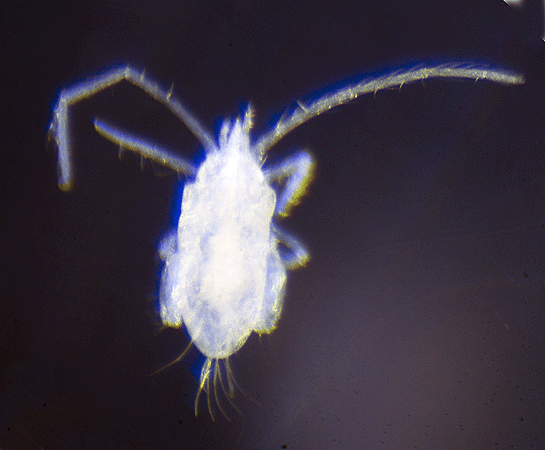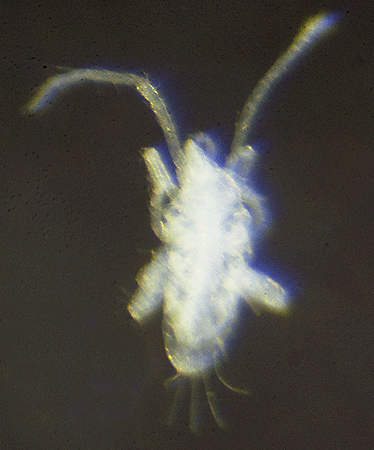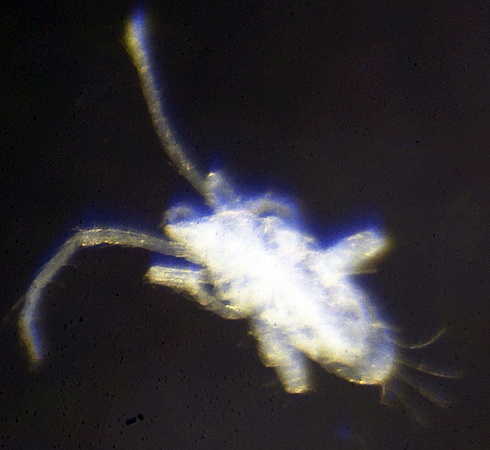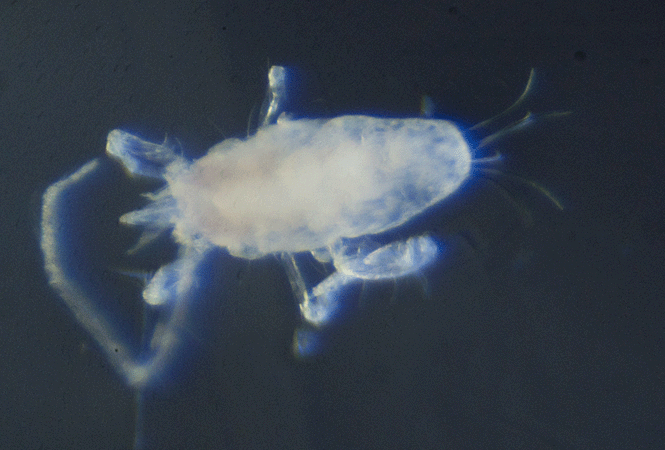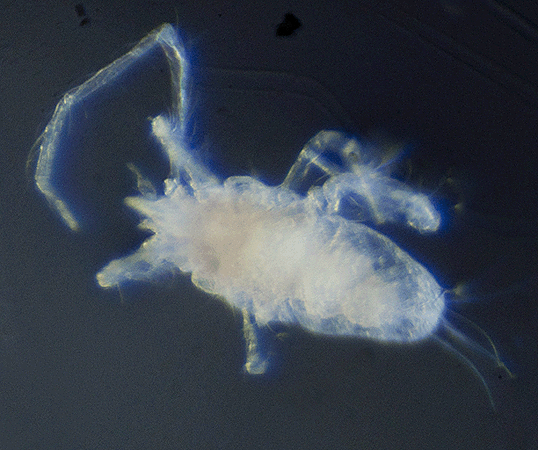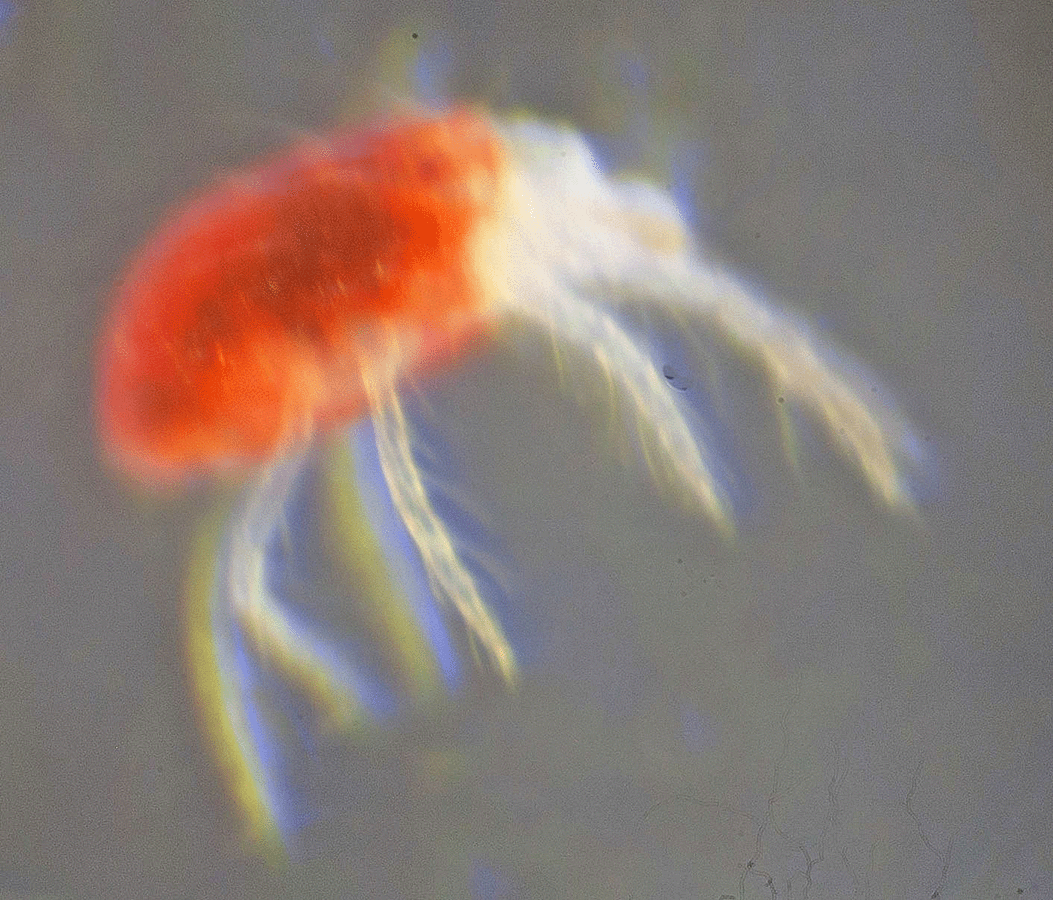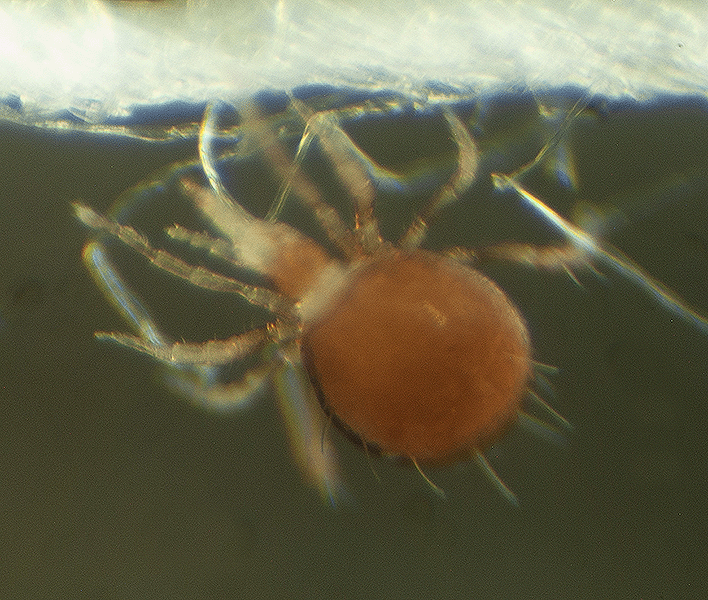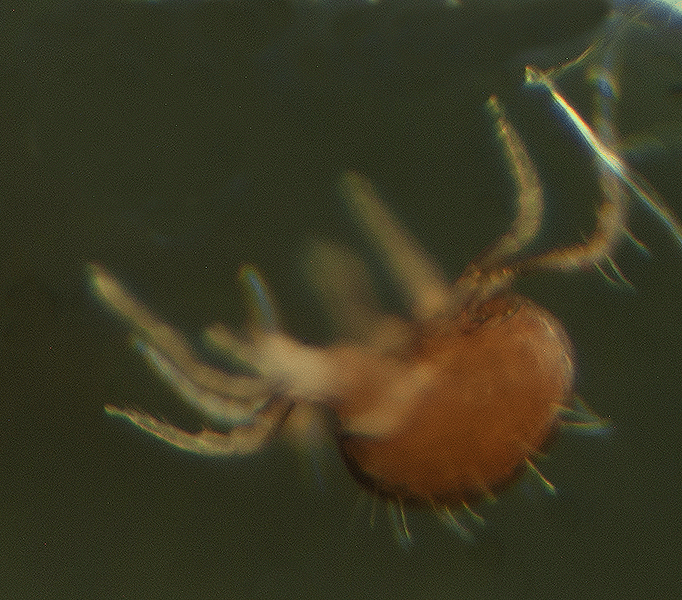n
Class Arachnida (Spiders and Mites) in the Christopher B. Smith Preserve
Class Arachnida Characteristics: Members of Class Arachnida have eight jointed legs. Although most arachnids are terrestrial, there are some aquatic species. In all, there are over 100,000 named species of arachnids that include spiders, scorpions, harvestmen, ticks, mites, and solifuges (sun spiders). Several orders of arachnids have been photographed in the preserve and are listed below. Order Araneae are spiders. Once classified together into Order Acari, mites and ticks are now placed into 10 orders.
Interactions in the Smith Preserve: Arachnids eat many insects and other arthropods, and they are prey for a variety of other organisms (arthropods, birds, snakes, and fish.) Some arachnids (mites and ticks) are parasitic and can carry diseases.
Order |
Family |
Species Name |
Common Name |
Araneae |
Anyphaenidae |
Lupettiana mordax |
|
Araneae |
Anyphaenidae |
Hibana sp. |
|
Araneae |
Araneidae |
Acaesia hamata |
|
Araneae |
Araneidae |
Araneus pegnia |
|
Araneae |
Araneidae |
Araneus calusa |
|
Araneae |
Araneidae |
Cyclosa turbinata |
|
Araneae |
Araneidae |
Cyclosa sp. |
|
Araneae |
Araneidae |
Cyrtophora citricola |
|
Araneae |
Araneidae |
Eriophora ravilla |
|
Araneae |
Araneidae |
Eustala anastera |
|
Araneae |
Araneidae |
Eustala sp. |
|
Araneae |
Araneidae |
Eustala sp. |
|
Araneae |
Araneidae |
Eustala sp. ? |
|
Araneae |
Araneidae |
Gasteracantha cancriformis |
|
Araneae |
Araneidae |
Unknown | Orb Weaver |
Araneae |
Araneidae |
Gea heptagon |
|
Araneae |
Araneidae |
Unknown |
|
Araneae |
Araneidae |
Unknown |
|
Araneae |
Dictynidae |
Emblyna florens |
|
Araneae |
Dictynidae |
Lathys sp. |
|
Araneae |
Dictynidae |
Unknown |
|
Araneae |
Dictynidae |
Unknown |
|
Araneae |
Dictynidae |
Unknown |
|
Araneae |
Dolomedidae (Formerly Pisaridae) |
Dolomedes triton |
|
| Araneae | Dolomedidae (Formerly Pisaridae) | Dolomedes sp. |
Fishing Spider |
Araneae |
Gnaphosidae |
Litopyllus cubanas |
|
Araneae |
Hahniidae |
Unknown |
|
Araneae |
Linyphiidae |
Agyneta sp.? |
|
Araneae |
Linyphiidae |
Agyneta sp.? |
|
Araneae |
Linyphiidae |
Florinda coccinea |
|
Araneae |
Linyphiidae |
Unknown Species |
|
Araneae |
Linyphiidae |
Unknown Species |
|
Araneae |
Miturgidae |
Cheiracanthium inclusum |
|
Araneae |
Oonopidae |
Opopaea deserticola |
|
Araneae |
Oonopidae |
Opopaea sp. |
|
Araneae |
Oonopidae |
Unknown |
|
Araneae |
Oonopidae |
Unknown |
|
Araneae |
Oonopidae |
Unknown |
|
Araneae |
Oxyopidae |
Peucetia viridans |
|
Araneae |
Philodromidae |
Unknown |
|
Araneae |
Phoicidae |
Modisimus culicinus |
|
Araneae |
Phoicidae |
Unknown |
|
Araneae |
Phoicidae |
Unknown |
Cellar Spider |
Araneae |
Phoicidae |
Unknown |
|
Araneae |
Pisaridae |
Unknown |
|
Araneae |
Salticidae |
Heltzia palmarum |
|
Araneae |
Salticidae |
Lyssomanes viridis |
|
Araneae |
Salticidae |
Unknown |
|
Araneae |
Scytodidae |
Scytodes sp. |
|
Araneae |
Scytodidae |
Scytodes fusca |
|
Araneae |
Tetragnathidae |
Alcimosphenus licinus |
|
Araneae |
Tetragnathidae |
Leucauge argyra |
|
Araneae |
Tetragnathidae |
Leucauge venusta |
|
Araneae |
Tetragnathidae |
Leucauge sp. |
|
Araneae |
Tetragnathidae |
Leucauge sp. |
|
Araneae |
Tetragnathidae |
Tetragnatha sp. |
|
Araneae |
Tetragnathidae |
Tetragnatha sp. |
|
Araneae |
Tetragnathidae |
Tetragnatha sp. |
|
Araneae |
Tetragnathidae |
Tetragnatha sp. |
|
| Araneae | Tetragnathidae | Unknown | Longjawed Orbweaver |
Araneae |
Theridiidae |
Theridula gonygaster |
|
Araneae |
Theridiidae |
Unknown |
|
Araneae |
Theridiidae |
Unknown |
|
Araneae |
Thomisidae |
Mecaphesa sp. |
|
Araneae |
Thomisidae |
Misumenops belllulus |
|
Araneae |
Thomisidae |
Mecaphesa sp. |
|
Araneae |
Thomisidae |
Mecaphesa sp. |
|
Araneae |
Thomisidae |
Unknown |
|
Araneae |
Thomisidae |
Unknown |
Flower Crab Spider |
Araneae |
Thomisidae |
Unknown | Flower Crab Spider |
Araneae |
Thomisidae |
Unknown |
|
Araneae |
Uloboridae |
Uloborus glomosus |
|
Araneae |
Zodariidae |
Zodarion sp. |
|
Araneae |
Unknown |
Unknown |
|
Araneae |
Unknown |
Unknown |
|
Araneae |
Unknown |
Unknown |
|
Araneae |
Unknown |
Unknown |
|
Araneae |
Unknown |
Unknown |
Unknown Spiderling |
Mesostigmata |
Dermanyssidae or Macronyssidae ? |
Dermanyssus or Ornithonyssus ? |
|
Mesostigmata |
Macronyssidae |
Ornithonyssus sp.? |
|
Mesostigmata |
Phytoseiidae |
Unknown |
|
Mesostigmata |
Phytoseiidae |
Unknown |
|
Mesostigmata |
Zerconidae |
Unknown |
|
Mesostigmata |
Zerconidae |
Unknown |
|
Mesostigmata |
Zerconidae |
Unknown |
|
Mesostigmata |
Zercondae |
Possibly Parazercon sp. |
|
Mesostigmata |
Unknown |
Unknown |
|
Mesostigmata |
Unknown |
Unknown |
|
Mesostigmata |
Unknown |
Unknown |
|
Mesostigmata |
Unknown |
Unknown |
|
Mesostigmata |
Unknown |
Unknown |
|
Mesostigmata |
Unknown |
Unknown |
|
Mesostigmata (Possibly) |
Unknown |
Unknown |
|
Mesostigmata (Possibly) |
Unknown |
Unknown |
|
Mesostigmata (Possibly) |
Unknown |
Unknown |
|
Oribatida |
Brachychthoniidae |
Brachychthonius sp. |
|
Oribatida |
Carabodidae |
Unknown |
|
Oribatida |
Galumnidae |
Unknown |
|
Oribatida |
Galumnidae |
Unknown |
|
Oribatida |
Lohmaniidae |
Unknown |
|
Oribatida |
Lohmaniidae ? |
Unknown |
|
Oribatida |
Neoliodidae |
Neoliodes floridensis ? |
|
Oribatida |
Unknown |
Unknown |
|
Oribatida |
Unknown |
Unknown |
|
Oribatida |
Unknown |
Unknown |
|
Oribatida |
Euphthiracaridae |
Unknown |
|
Oribatida |
Unknown |
Unknown |
|
Oribatida |
Unknown |
Unknown |
|
Oribatida |
Unknown Family (Superfamily Euphthiracaroidea) |
Unknown |
|
Oribatida |
Unknown |
Unknown |
|
Oribatida |
Unknown |
Unknown |
|
Oribatida |
Unknown |
Unknown |
|
Oribatida |
Unknown |
Unknown |
|
Oribatida |
Unknown |
Unknown |
|
Oribatida |
Unknown |
Unknown |
|
Oribatida |
Unknown |
Unknown |
|
Oribatida |
Unknown |
Unknown |
|
Oribatida |
Unknown |
Unknown |
|
Oribatida |
Unknown |
Unknown |
|
Oribatida |
Unknown |
Unknown |
|
Oribatida |
Unknown |
Unknown |
|
Oribatida |
Unknown |
Unknown |
|
Pseudoscorpiones |
Unknown |
Unknown |
|
Trombidiformes |
Arrenuridae |
Arrenurus sp. |
|
Trombidiformes |
Bdellidae |
Unknown |
|
Trombidiformes |
Bdellidae |
Unknown |
|
Trombidiformes |
Bdellidae |
Unknown |
|
Trombidiformes |
Bdellidae |
Unknown |
|
Trombidiformes |
Bdellidae |
Unknown |
|
Trombidiformes |
Bdellidae |
Unknown |
|
Trombidiformes |
Bdellidae |
Unknown |
|
Trombidiformes |
Bdellidae |
Unknown |
|
Trombidiformes |
Cunaxidae |
Unknown |
|
Trombidiformes |
Eriophyidae |
Aculops toxicophagus |
|
Trombidiformes |
Eriophyidae |
Aculus sp. |
|
Trombidiformes
|
Eriophyidae |
Unknown |
|
Trombidiformes |
Erythracaridae |
Unknown |
|
Trombidiformes |
Erythracaridae |
Unknown |
|
Trombidiformes |
Erythracaridae |
Unknown |
|
Trombidiformes |
Erythracaridae |
Unknown |
Whirlygig Mite |
Trombidiformes |
Erythracaridae |
Unknown |
|
Trombidiformes |
Erythracaridae |
Unknown |
|
Trombidiformes |
Erythraeidae |
Leptus sp. |
|
Trombidiformes |
Erythraeidae |
Unknown |
|
Trombidiformes |
Eupodidae |
Unknown |
|
Trombidiformes - Suborder Prostigmata |
Unknown |
Unknown |
Prostig Mite |
Trombidiformes |
Unknown |
Unknown |
|
Trombidiformes ? |
Unknown |
Unknown |
Order Araneae .. Family Anyphaenidae Lupettiana mordax ... Ghost Spider
|
Order Araneae .. Family Anyphaenidae Hibana sp. ... Ghost Spider
|
Order Araneae .. Family Araneidae Acaesia hamata ... No Common Name
|
Order Araneae .. Family Araneidae Araneus calusa ... No Common Name
|
Order Araneae .. Family Araneidae Araneus pegnia ... No Common Name
|
Order Araneae .. Family Araneidae Cyclosa turbinata ... Trashline Orbweaver
|
Order Araneae .. Family Araneidae Cyclosa sp. ... Trashline Orbweaver
|
Order Araneae .. Family Araneidae Cyrtophora citricola ...Tropical Tent-Web Spider
|
Order Araneae .. Family Araneidae Eriophora ravilla ...Tropical Orb Weaver Spider
|
Order Araneae .. Family Araneidae Eustala anastera ... Hump-Backed Orbweaver
|
Order Araneae .. Family Araneidae Eustala sp. ... Hump-Backed Orbweaver
|
Order Araneae .. Family Araneidae Eustala sp. ... Hump-Backed Orbweaver
|
Order Araneae .. Family Araneidae Eustala sp. ?... Hump-Backed Orbweaver
|
Order Araneae .. Family Araneidae Gasteracantha cancriformis ... Crab-Like Spinybacked Orbweaver
|
Order Araneae .. Family Araneidae Gea heptagon ... Orb Weaver
|
Order Araneae .. Family Araneidae Unknown Species ... Orb Weaver
|
Order Araneae .. Family Araneidae Unknown Species ... Orbweaving Spiderling
|
Order Araneae .. Family Araneidae Unknown Species ... Orbweaving Spiderling
|
Order Araneae ..Family Dictynidae Emblyna florens ... Mesh-Weaver Spider
|
Order Araneae .. Family Dictynidae Lathys sp. ... Mesh-Weaver Spider
|
Order Araneae .. Family Dictynidae Unknown Species ... Mesh-Weaver Spider
|
Order Araneae ..Family Dictynidae Unknown Species ... Mesh-Weaver Spider
|
Order Araneae ..Family Dictynidae Unknown Species ... Mesh-Weaver Spider
|
Order Araneae .. Family Dolomedidae (Formerly FamilyPisaridae) Dolomedes triton ... Six-Spotted Fishing Spider
|
Order Araneae .. Family Dolomedidae (Formerly FamilyPisaridae) Dolomedes sp. ... Fishing Spider
|
Order Araneae ..Family Gnaphosidae Litopyllus cubanas ... Ground Spider
|
Order Araneae ..Family Hahniidae Unknown Species ... True Spider
|
Order Araneae ..Family Linyphiidae Agyneta sp.? ... Sheetweb Spider
|
Order Araneae .. Family Linyphiidae Agyneta sp.? ... Sheetweb Spider
|
Order Araneae ..Family Linyphiidae Florinda coccinea ... Blacktailed Red Sheetweaver
|
Order Araneae .. Family Linyphiidae Unknown Species ... Dwarf Spider
|
Order Araneae .. Family Linyphiidae Unknown Species ... Sheet Weaver Spider
|
Order Araneae .. Family Miturgidae Cheiracanthium inclusum ... Black-Footed Yellow Sac Spider
|
Order Araneae .. Family Oonopidae Opopaea deserticola ... Goblin Spider
|
Order Araneae .. Family Oonopidae Opopaea sp. ... Goblin Spider
|
Order Araneae .. Family Oonopidae Unknown Species ... Goblin Spider
|
Order Araneae .. Family Oonopidae Unknown Species ... Goblin Spider
|
Order Araneae .. Family Oonopidae Unknown Species ... Goblin Spider
|
Order Araneae .. Family Oxyopidae Peucetia viridans ... Green Lynx Spider
|
Order Araneae .. Family Philodromidae Unknown Species ... Running Crab Spider
|
Order Araneae .. Family Pholcidae Modisimus culicinus ... Cellar Spider
|
Order Araneae .. Family Pholcidae Unknown Species ...Cellar Spider
|
Order Araneae .. Family Pholcidae Unknown Species ...Cellar Spider
|
Order Araneae .. Family Pholcidae Unknown Species ...Cellar Spider
|
Order Araneae .. Family Pisaridae Unknown Species ... Nursery Web Spider
|
Order Araneae .. Family Salticidae Heltzia palmarum ... Hentz Jumper
|
Order Araneae .. Family Salticidae Lyssomanes viridis ...Magnolia Green Jumper
|
Order Araneae .. Family Salticidae Unknown Species ... Jumping Spider
|
Order Araneae .. Family Scytodidae Scytodes sp. ...Spitting Spider
|
Order Araneae .. Family Scytodidae Scytodes fusca ...Spitting Spider
|
Order Araneae .. Family Tetragnathidae Alcimosphenus licinus ... Orange-Red Orbweaver
|
Order Araneae .. Family Tetragnathidae Leucauge argyra ...Orchard Orbweaver
|
Order Araneae .. Family Tetragnathidae Leucauge venusta ...Orchard Orbweaver
|
Order Araneae .. Family Tetragnathidae Leucauge sp. ...Orchard Orbweaver Spiderling
|
Order Araneae .. Family Tetragnathidae Leucauge sp. ...Orchard Orbweaver Spiderling
|
Order Araneae .. Family Tetragnathidae Tetragnatha sp. ... Longjawed Orbweaver
|
Order Araneae .. Family Tetragnathidae Tetragnatha sp. ... Longjawed Orbweaver
|
Order Araneae .. Family Tetragnathidae Tetragnatha sp. ... Longjawed Orbweaver
|
Order Araneae .. Family Tetragnathidae Tetragnatha sp. ... Longjawed Orbweaver
|
Order Araneae .. Family Tetragnathidae Unknown Species ... Longjawed Orbweaver
|
Order Araneae .. Family Theridiidae Theridula gonygaster ... Cobweb Spider
|
Order Araneae .. Family Theridiidae Unknown Species ... Cobweb Spider
|
Order Araneae .. Family Theridiidae Unknown Species ... Cobweb Spider
|
Order Araneae .. Family Thomisidae Mecaphesa sp. ... Crab Spider
|
Order Araneae .. Family Thomisidae Misulmenops bellulus ... Crab Spider
|
Order Araneae .. Family Thomisidae Mecaphesa sp. ... Crab Spider
|
Order Araneae .. Family Thomisidae Unknown Species ... Flower Crab Spiders
|
Order Araneae .. Family Thomisidae Unknown Species ... Flower Crab Spiders
|
Order Araneae .. Family Thomisidae Unknown Species ... Flower Crab Spiders
|
Order Araneae .. Family Thomisidae Unknown Species ... Flower Crab Spiders
|
Order Araneae .. Family Thomisidae Unknown Species ... Flower Crab Spiderling
|
Order Araneae .. Family Uloboridae Uloborus glomosus ... Feather-Legged Spider
|
Order Araneae .. Family Zodariidae Zodarion sp. ... Ant-Eating Spider
|
Order Araneae .. Family Unknown Unknown Species ... Spider
|
Order Araneae .. Family Unknown Unknown Species ... Spider
|
Order Araneae .. Family Unknown Unknown Species ... Spider
|
Order Araneae .. Unknown Family Unknown Species ... Unknown Spiderling
|
Order Araneae .. Unknown Family Unknown Species ... Unknown Spiderling
|
Order Mesostigmata .. Family Dermanyssus or Family Macronyssidae? Dermanyssus sp. or Ornithonyssus sp.? ... Fowl Mite
|
Order Mesostigmata .. Family Macronyssidae Ornithonyssus sp.? ... Fowl Mite
|
Order Mesostigmata .. Family Phytoseiidae Unknown Species ... Predatory Mite
|
Order Mesostigmata .. Family Phytoseiidae Unknown Species ...Predatory Mite
|
Order Mesostigmata .. Family Zerconidae Unknown Species ... Zerconid Mite
|
Order Mesostigmata .. Family Zerconidae Unknown Species ... Zerconid Mite
|
Order Mesostigmata .. Family Zerconidae Unknown Species ... Zerconid Mite
|
Order Mesostigmata .. Family Zerconidae Possibly Parazercon sp. ... Zerconid Mite
|
Order Mesostigmata .. Unknown Family Unknown Species ... Predatory Mite
|
Order Mesostigmata .. Unknown Family Unknown Species ... Predatory Mite
As was stated earlier, Mesostigmata is an order of mites belonging to the Super Order Parasitiformes. There are at least 11,000 species in this super order. The body of these mites is usually hardened with the 1st pair of legs having sensory organs. Unlike most members of Super Order Parasitiformes, many mites in Order Mesostigmata are not parasitic, but are instead free-living and predatory, and live in soil or decaying organic matter.
|
Order Mesostigmata .. Unknown Family Unknown Species ... Predatory Mite
|
Order Mesostigmata .. Unknown Family Unknown Species ... Predatory Mite
|
Order Mesostigmata .. Unknown Family Unknown Species ... Predatory Mite
|
Order Mesostigmata .. Unknown Family Unknown Species ... Predatory Mite
|
Order Mesostigmata (Possibly) .. Unknown Family Unknown Species ... Predatory Mite (Possibly)
|
Order Mesostigmata (Possibly) .. Unknown Family Unknown Species ... Predatory Mite (Possibly)
|
Order Mesostigmata (Possibly) .. Unknown Family Unknown Species ... Predatory Mite (Possibly)
|
Order Oribatida .. Family Brachychthoniidae Brachychthonis sp. ... Beetle Mite
|
Order Oribatida .. Family Carabodidae Unknown Species ... Unknown Common Name
|
Order Oribatida .. Family Galumnidae Unknown Species ... Galumnid Mite
|
Order Oribatida .. Family Galumnidae Unknown Species ... Galumnid Mite
|
Order Oribatida .. Family Lohmaniidae Unknown Species ... Unknown Common Name
|
Order Oribatida .. Family Lohmaniidae ? Unknown Species ... Unknown Common Name
|
Order Oribatida .. Family Neoliodidae Neoliodes floridensis ? ... Neoliodid Mite
|
Order Oribatida .. Unknown Family Unknown Species ... Moss Mite/ Beetle Mite
|
Order Oribatida .. Unknown Family Unknown Species ... Moss Mite / Beetle Mite
|
Order Oribatida .. Unknown Family Unknown Species ... Moss Mite / Beetle Mite
|
Order Oribatida .. Family Euphthiracaridae Unknown Species ... Ptychoid Moss Mite / Beetle Mite
|
Order Oribatida .. Unknown Family Unknown Species ... Ptychoid Moss Mite / Beetle Mite
|
Order Oribatida .. Unknown Family Unknown Species ... Moss Mite / Beetle Mite
|
Order Oribatida .. Unknown Family (Superfamily Euphthiracaroidea) Unknown Species ... Moss Mite / Beetle Mite
|
Order Oribatida .. Unknown Family Unknown Species ... Moss Mite / Beetle Mite
|
Order Oribatida .. Unknown Family Unknown Species ... Moss Mite / Beetle Mite
|
Order Oribatida .. Unknown Family Unknown Species ... Moss Mite / Beetle Mite
|
Order Oribatida .. Unknown Family Unknown Species ... Moss Mite / Beetle Mite
|
Order Oribatida .. Unknown Family Unknown Species ... Moss Mite / Beetle Mite
|
Order Oribatida .. Unknown Family Unknown Species ... Moss Mite / Beetle Mite
|
Order Oribatida .. Unknown Family Unknown Species ... Moss Mite / Beetle Mite
|
Order Oribatida .. Unknown Family Unknown Species ... Moss Mite / Beetle Mite
|
Order Oribatida .. Unknown Family Unknown Species ... Moss Mite / Beetle Mite
|
Order Oribatida .. Unknown Family Unknown Species ... Moss Mite / Beetle Mite
|
Order Oribatida .. Unknown Family Unknown Species ... Moss Mite / Beetle Mite
|
Order Oribatida .. Unknown Family Unknown Species ... Moss Mite / Beetle Mite
|
Order Oribatida .. Unknown Family Unknown Species ... Moss Mite / Beetle Mite
|
Order Oribatida .. Unknown Family Unknown Species ... Moss Mite / Beetle Mite
|
Order Pseudoscorpiones .. Unknown Family Unknown Species ... Pseudoscorpion / False Scorpion
|
Order Trombidiformes .. Family Arrenuridae Arrenurus sp. ... Water Mite
|
Order Trombidiformes .. Family Bdellidae Unknown Species ... Predatory Snout Mite
|
Order Trombidiformes .. Family Bdellidae Unknown Species ... Predatory Snout Mite
|
Order Trombidiformes .. Family Bdellidae Unknown Species ... Predatory Snout Mite
|
Order Trombidiformes .. Family Bdellidae Unknown Species ... Predatory Snout Mite
|
Order Trombidiformes .. Family Bdellidae Unknown Species ... Predatory Snout Mite
|
Order Trombidiformes .. Family Bdellidae Unknown Species ... Predatory Snout Mite
|
Order Trombidiformes .. Family Bdellidae Unknown Species ... Predatory Snout Mite
|
Order Trombidiformes .. Family Bdellidae Unknown Species ... Predatory Snout Mite
|
Order Trombidiformes ..Family Cunaxidae Unknown Species ... Predatory Mite
|
Order Trombidiformes ..Family Eriophyidae Aculops toxicophagus ... Eriophid Mite
|
Order Trombidiformes ..Family Eriophyidae Aculus sp. ... Gall Mite
|
Order Trombidiformes ..Family Eriophyidae Unknown ... Eriophid Mite
|
Order Trombidiformes .. Family Erythracaridae Unknown Species... Whirlygig Mites
|
Order Trombidiformes.. Family Erythracaridae Unknown Species ... Whirlygig Mite
|
Order Trombidiformes .. Family Erythracaridae Unknown Species ... Whirlygig Mite
|
Order Trombidiformes .. Family Erythracaridae Unknown Species ... Whirlygig Mite
|
Order Trombidiformes .. Family Erythracaridae Unknown Species ... Whirlygig Mite
|
Order Trombidiformes .. Family Erythracaridae Unknown Species ... Whirlygig Mite
|
Order Trombidiformes .. Family Erythraeidae Leptus sp. ... Long-Legged Velvet Mite
|
Order Trombidiformes .. Family Erythraeidae Unknown Species ... Long-Legged Velvet Mite
|
Order Trombidiformes .. Family Eupodidae Unknown Species ... Eupodid Mite
|
Order Trombidiformes ... Suborder Prostigmata ... Family Unknown Unknown Species ... Prostig Mite
|
Order Trombidiformes ... Family Unknown Unknown Species ... Predatory Mite
|
Order Trombidiformes ?... Family Unknown Unknown Species ... Predatory Mite
|

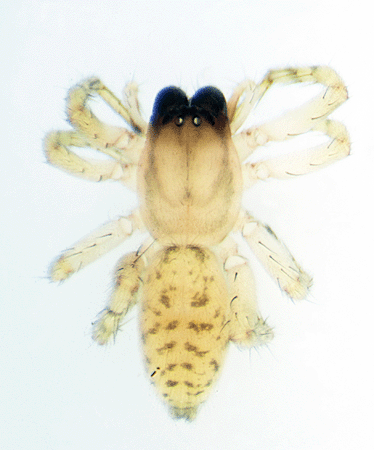
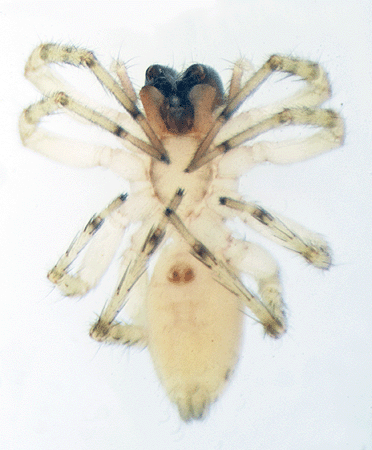
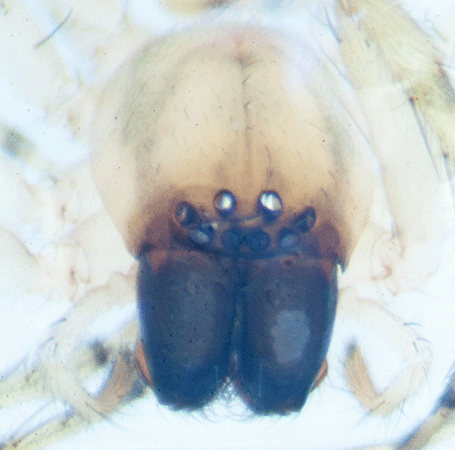 On February 27, 2017, this 4 mm long spider was living in detritus that had accumulated in a
On February 27, 2017, this 4 mm long spider was living in detritus that had accumulated in a 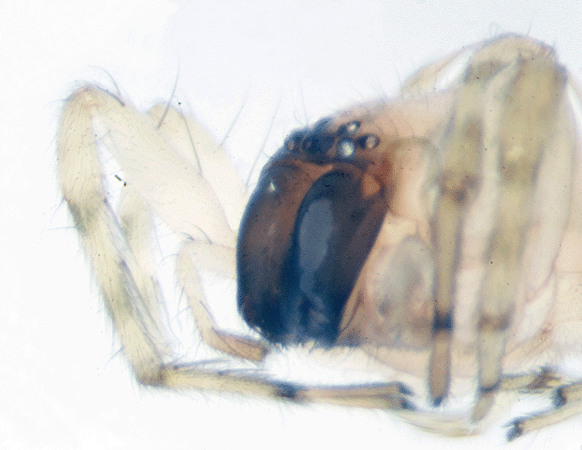 As quoted from page 22 of Florida's Fabulous Spiders 2001 by Sam Marshall and G. G. Edwards, "Ghost spiders are similar in appearance to sac spiders, and used to be placed in the same family. They differ in that they have two rows of club-shaped hairs on the bottoms of their feet, and their tracheal spiracle is located well in front of the spinnerets, unlike most spiders which have their tracheal opening right in front of the spinnerets."
As quoted from page 22 of Florida's Fabulous Spiders 2001 by Sam Marshall and G. G. Edwards, "Ghost spiders are similar in appearance to sac spiders, and used to be placed in the same family. They differ in that they have two rows of club-shaped hairs on the bottoms of their feet, and their tracheal spiracle is located well in front of the spinnerets, unlike most spiders which have their tracheal opening right in front of the spinnerets." 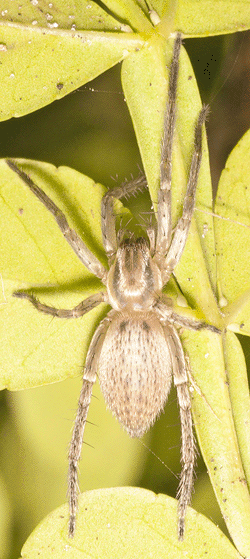
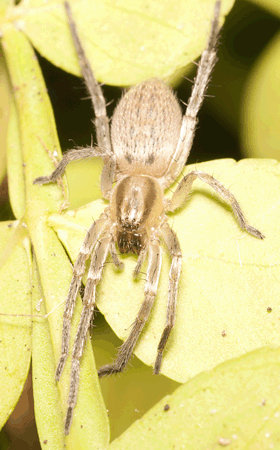
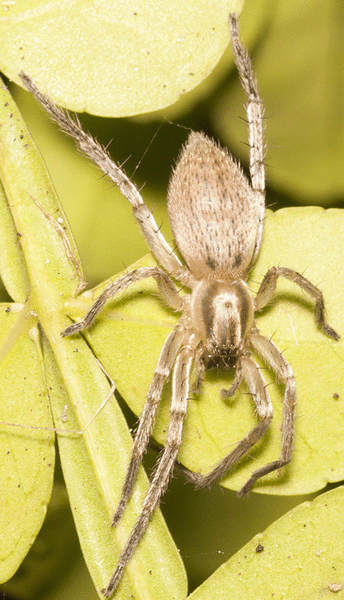
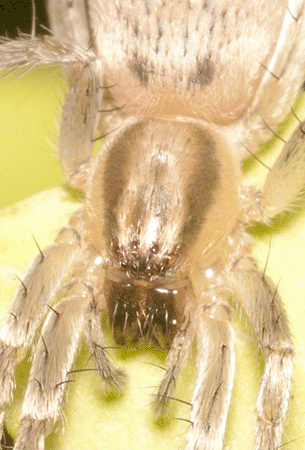
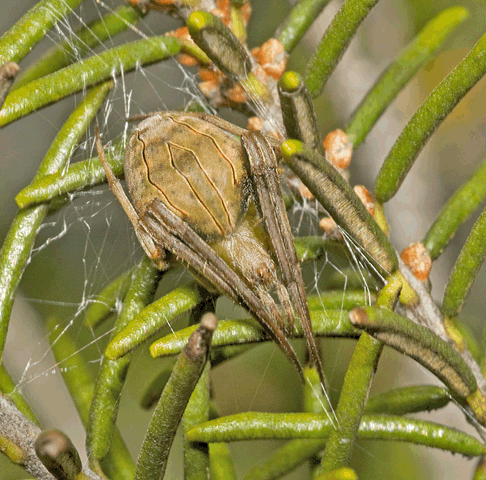
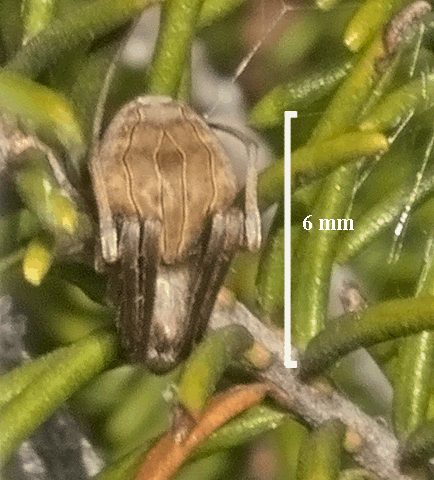
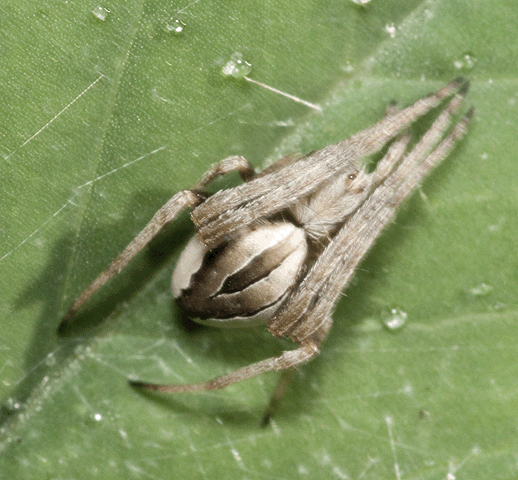
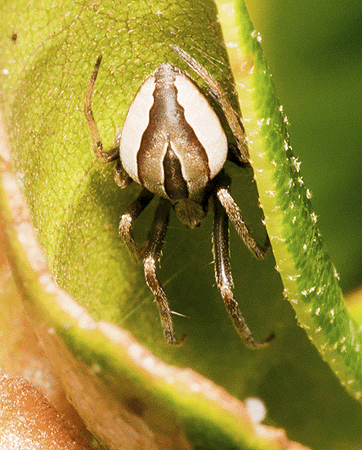
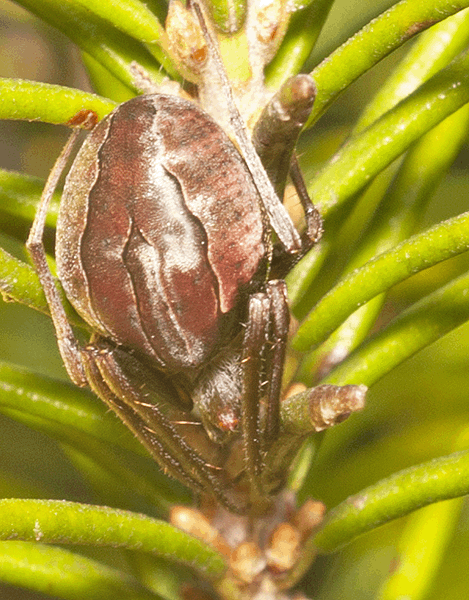 immediately left was photographed on
immediately left was photographed on 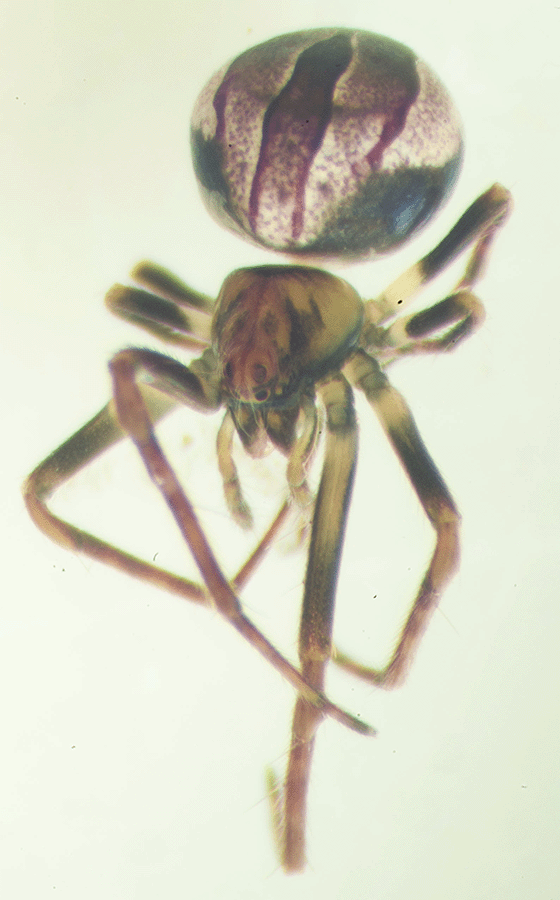
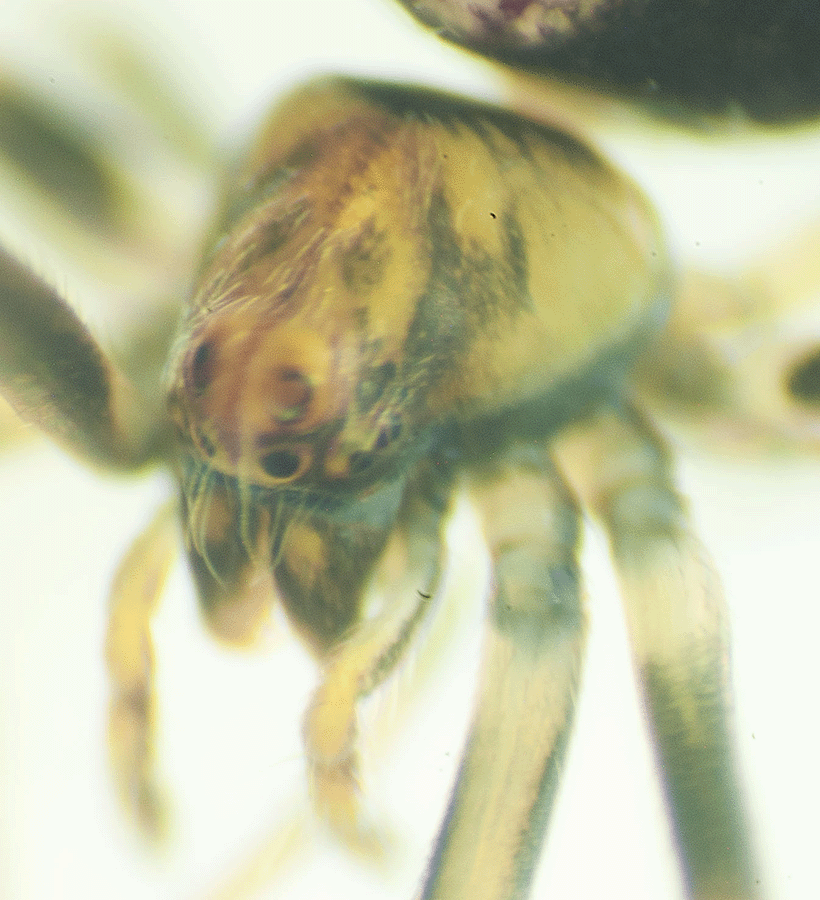
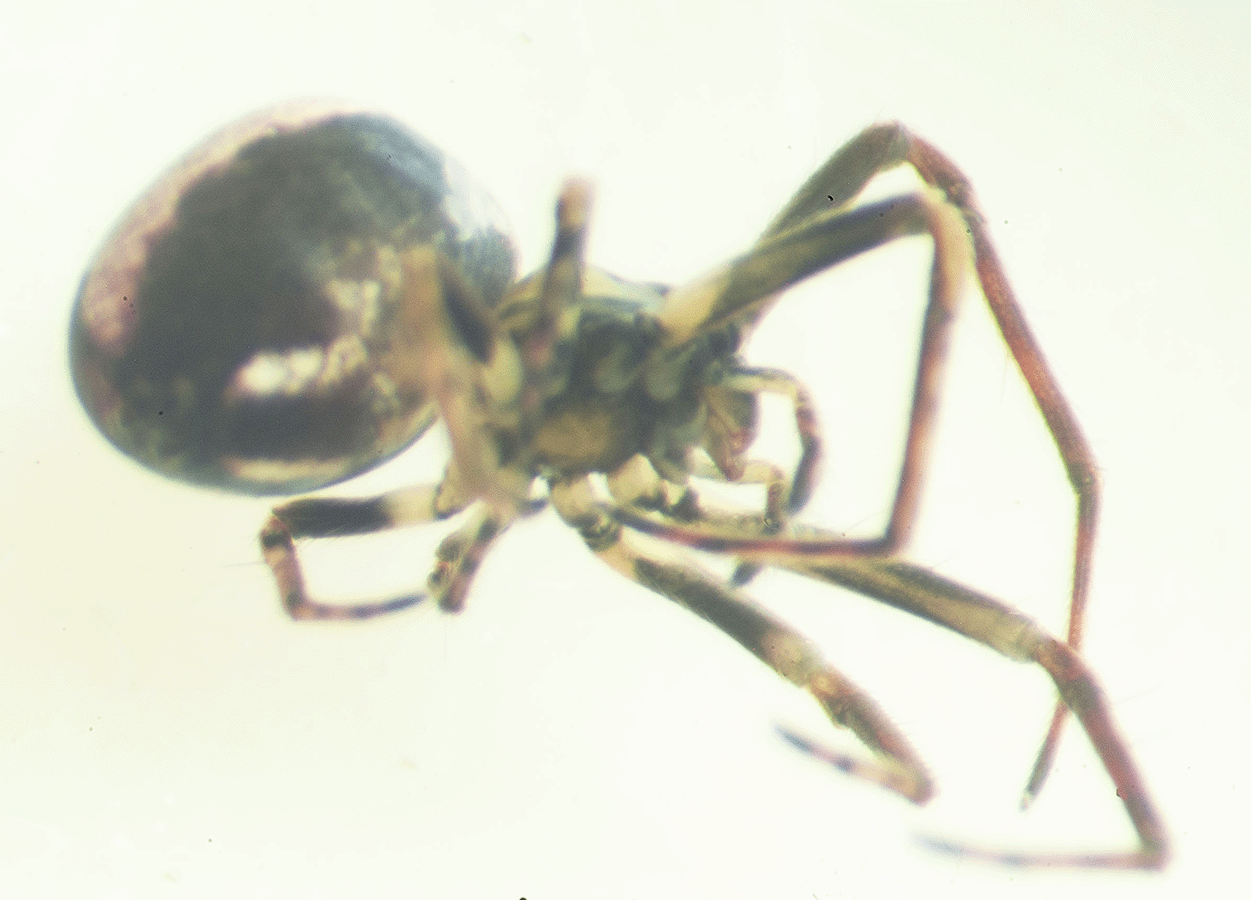
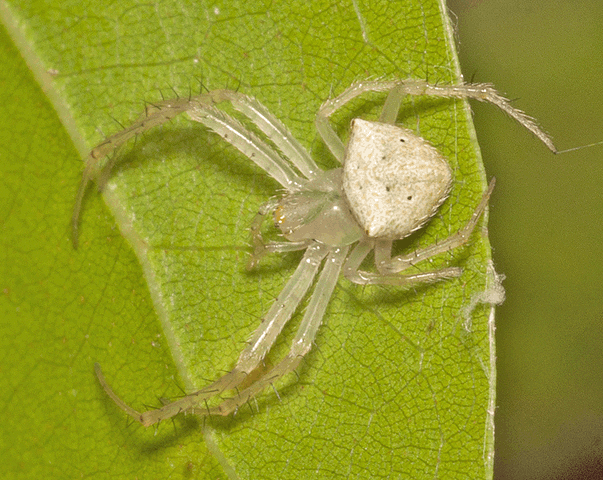 On April 11, 2014, this spider had a web stretched across a narrow path in a hammock area in the Smith Preserve. When the web was disturbed, the spider scurried along a silk thread to a leaf.
On April 11, 2014, this spider had a web stretched across a narrow path in a hammock area in the Smith Preserve. When the web was disturbed, the spider scurried along a silk thread to a leaf. 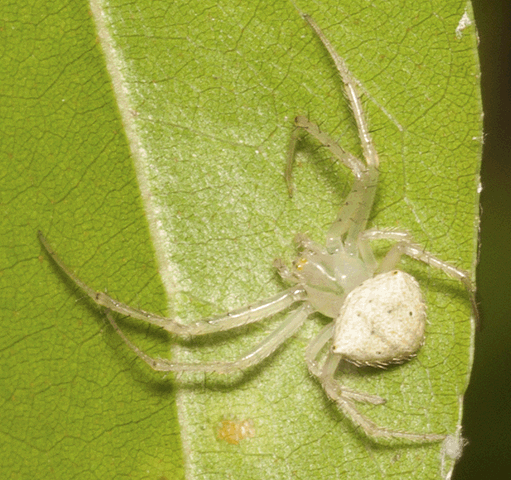 On that same day, the species was identified from these photographs by John and Jane Balaban, Contributing Editors of <bugguide.net>, hosted by Iowa State University Entomology Department.
On that same day, the species was identified from these photographs by John and Jane Balaban, Contributing Editors of <bugguide.net>, hosted by Iowa State University Entomology Department.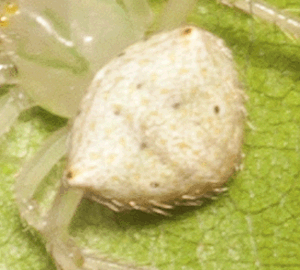 Note the distinctive shape of this spider's abdomen and the reddish colored dots on the pointed tips on the abdomen. These are characteristics that helped the Balabans distinguish this species from others.
Note the distinctive shape of this spider's abdomen and the reddish colored dots on the pointed tips on the abdomen. These are characteristics that helped the Balabans distinguish this species from others. 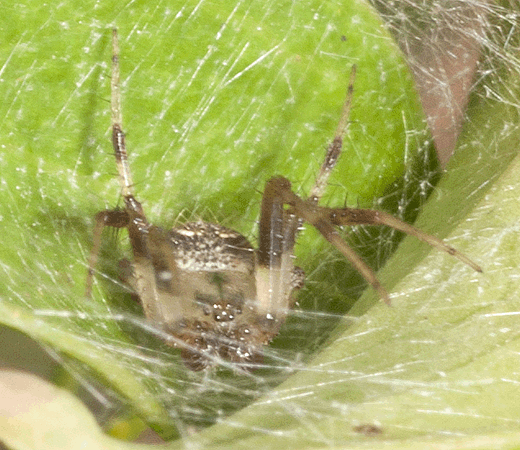
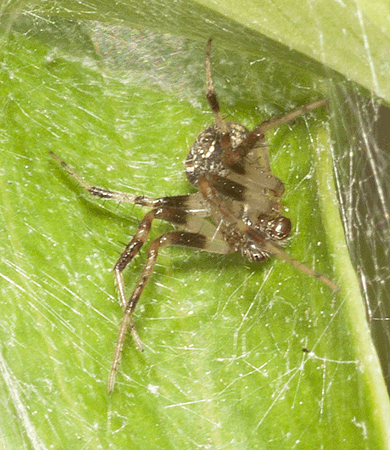
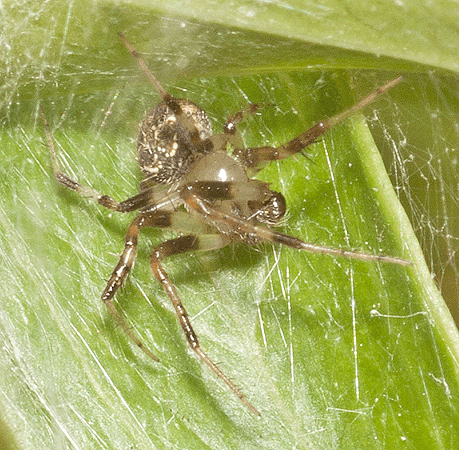
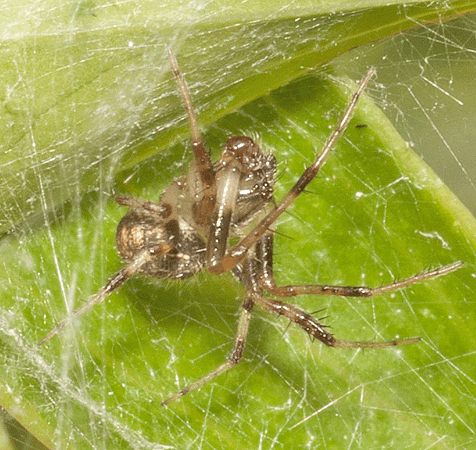
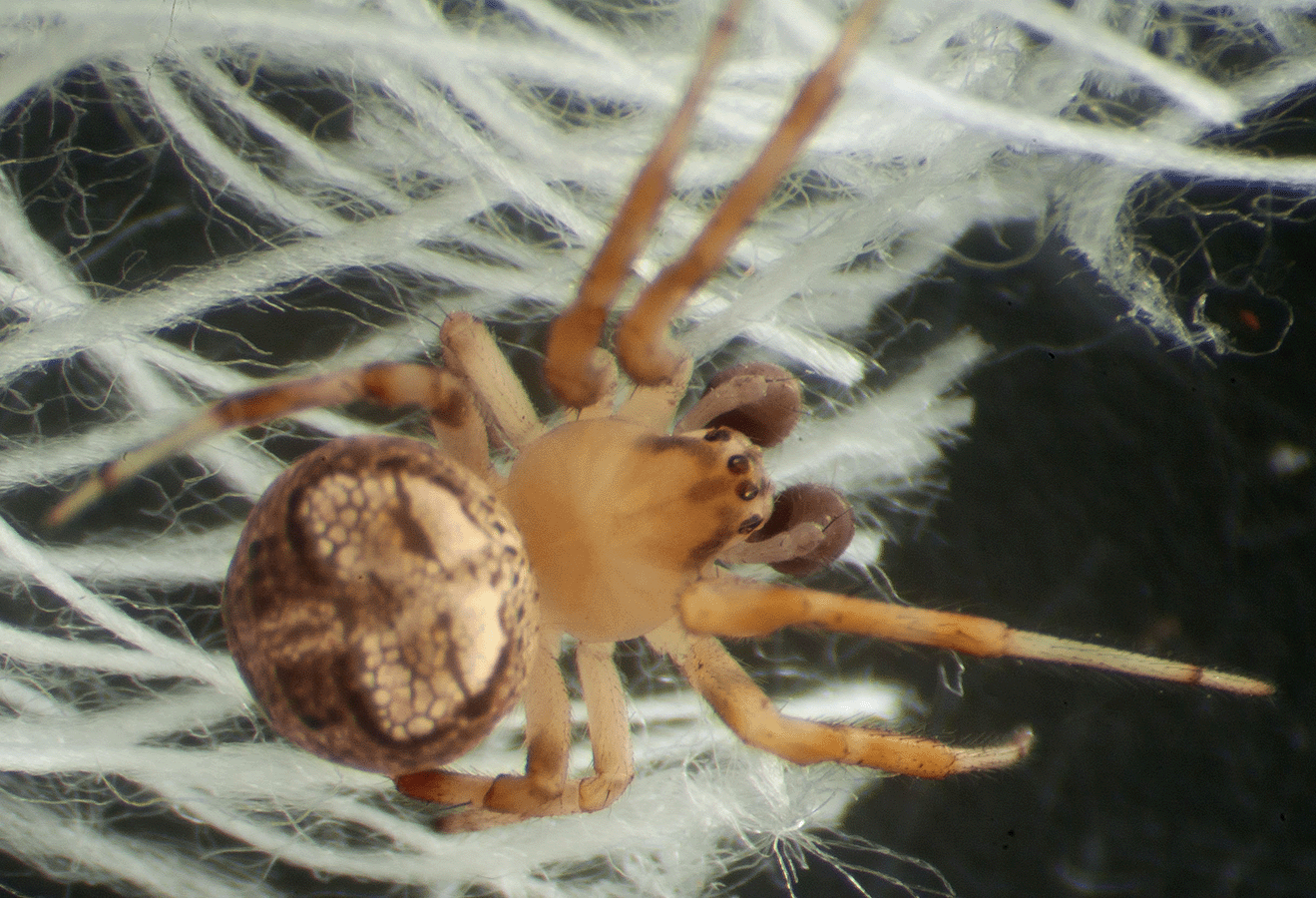
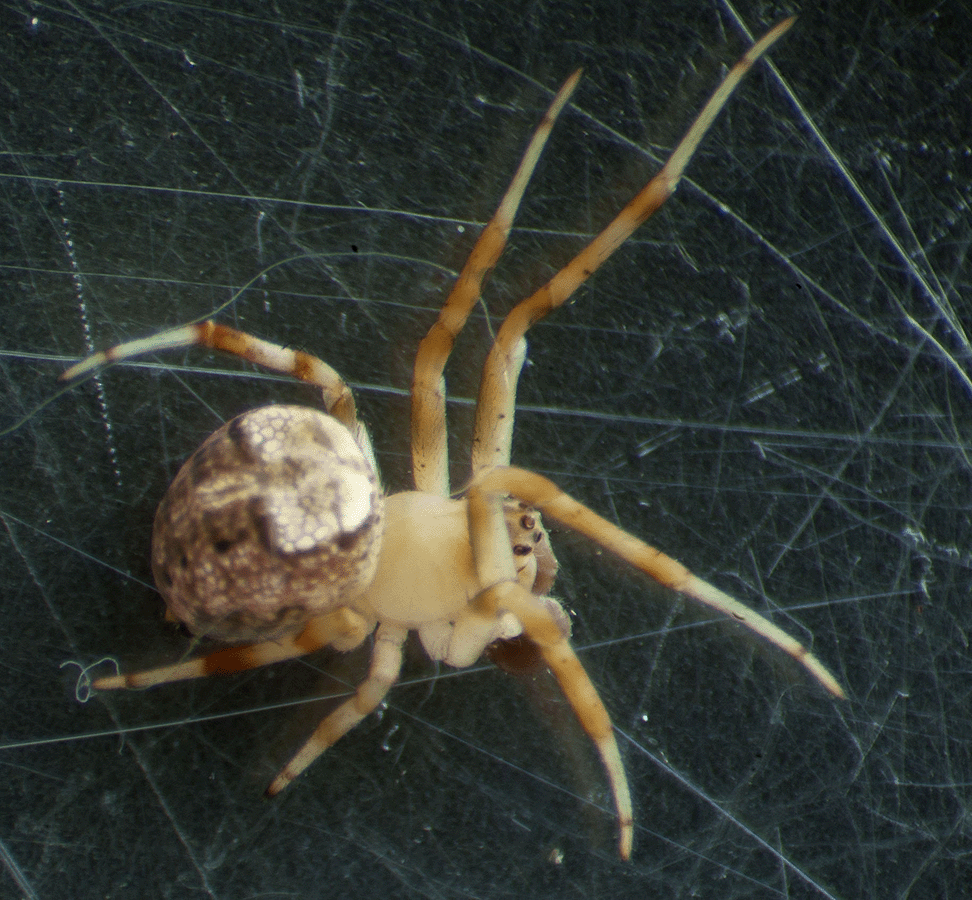
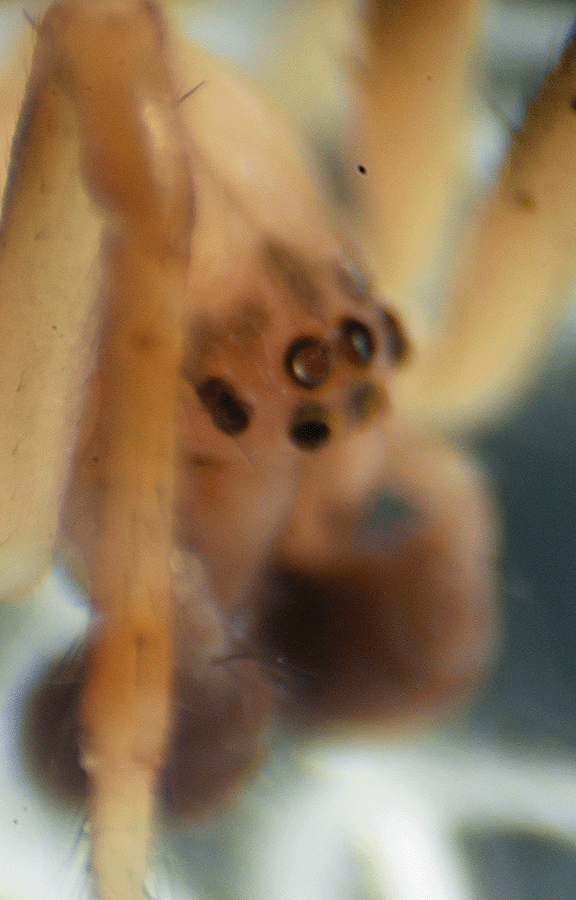
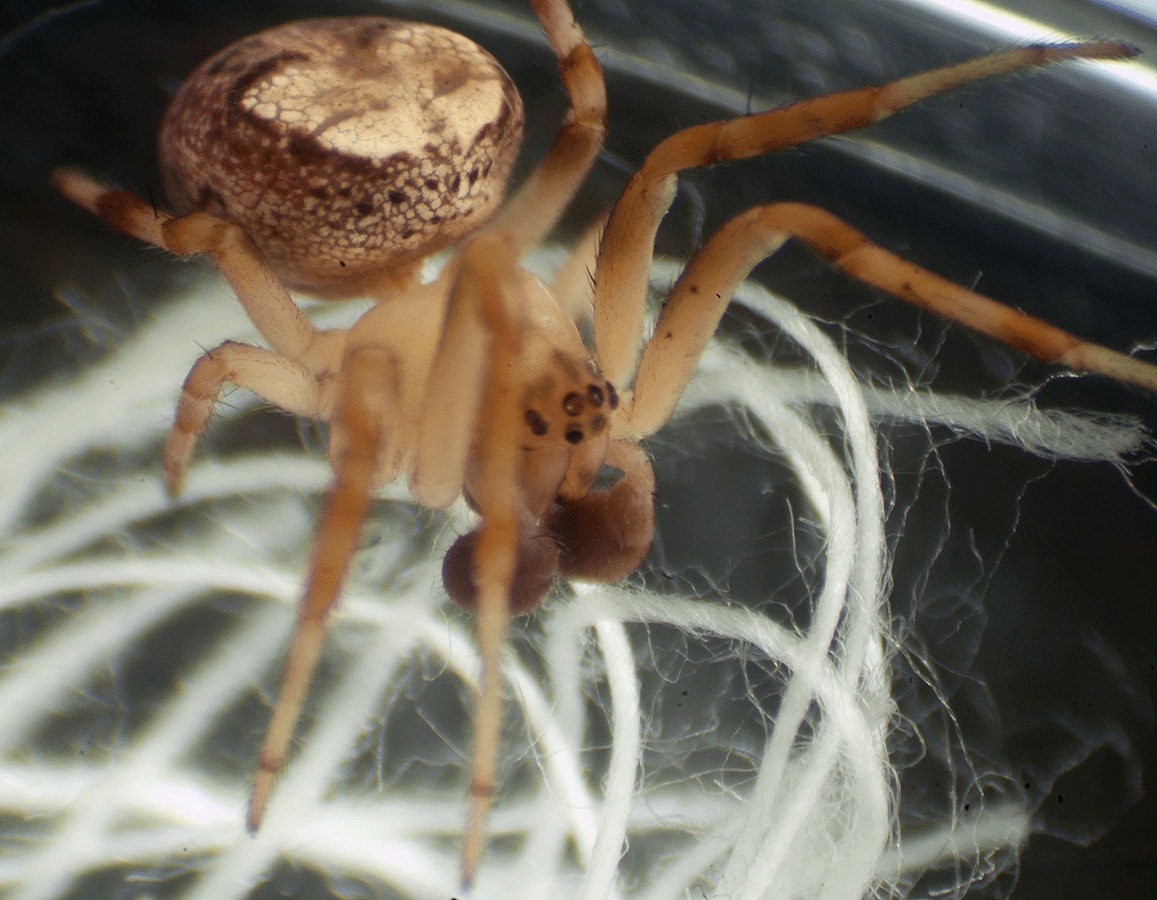
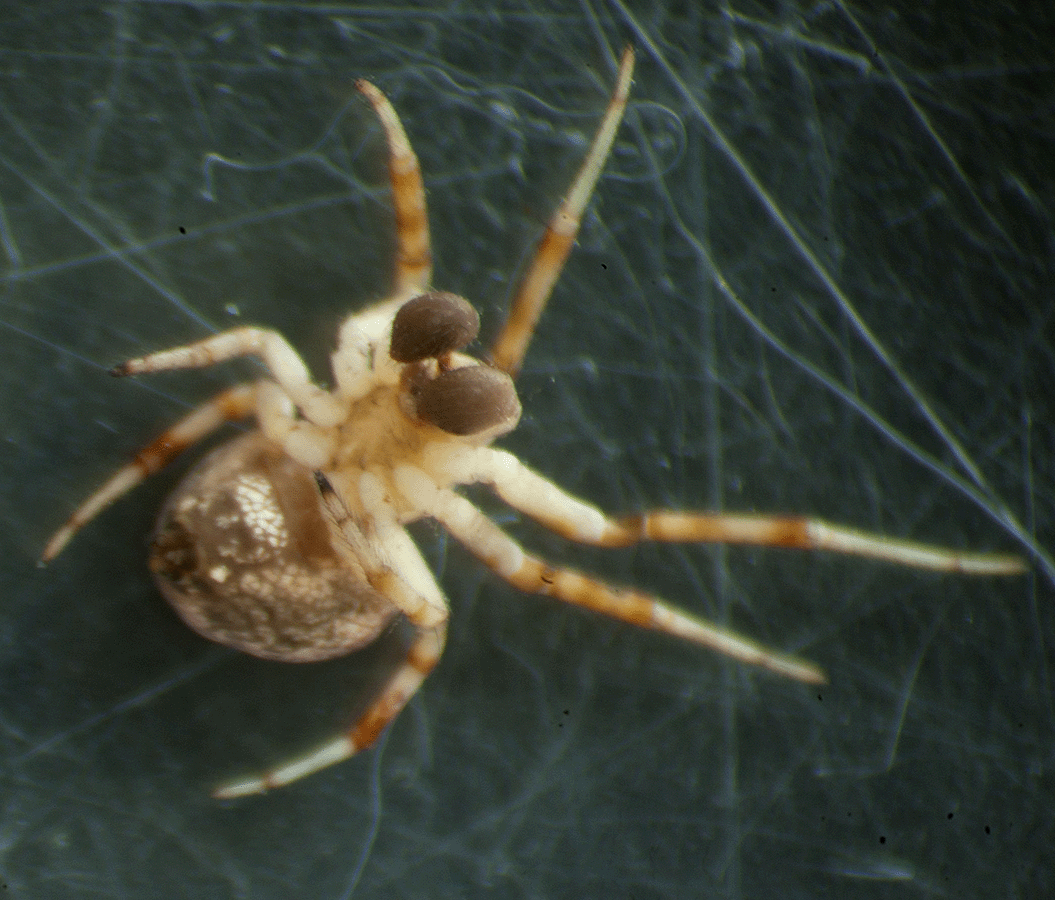
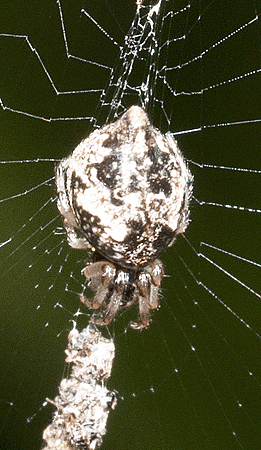
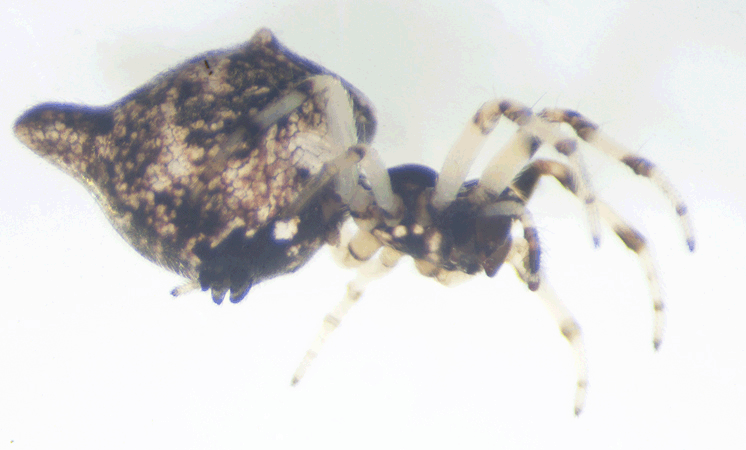
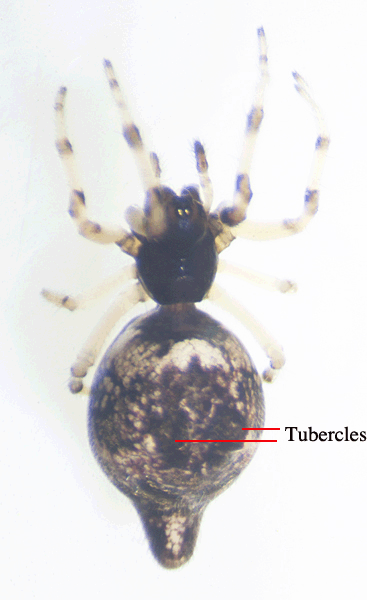 On December 12, 2017, the genus was confirmed, and the species was identified by John and Jane Balaban, Contributors to <BugGuide.net>.They stated, "you can clearly see the tubercles that would make this Cyclosa turbinata.
On December 12, 2017, the genus was confirmed, and the species was identified by John and Jane Balaban, Contributors to <BugGuide.net>.They stated, "you can clearly see the tubercles that would make this Cyclosa turbinata.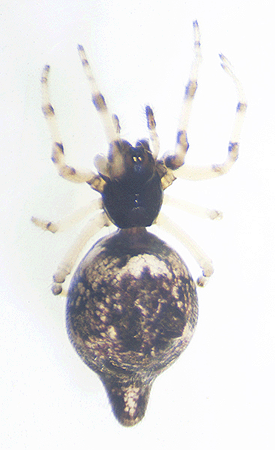
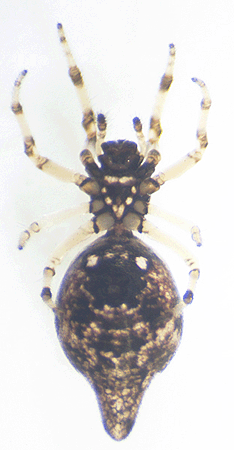
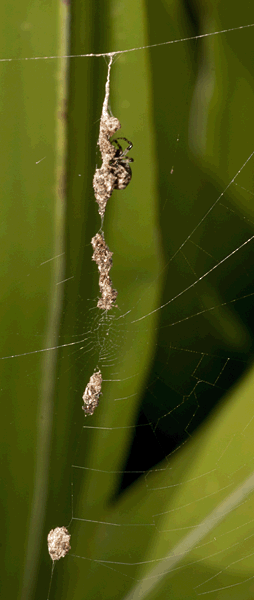
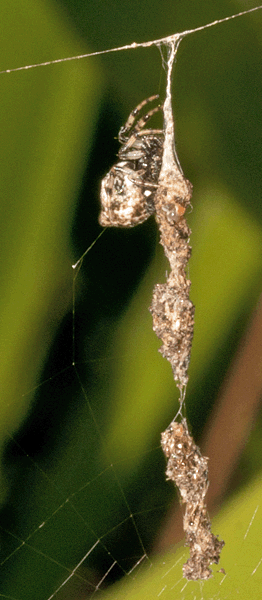
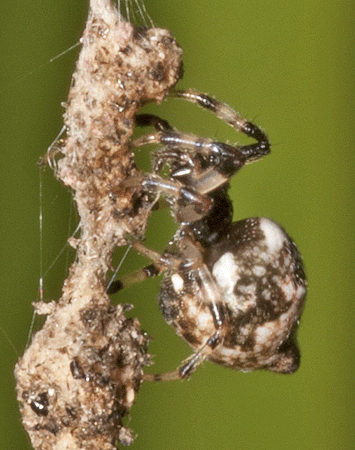 When first discovered, the outer silk strands of the web of this spider were looped between leaflets of a saw palmetto frond and the line of debris was seen in the middle of the web. The spider was not seen. When the silk was touched, the spider scurried to the top of the debris strand.
When first discovered, the outer silk strands of the web of this spider were looped between leaflets of a saw palmetto frond and the line of debris was seen in the middle of the web. The spider was not seen. When the silk was touched, the spider scurried to the top of the debris strand. 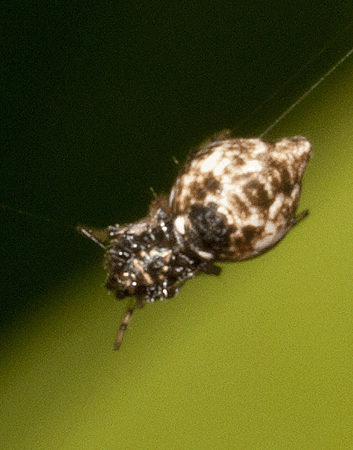
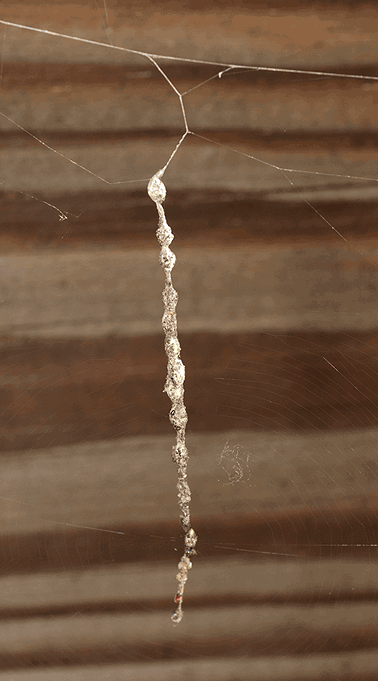 On August 5, 2016, the spider's identification was confirmed as Cyclosa sp. by Chad Heins, a Contributing Editor of <BugGuide.net>. Heins pointed out that the spider is at the bottom of the vertical cluster of remnants of previous meals on the horizontal strand of silk. Below, the spider is indicated by the yellow arrow.
On August 5, 2016, the spider's identification was confirmed as Cyclosa sp. by Chad Heins, a Contributing Editor of <BugGuide.net>. Heins pointed out that the spider is at the bottom of the vertical cluster of remnants of previous meals on the horizontal strand of silk. Below, the spider is indicated by the yellow arrow.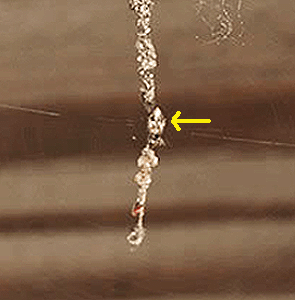
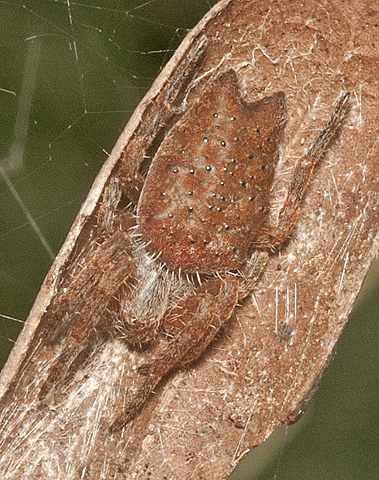 This spider, known to occur in warmer areas of Europe, Asia, Africa, Australia, Costa Rica, Hispaniola, and Colombia, was discovered to be living in Miami-Dade County, Florida in 2000.
This spider, known to occur in warmer areas of Europe, Asia, Africa, Australia, Costa Rica, Hispaniola, and Colombia, was discovered to be living in Miami-Dade County, Florida in 2000. 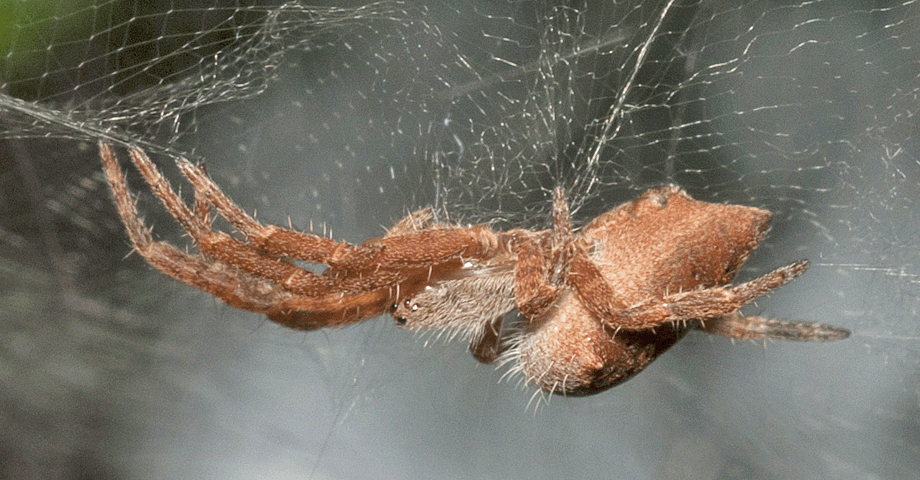
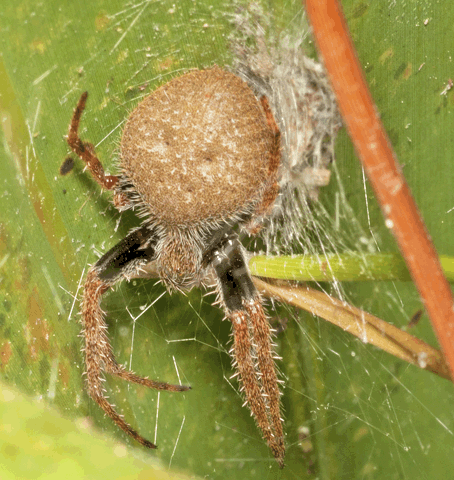
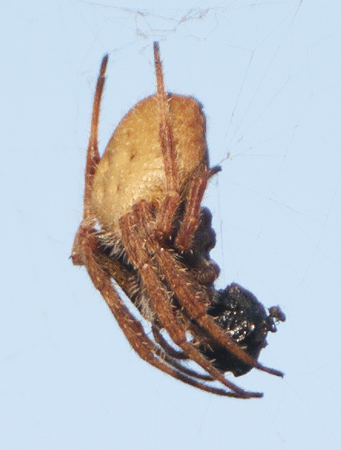
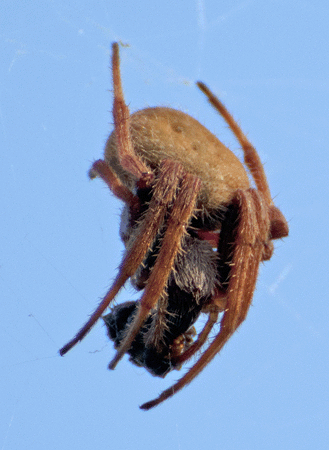
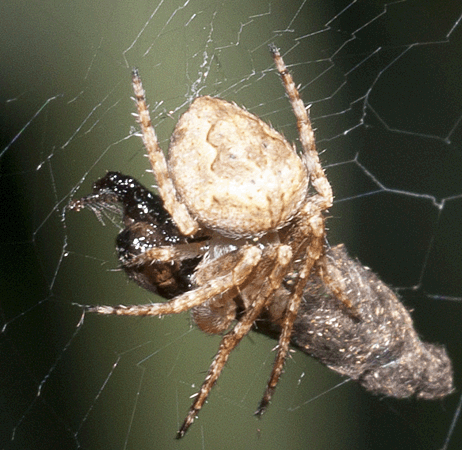
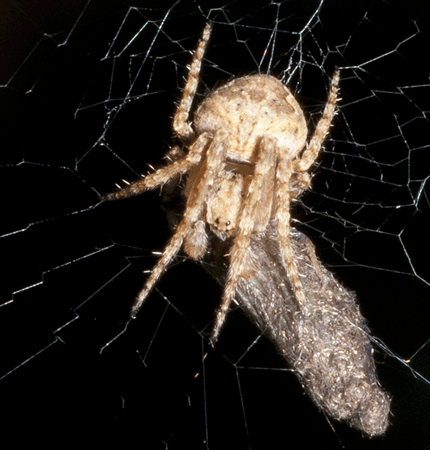
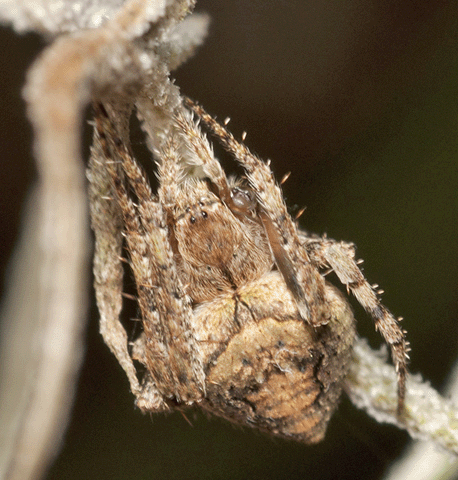
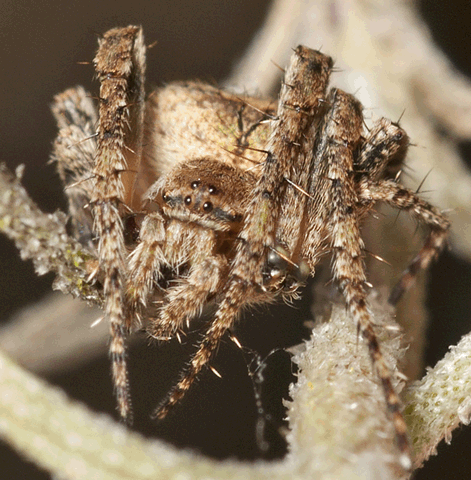
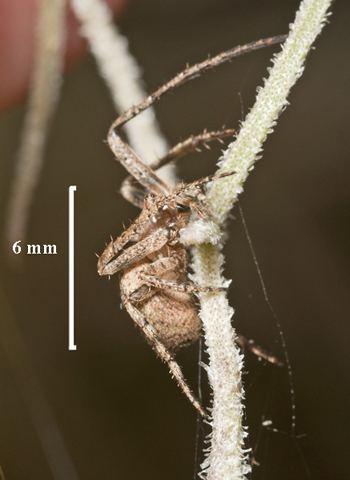
 On December 4, 2017, this ~5.5 mm female spider was photographed in its web, constructed among several tree branches in the oak hammock in the northeast quadrant of the Smith Preserve.
On December 4, 2017, this ~5.5 mm female spider was photographed in its web, constructed among several tree branches in the oak hammock in the northeast quadrant of the Smith Preserve. 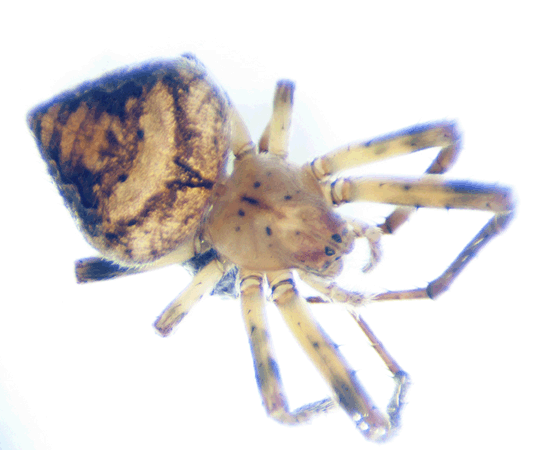 Photographs were taken of the living specimen, as well as the same individual preserved in alcohol.
Photographs were taken of the living specimen, as well as the same individual preserved in alcohol. 
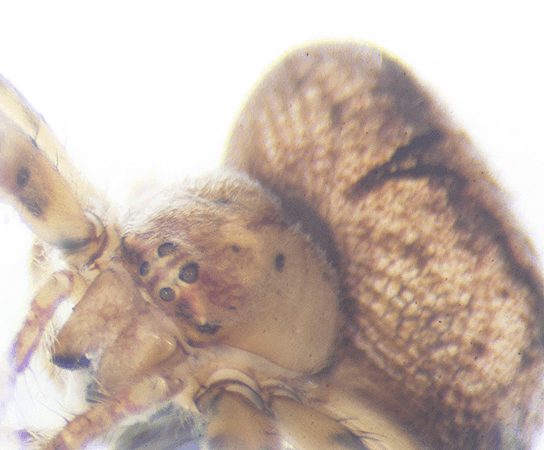
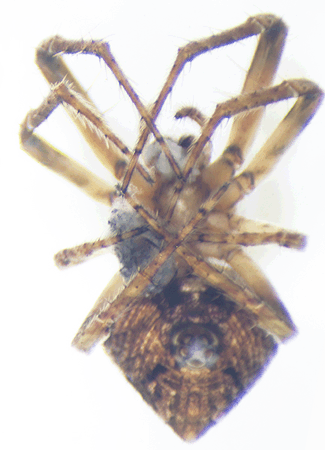
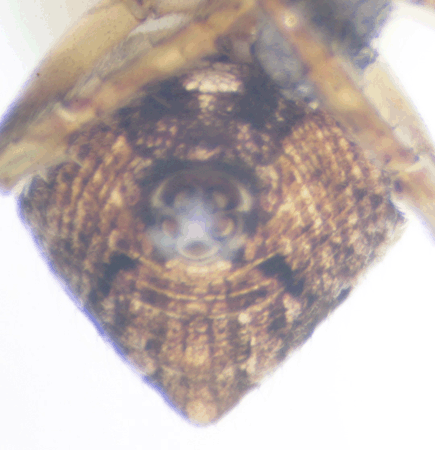
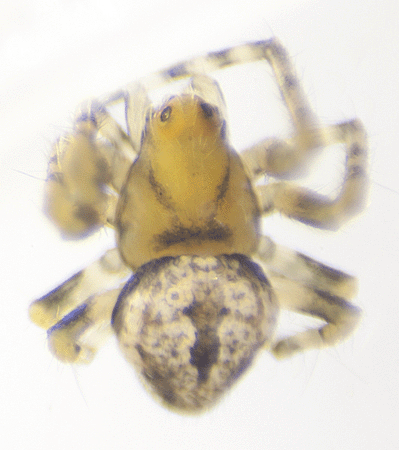 On January 26, 2016, this 1.25 mm spider was captured in a sweep net collection obtained in
On January 26, 2016, this 1.25 mm spider was captured in a sweep net collection obtained in 

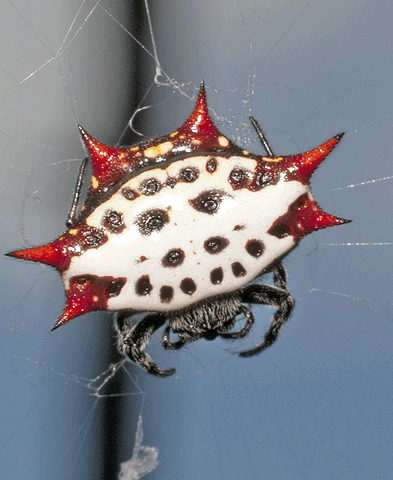
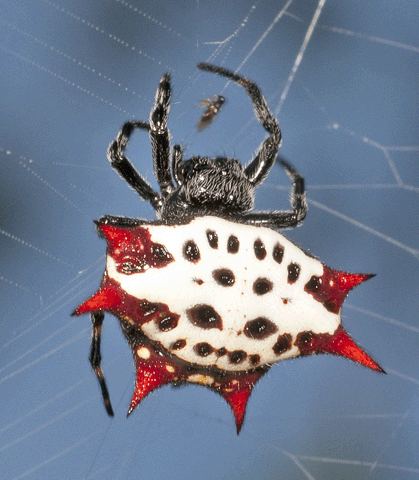 Male spiders are much smaller than females and their spines are reduced to 4 or 5 stubby projections.
Male spiders are much smaller than females and their spines are reduced to 4 or 5 stubby projections.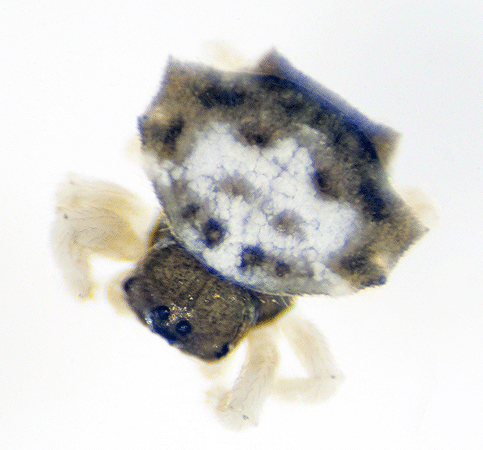
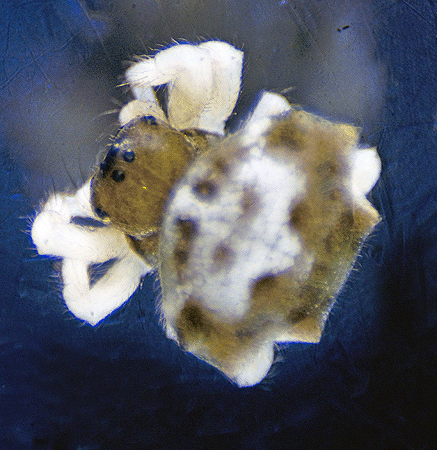
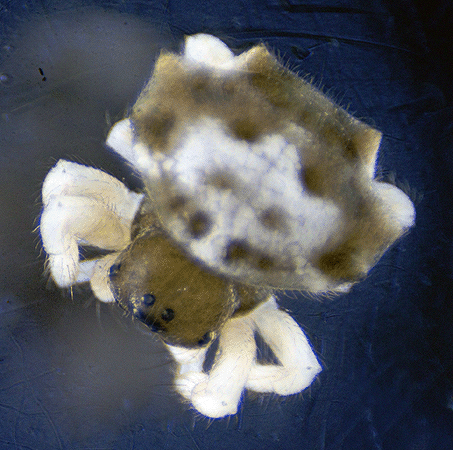

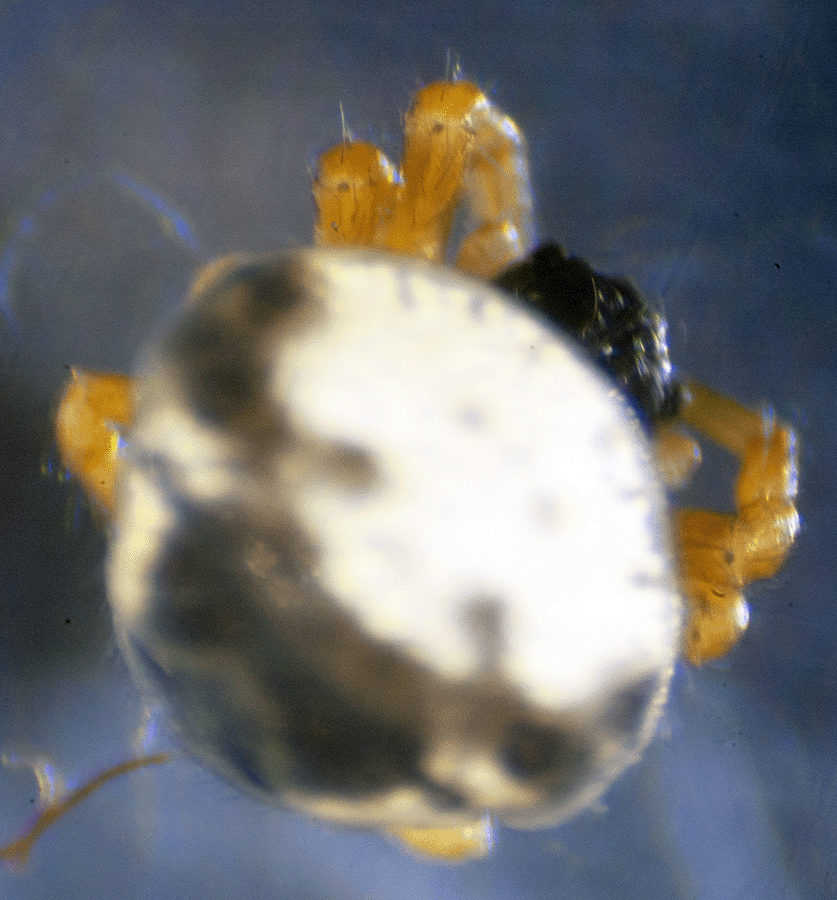
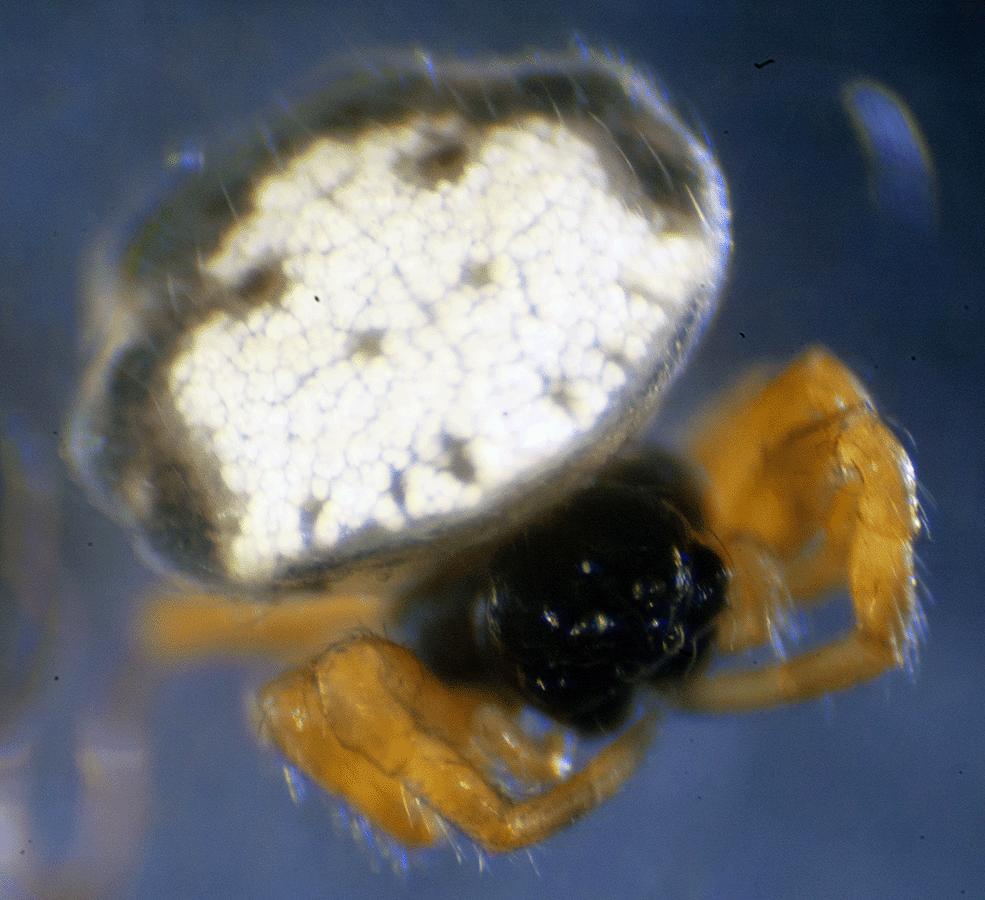
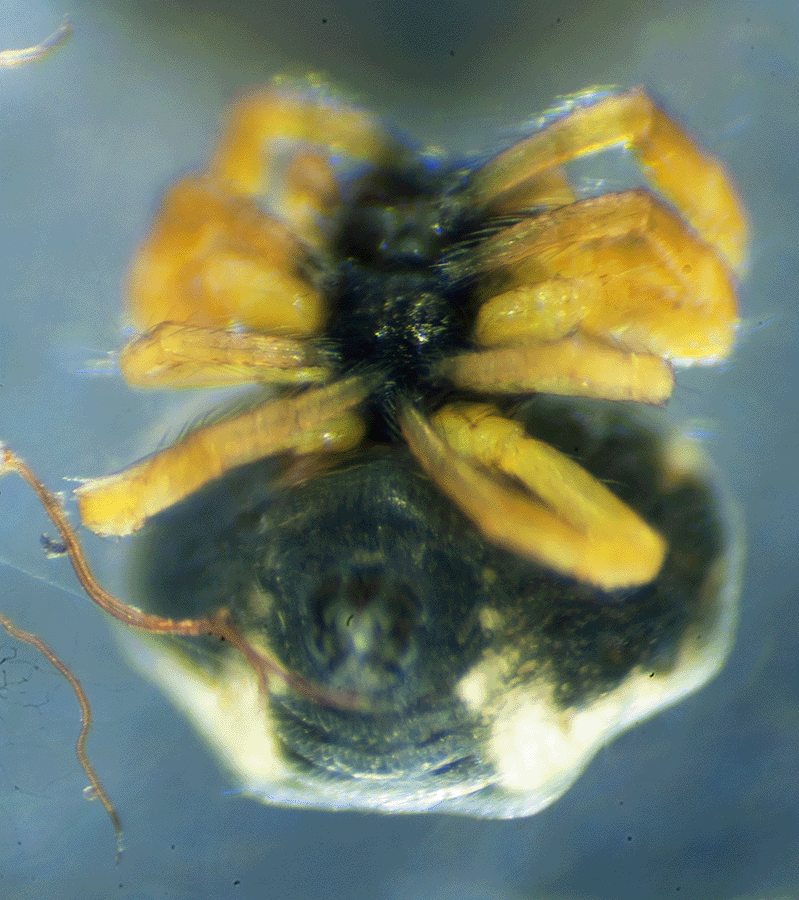
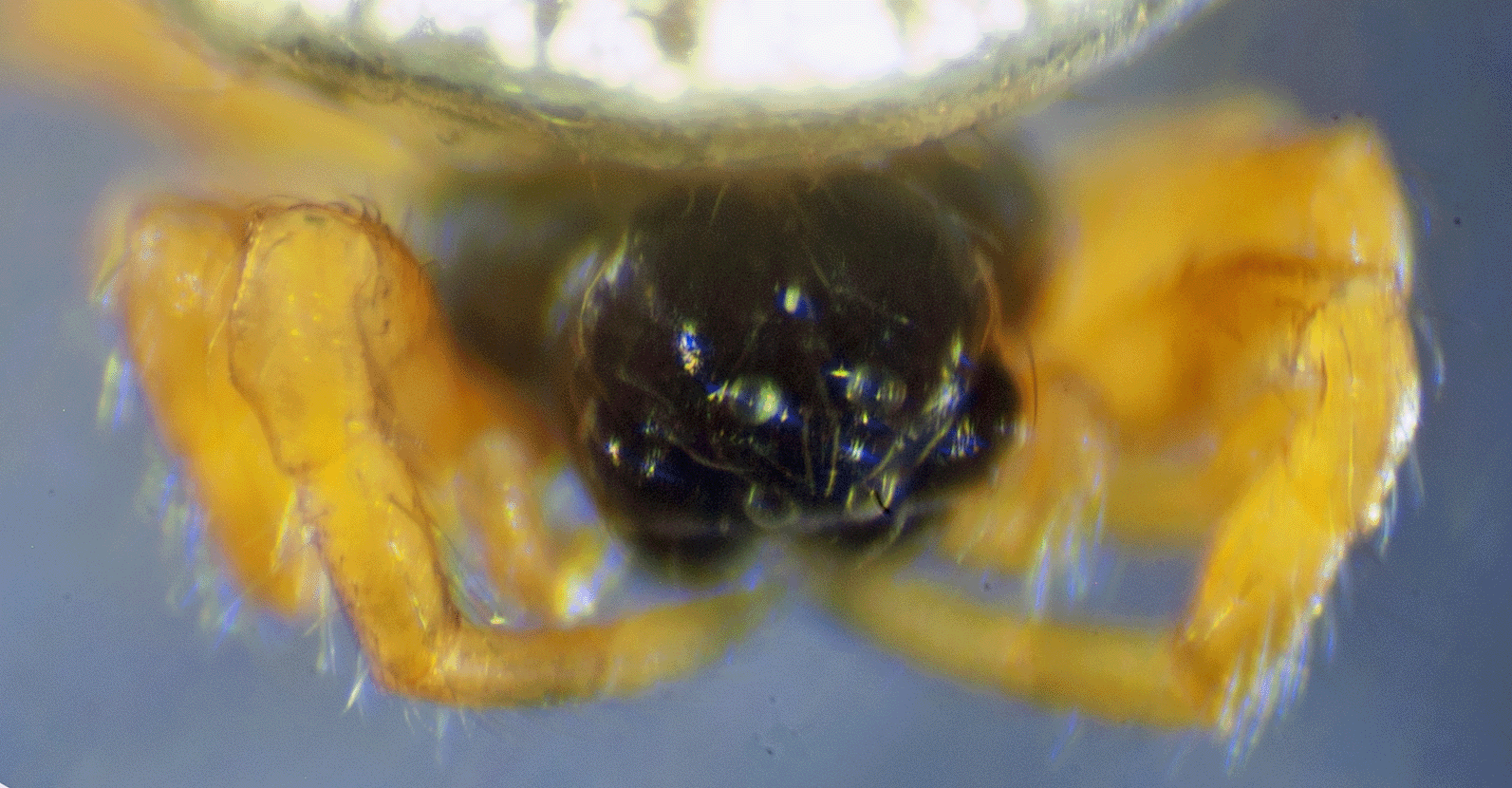
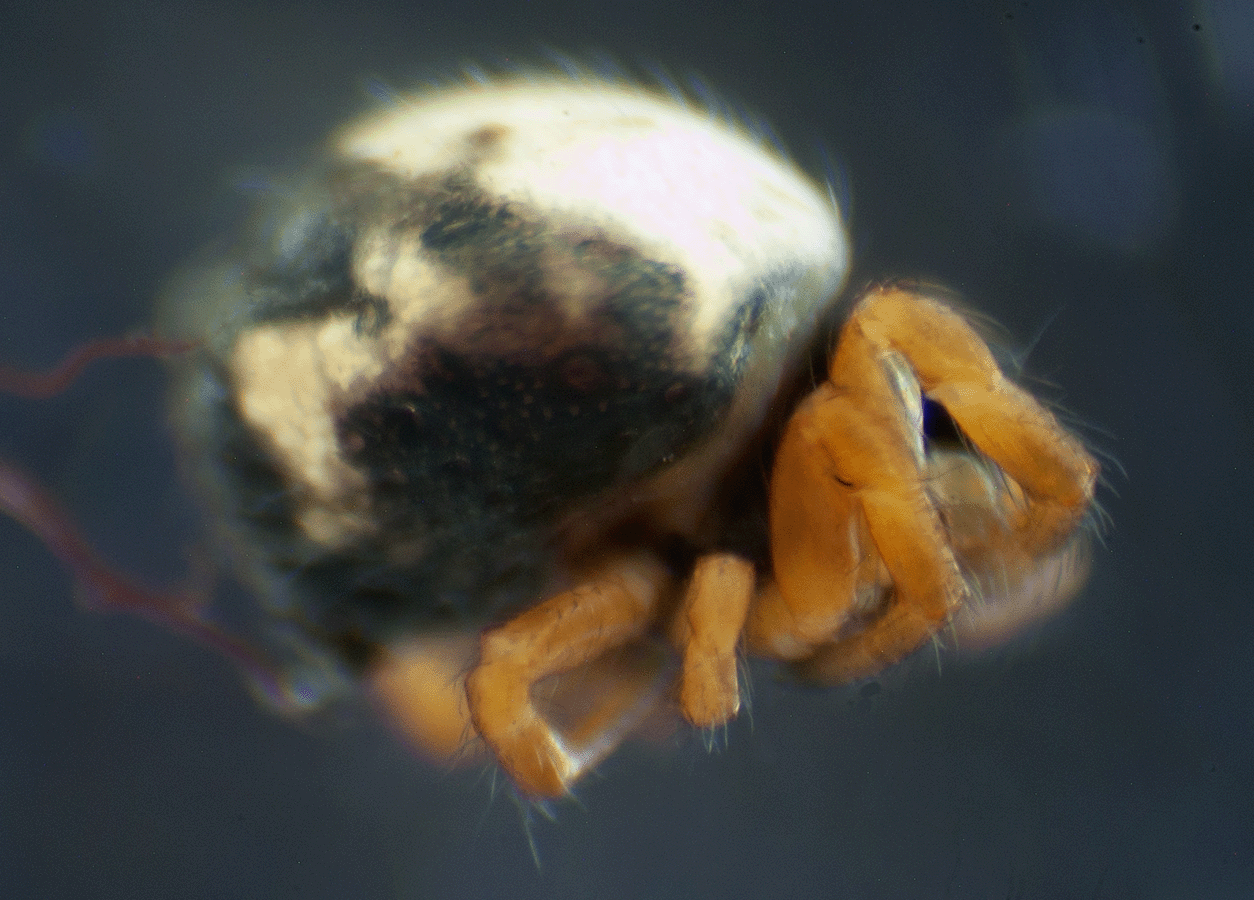
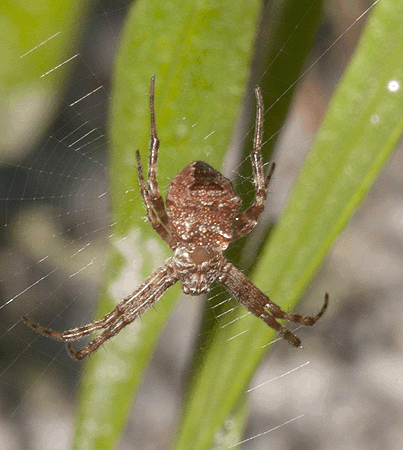 On April 1, 2015, this 5 mm long spider had its web spread between vertical pieces of vegetation close to the ground in a sandy lichen-covered region of the scrub, adjacent to sand live oaks. The first and third photographs are dorsal views, the second image is a ventral view.
On April 1, 2015, this 5 mm long spider had its web spread between vertical pieces of vegetation close to the ground in a sandy lichen-covered region of the scrub, adjacent to sand live oaks. The first and third photographs are dorsal views, the second image is a ventral view.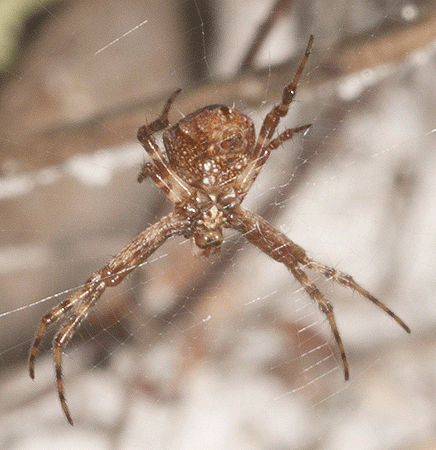 The species name "heptagon,"is derived from the Greek word "heptagonos,"
The species name "heptagon,"is derived from the Greek word "heptagonos,"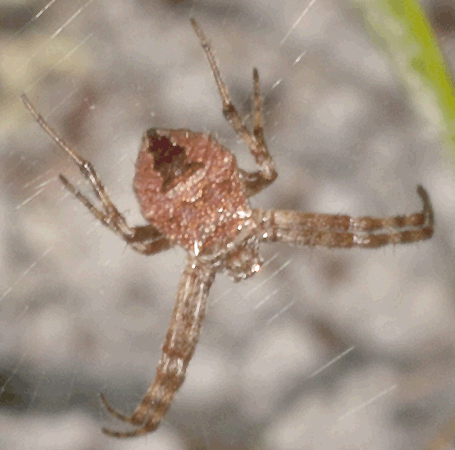 This orb weaver hangs head down in its web and can be identified by its 3 pairs of gray bumps on the back of its abdomen. The species has a large head, brown cephalothorax with yellow markings, and a
This orb weaver hangs head down in its web and can be identified by its 3 pairs of gray bumps on the back of its abdomen. The species has a large head, brown cephalothorax with yellow markings, and a 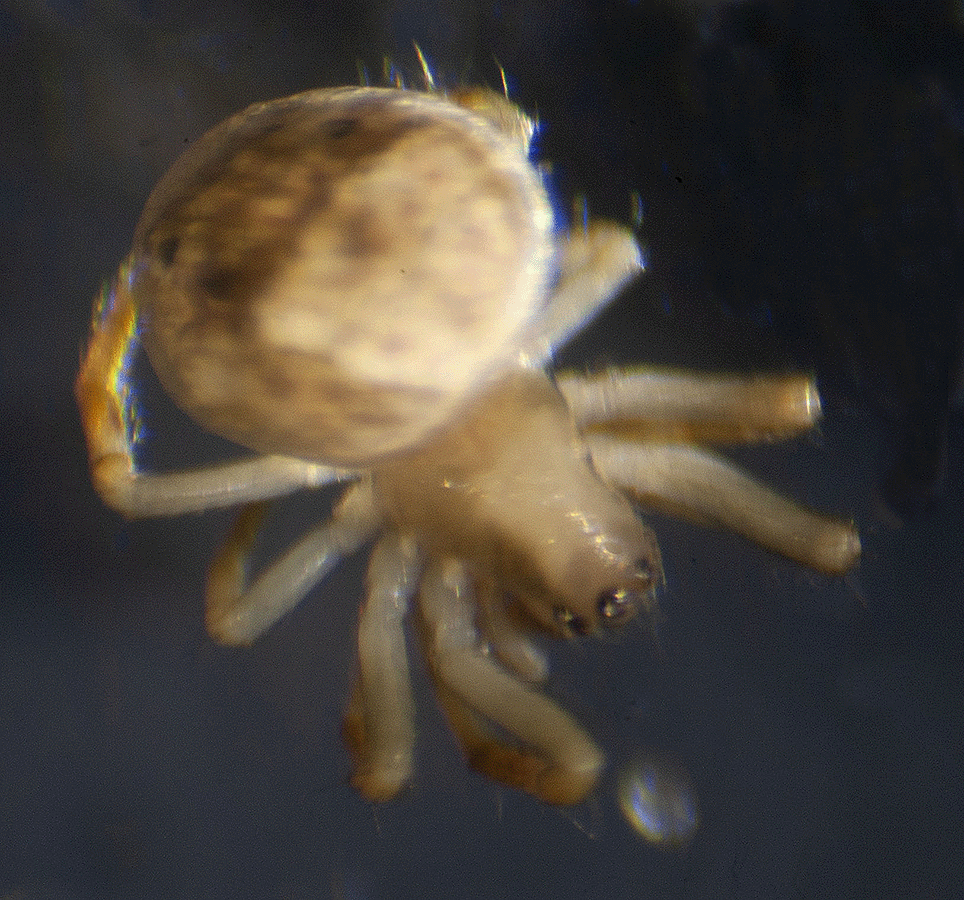
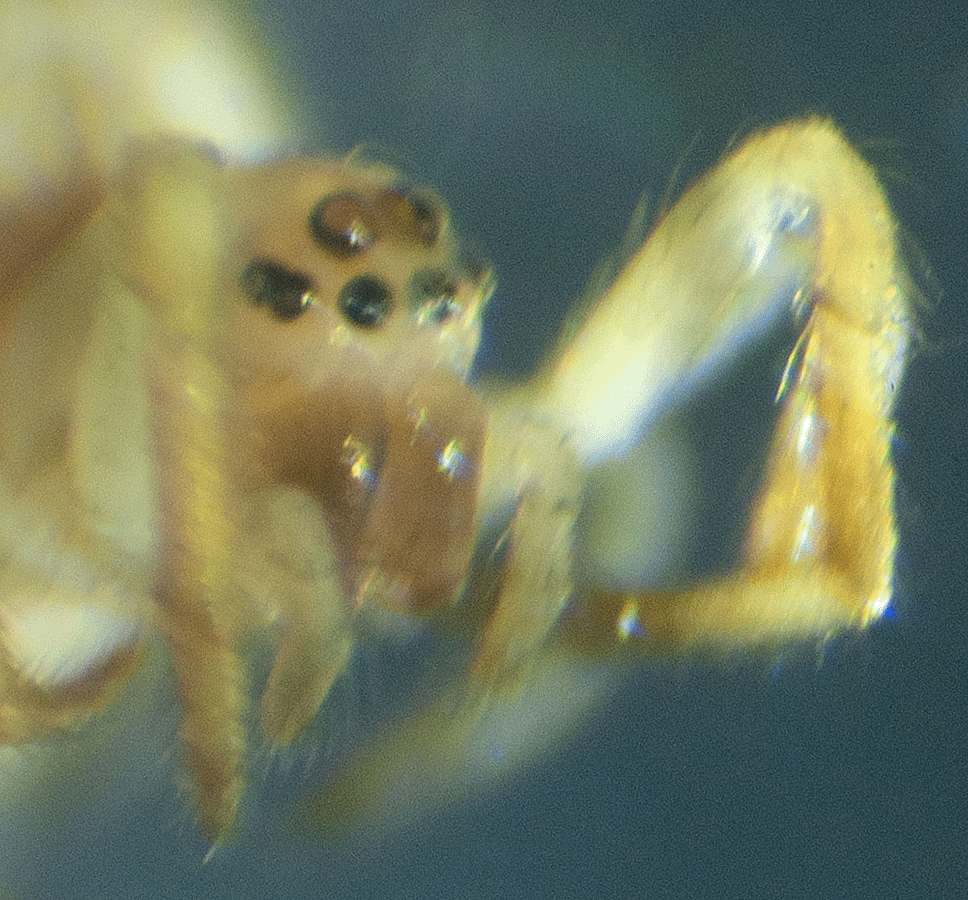
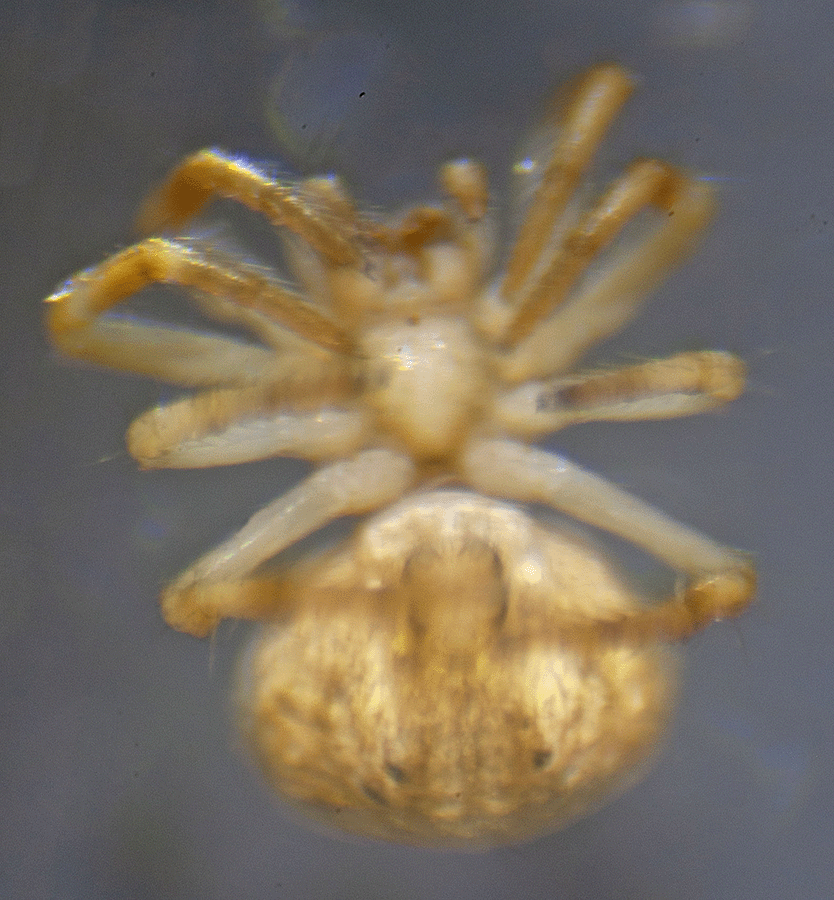
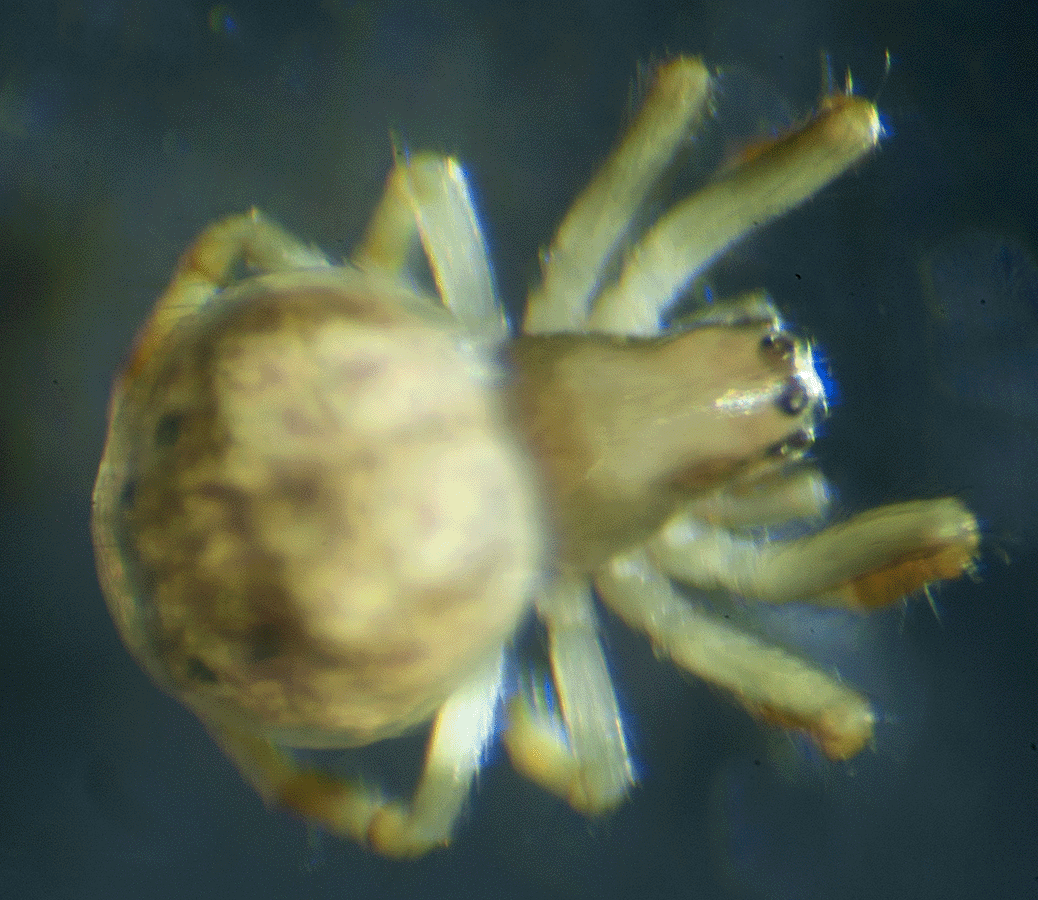
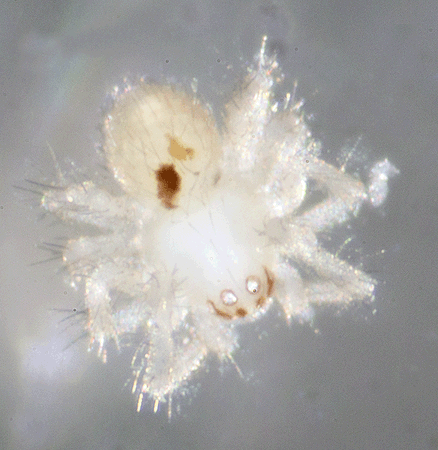
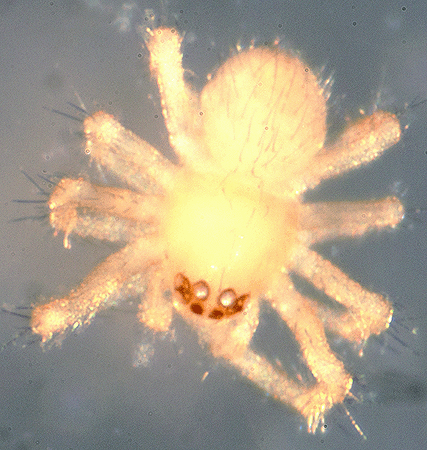
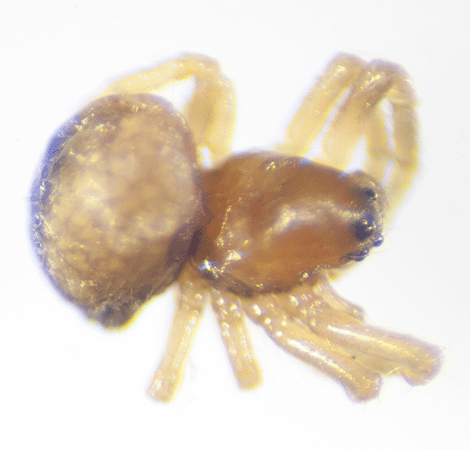 On
On 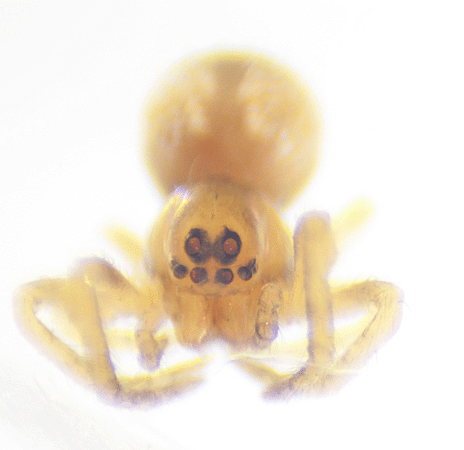
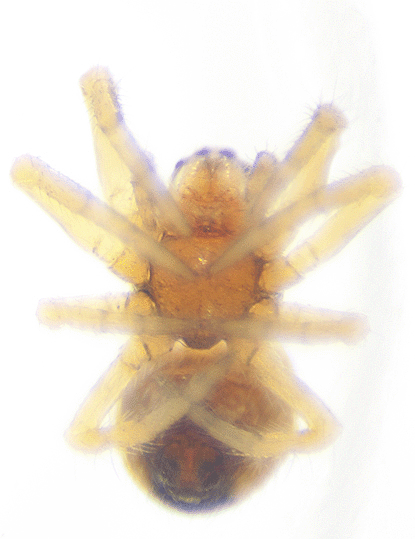
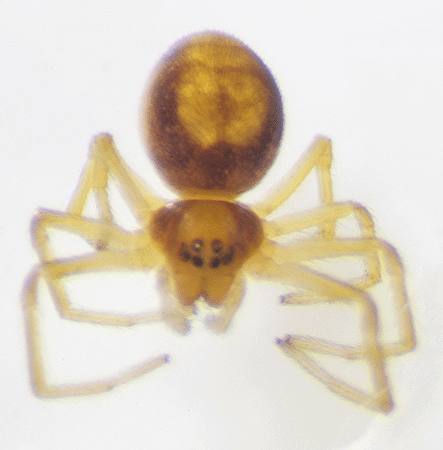
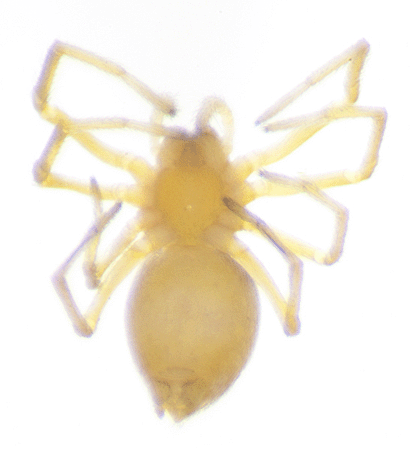
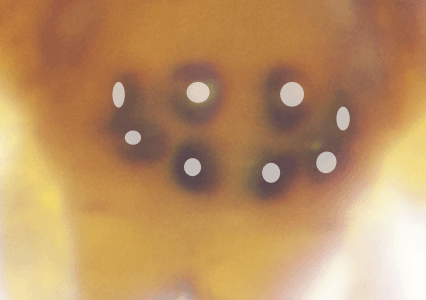 An enlargement of the eye arrangement of this spider is shown at right.
An enlargement of the eye arrangement of this spider is shown at right.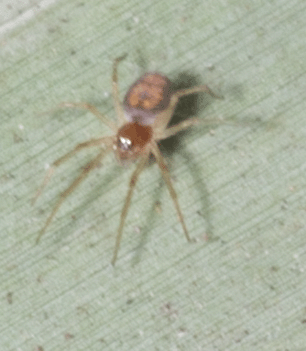
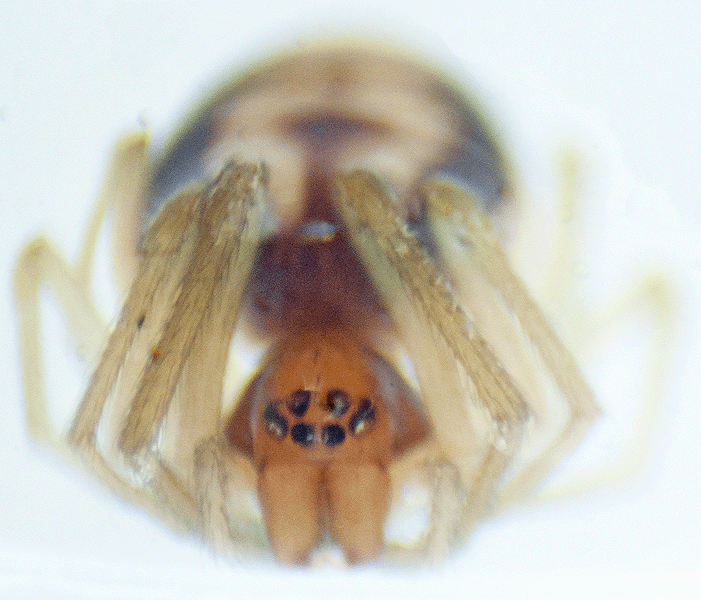
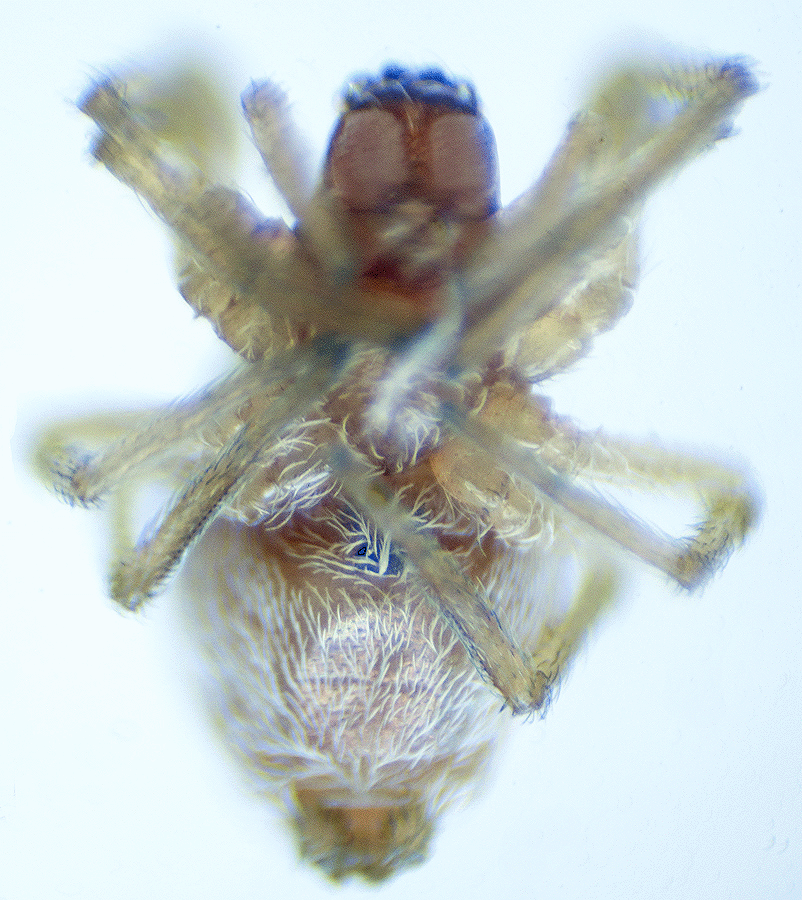
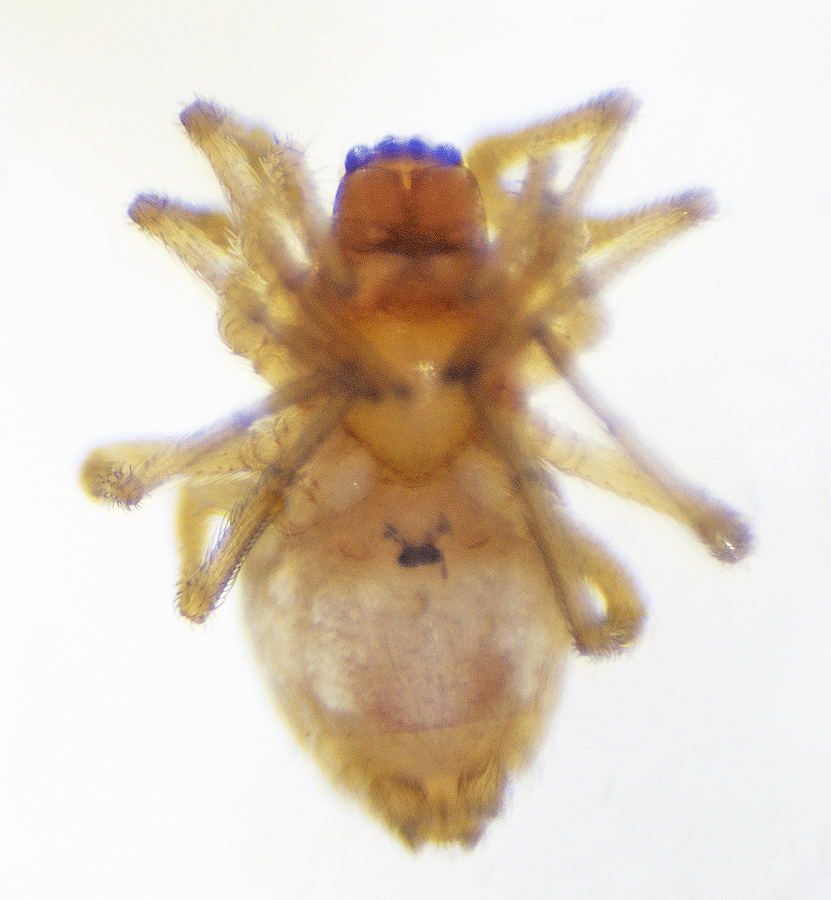
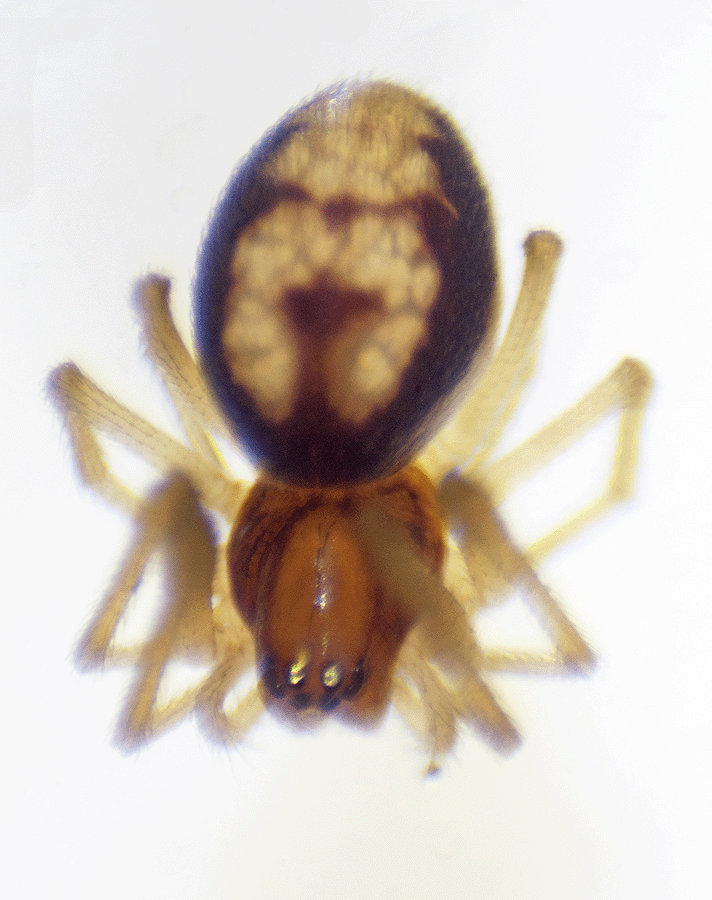
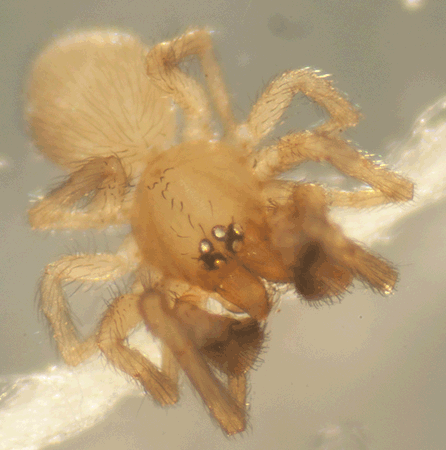 On January 5, 2015, this 1.4 mm long spider was living in pine needle litter under a
On January 5, 2015, this 1.4 mm long spider was living in pine needle litter under a 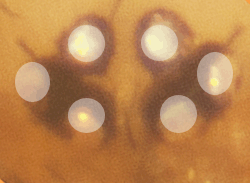
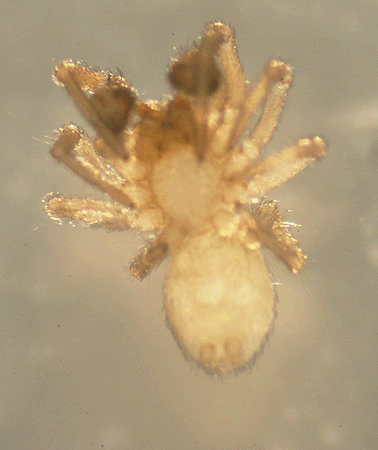
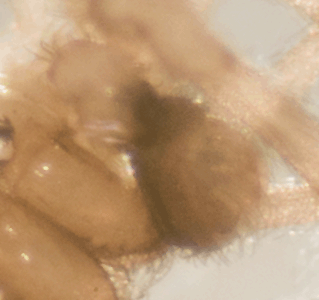
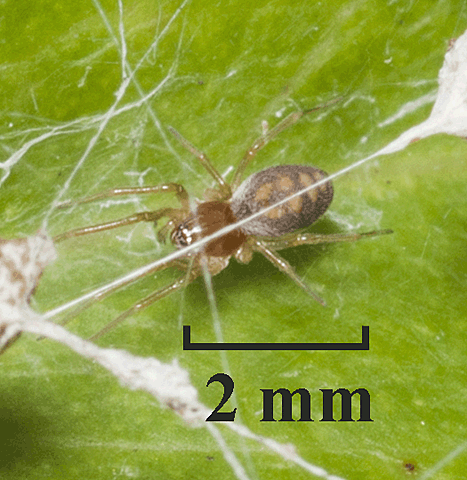 This very tiny spider constructed a complex web above the surface of a smilax leaf. As shown in the second photograph, the tension of the silk strands appear to have pulled the edges of the leaf together. At the center of each triangle of webbing, there is a clump of silk. Perhaps this is an egg sac or silk that is wound around
This very tiny spider constructed a complex web above the surface of a smilax leaf. As shown in the second photograph, the tension of the silk strands appear to have pulled the edges of the leaf together. At the center of each triangle of webbing, there is a clump of silk. Perhaps this is an egg sac or silk that is wound around 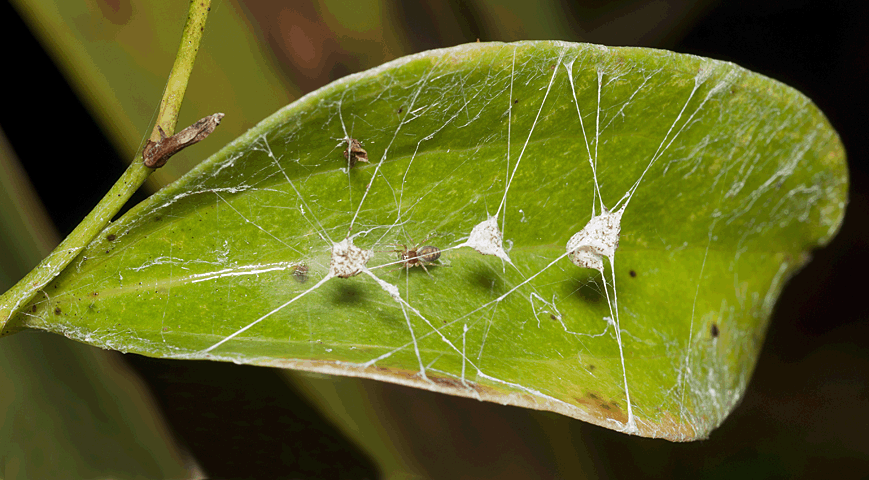
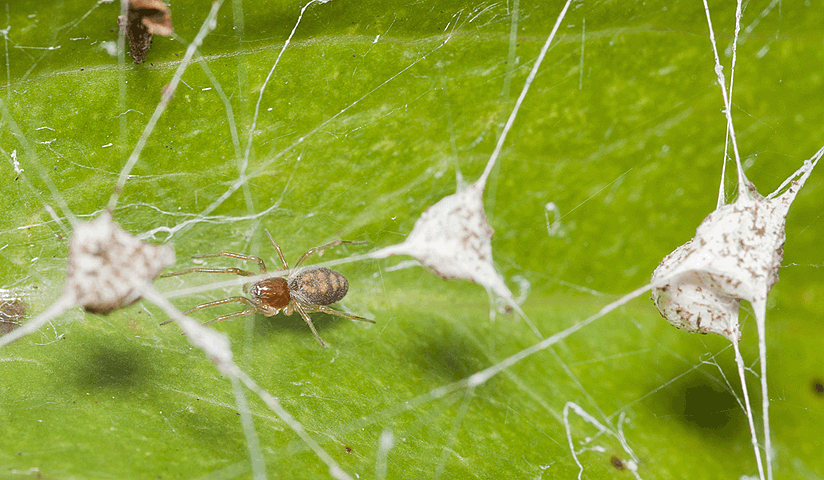
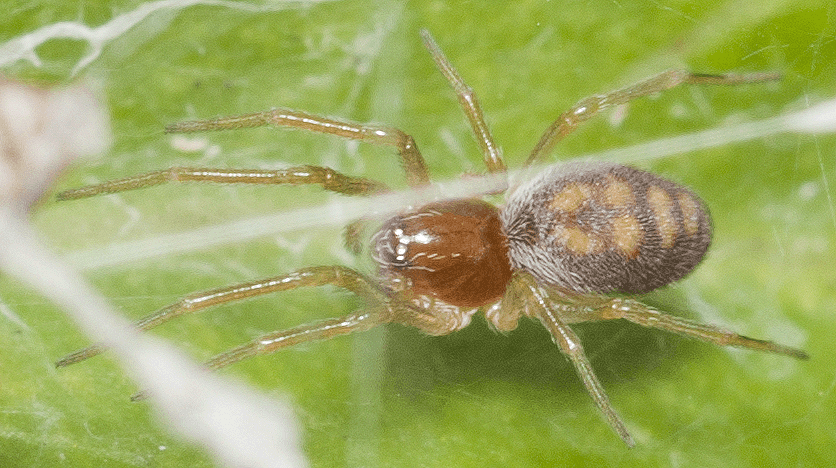 Most Dictynidae spiders build irregular webs close to or directly on the ground. Typically they create a tangle of silken fibers among several branches or stems of a plant. This family has 563 species in 48 genera.
Most Dictynidae spiders build irregular webs close to or directly on the ground. Typically they create a tangle of silken fibers among several branches or stems of a plant. This family has 563 species in 48 genera.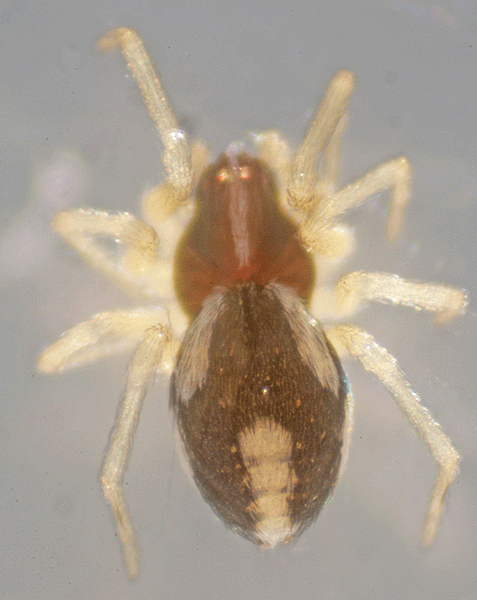
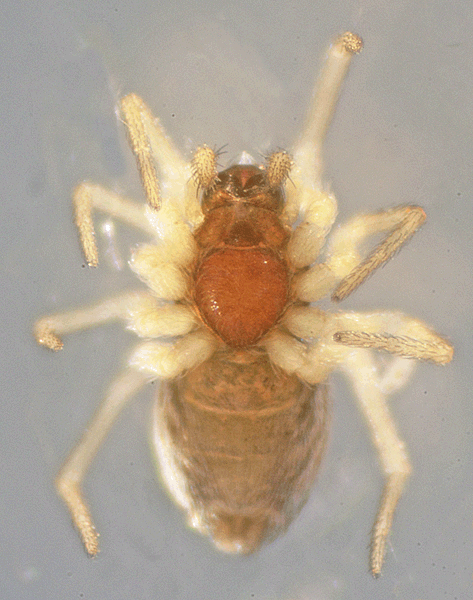
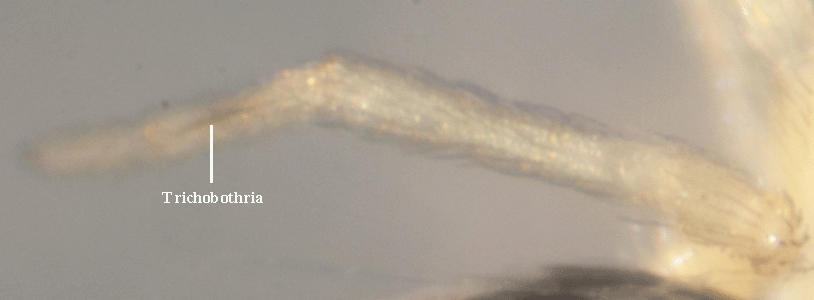
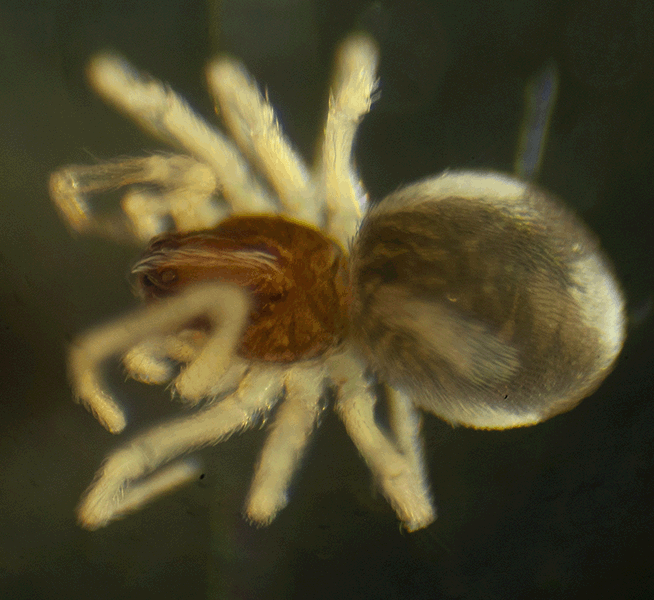
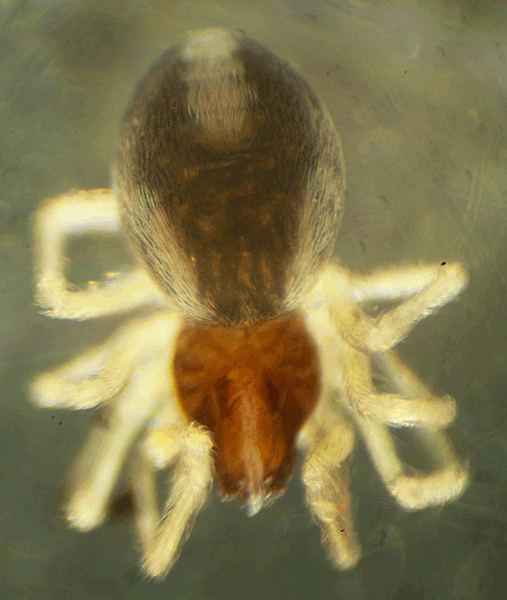
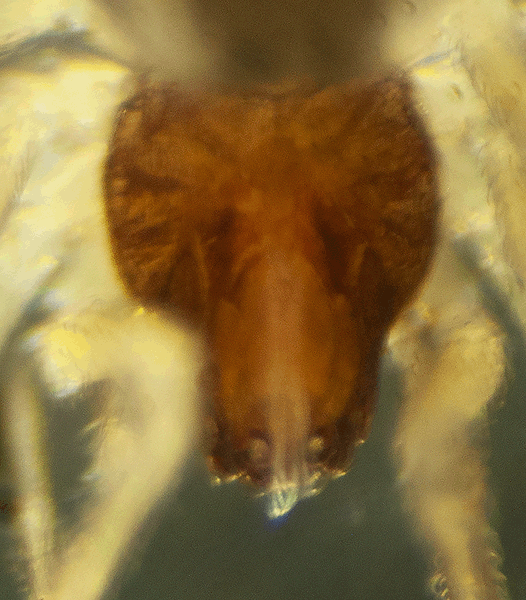
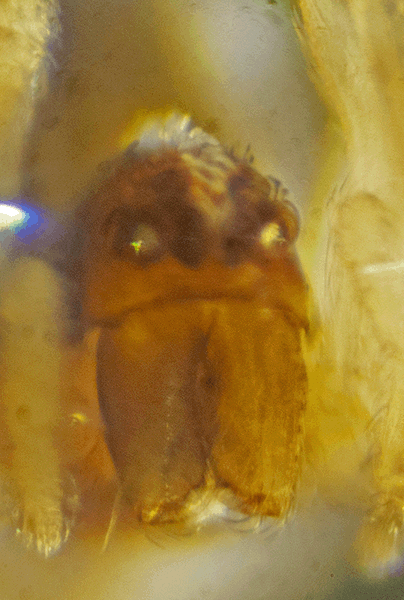
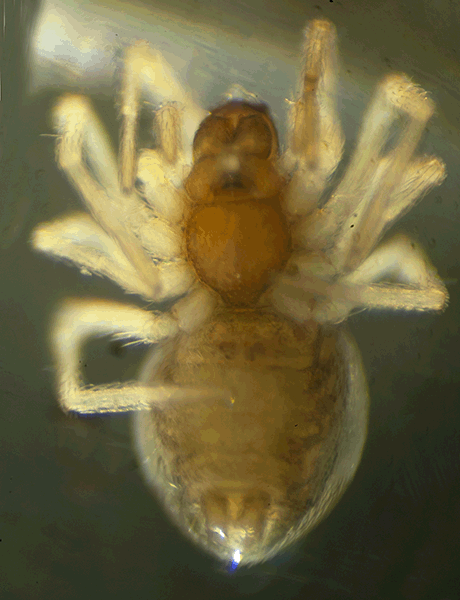

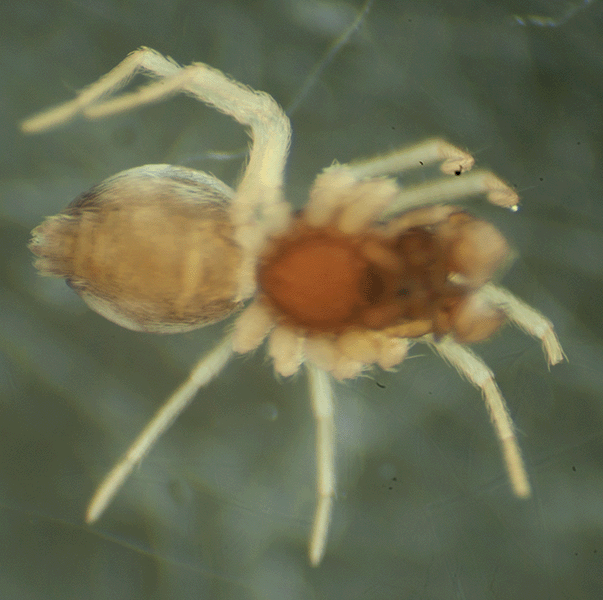
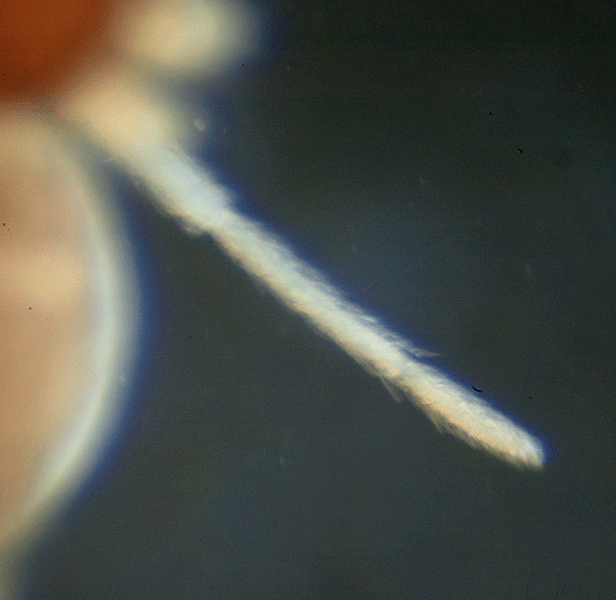
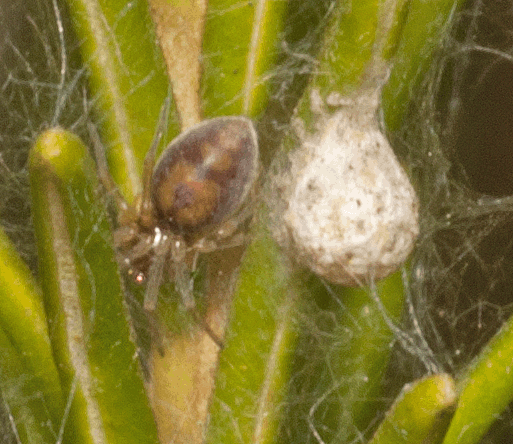
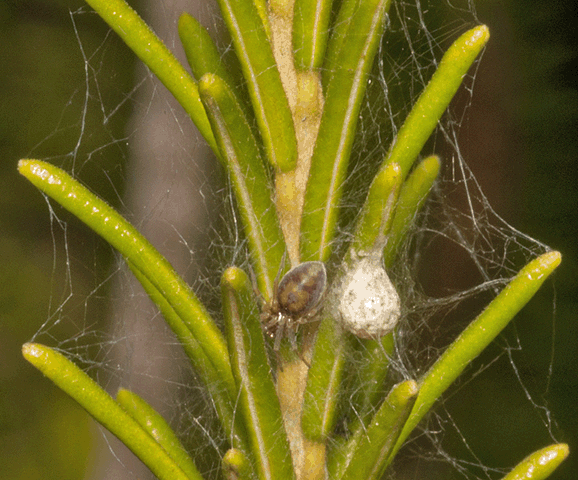
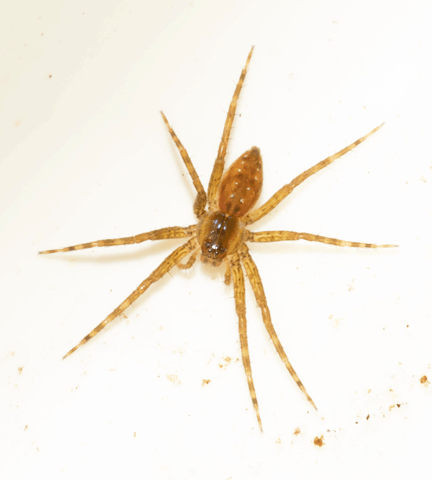
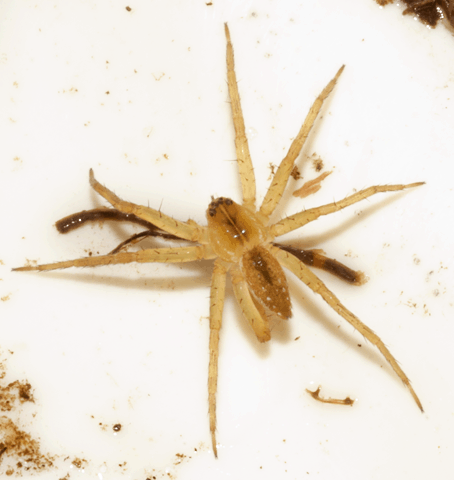
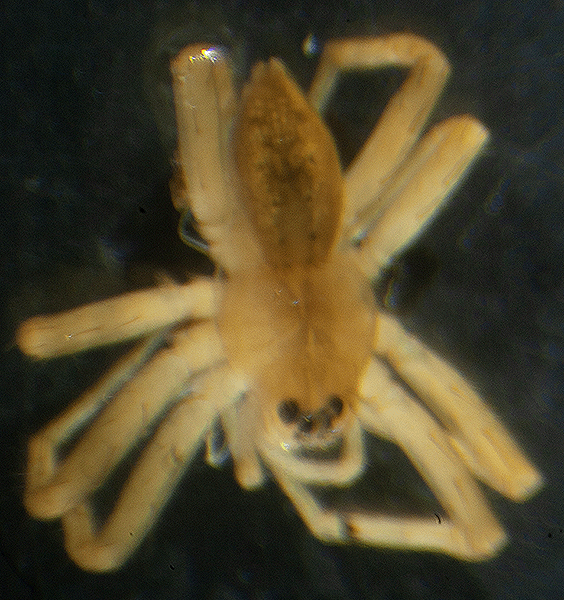
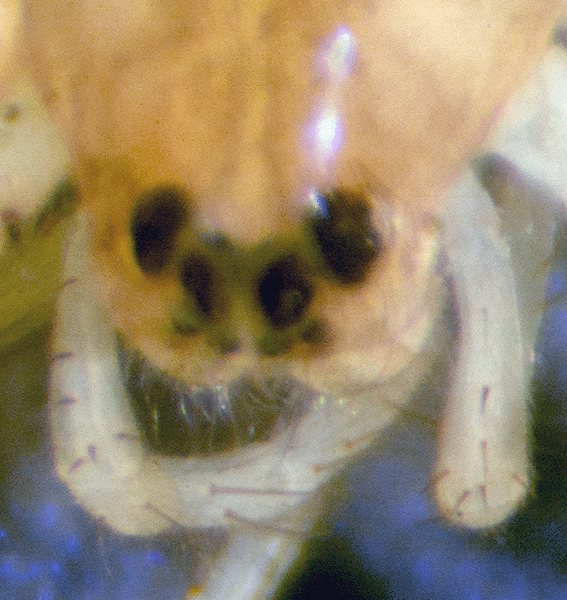
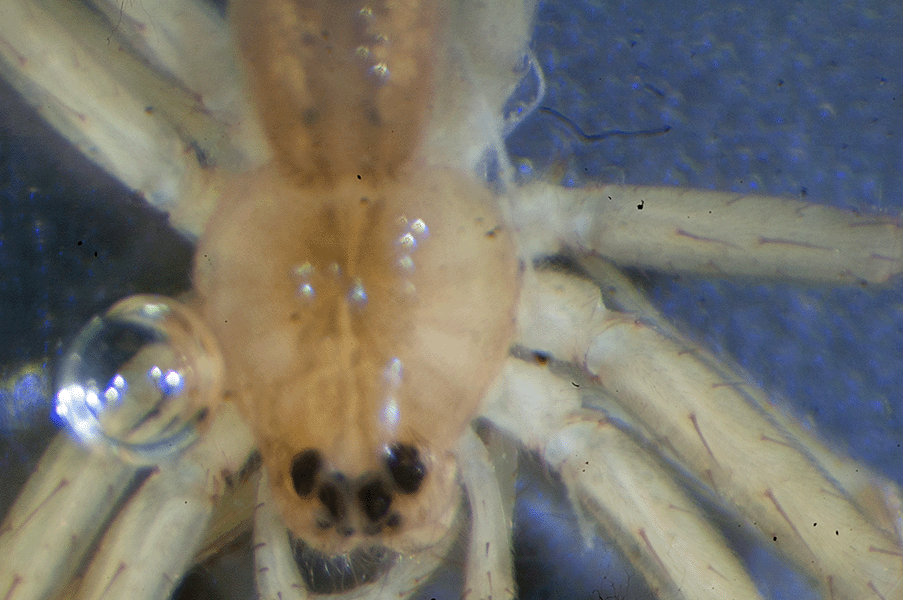
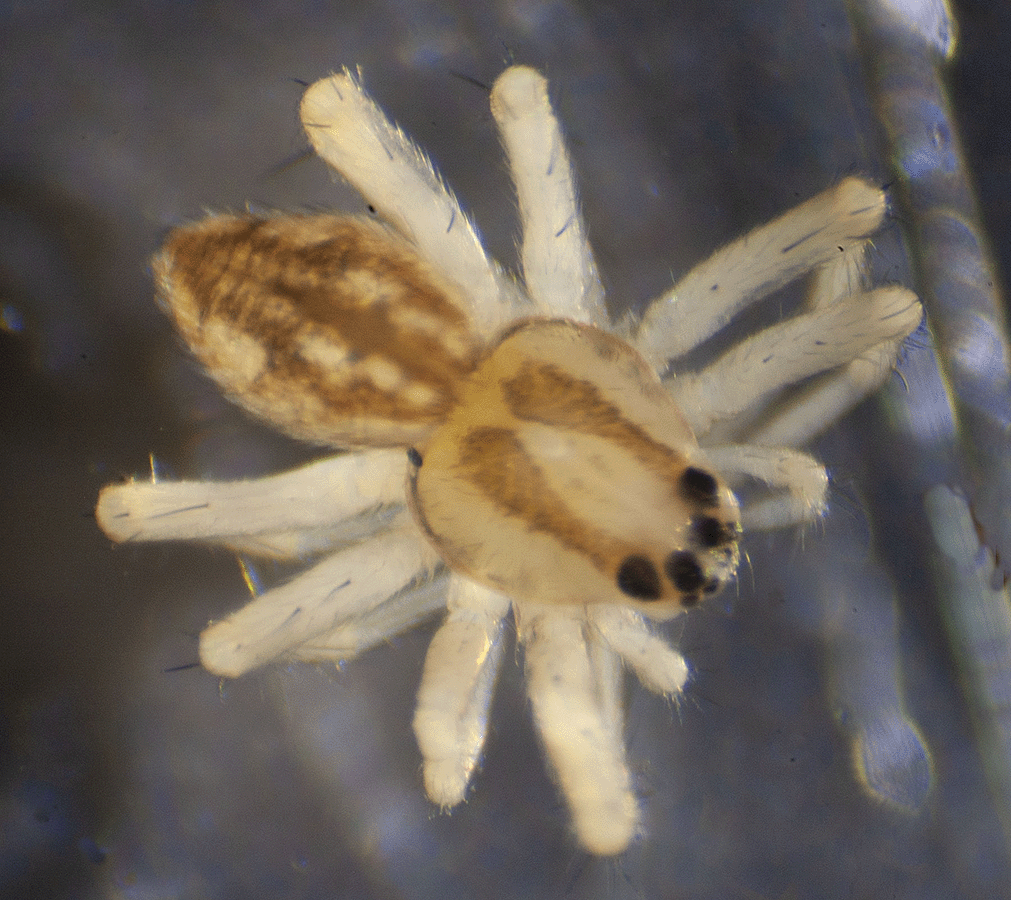
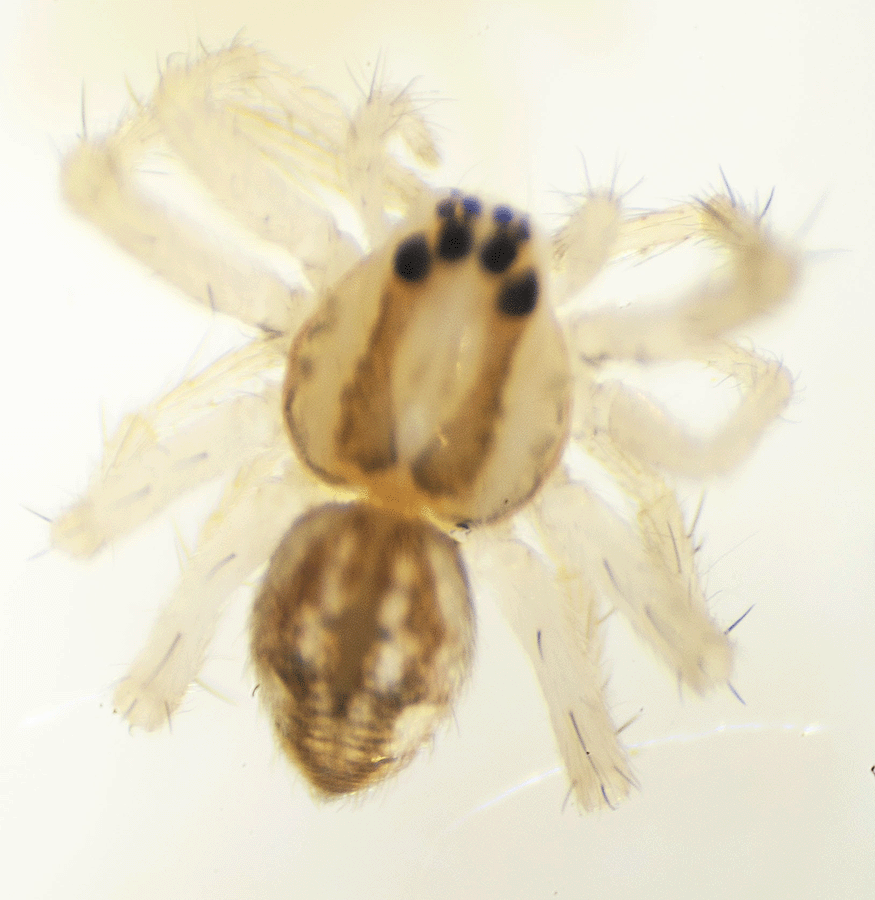
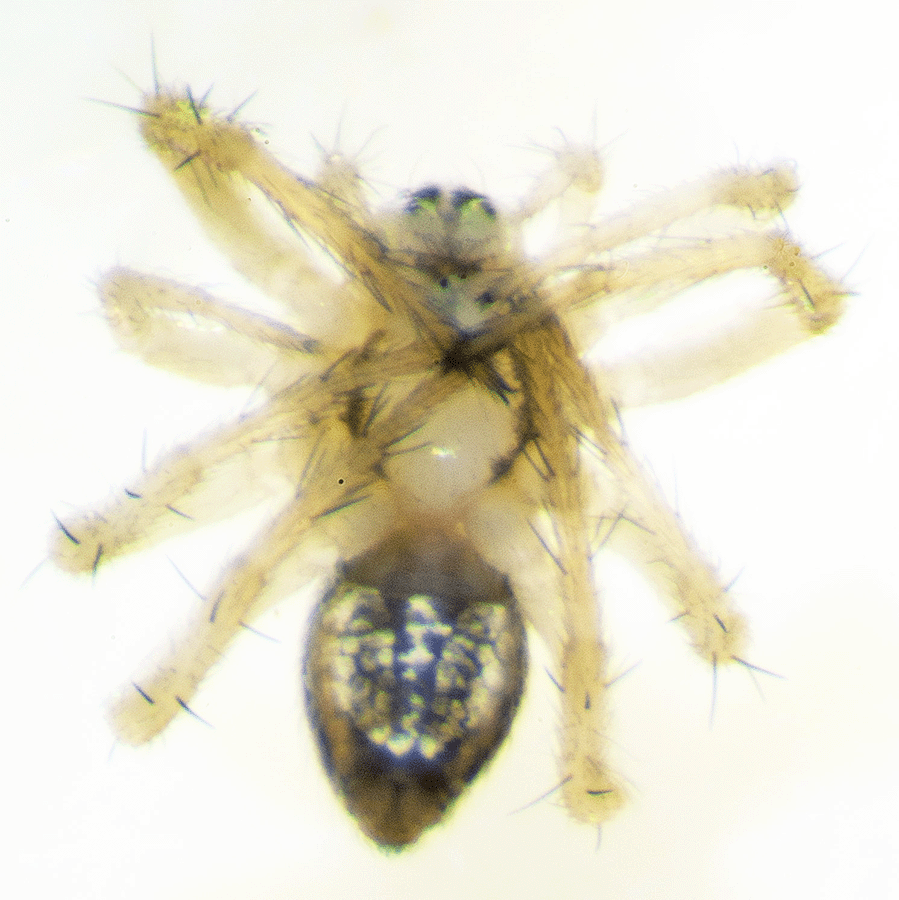
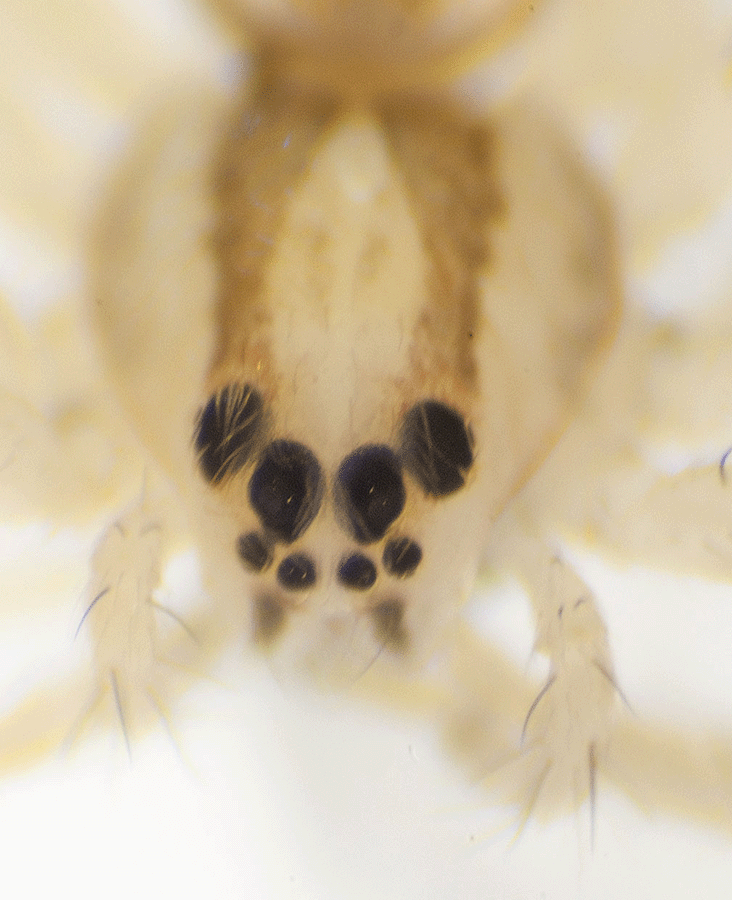
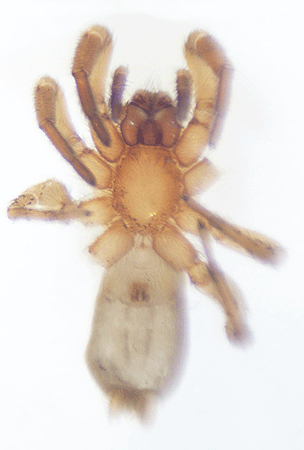
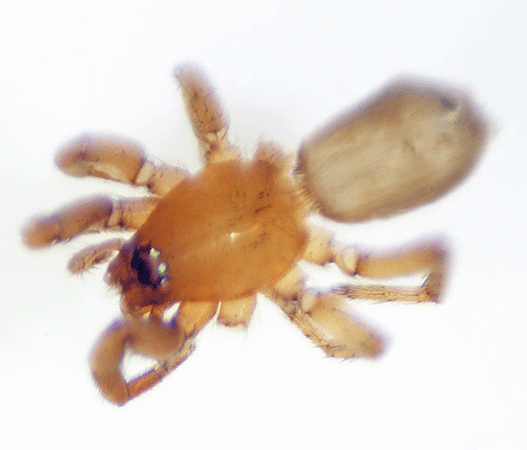
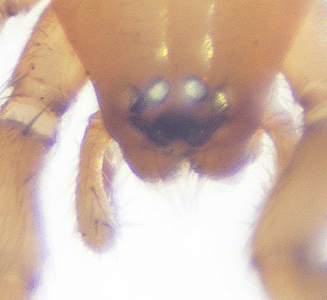
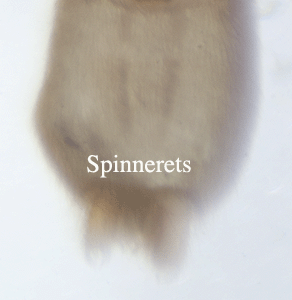
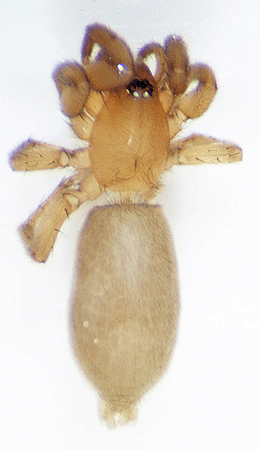
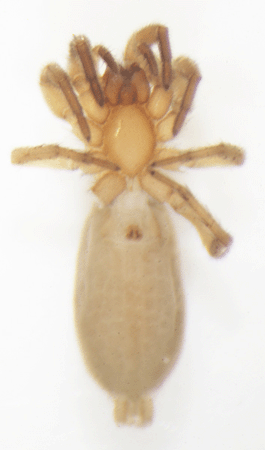
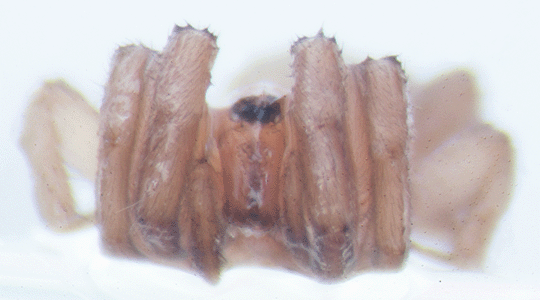
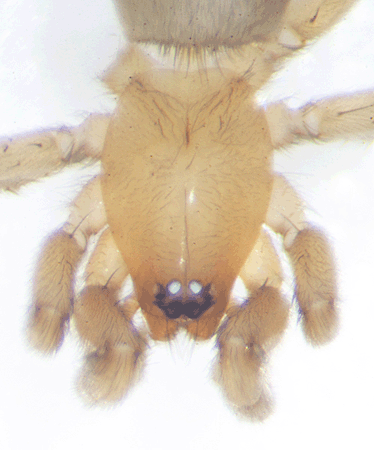
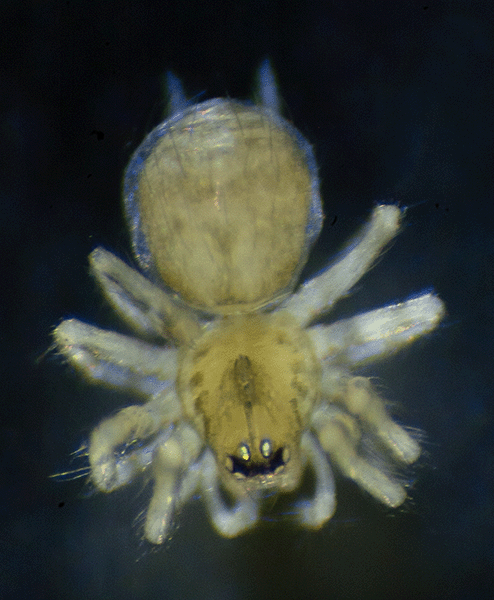
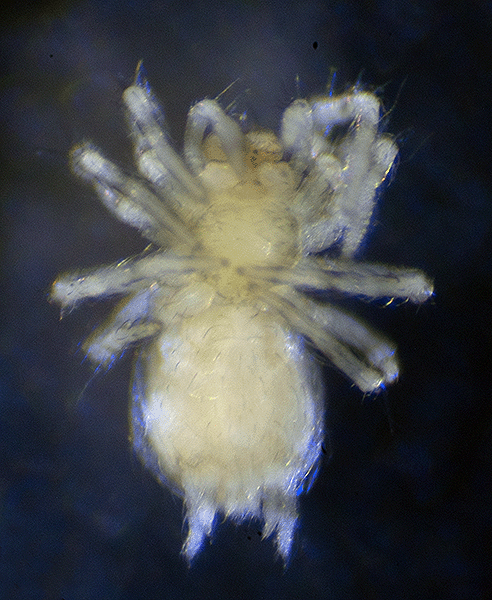
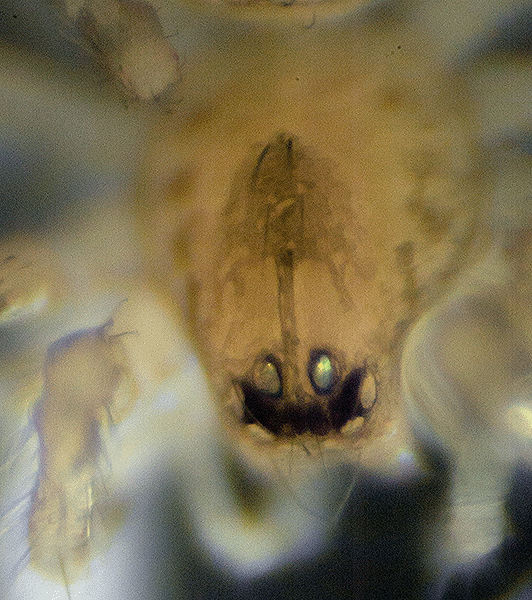
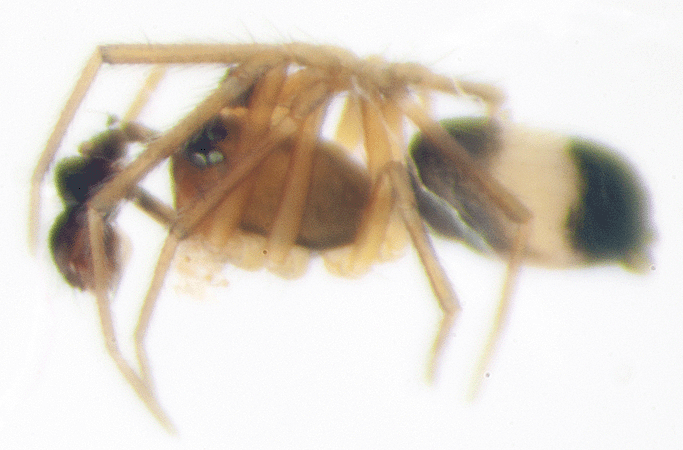 On March 3, 2016, this 2 mm long spider was
On March 3, 2016, this 2 mm long spider was 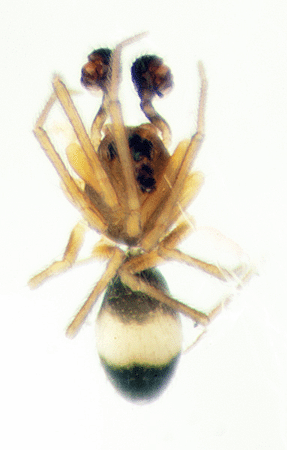 On May 6, 2016, Chad Heins, a Contributing Editor to <BugGuide.net> identified the spider as "Maybe one of the Agyneta."
On May 6, 2016, Chad Heins, a Contributing Editor to <BugGuide.net> identified the spider as "Maybe one of the Agyneta."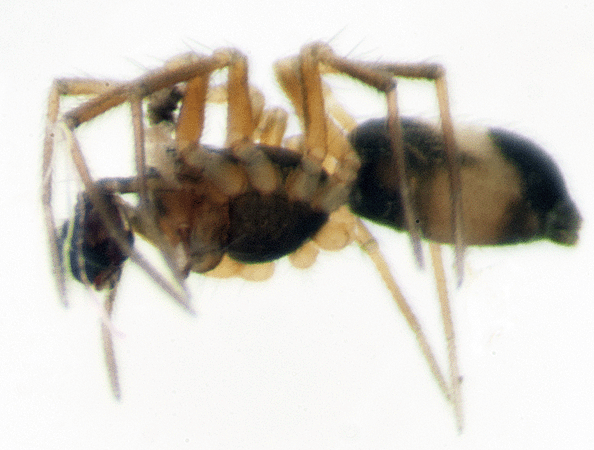
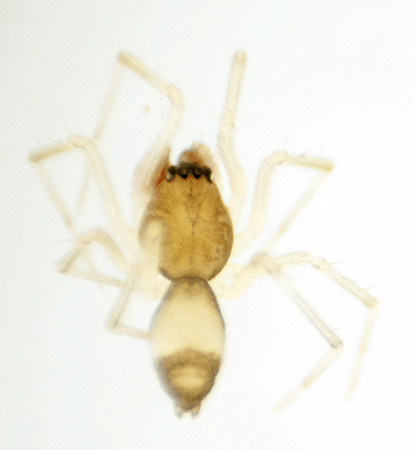
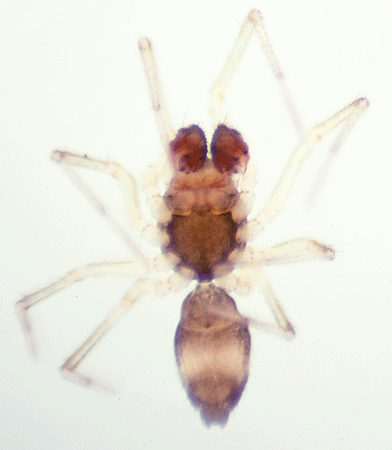
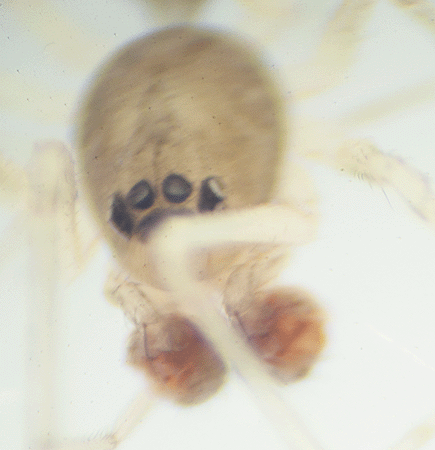 These five photographs were created using photomicroscopy and sent for identification to <BugGuide.net>, sponsored by Iowa State University's Department of Entomology.
These five photographs were created using photomicroscopy and sent for identification to <BugGuide.net>, sponsored by Iowa State University's Department of Entomology. 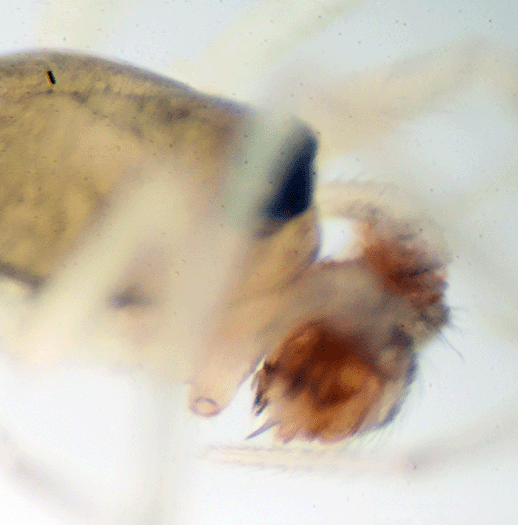
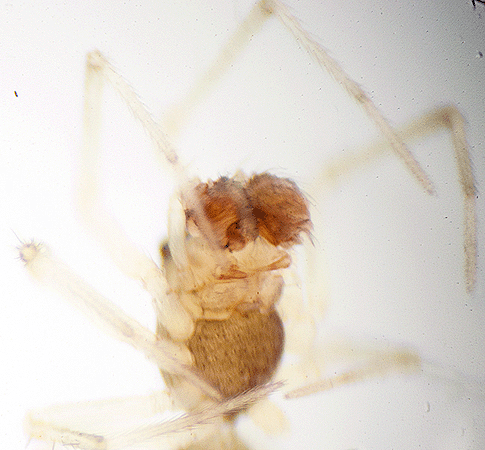
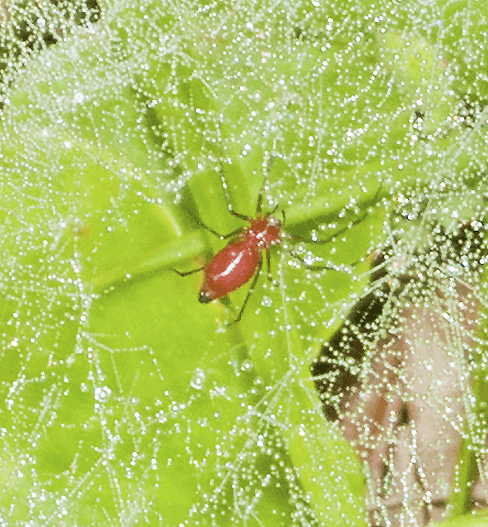
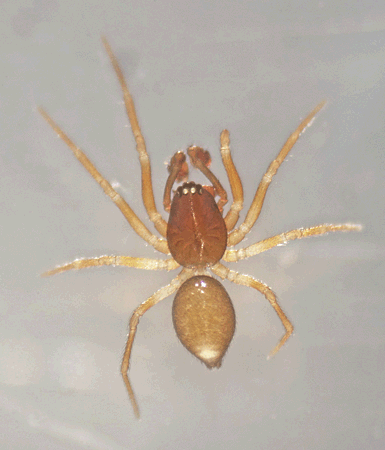
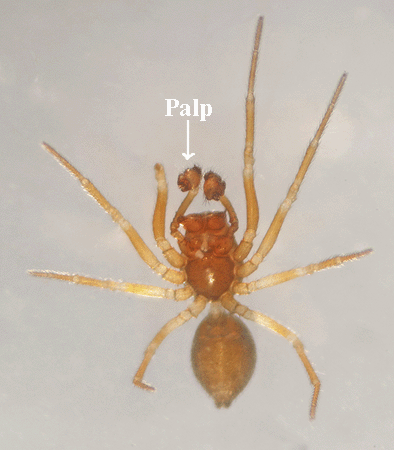
 On December 14, 2015, Pierre-Marc Brousseau, Contributor to <BugGuide.net> identified the family. The large palps on this individual indicate that it is a male.
On December 14, 2015, Pierre-Marc Brousseau, Contributor to <BugGuide.net> identified the family. The large palps on this individual indicate that it is a male. 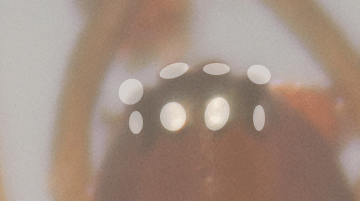
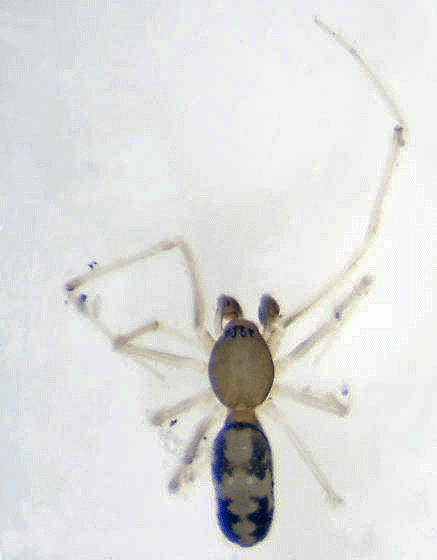
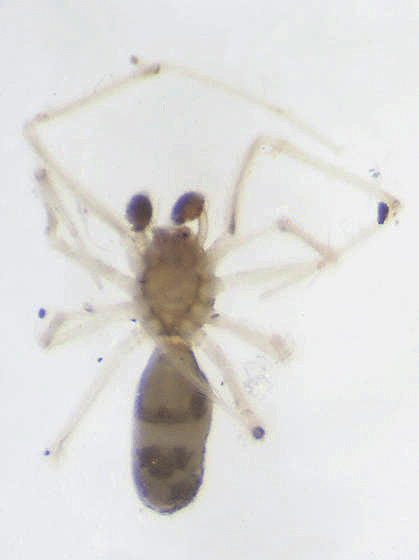
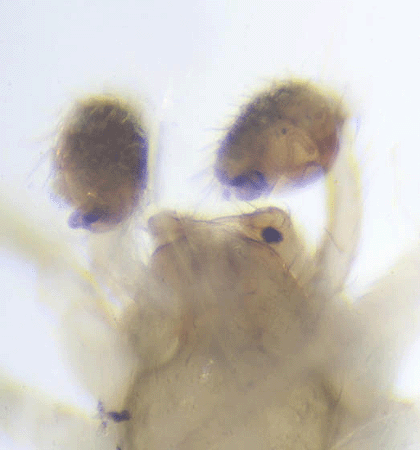
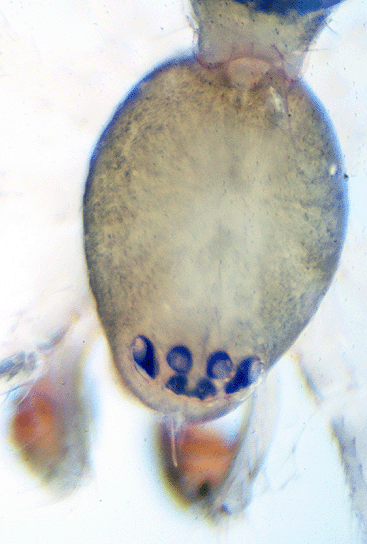
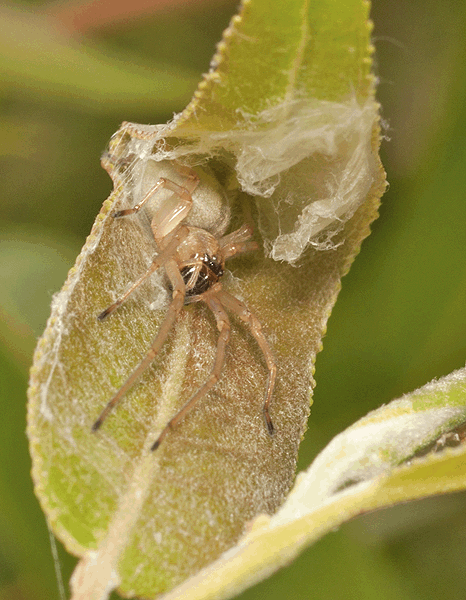 Cheiracanthium inclusum is a fairly small, pale yellow species, indigenous to the Americas. Females are 5 to 9 mm; males are 4 to 8 mm. Males have a skinnier body and a larger leg span than females.
Cheiracanthium inclusum is a fairly small, pale yellow species, indigenous to the Americas. Females are 5 to 9 mm; males are 4 to 8 mm. Males have a skinnier body and a larger leg span than females. 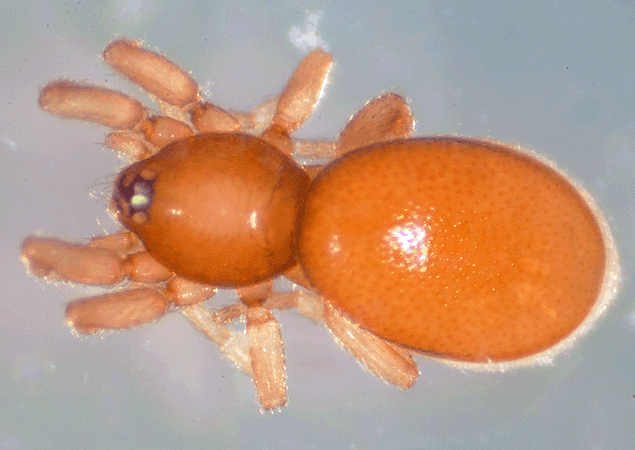 On January 1, 2015, its identity to Family Oonipidae was made from this photograph by Laura P., Contributing Editor to <BugGuide.net>, sponsored by Iowa State University Department of Entomology. She stated it is a nice find and may be genus Opopaea. Laura will try to get an expert opinion. If it is this genus, she will add the genus name and this photograph to the <BugGuide.net> guide, as this will be a new genus for the guide. [Note: That was done on January 17, 2018 after the species was identified.]
On January 1, 2015, its identity to Family Oonipidae was made from this photograph by Laura P., Contributing Editor to <BugGuide.net>, sponsored by Iowa State University Department of Entomology. She stated it is a nice find and may be genus Opopaea. Laura will try to get an expert opinion. If it is this genus, she will add the genus name and this photograph to the <BugGuide.net> guide, as this will be a new genus for the guide. [Note: That was done on January 17, 2018 after the species was identified.]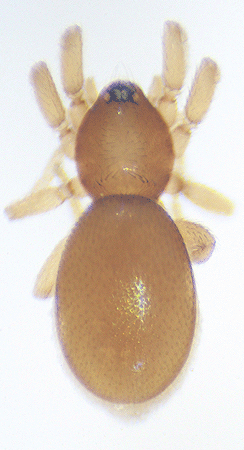
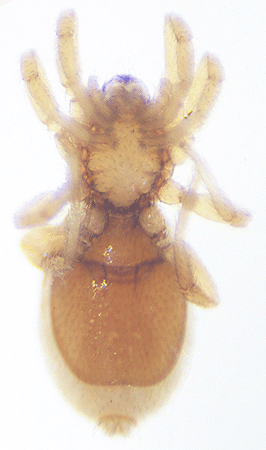
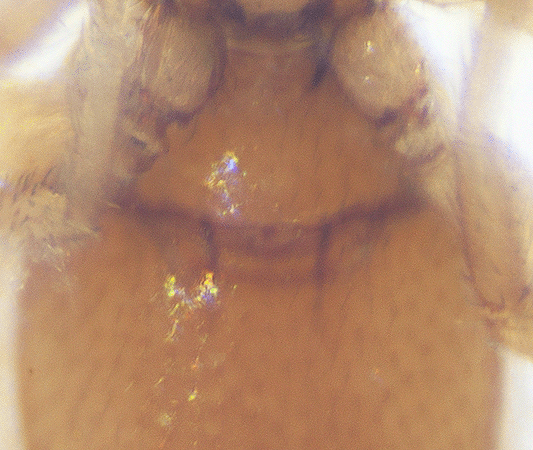
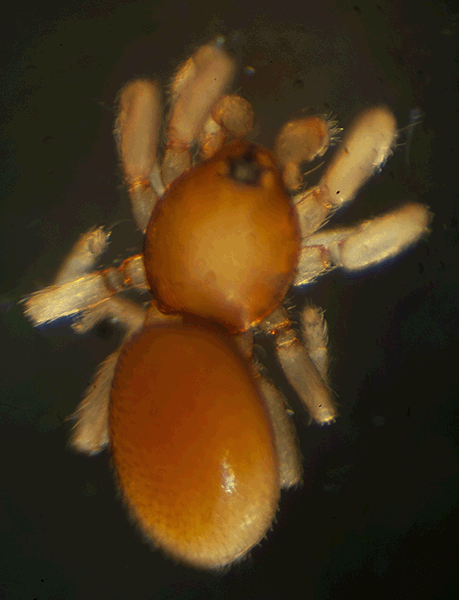
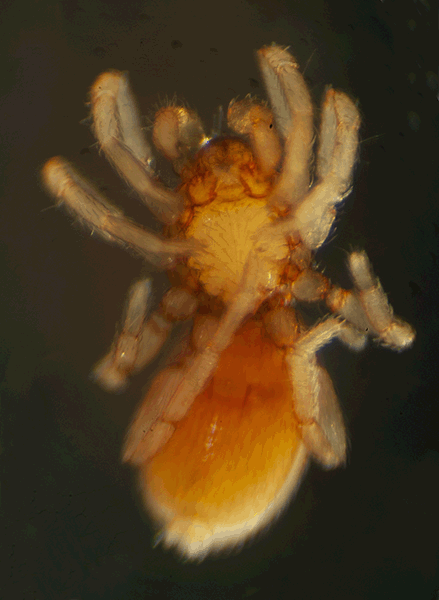
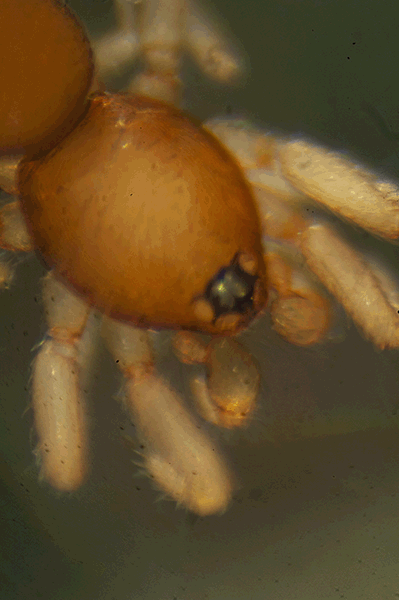
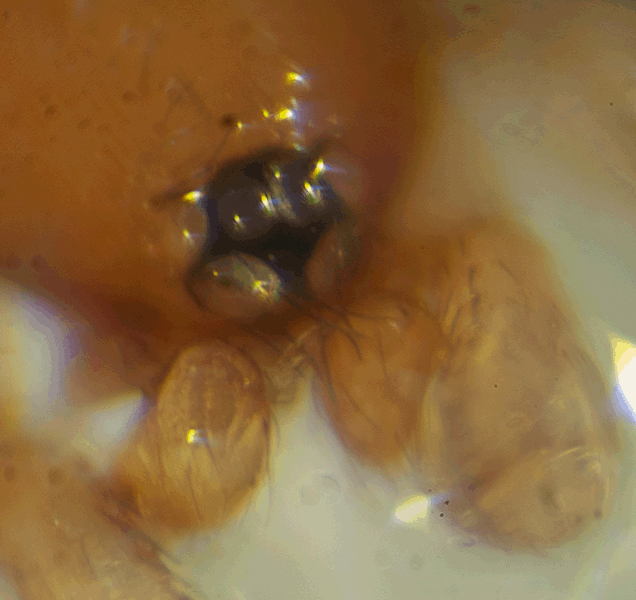
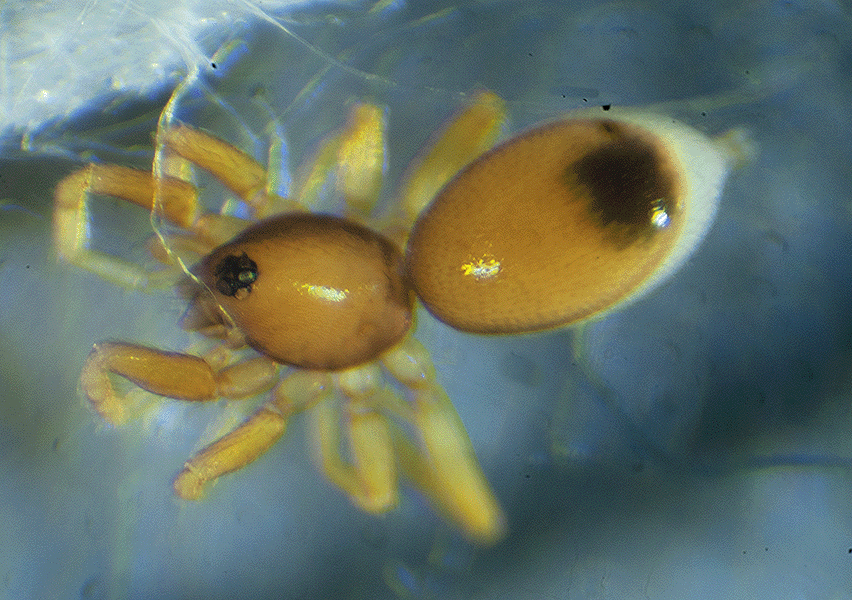
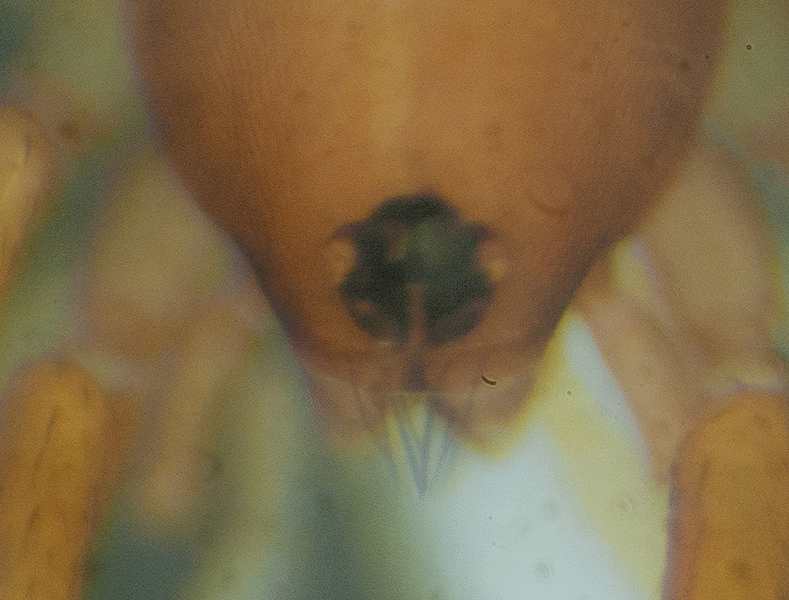 These images were created using photomicroscopy and sent for identification confirmation that the Family is Oonopidae
These images were created using photomicroscopy and sent for identification confirmation that the Family is Oonopidae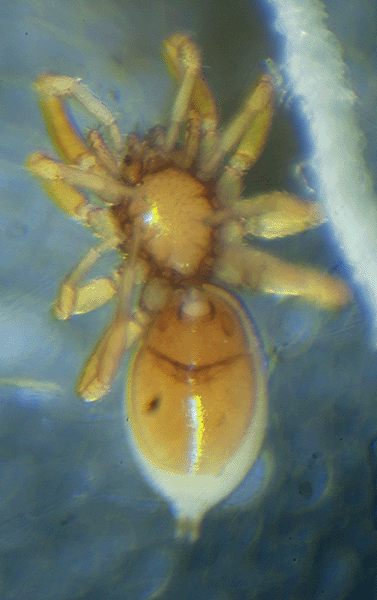
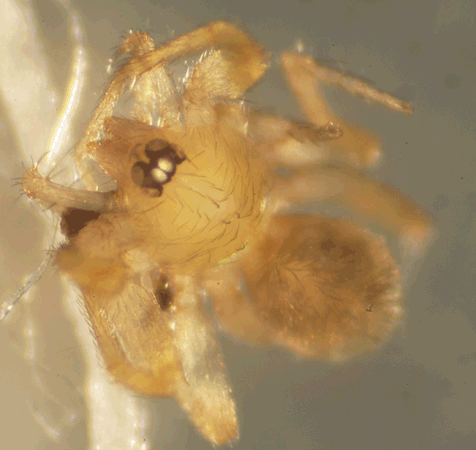 On January 5, 2015, this 1.5 mm long spider was living in pine needle litter under a
On January 5, 2015, this 1.5 mm long spider was living in pine needle litter under a 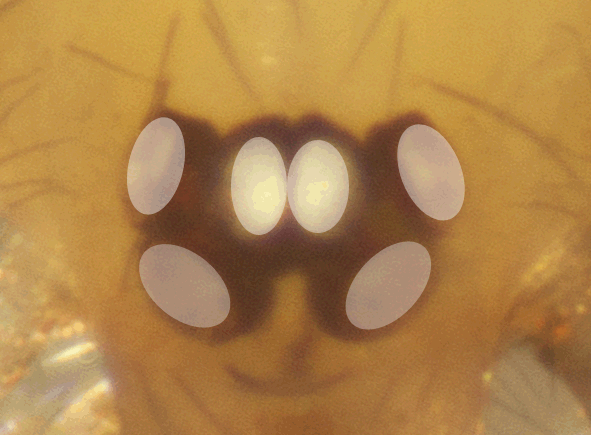
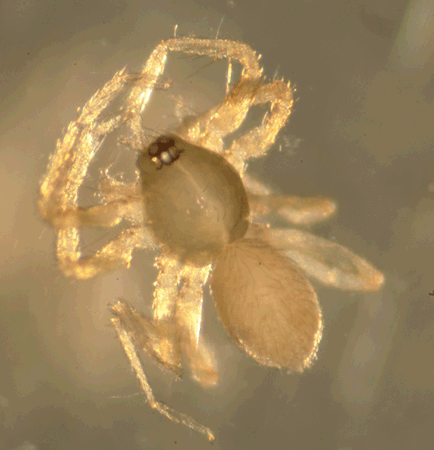 On December 19, 2014, this 1.25 mm, 6-eyed spider was living in leaf litter under a citrus tree in part of the abandoned citrus grove that has evolved into a cabbage palm / oak hammock in the northeast corner of the Smith Preserve. Using a Berlese funnel, it was extracted from the needles. These photographs were produced using photomicroscopy.
On December 19, 2014, this 1.25 mm, 6-eyed spider was living in leaf litter under a citrus tree in part of the abandoned citrus grove that has evolved into a cabbage palm / oak hammock in the northeast corner of the Smith Preserve. Using a Berlese funnel, it was extracted from the needles. These photographs were produced using photomicroscopy.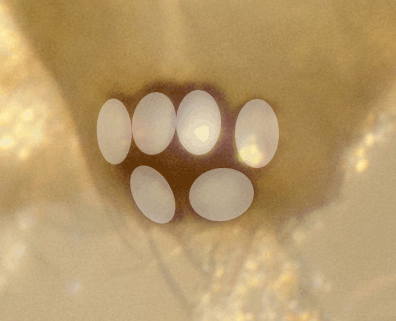
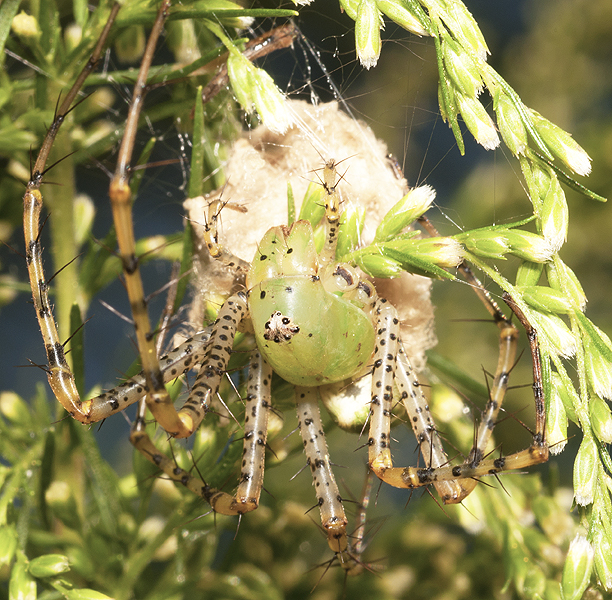
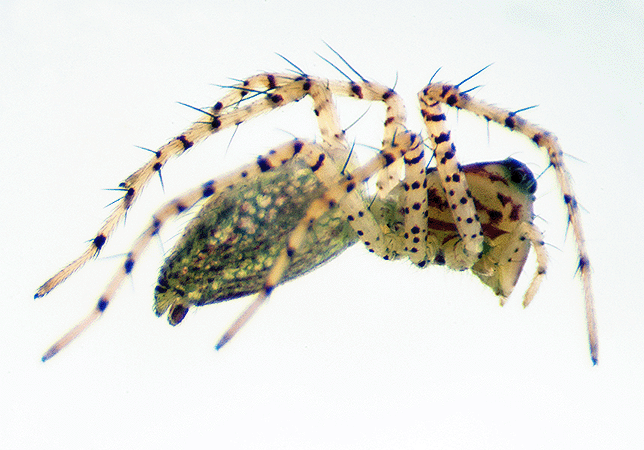
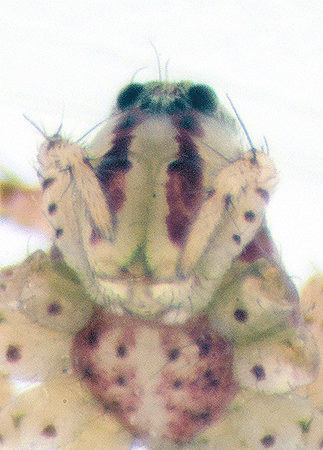
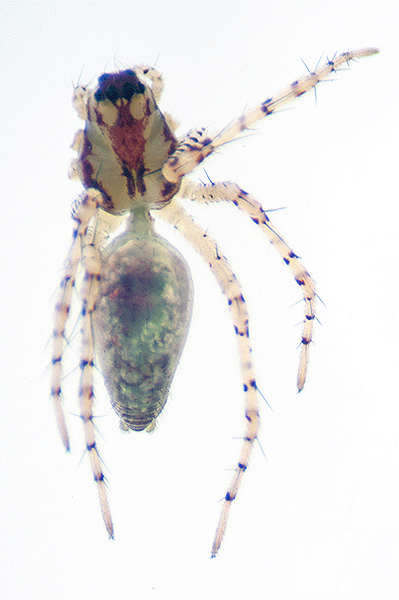
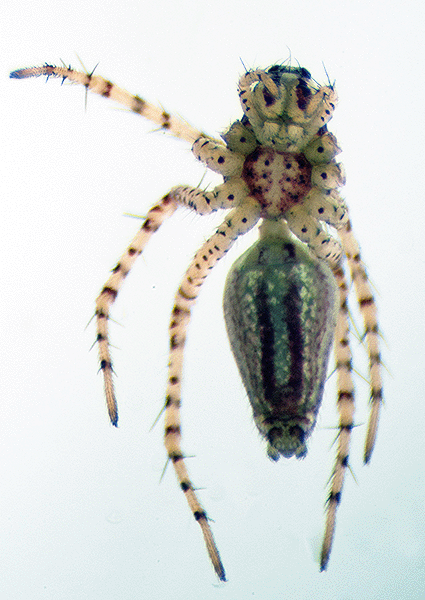
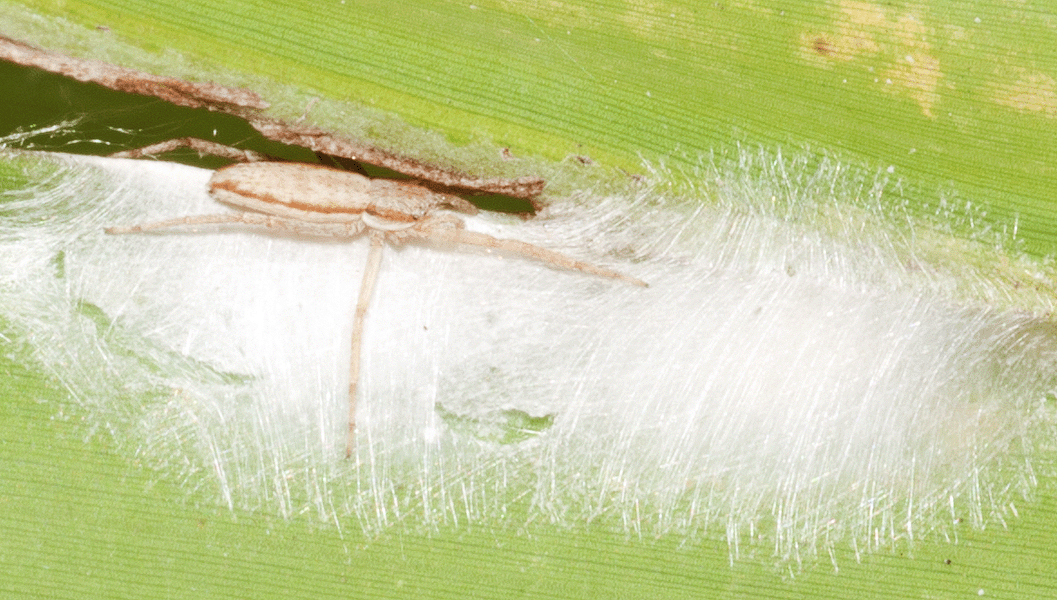
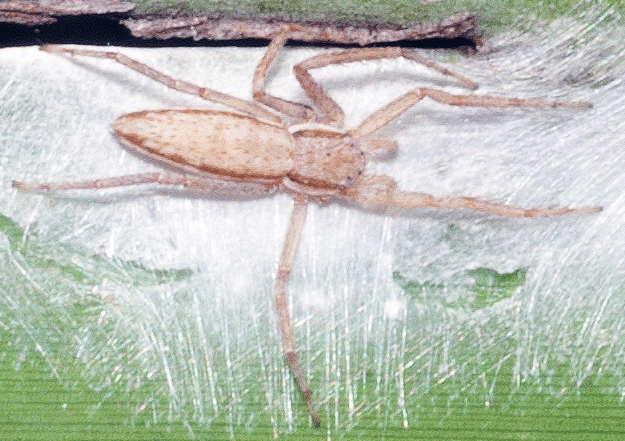 On November 23, 2022, John and Jane Balaban, two Contributors to <Bugguide.net> shared that they "wondered if it might be a Philodromus such as rufus but couldn't quite make the match." On November 24, 2022, "chuuuuung", a Contributing Editor confirmed the family as Philodromidae.
On November 23, 2022, John and Jane Balaban, two Contributors to <Bugguide.net> shared that they "wondered if it might be a Philodromus such as rufus but couldn't quite make the match." On November 24, 2022, "chuuuuung", a Contributing Editor confirmed the family as Philodromidae. 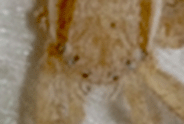
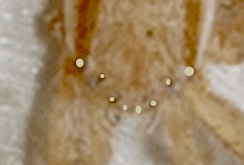
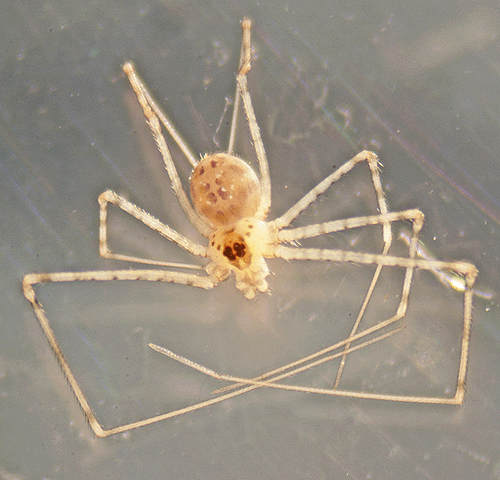
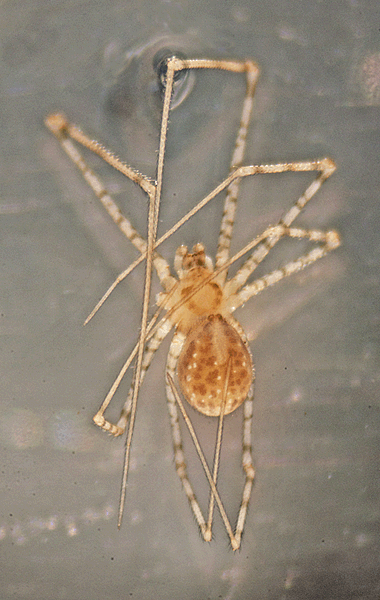
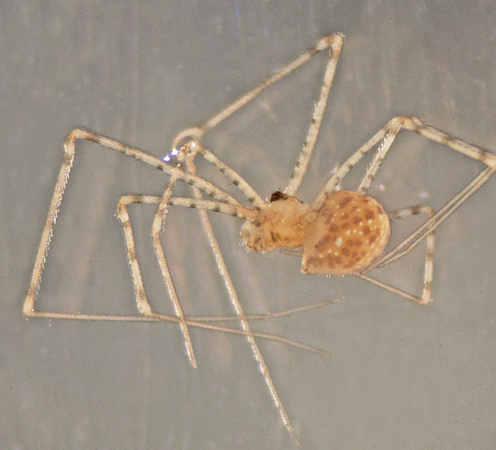
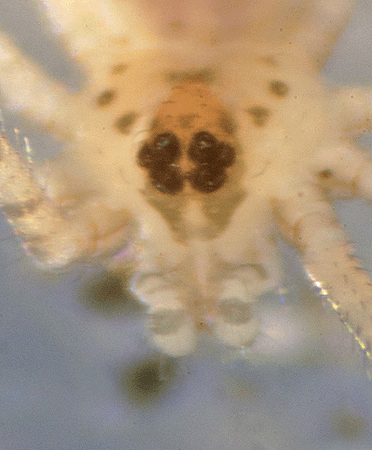
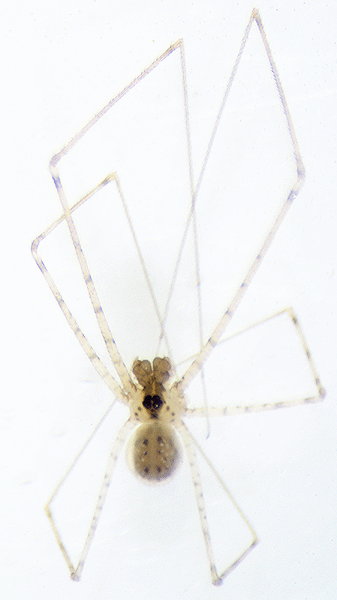
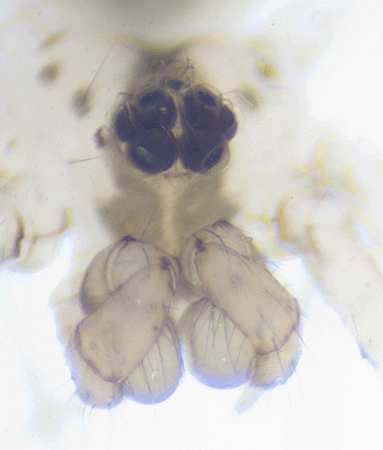
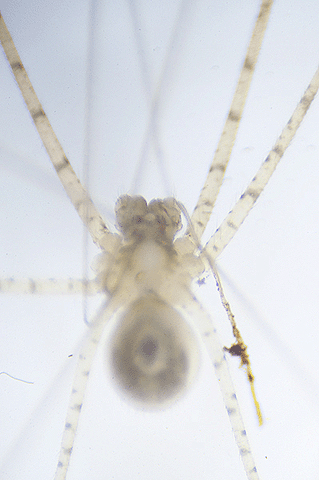
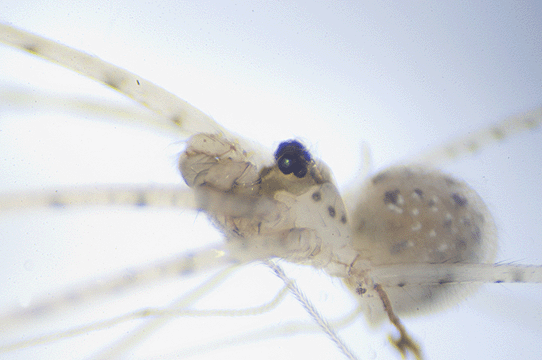

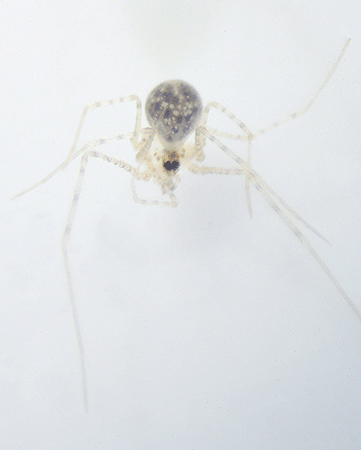
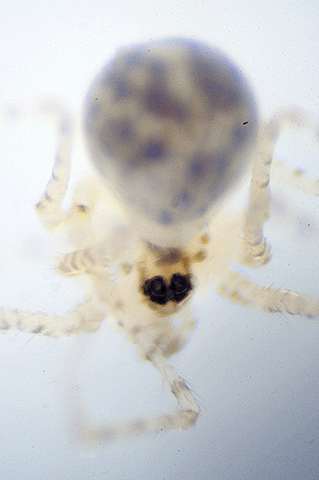
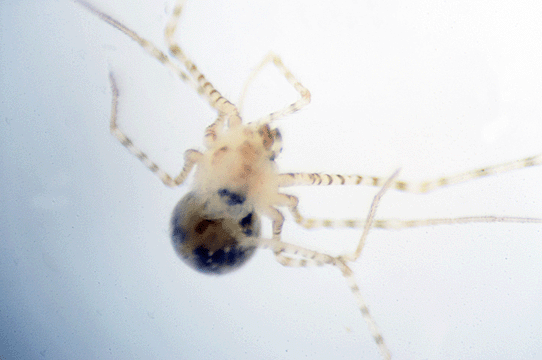

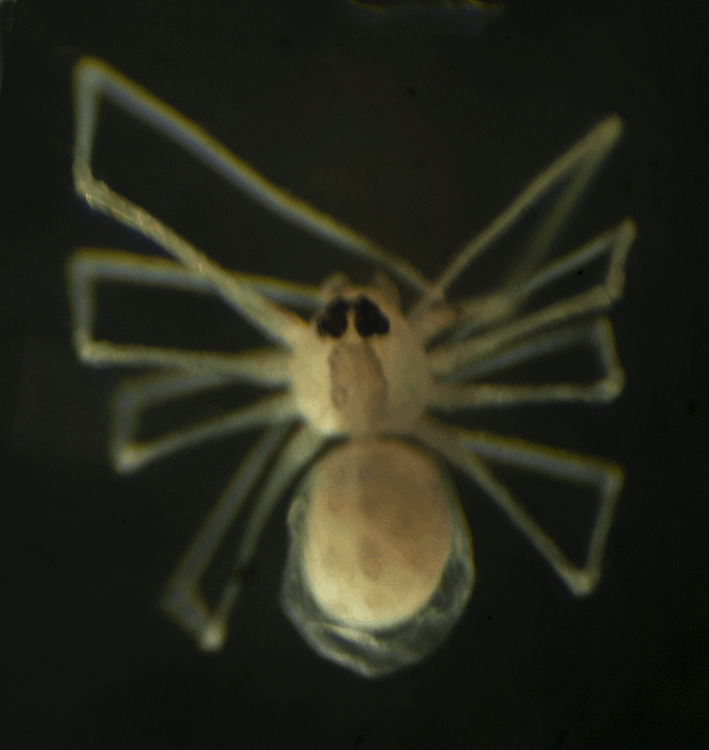
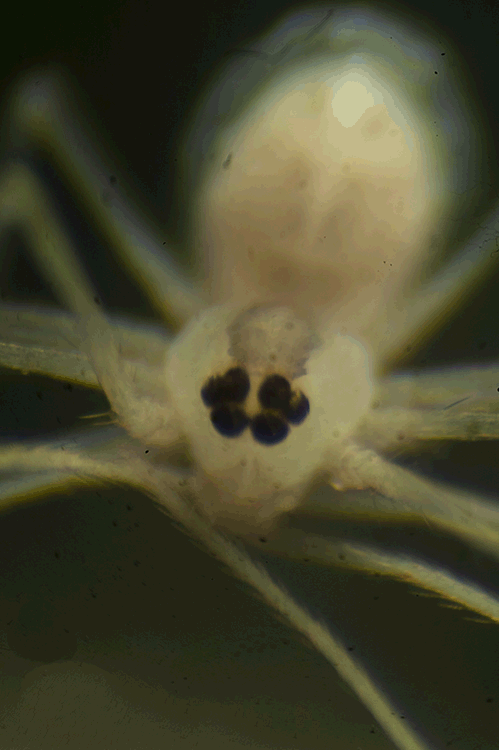
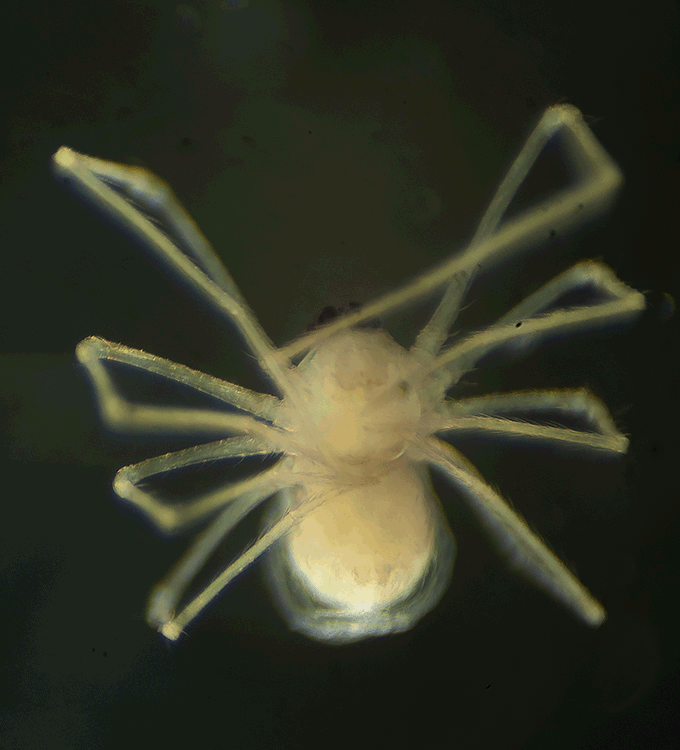
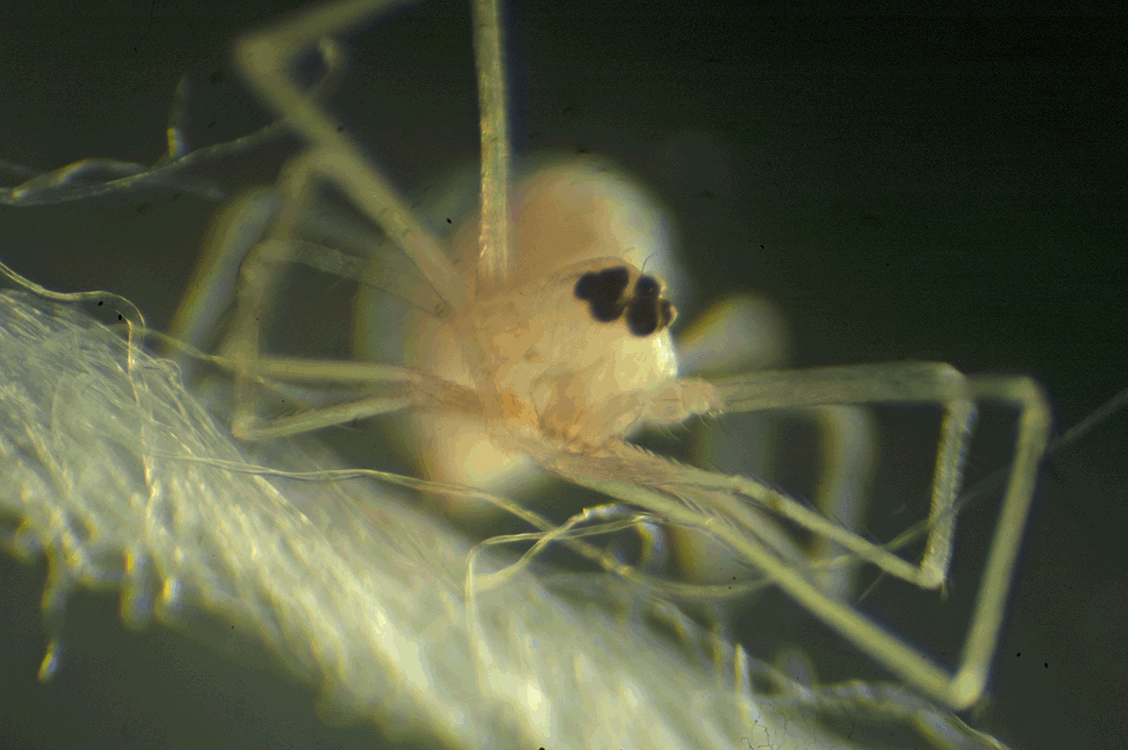
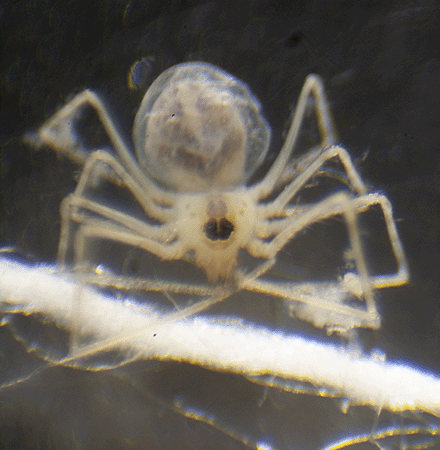
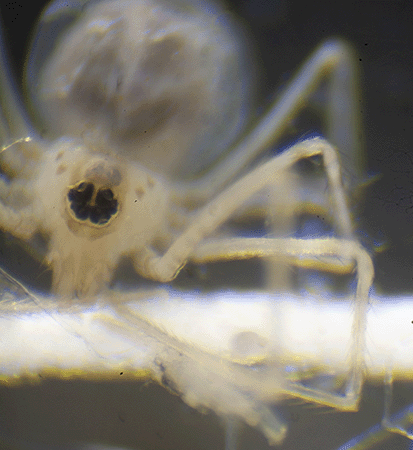
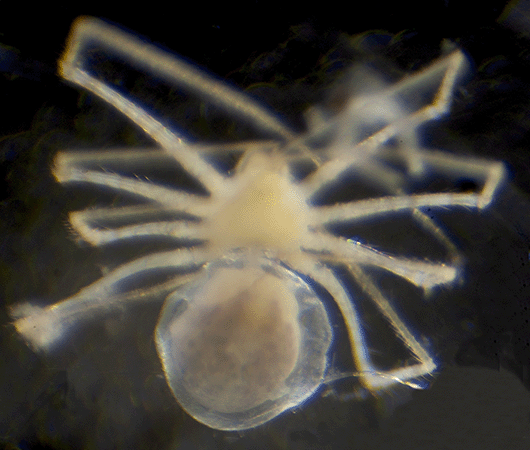
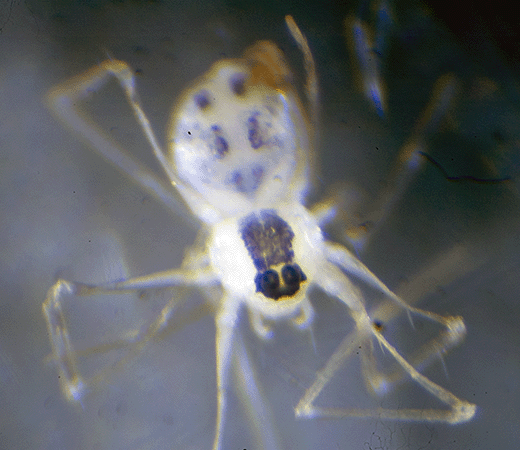
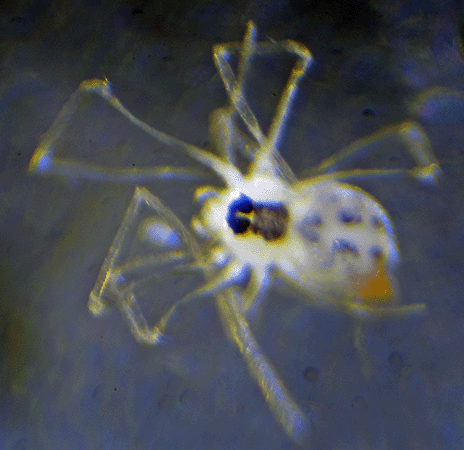
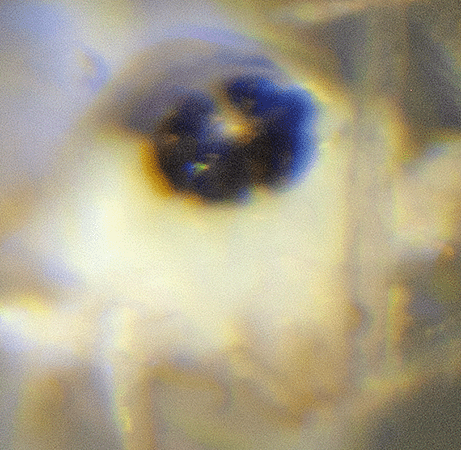

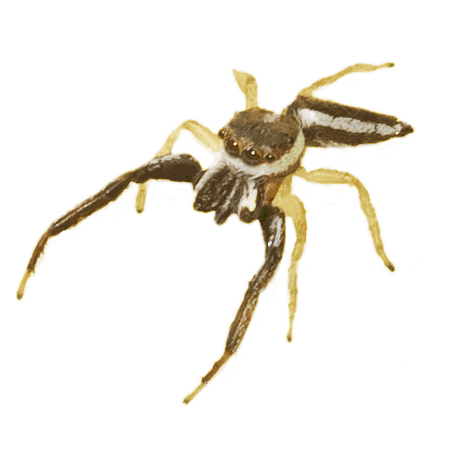
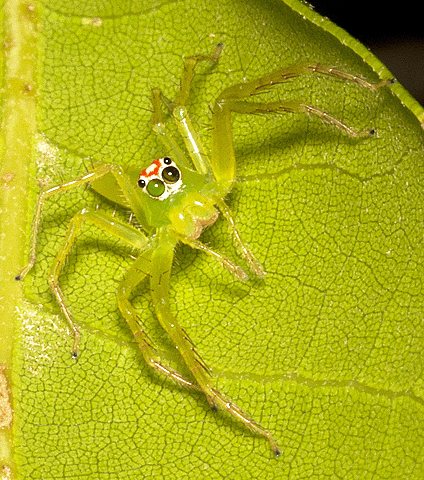 No less than 80 species of Lyssomanes live in South and Central America and in the southern United States.
No less than 80 species of Lyssomanes live in South and Central America and in the southern United States.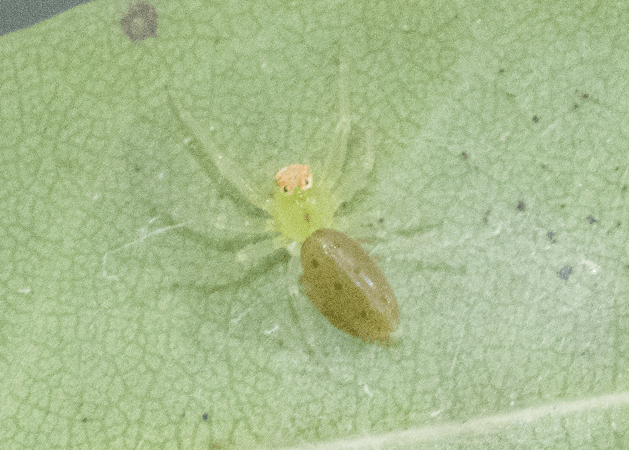
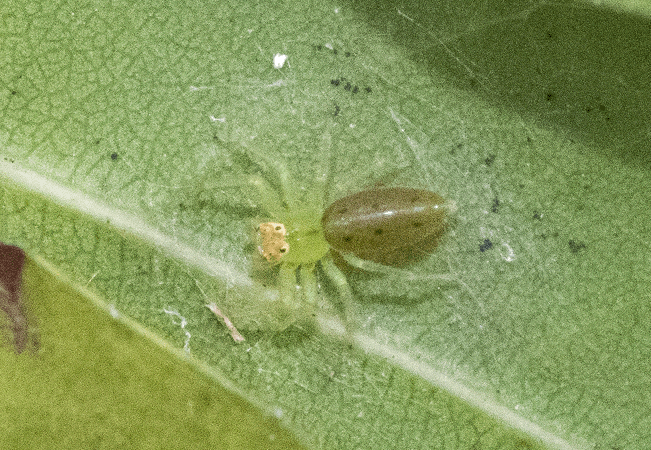
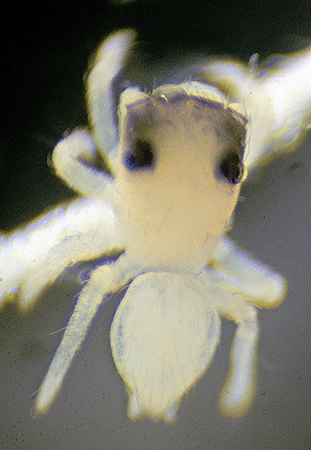
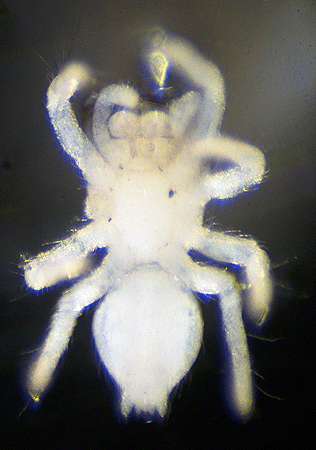
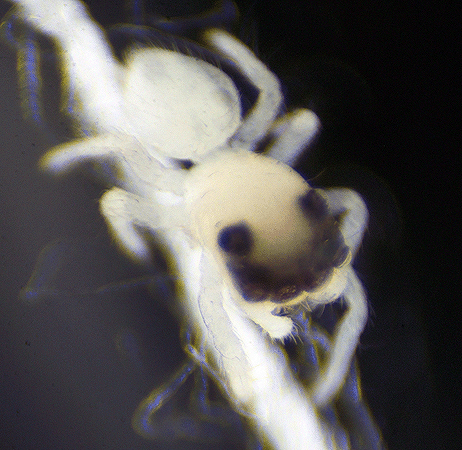 On March 4, 2015, this ~.1 mm long 6-eyed spider was living in leaf litter collected under a
On March 4, 2015, this ~.1 mm long 6-eyed spider was living in leaf litter collected under a 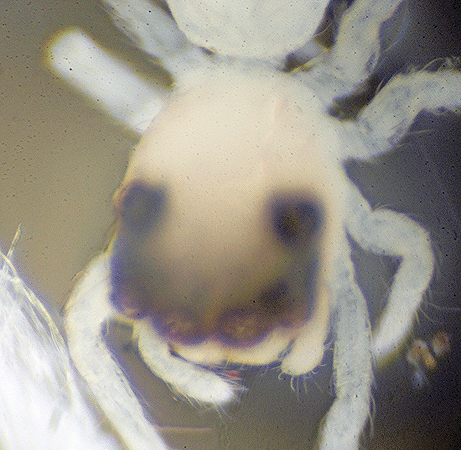 Laura P. stated: "Salticidae: I don't think you can get this past family. There would be 8 eyes there though, they're just tiny." Chad Heins stated, "Yes...Baby salticid. These are so young that there really aren't any defining features for narrowing them even to genus."
Laura P. stated: "Salticidae: I don't think you can get this past family. There would be 8 eyes there though, they're just tiny." Chad Heins stated, "Yes...Baby salticid. These are so young that there really aren't any defining features for narrowing them even to genus."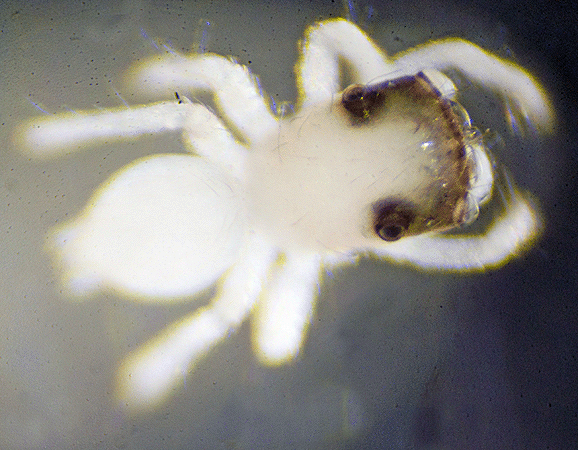
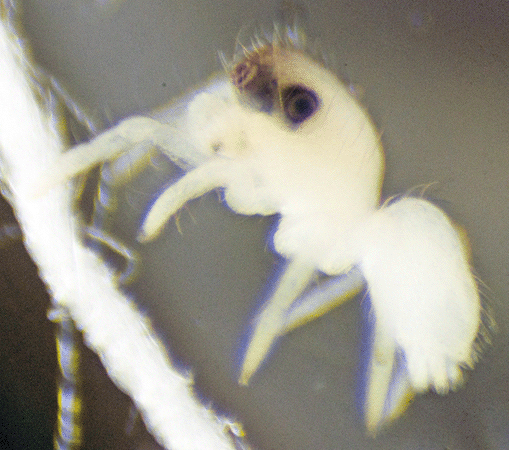
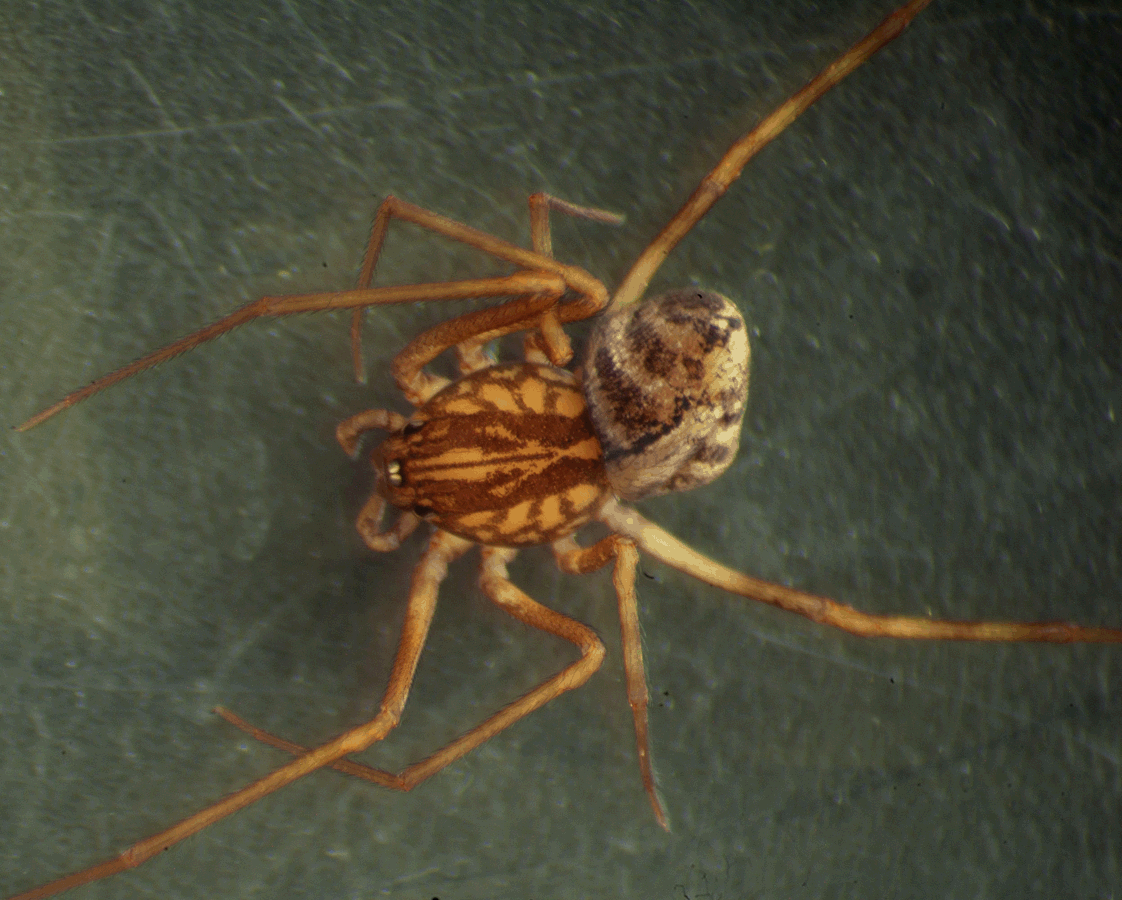
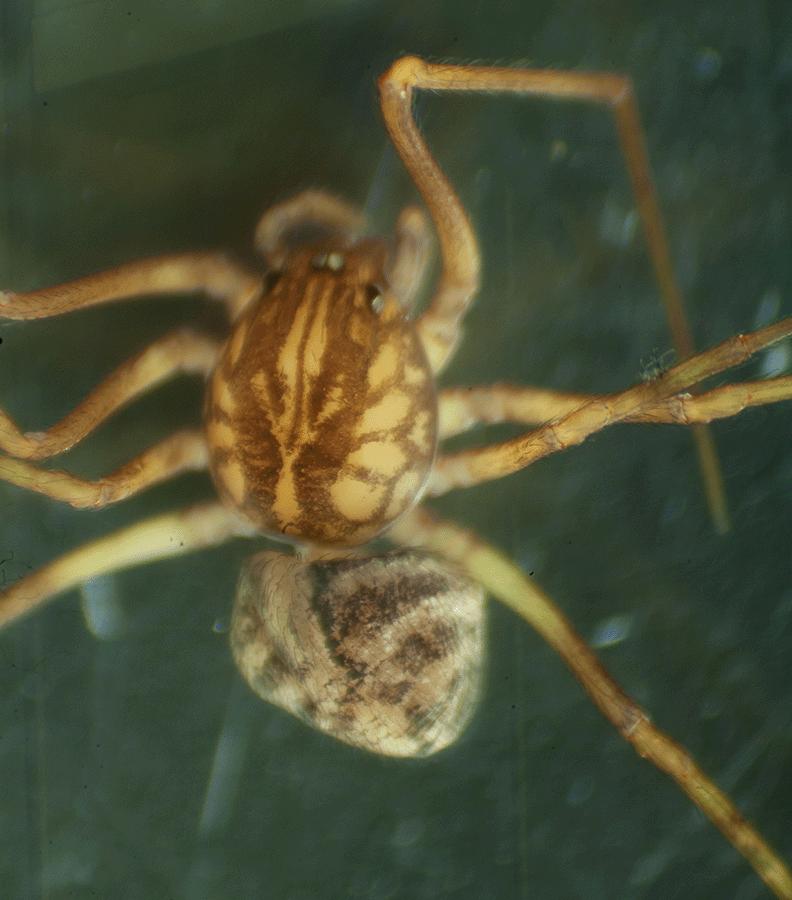
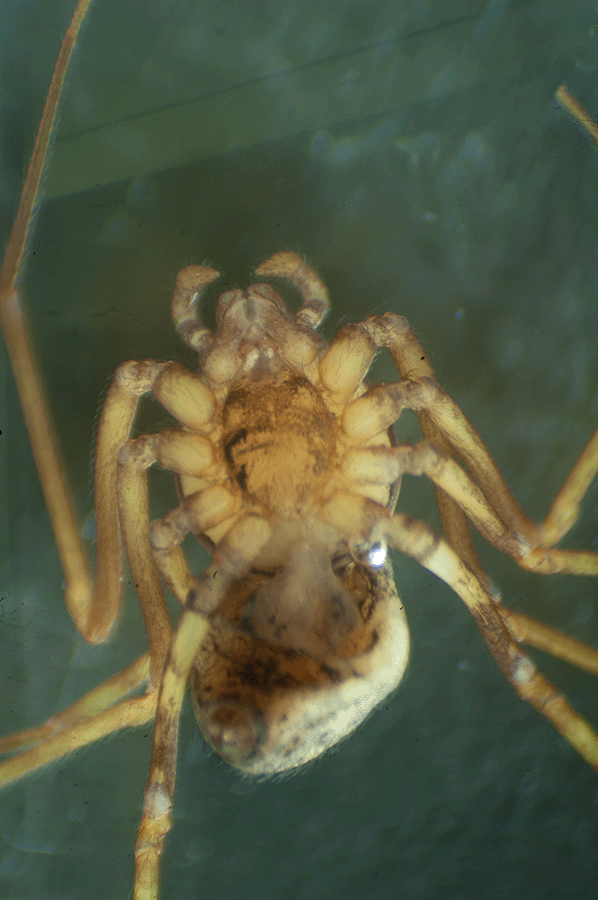
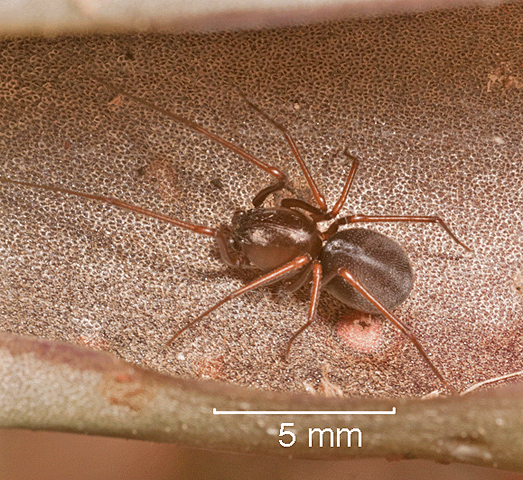
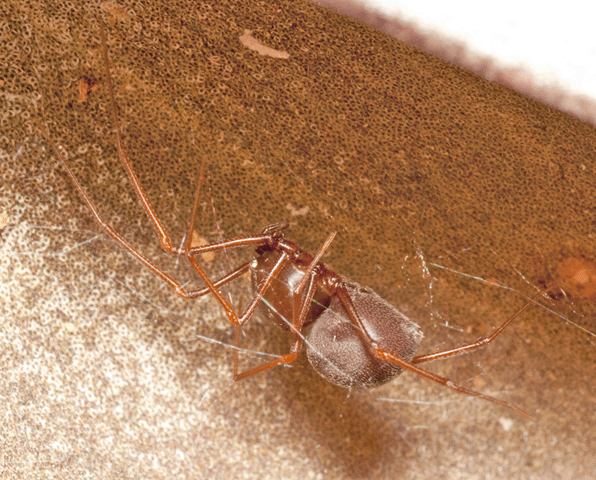
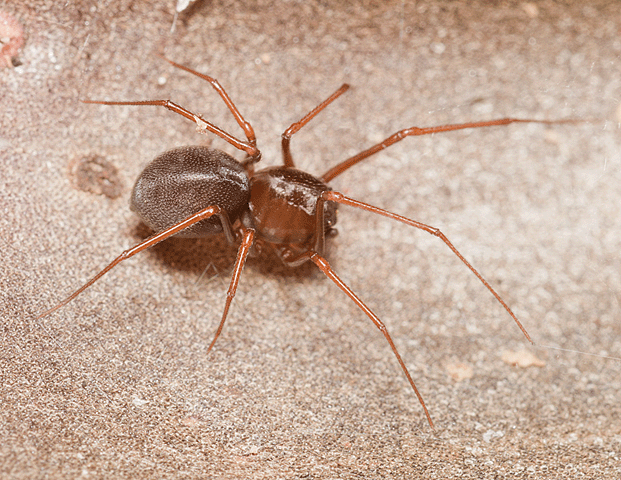
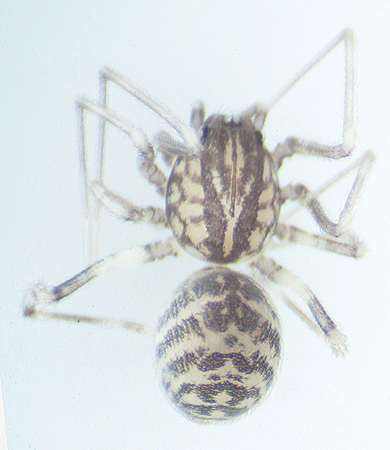
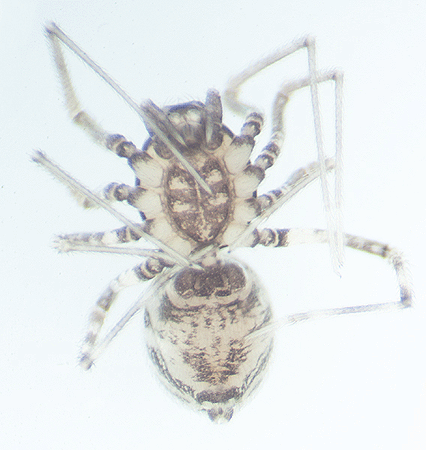
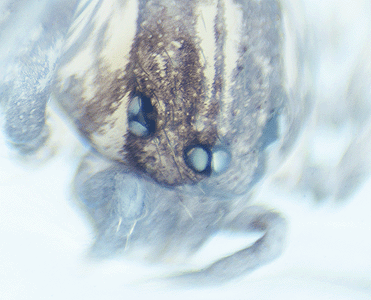
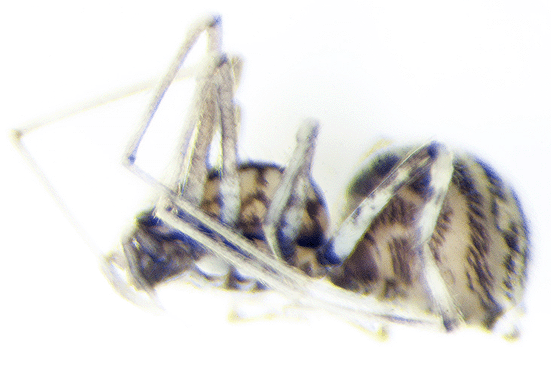
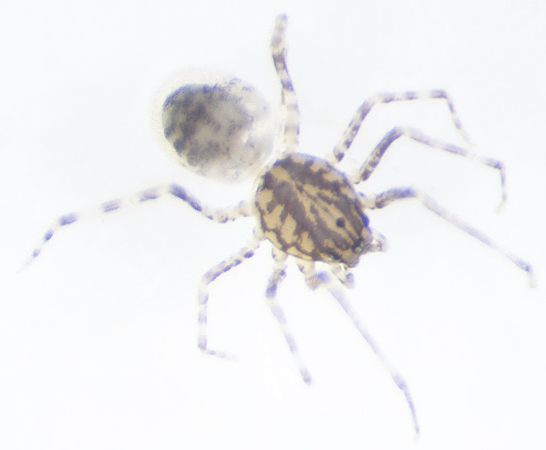
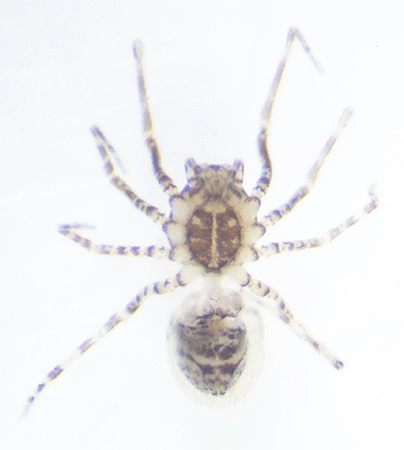
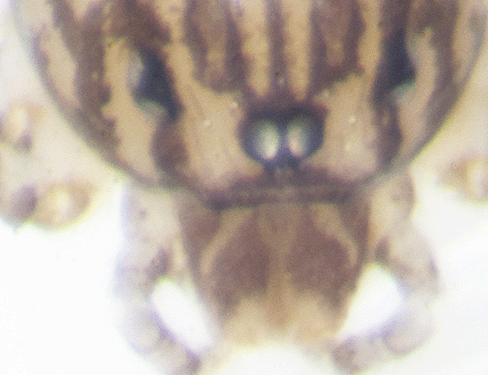
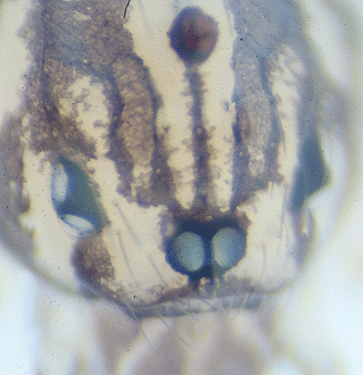
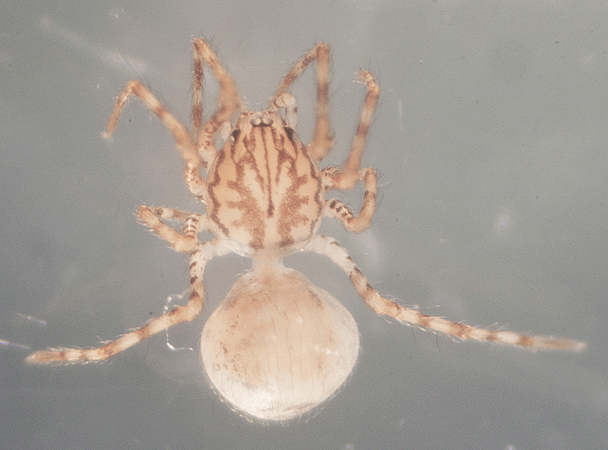
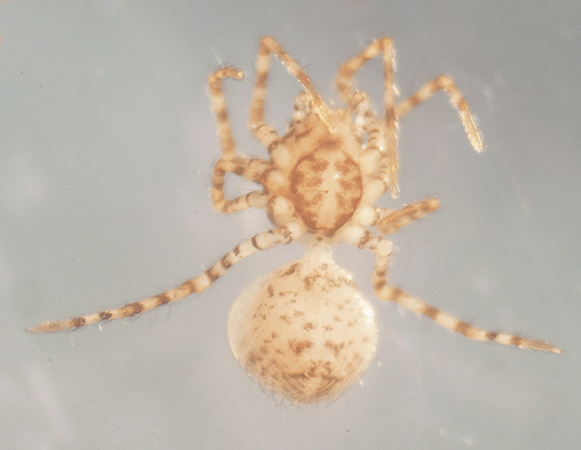
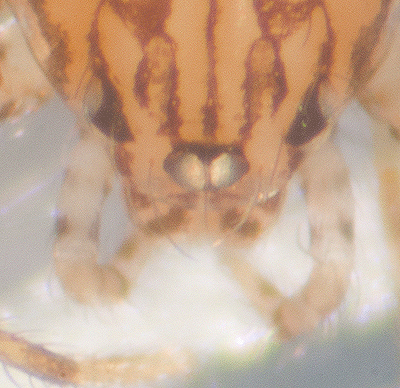
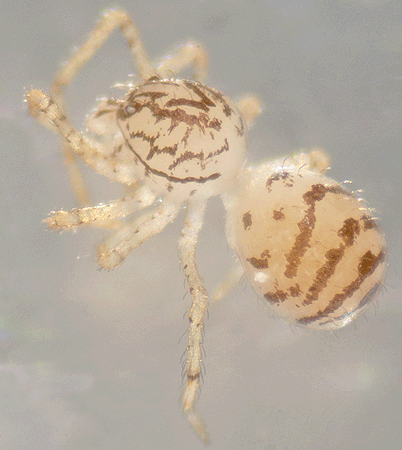 On March 4, 2015, the 1.5 mm long, 6-eyed spider at right was living in leaf litter beneath a
On March 4, 2015, the 1.5 mm long, 6-eyed spider at right was living in leaf litter beneath a 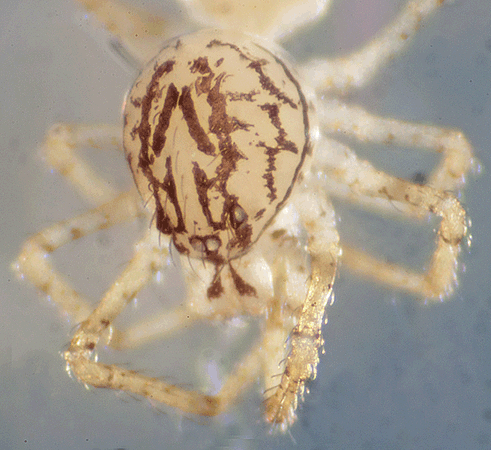
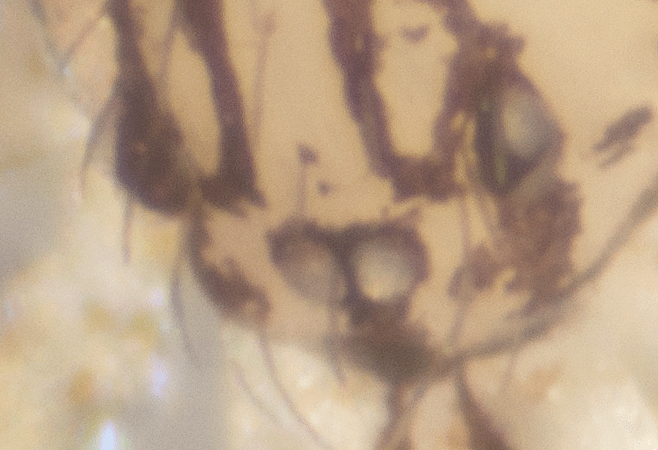
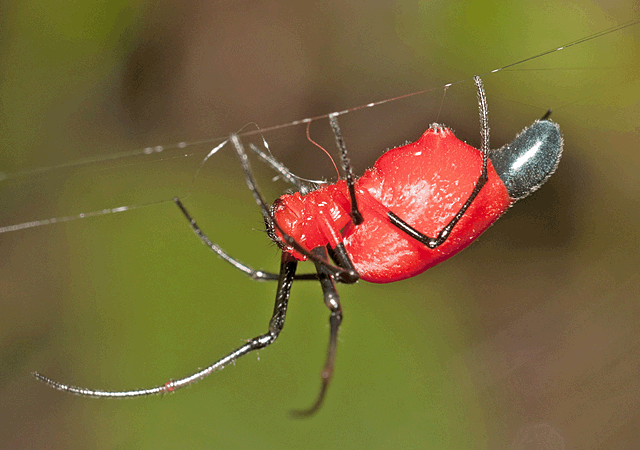 On June 18, 2015, this 10 mm long spider was photographed hanging from its web in the Smith Preserve.
On June 18, 2015, this 10 mm long spider was photographed hanging from its web in the Smith Preserve. 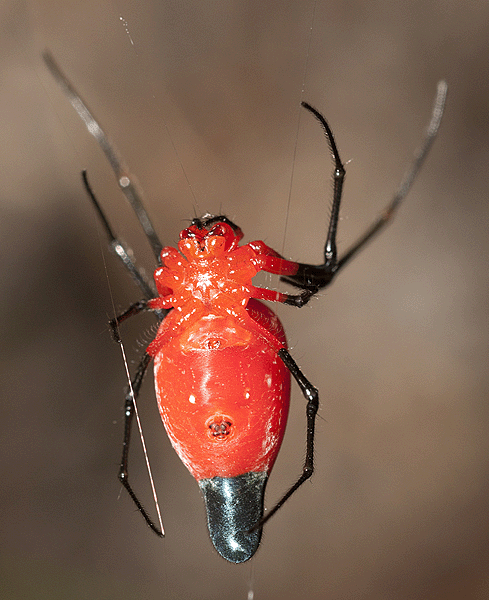 On February 19, 2016, the genus was identified by "joot", a Contributor to <BugGuide.net>. "joot" stated, "New genus for the guide. It goes under Tetragnathidae... see the nice eyelash trichobothria on the hind femur. They're abundant in the Caribbean islands, but I don't believe they're previously known in Florida."
On February 19, 2016, the genus was identified by "joot", a Contributor to <BugGuide.net>. "joot" stated, "New genus for the guide. It goes under Tetragnathidae... see the nice eyelash trichobothria on the hind femur. They're abundant in the Caribbean islands, but I don't believe they're previously known in Florida."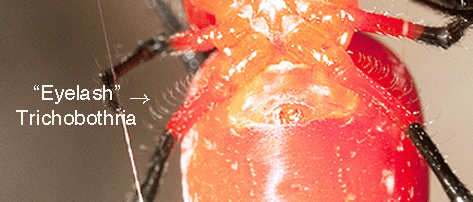
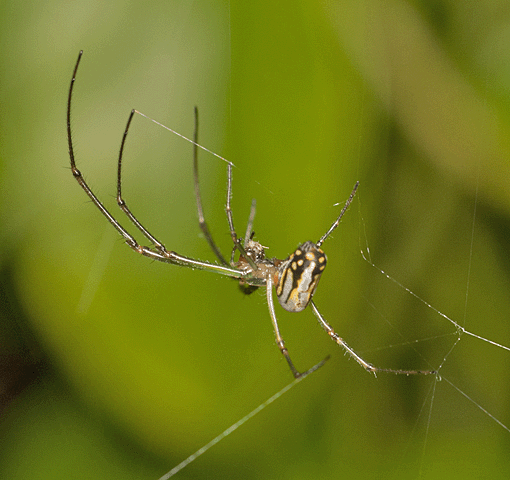
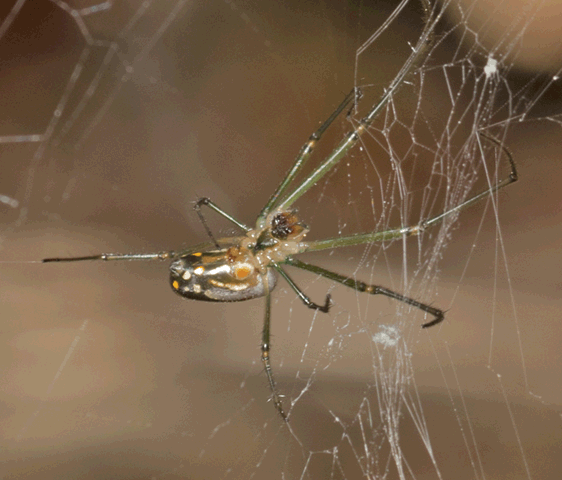
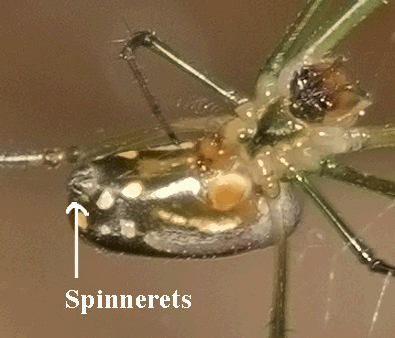
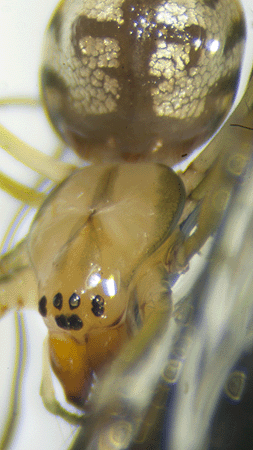 Photographs were created using photomicroscopy and sent for identification to <BugGuide.net>, sponsored by Iowa State University's Department of Entomology. On January 28, 2015, it was identified as Leucauge argyra by John and Jane Balaban, Contributing Editors to <BugGuide.net>.
Photographs were created using photomicroscopy and sent for identification to <BugGuide.net>, sponsored by Iowa State University's Department of Entomology. On January 28, 2015, it was identified as Leucauge argyra by John and Jane Balaban, Contributing Editors to <BugGuide.net>.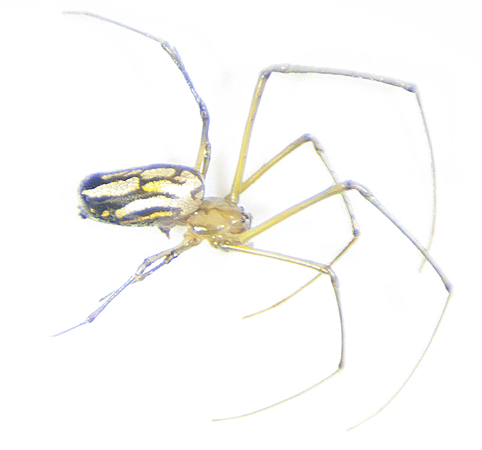
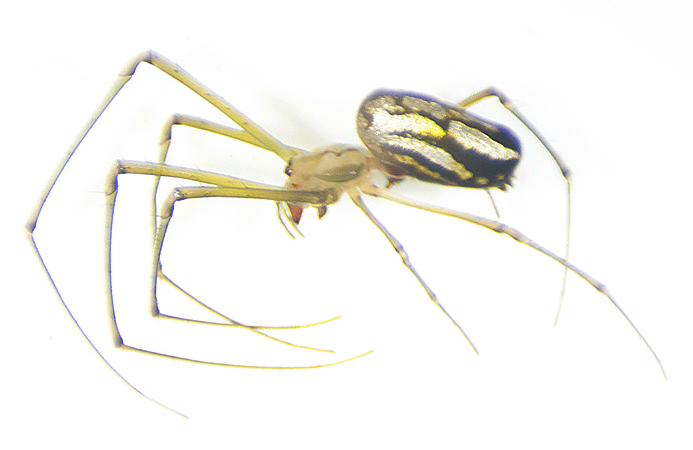
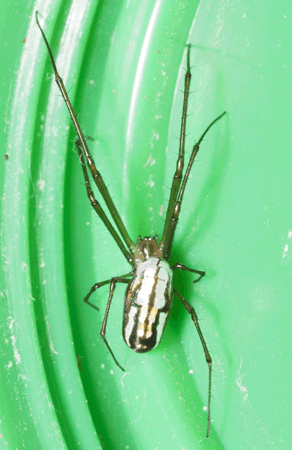
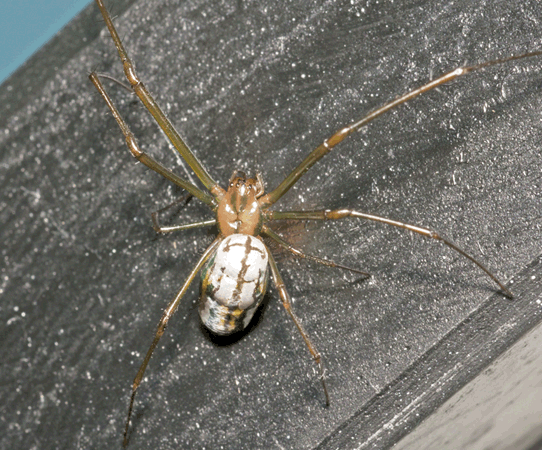
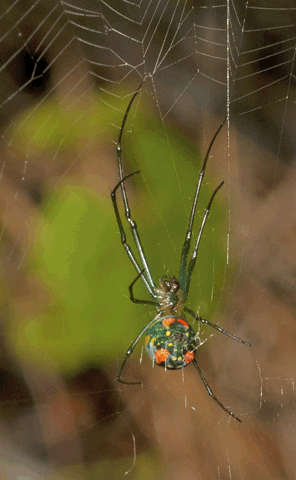
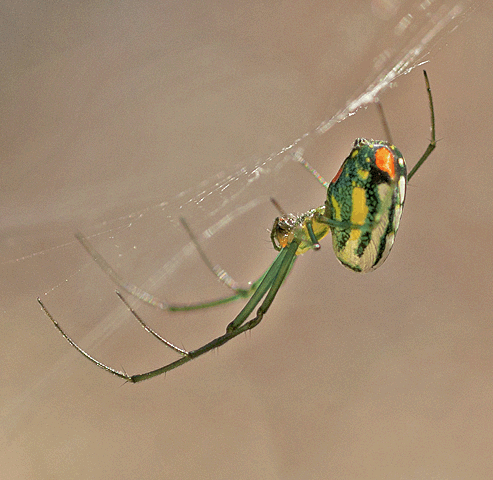
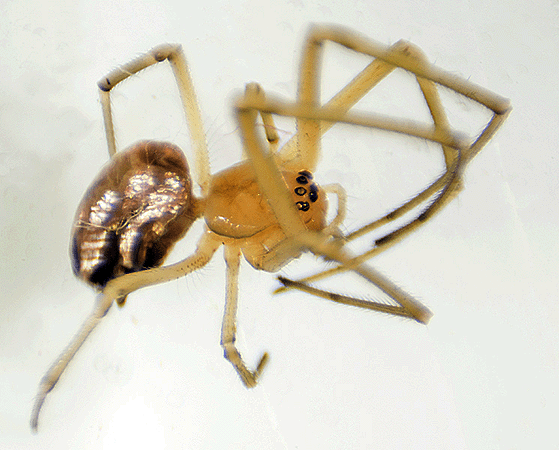
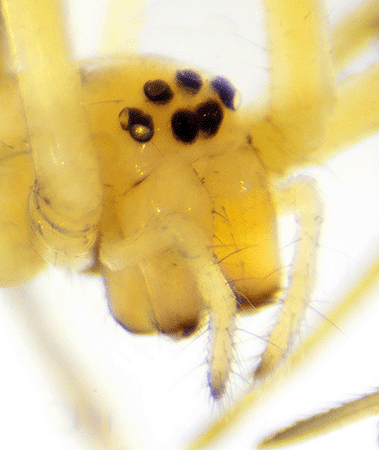
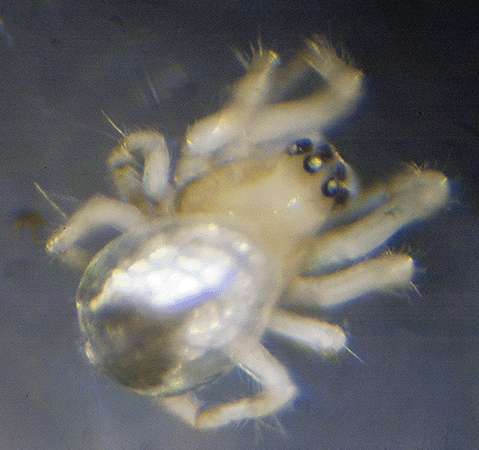
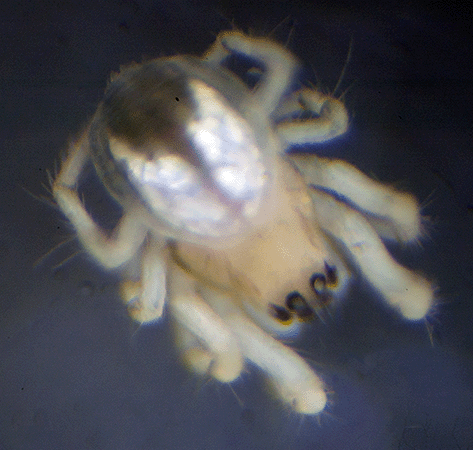
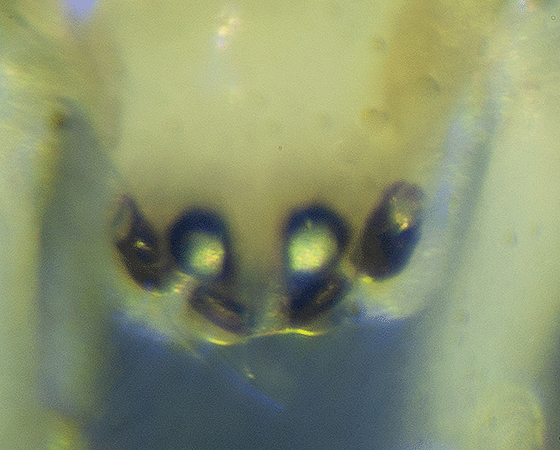 It has 8 eyes as shown in the image at right. It is difficult to see them all because the outer two pair are touching one another.
It has 8 eyes as shown in the image at right. It is difficult to see them all because the outer two pair are touching one another. 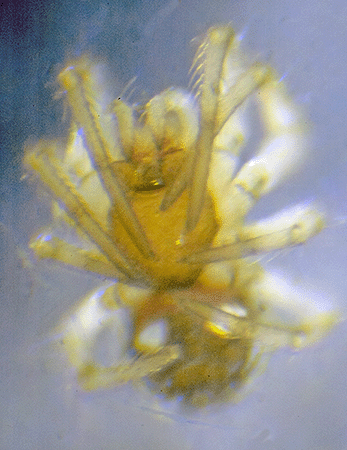
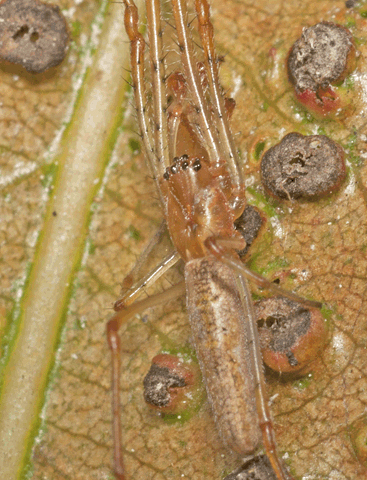
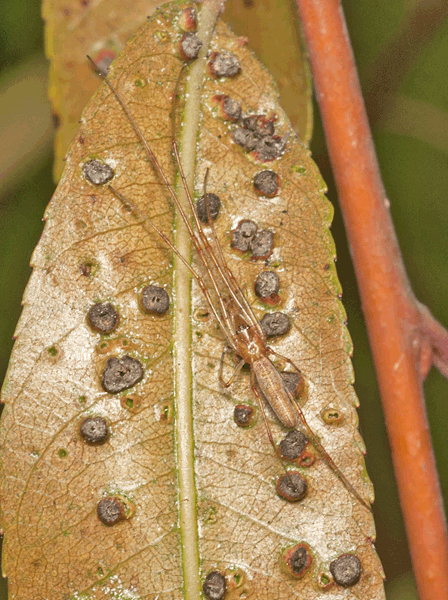
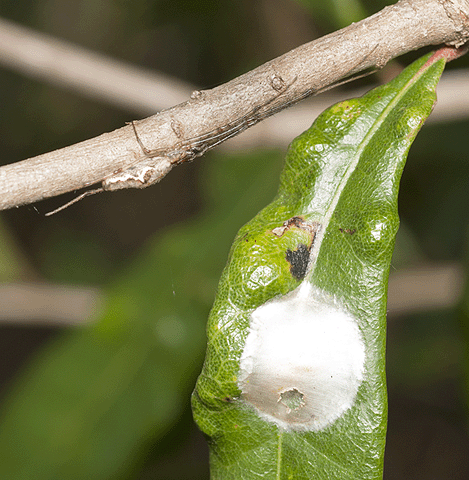
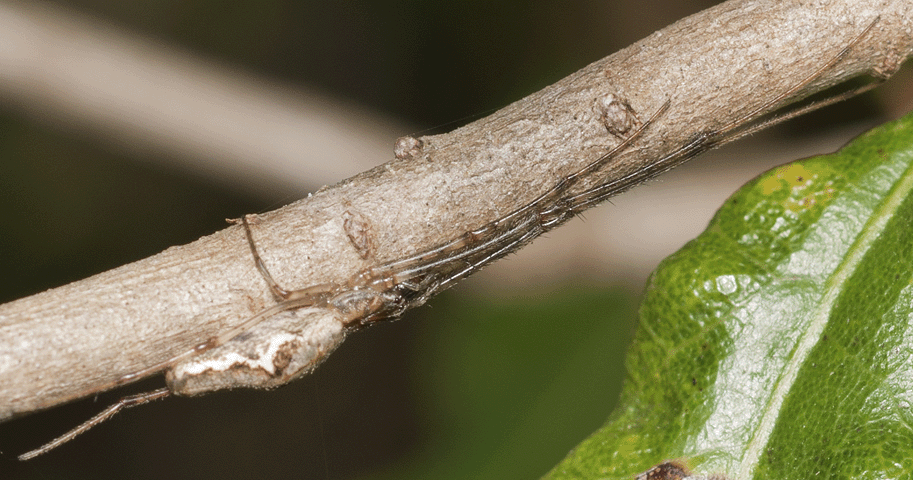
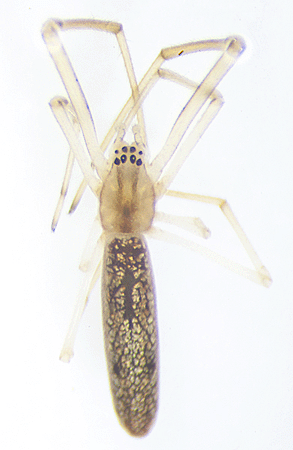 On January 26, 2016, the 4 mm long spider shown here was caught in a sweep net sample collected in low dry vegetation growing along the Smith Preserve's eastern gopher tortoise fence.
On January 26, 2016, the 4 mm long spider shown here was caught in a sweep net sample collected in low dry vegetation growing along the Smith Preserve's eastern gopher tortoise fence. 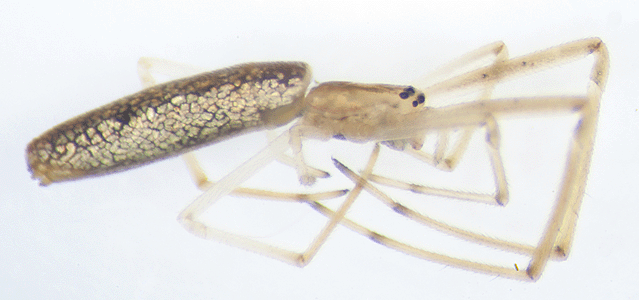
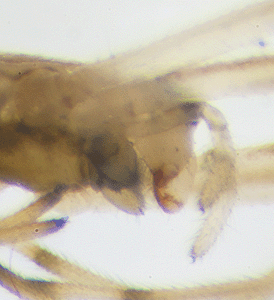 Jaws of Tetragnatha spp., as shown in the photograph at left, move side to side in a scissor-like fashion. As shown below, all members of the genus have 8 widely-spaced eyes.
Jaws of Tetragnatha spp., as shown in the photograph at left, move side to side in a scissor-like fashion. As shown below, all members of the genus have 8 widely-spaced eyes. 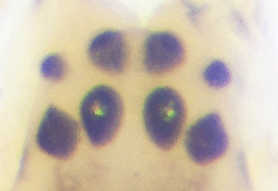 As shown in the photographs above, the abdomen is elongate and oval. Tetragnatha spp. are brown, yellow, and silver.
As shown in the photographs above, the abdomen is elongate and oval. Tetragnatha spp. are brown, yellow, and silver.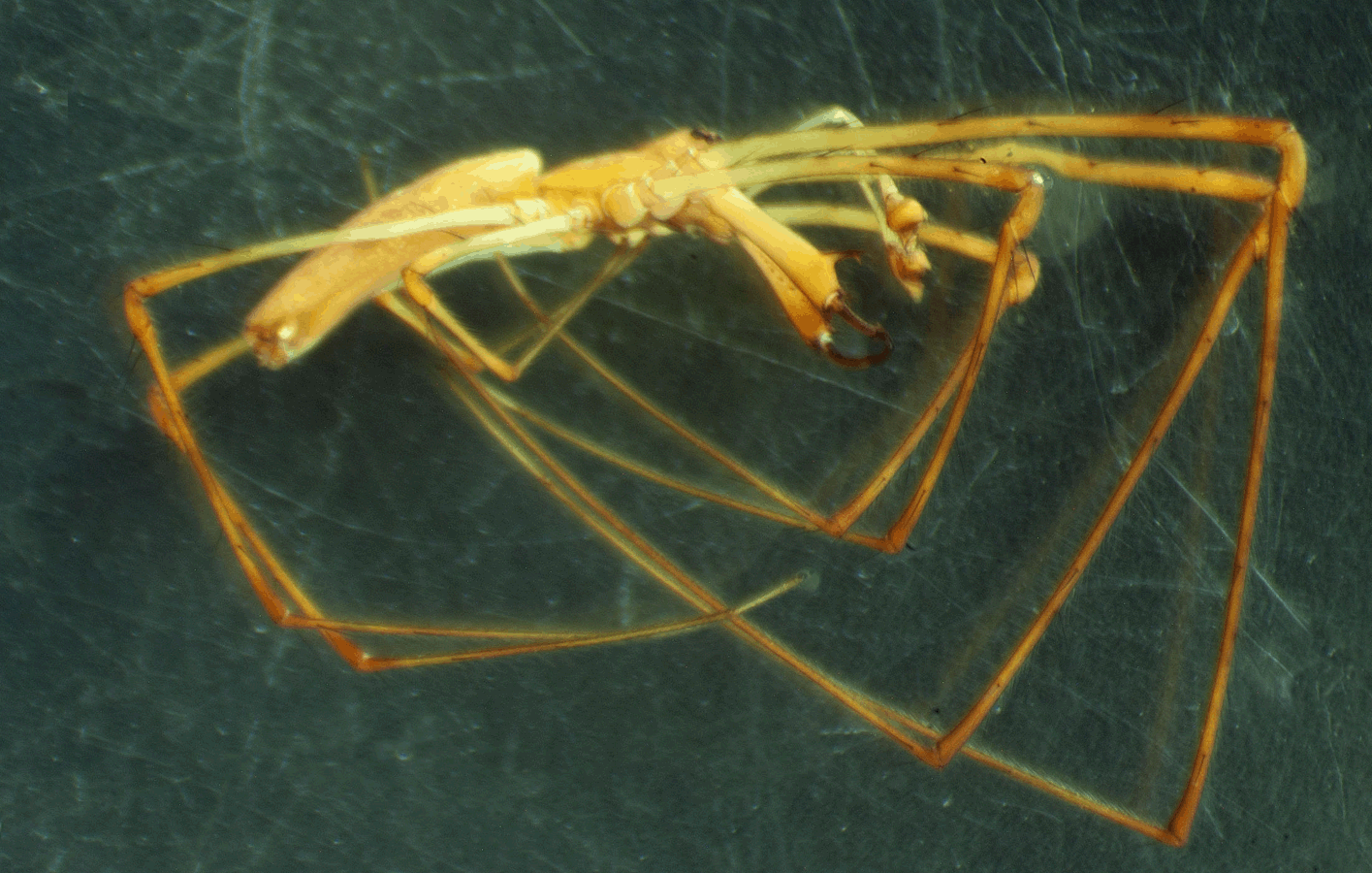
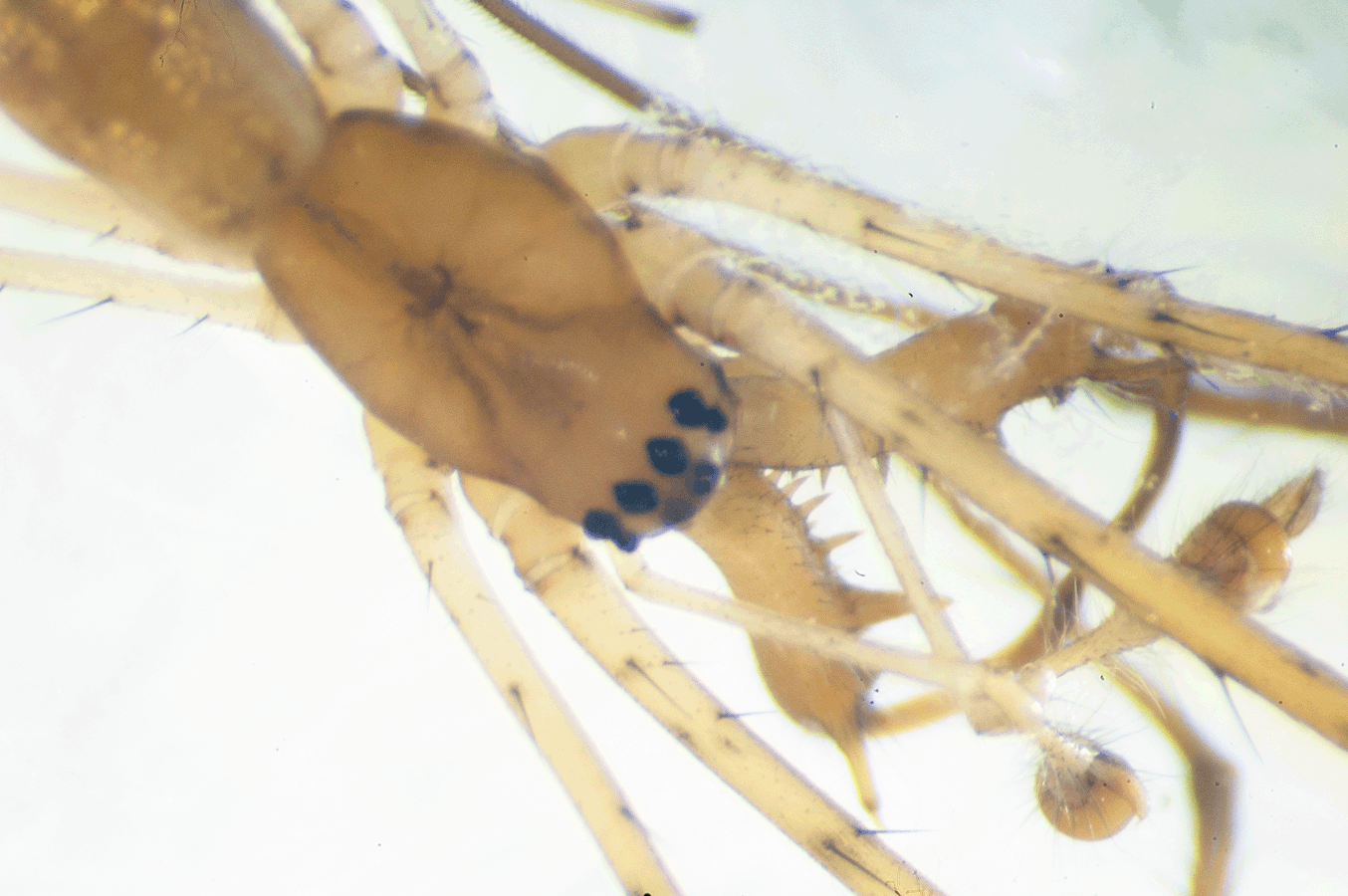
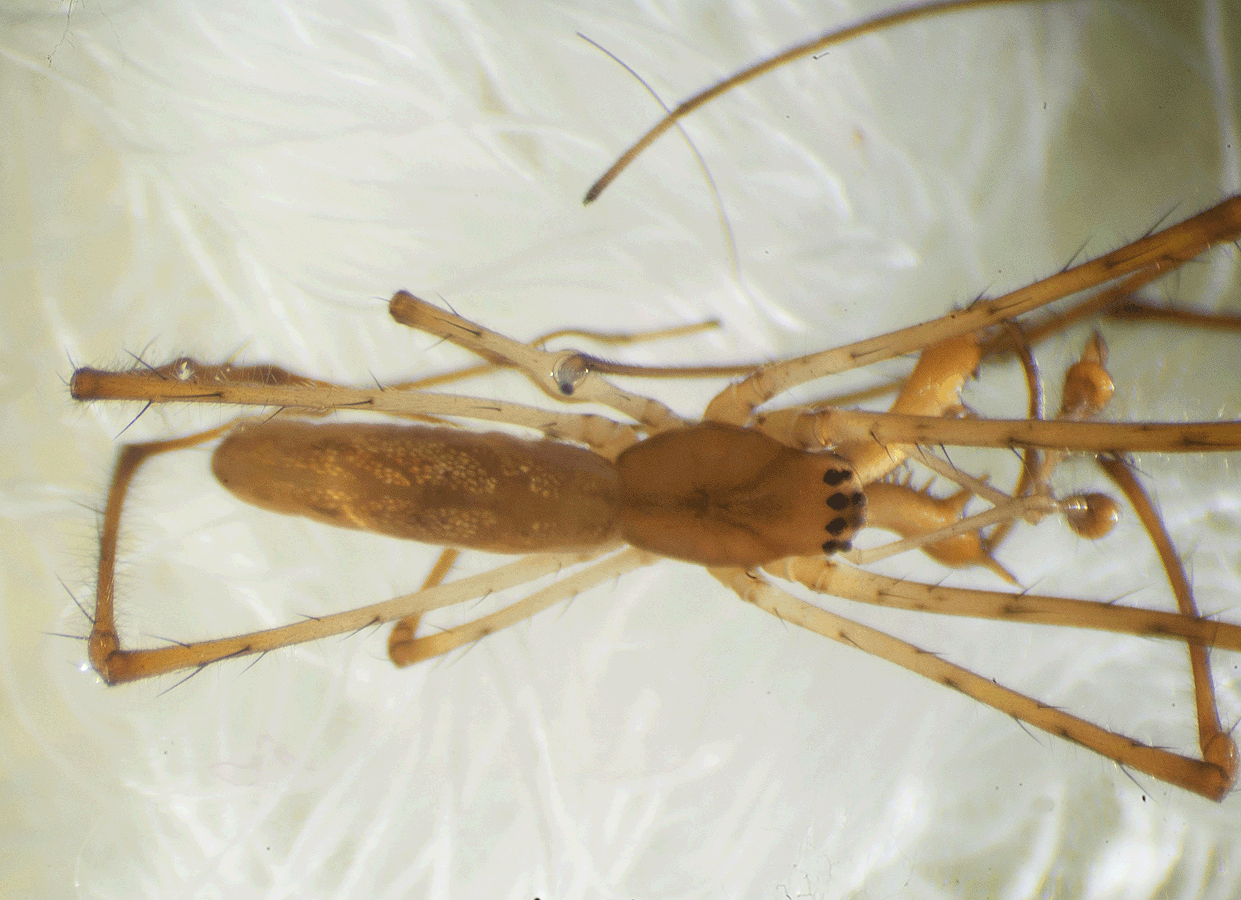
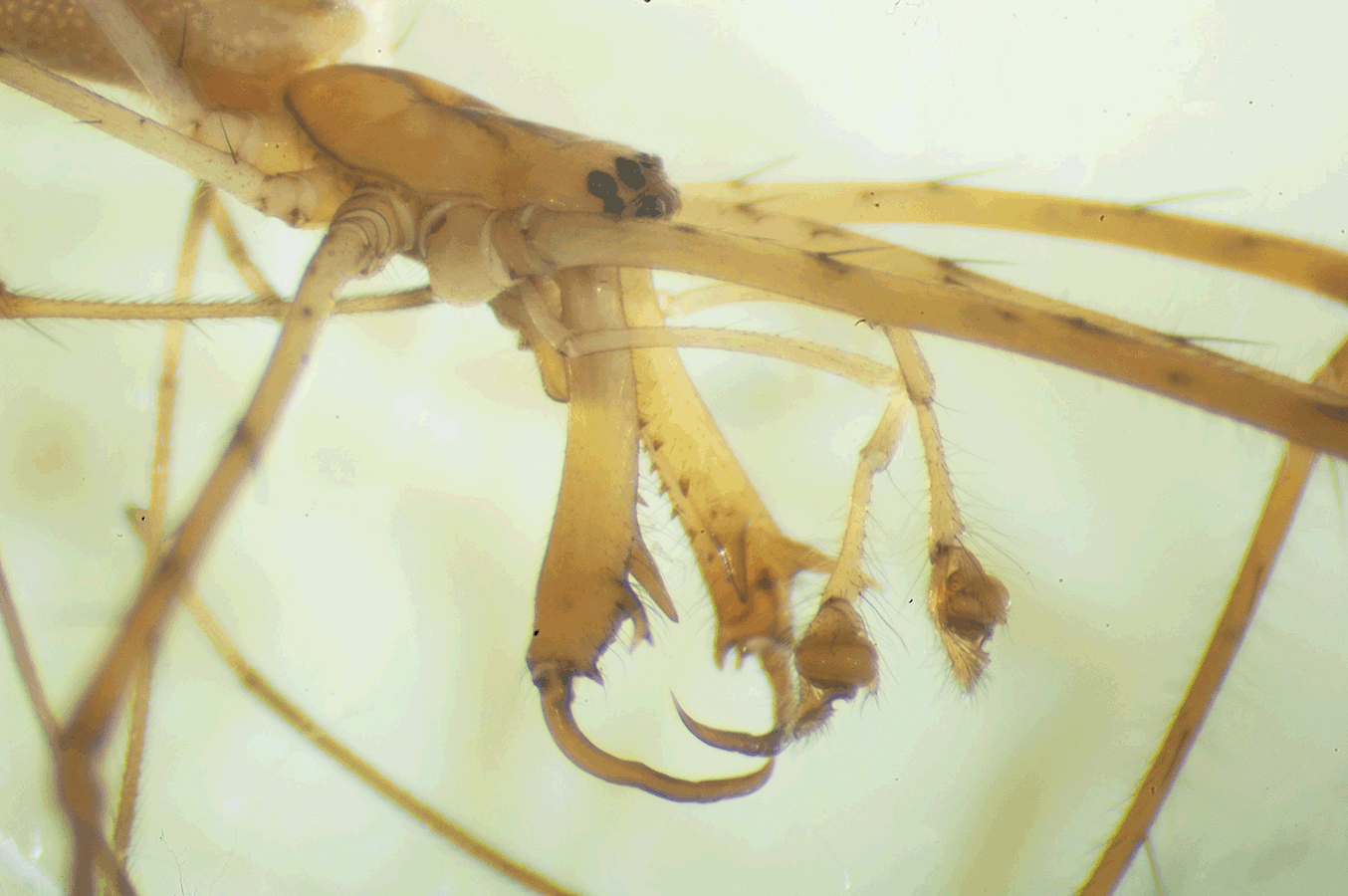
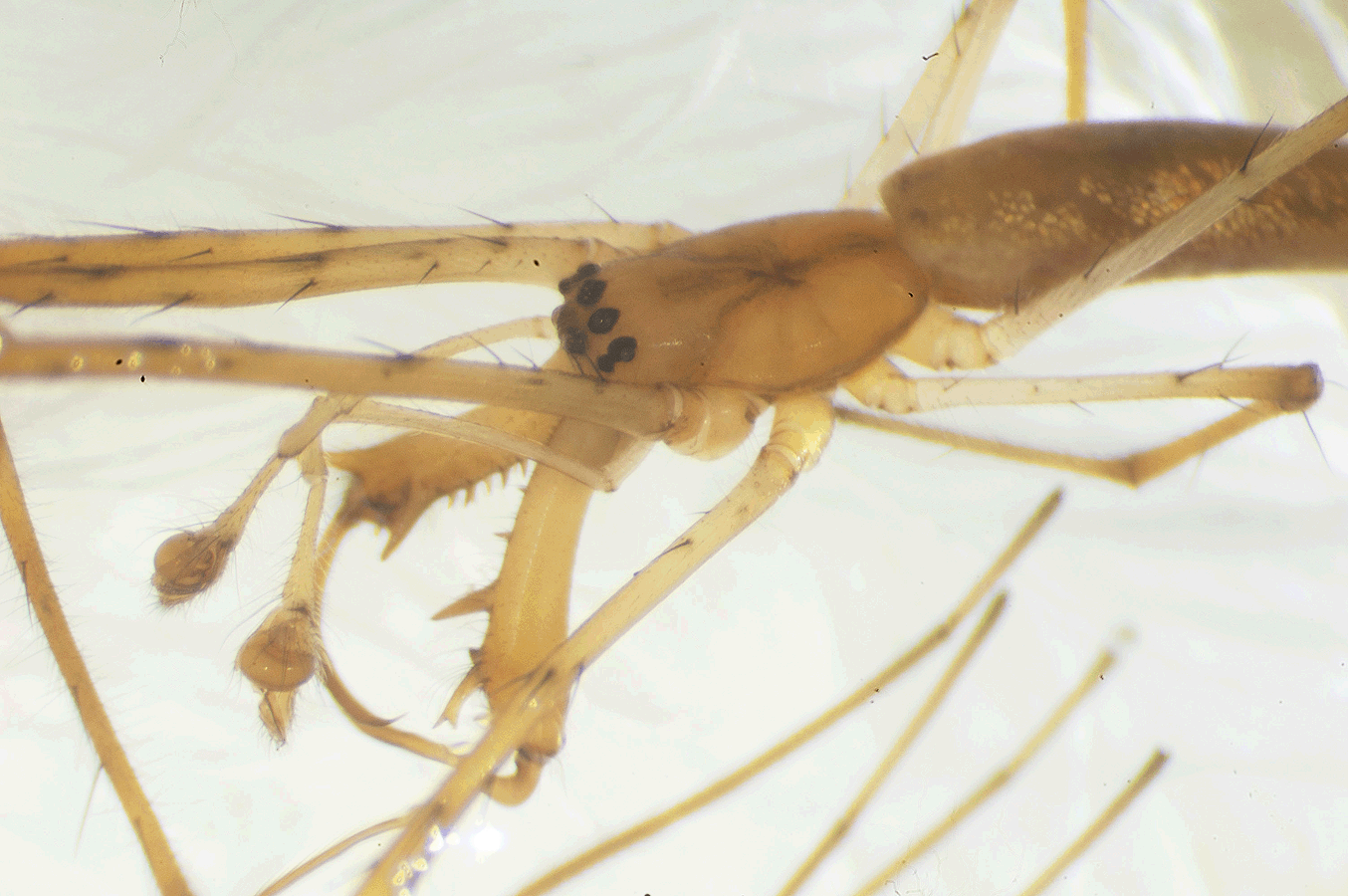
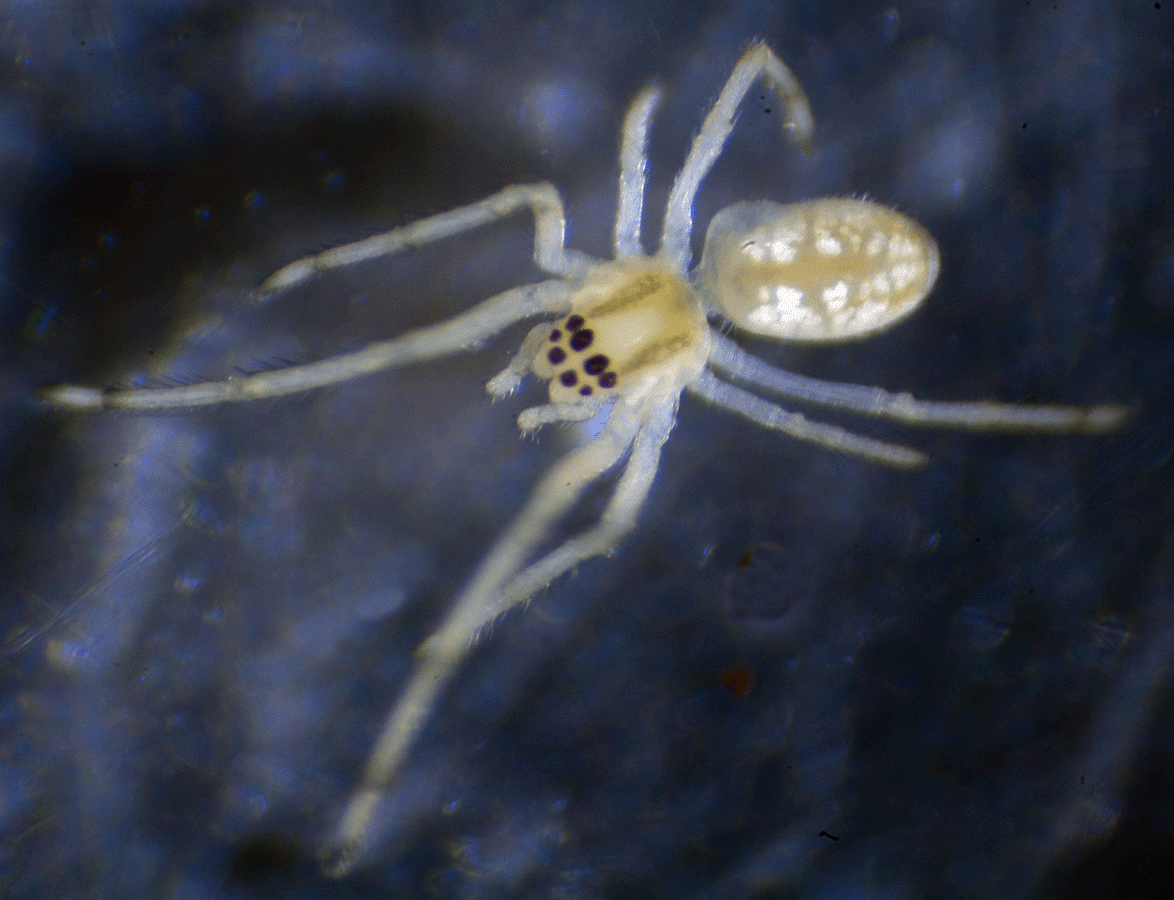
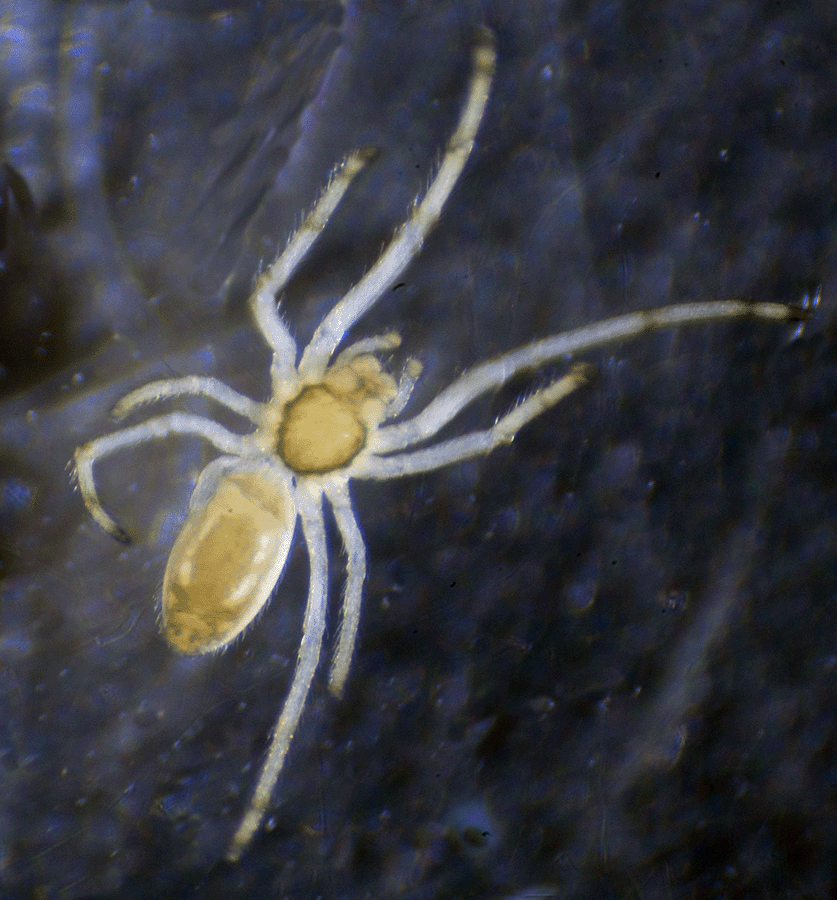
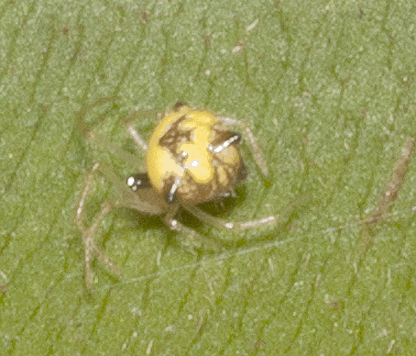 On January 28, 2015, this 2 mm spider was spotted on the bottom of a tall frond of
On January 28, 2015, this 2 mm spider was spotted on the bottom of a tall frond of 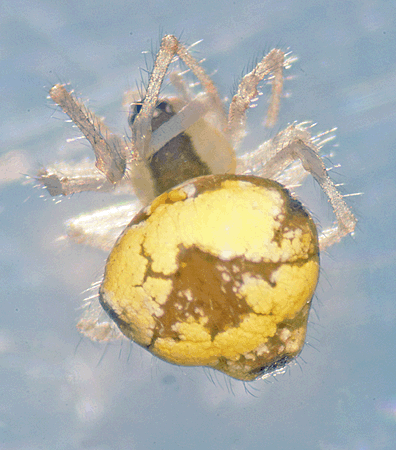 On January 28, 2015, it was identified as possibly Theridula gonygaster by Lisa B., a Contributor to <BugGuide.net>, sponsored by Iowa State University Department of Entomology. On February 19, 2015, the identification was confirmed by John Rosenfeld, a Contributing Editor to <BugGuide.net>. He stated: "Seems to fit the description and epigynum diagram for Theridula regia in Gertsch and Archer, 1942 pretty well. WSC [World Spider Catalog] lists T. regia as a synonym for T. gonygaster. Type location was Dade County."
On January 28, 2015, it was identified as possibly Theridula gonygaster by Lisa B., a Contributor to <BugGuide.net>, sponsored by Iowa State University Department of Entomology. On February 19, 2015, the identification was confirmed by John Rosenfeld, a Contributing Editor to <BugGuide.net>. He stated: "Seems to fit the description and epigynum diagram for Theridula regia in Gertsch and Archer, 1942 pretty well. WSC [World Spider Catalog] lists T. regia as a synonym for T. gonygaster. Type location was Dade County."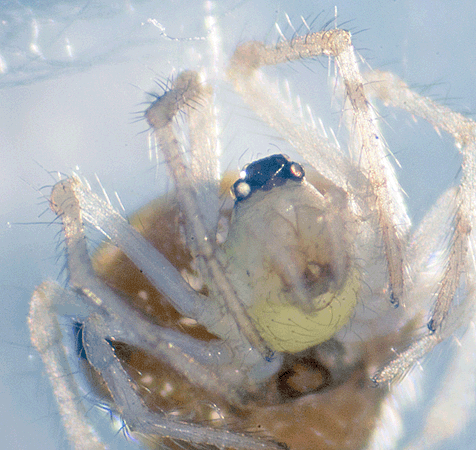
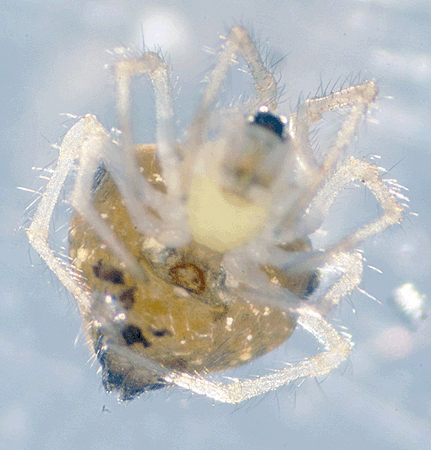
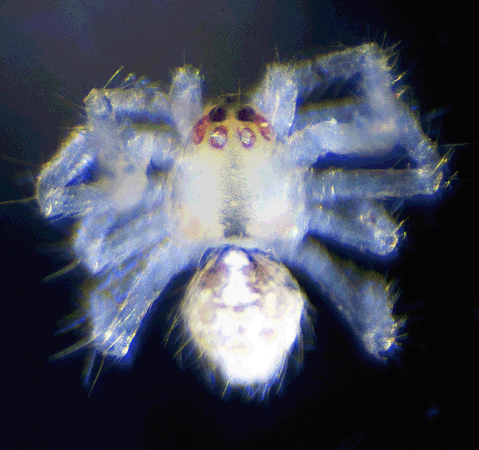
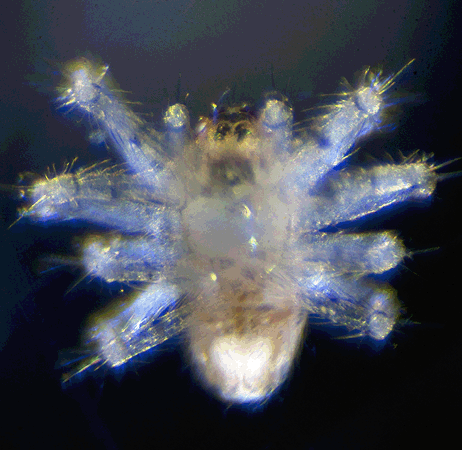
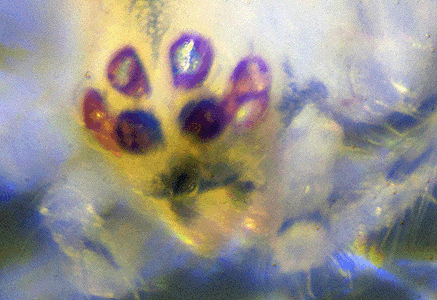 On March 4, 2015, this .75 mm spider was living in leaf litter beneath a
On March 4, 2015, this .75 mm spider was living in leaf litter beneath a 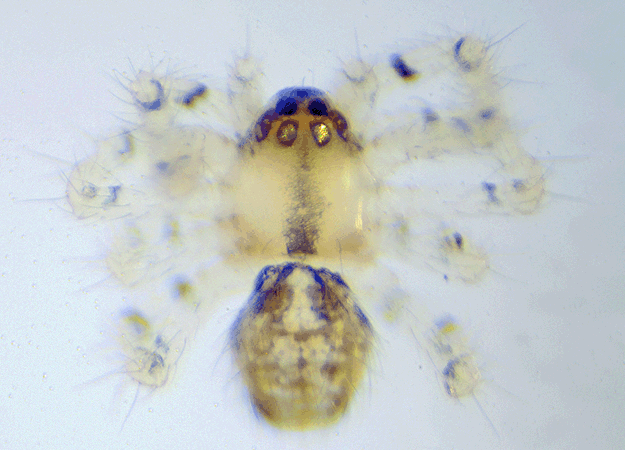
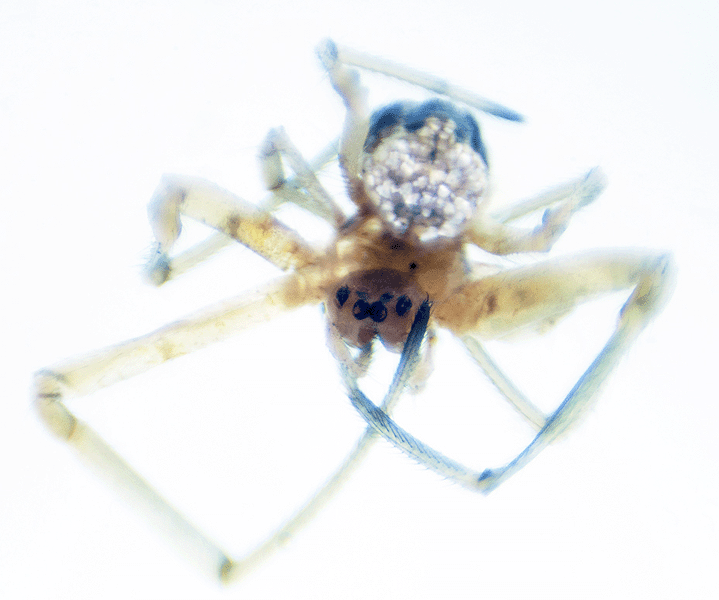
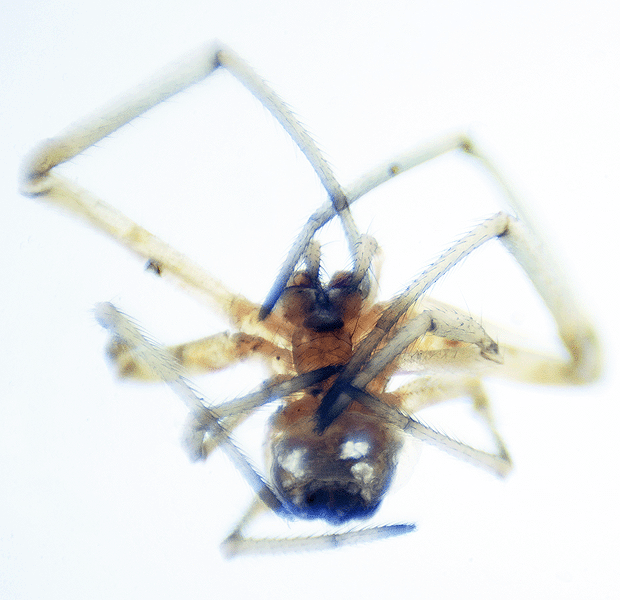
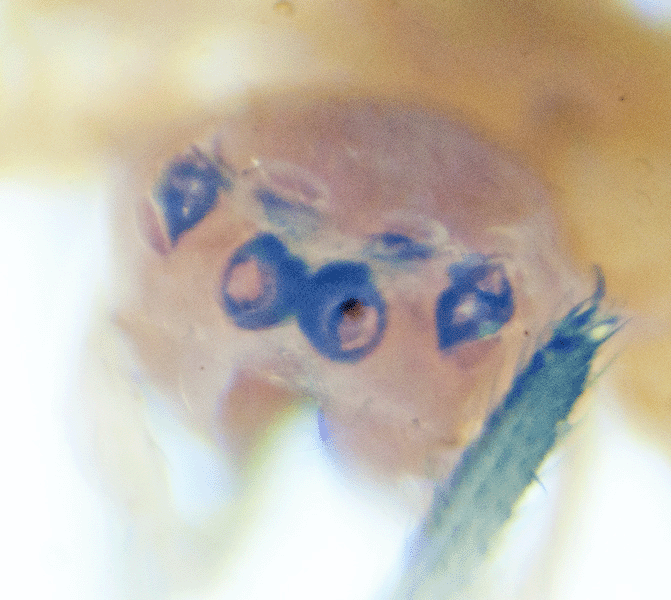 On April 4, 2019, the family was identified by Chad Heins, a Contributing Editor to <BugGuide.net>. After examining the photograph at right, Chad stated "I see 8 eyes. The anterior lateral and posterior lateral eyes are bunched together. The posterior median eyes are the dark marks behind the anterior median eyes. Maybe Theridiidae."
On April 4, 2019, the family was identified by Chad Heins, a Contributing Editor to <BugGuide.net>. After examining the photograph at right, Chad stated "I see 8 eyes. The anterior lateral and posterior lateral eyes are bunched together. The posterior median eyes are the dark marks behind the anterior median eyes. Maybe Theridiidae."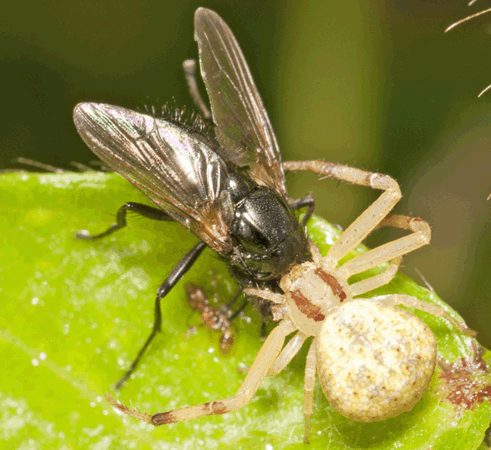
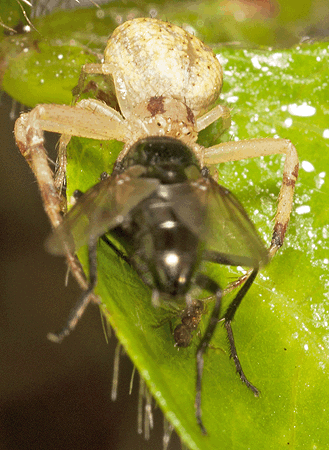
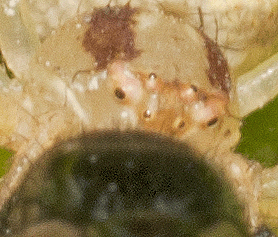 The genus can be recognized by the structural arrangement of the eyes. As shown at left, there are only 6 eyes visible when the spider is viewed from the front. The anterior lateral eyes are larger than the other eyes. Look closely at these large anterior eyes. They are on tubercles. On the back of these tubercles are the posterior lateral eyes facing to the side and back, making them difficult to see when the spider is viewed from the front.
The genus can be recognized by the structural arrangement of the eyes. As shown at left, there are only 6 eyes visible when the spider is viewed from the front. The anterior lateral eyes are larger than the other eyes. Look closely at these large anterior eyes. They are on tubercles. On the back of these tubercles are the posterior lateral eyes facing to the side and back, making them difficult to see when the spider is viewed from the front.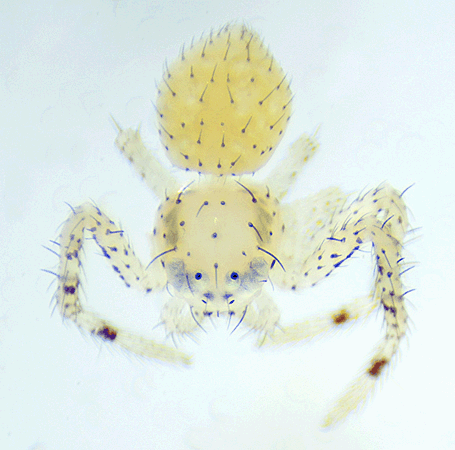
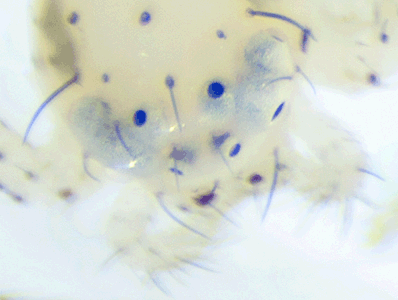 On January 10, 2016, Laura P., a Contributing Editor of <BugGuide.net>, identified the spider as a Mecaphesa spiderling.
On January 10, 2016, Laura P., a Contributing Editor of <BugGuide.net>, identified the spider as a Mecaphesa spiderling. 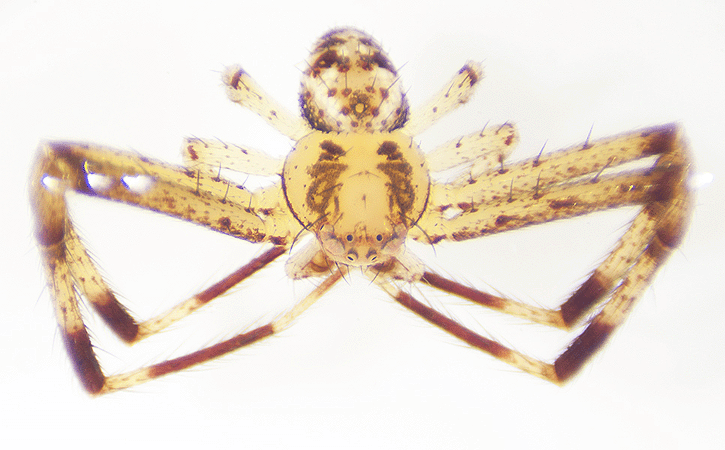
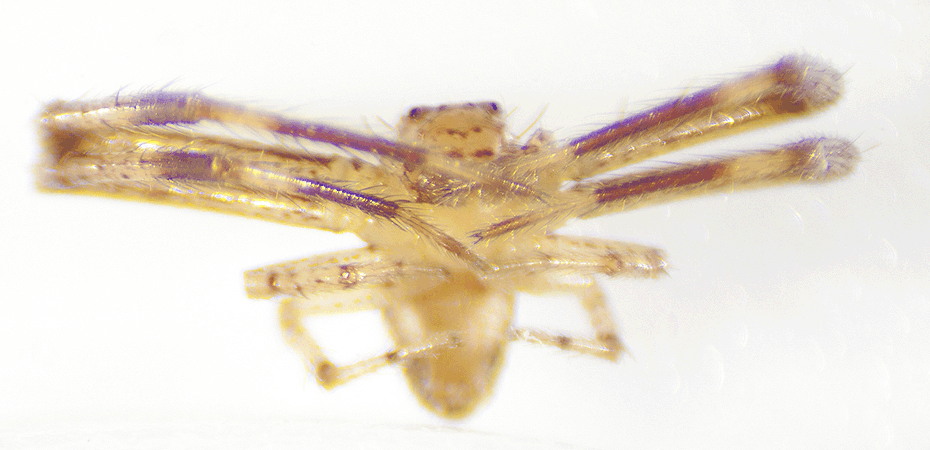
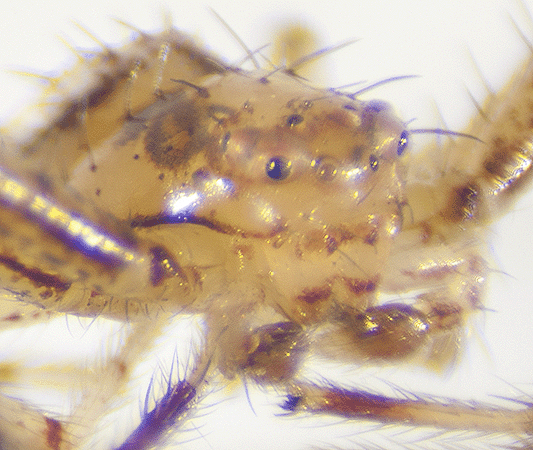
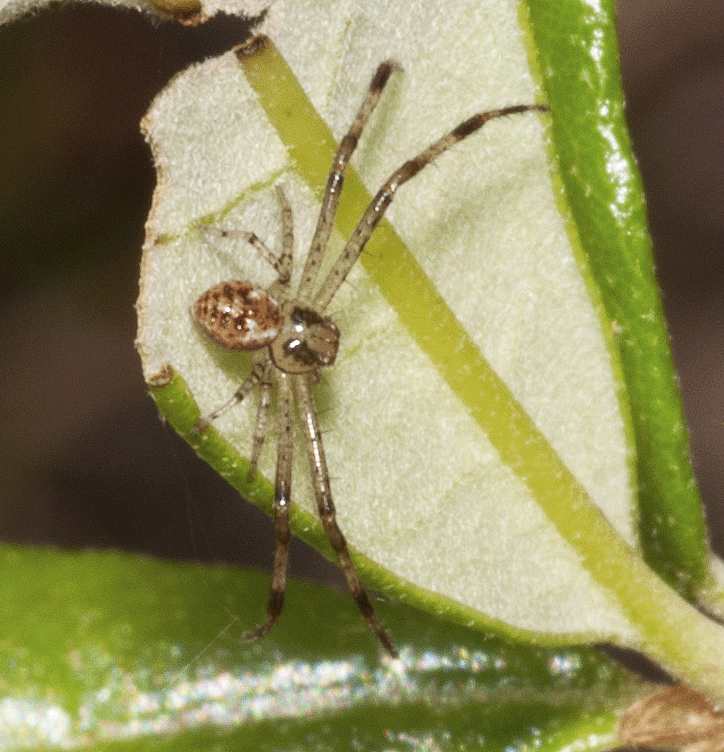
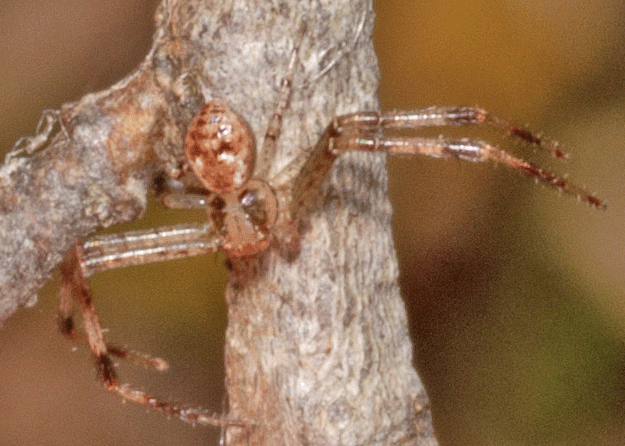
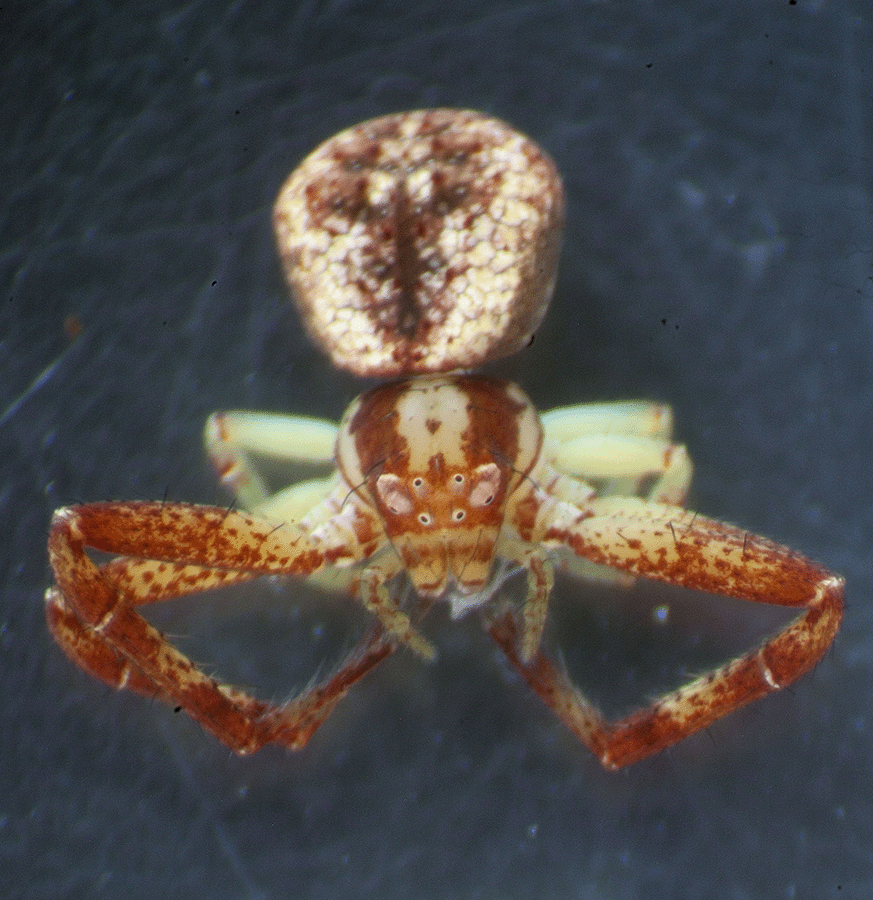
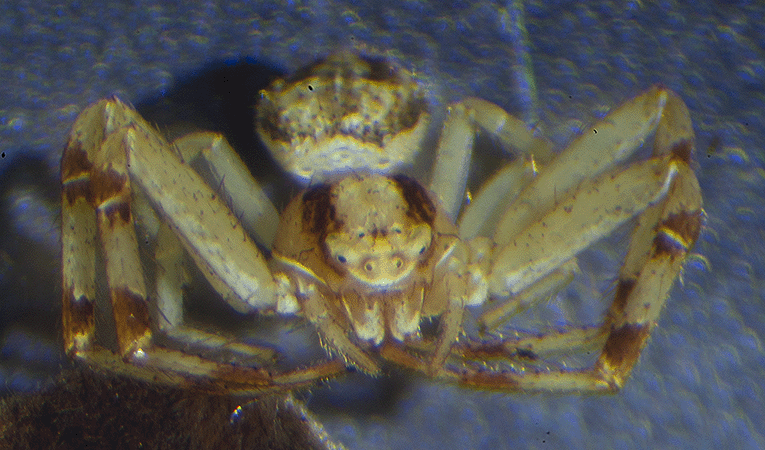
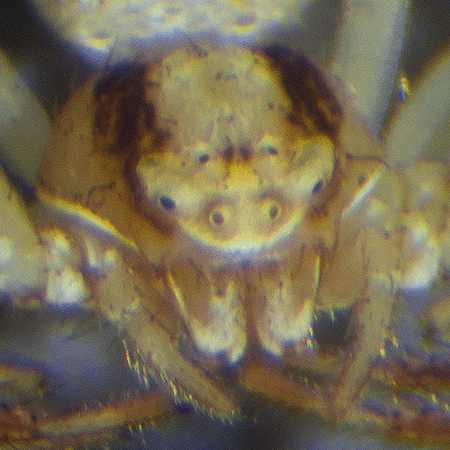
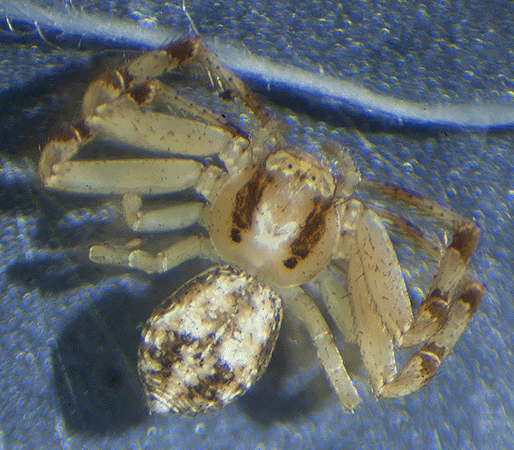
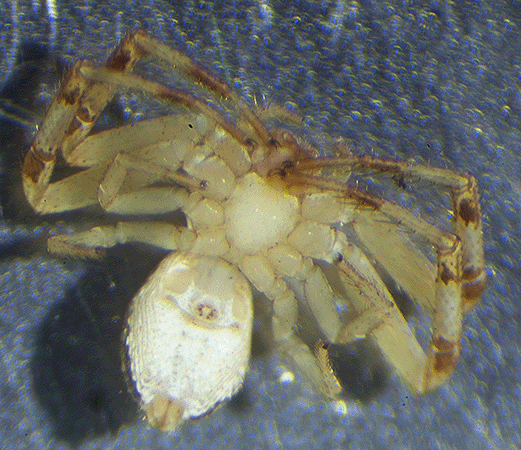
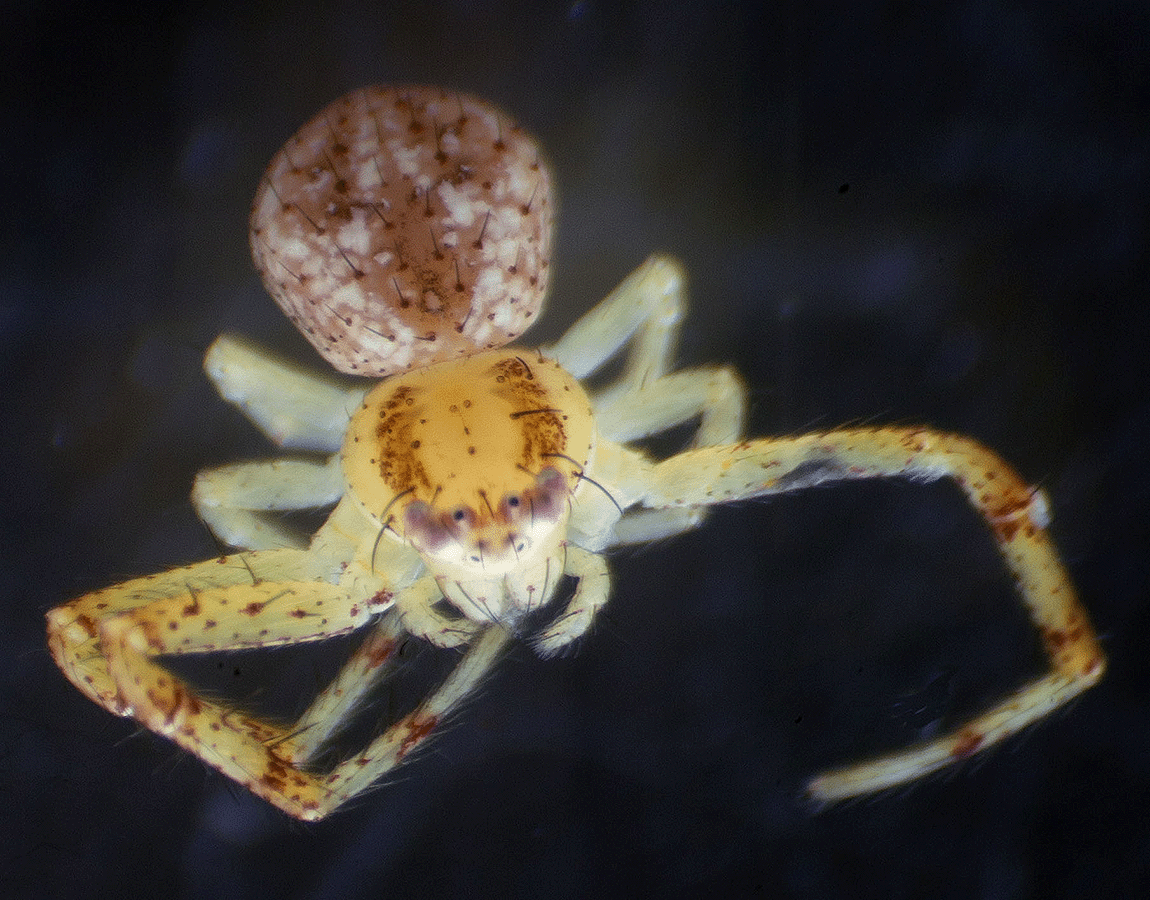
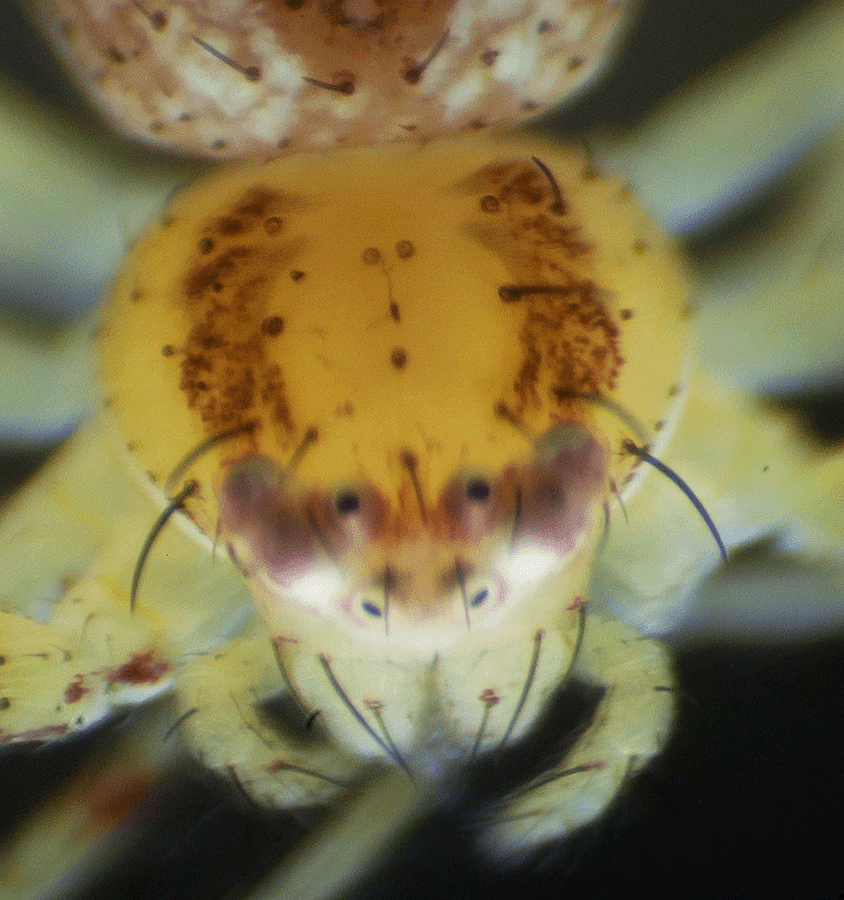
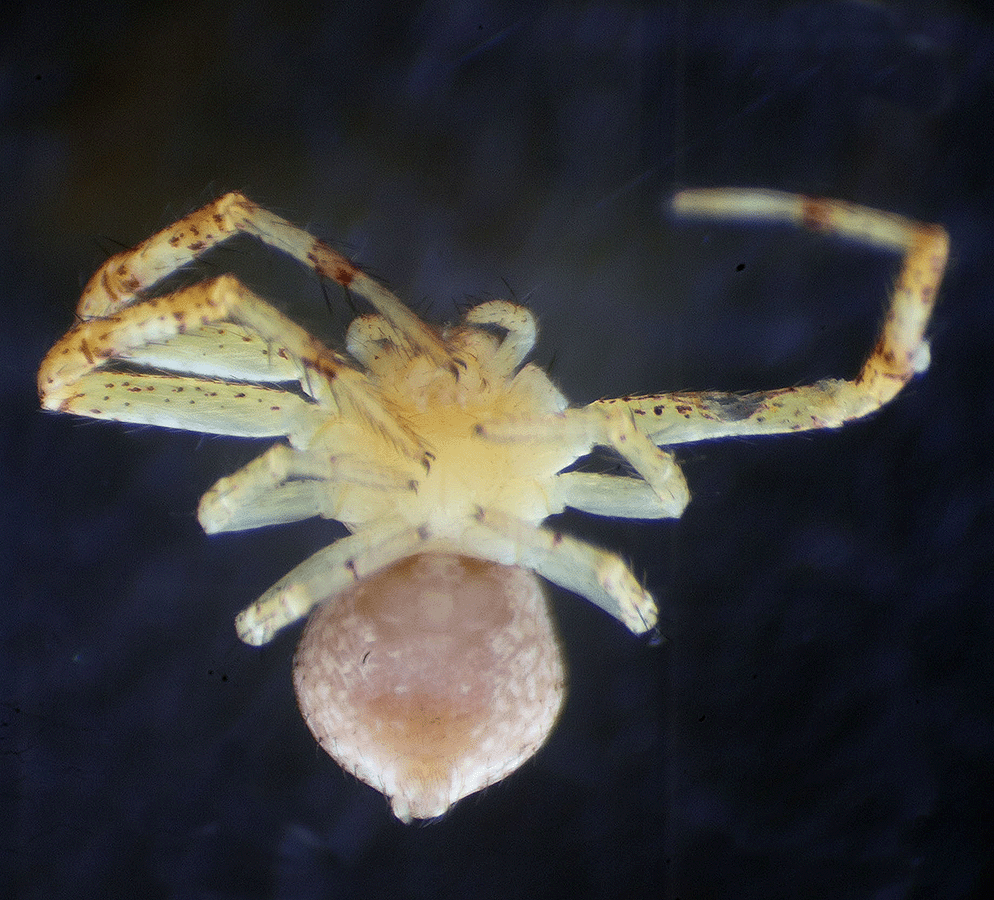
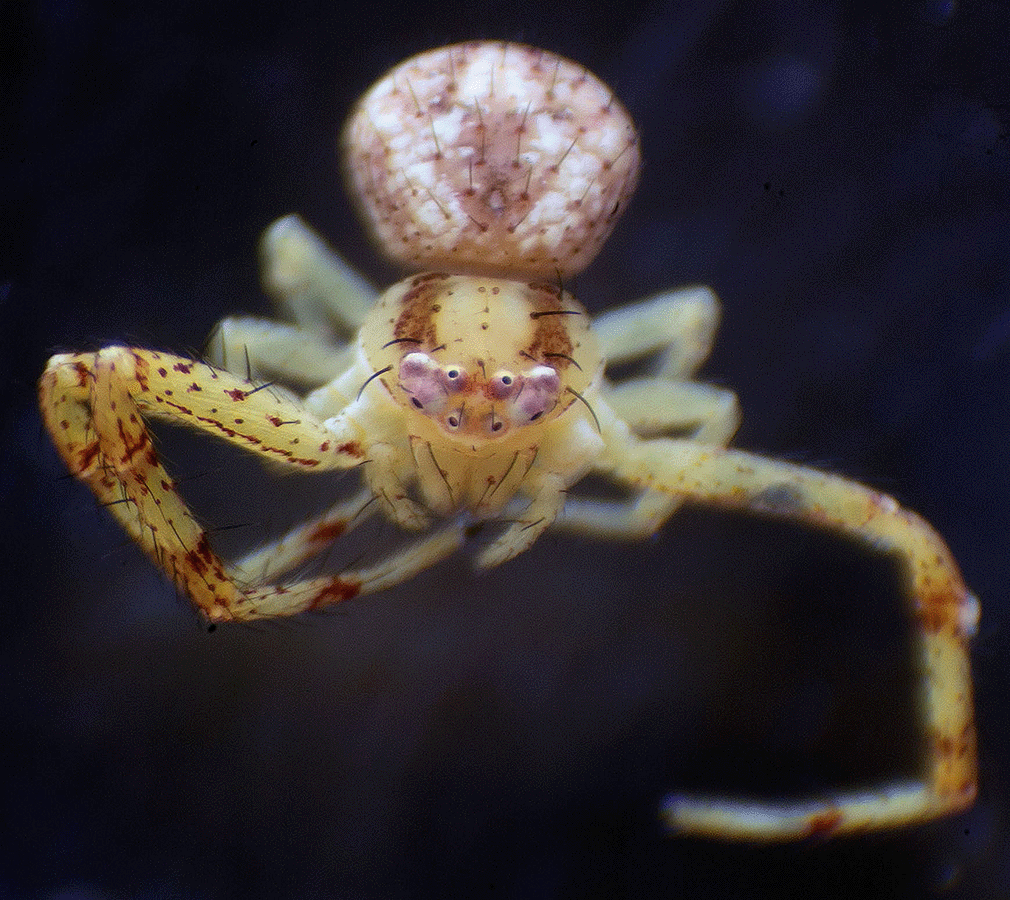
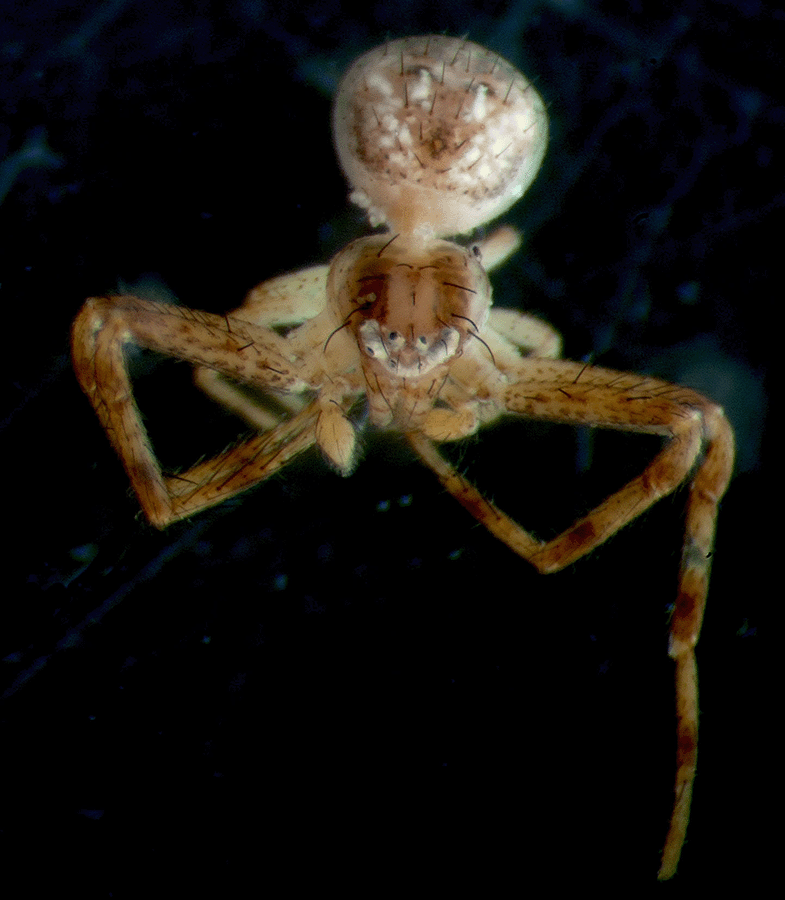
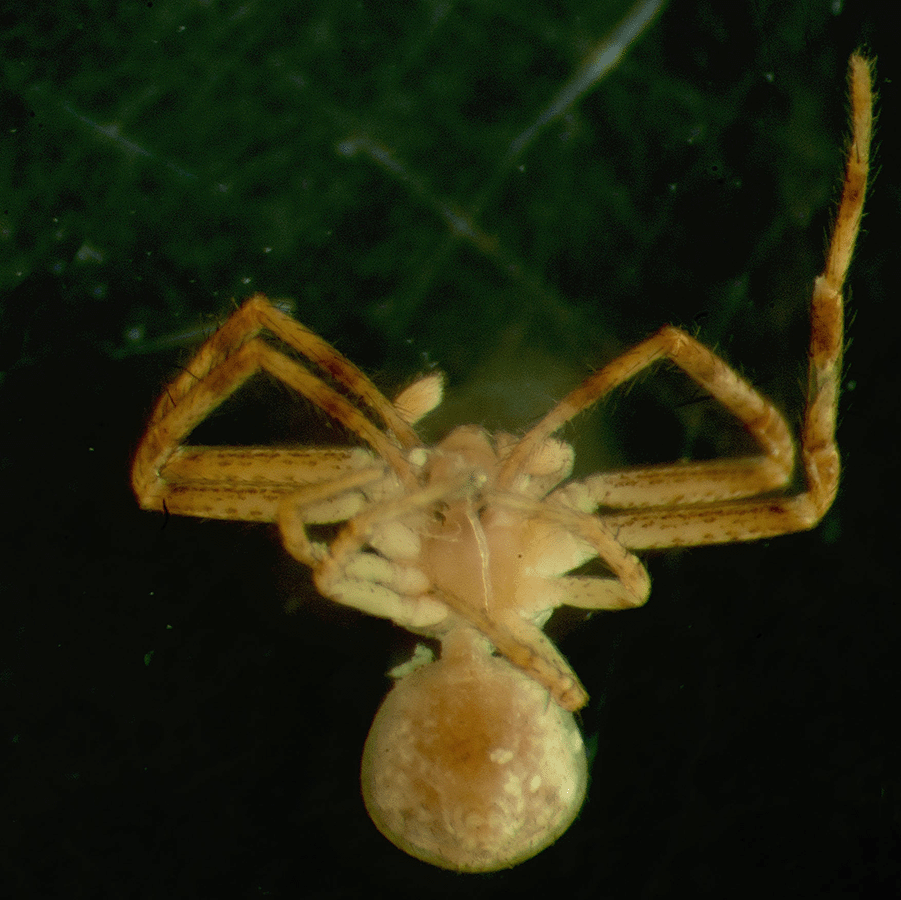
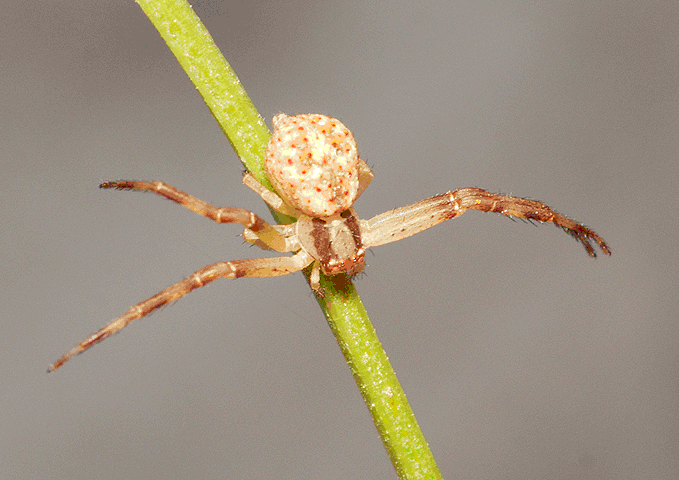
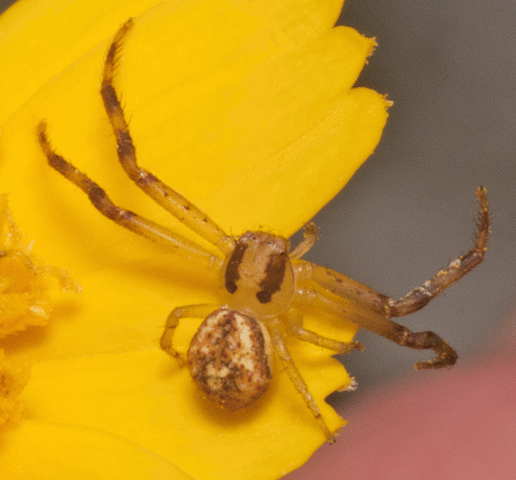 They do not spin webs to capture food, instead they use camouflage to ambush prey and hide from predators. A flower crab spider captures insects by grabbing them with powerful front legs and then paralyzing them with a venomous bite.
They do not spin webs to capture food, instead they use camouflage to ambush prey and hide from predators. A flower crab spider captures insects by grabbing them with powerful front legs and then paralyzing them with a venomous bite. 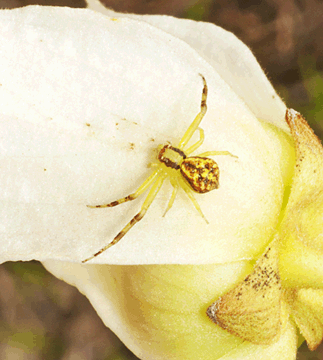
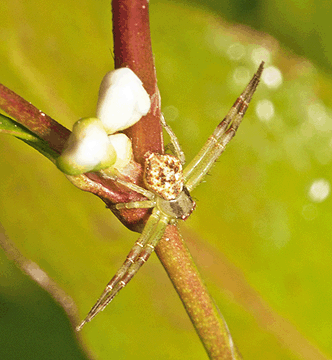
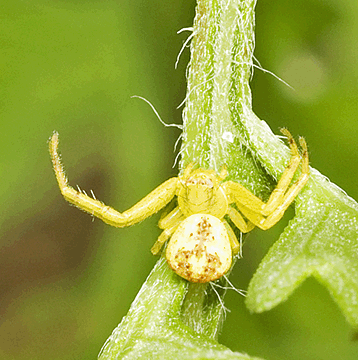
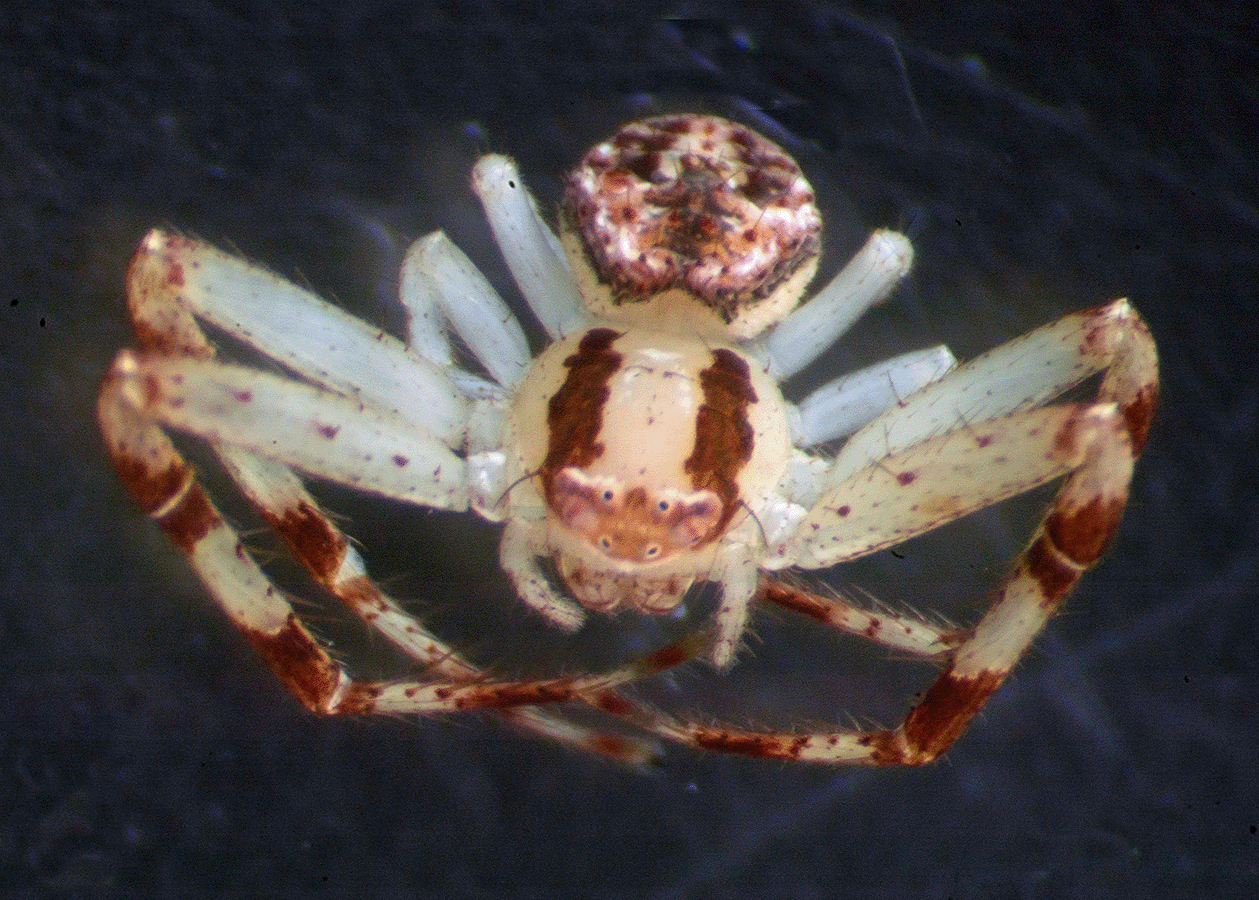

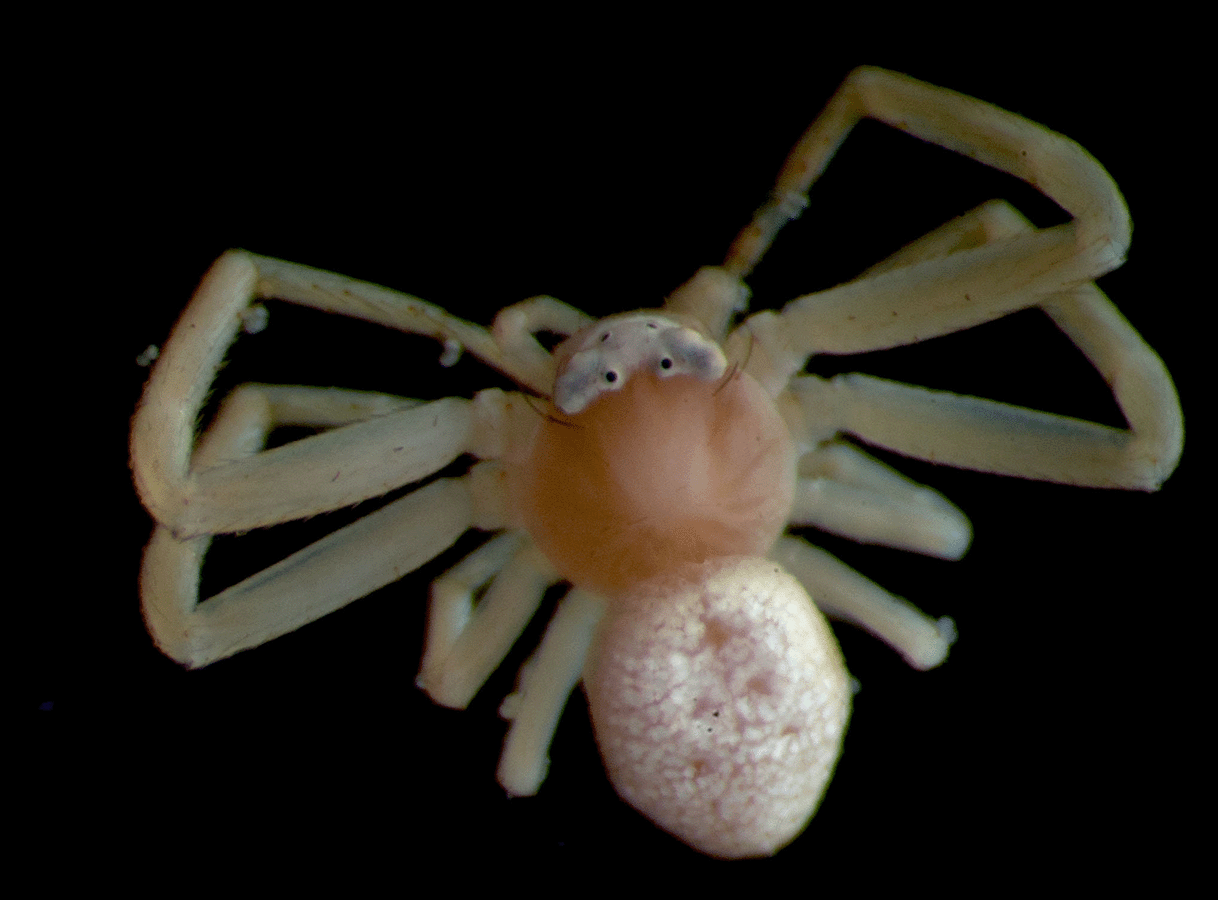
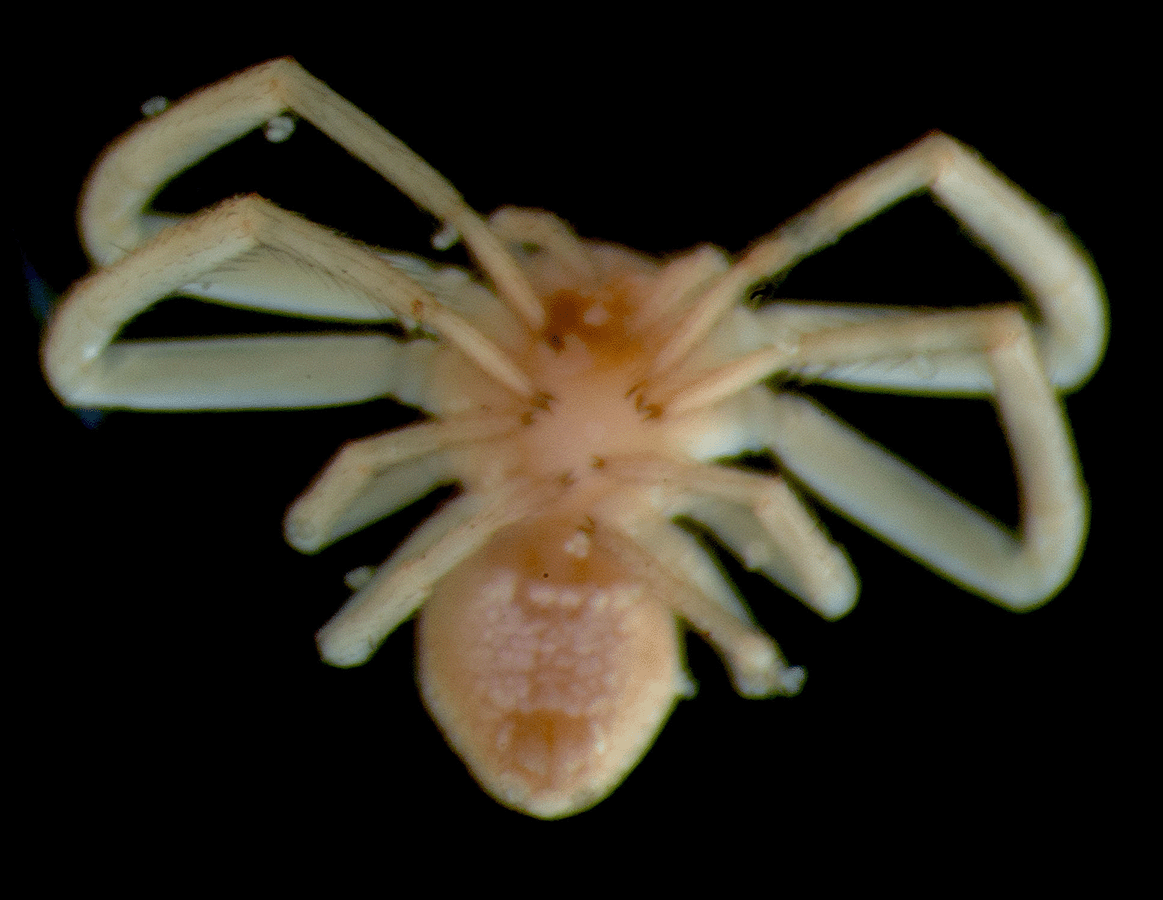
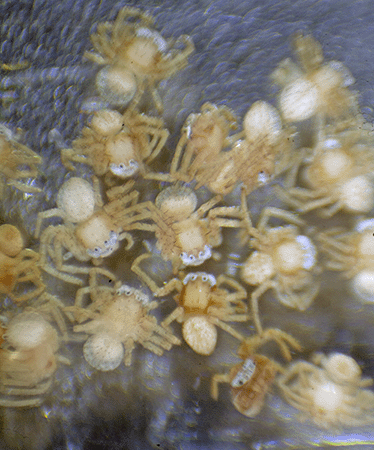
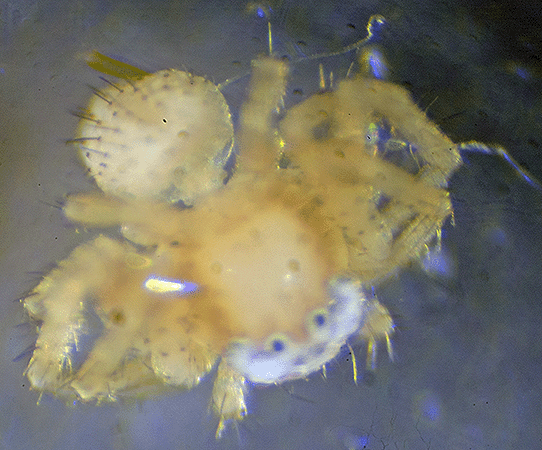
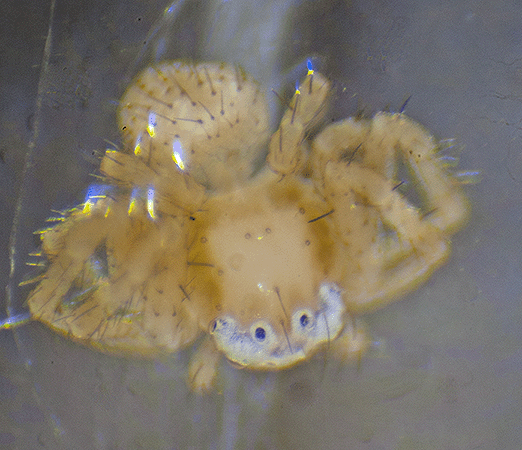
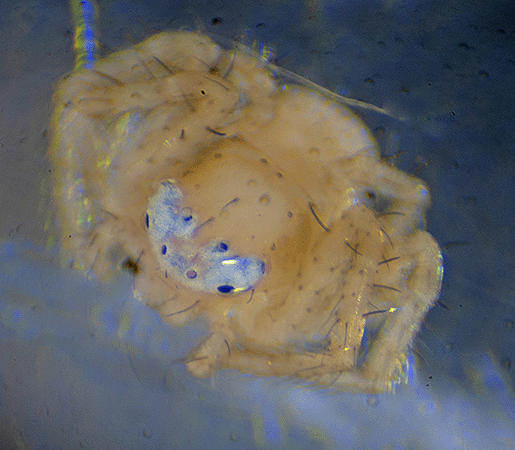
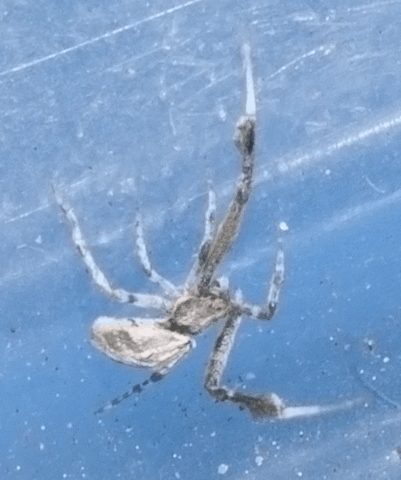 Uloborus glomosus is one of the 72 described species in the Family Uloboridae. Most members of this family live in the tropics and subtropics. Only four genera and 15 species live in the United States and Canada.
Uloborus glomosus is one of the 72 described species in the Family Uloboridae. Most members of this family live in the tropics and subtropics. Only four genera and 15 species live in the United States and Canada. 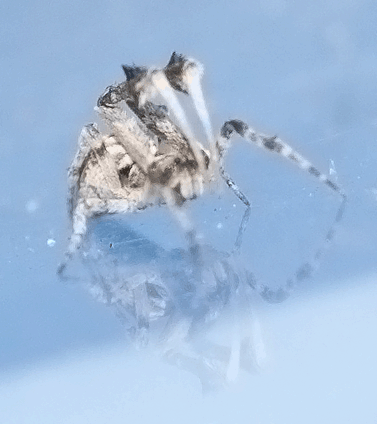 Members of the family are known as hackled-band orbweavers. They create webs in the form or orbs or portions of orbs, with the spiral portion of the web constructed of an unusual type of silk thread called a "hackled band." Members of the genus Uloborus create their orb webs with a horizontal orientation.
Members of the family are known as hackled-band orbweavers. They create webs in the form or orbs or portions of orbs, with the spiral portion of the web constructed of an unusual type of silk thread called a "hackled band." Members of the genus Uloborus create their orb webs with a horizontal orientation. 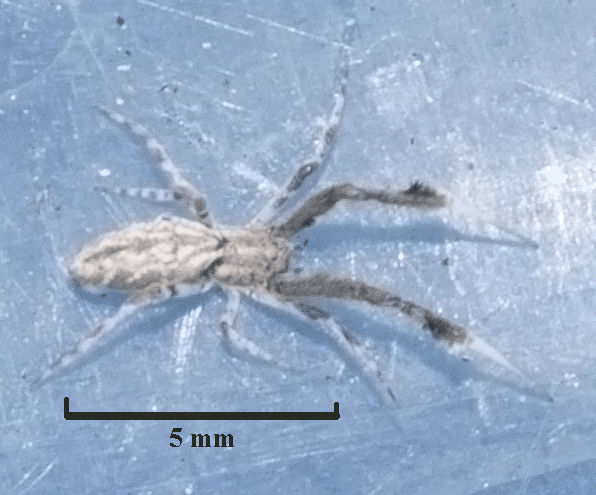 The common name of this spider, "feather-legged spider," describes the long tuft of hairs on the first set of legs.
The common name of this spider, "feather-legged spider," describes the long tuft of hairs on the first set of legs.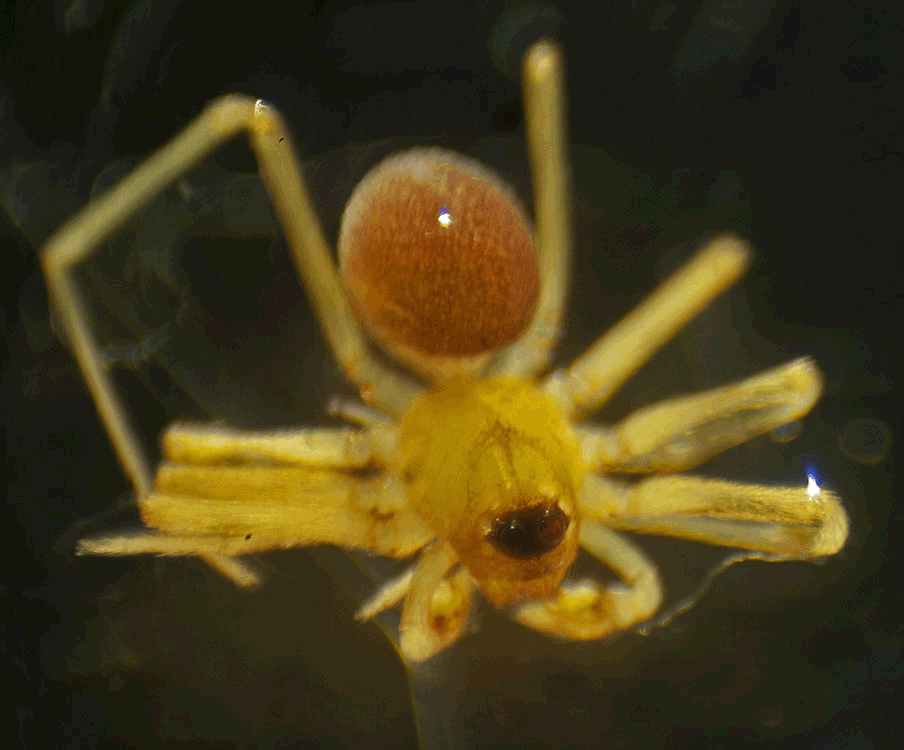
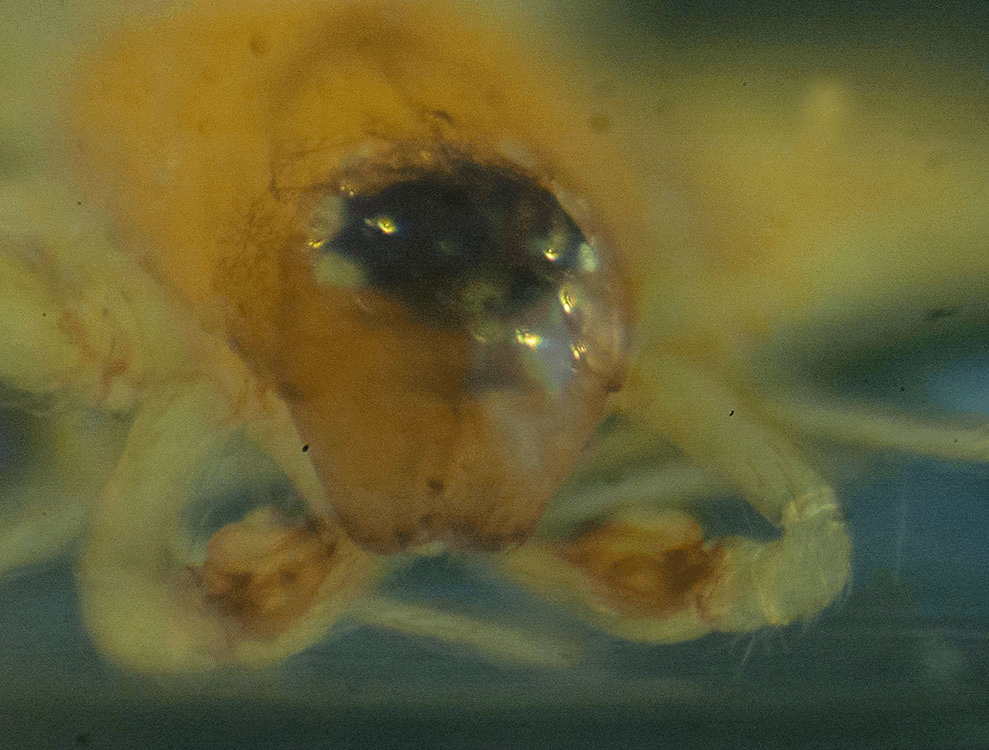
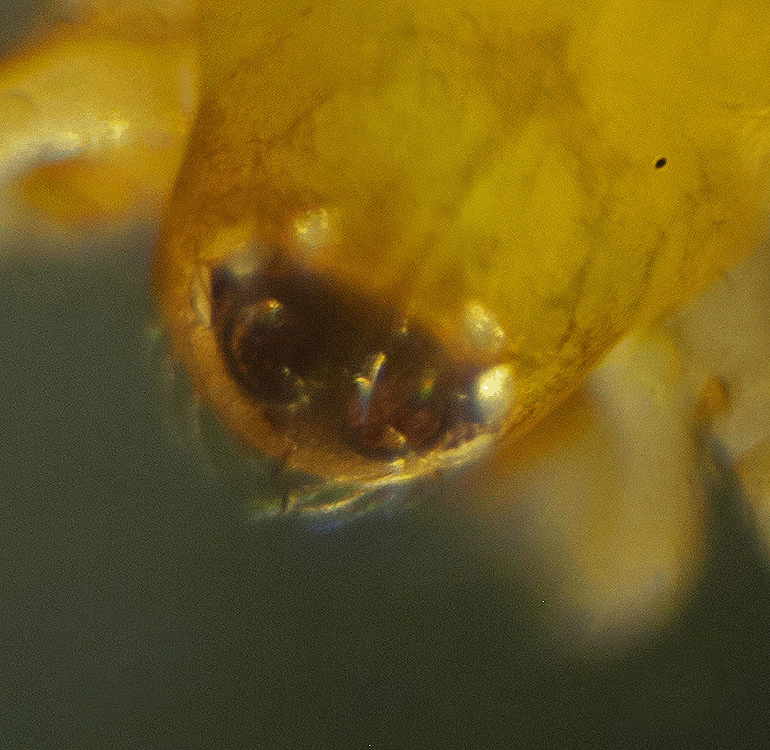
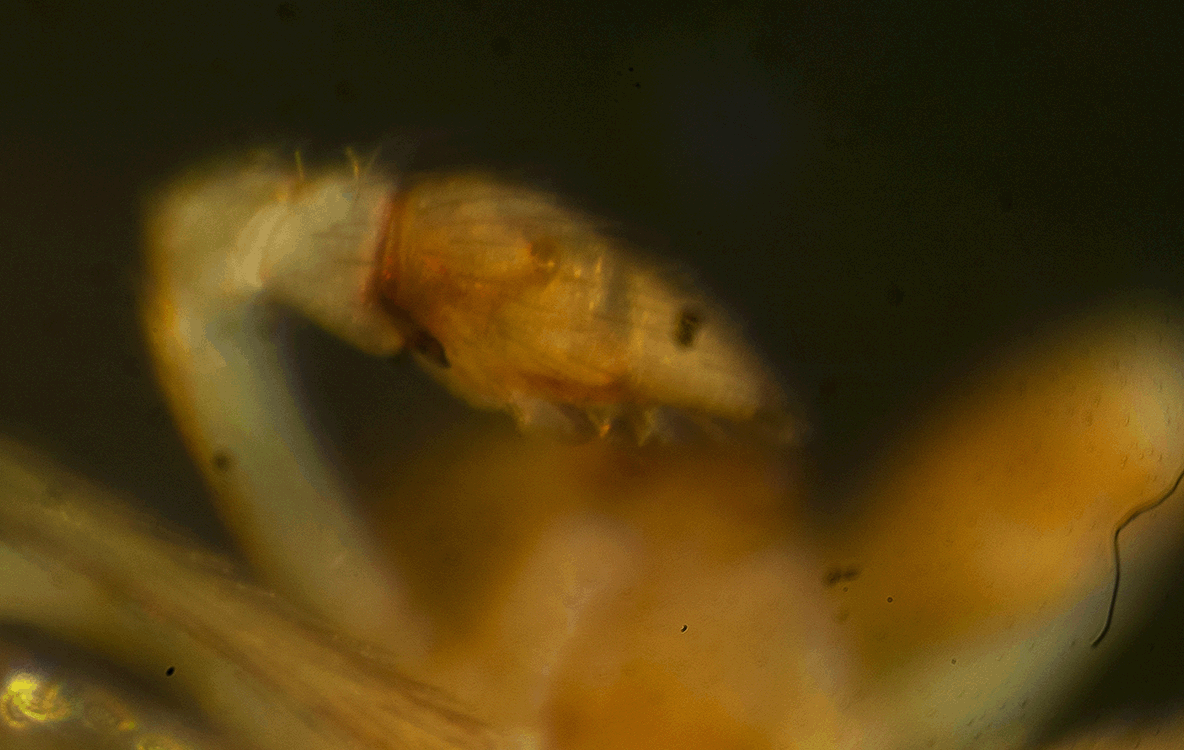
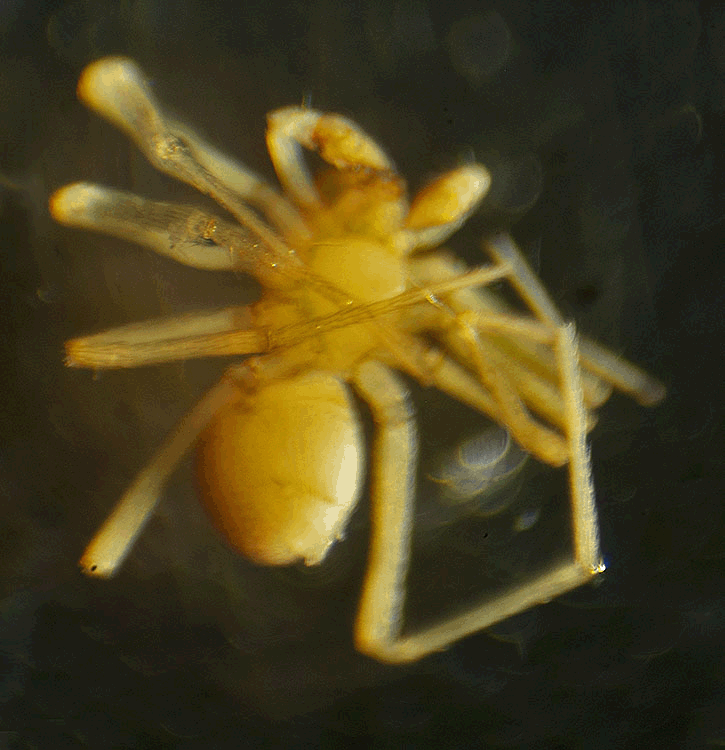
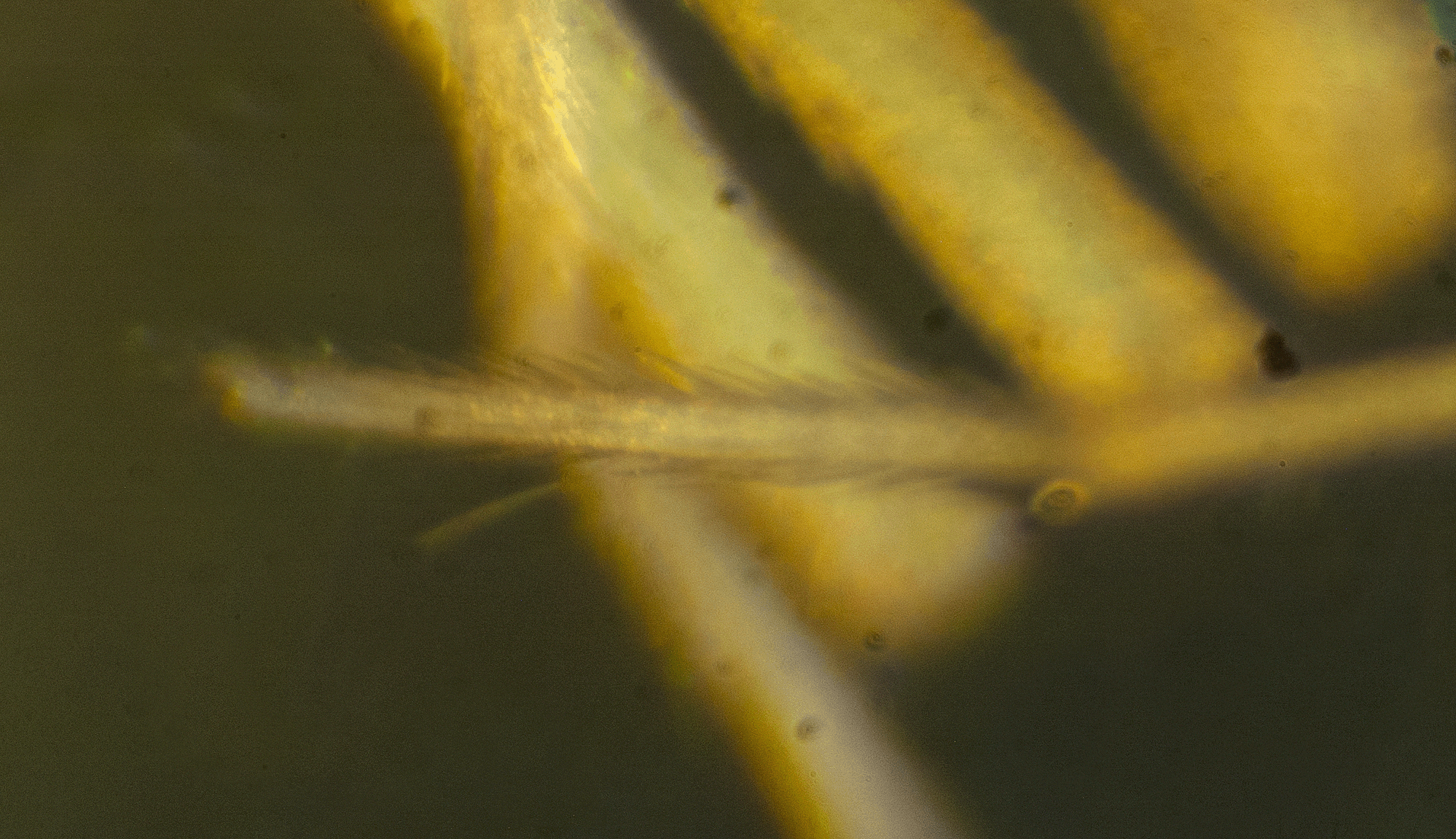
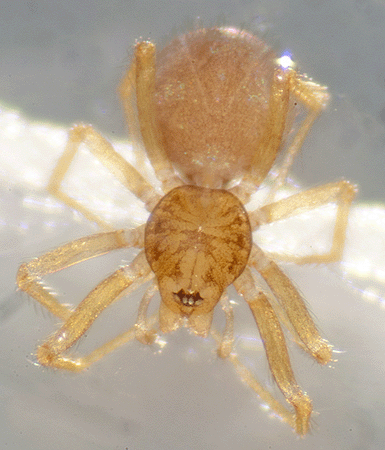 On March 4, 2015, this1 mm long, 6-eyed spider was living in leaf litter beneath a
On March 4, 2015, this1 mm long, 6-eyed spider was living in leaf litter beneath a 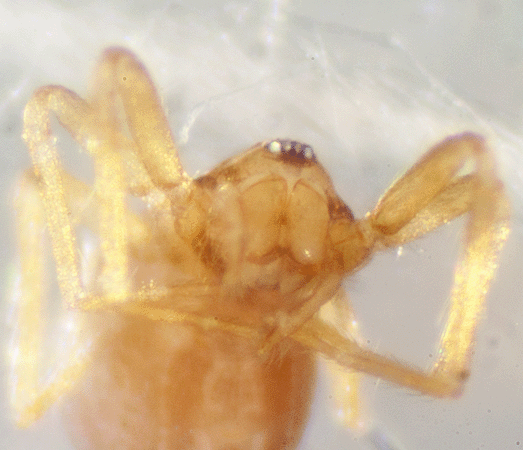
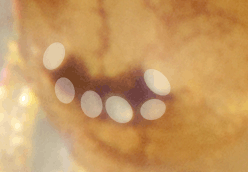
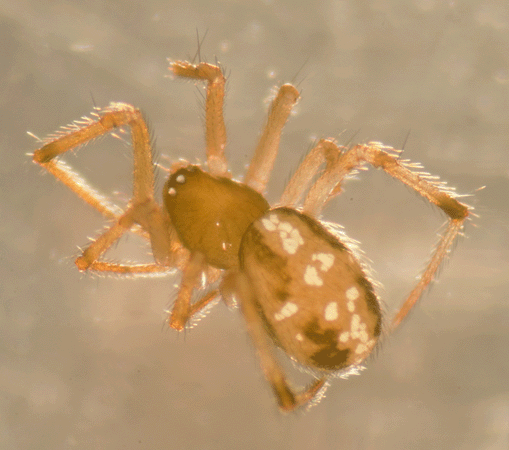 On December 19, 2014, this 1.5 mm long, 8-eyed spider was living in leaf litter under a citrus tree in the hammock in the northeast corner of the Smith Preserve.
On December 19, 2014, this 1.5 mm long, 8-eyed spider was living in leaf litter under a citrus tree in the hammock in the northeast corner of the Smith Preserve. 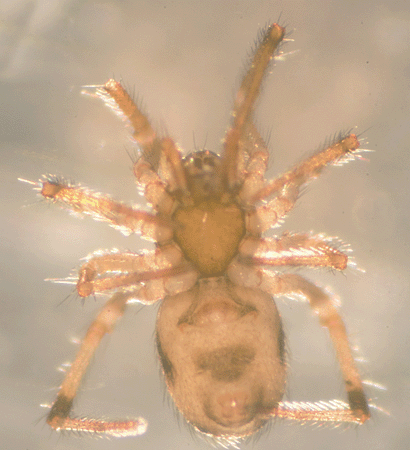


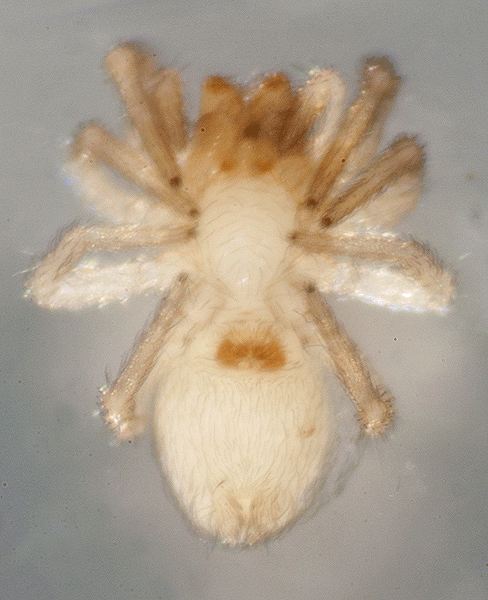
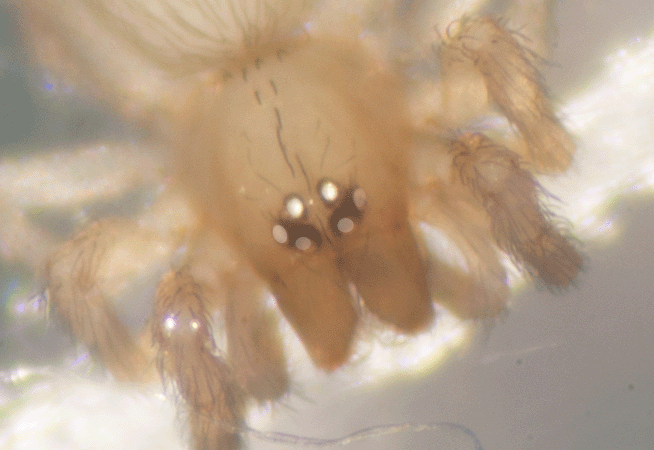 Note: this spider has 6 eyes. The eyes have been enhanced by the webmaster by using Photoshop layers.
Note: this spider has 6 eyes. The eyes have been enhanced by the webmaster by using Photoshop layers.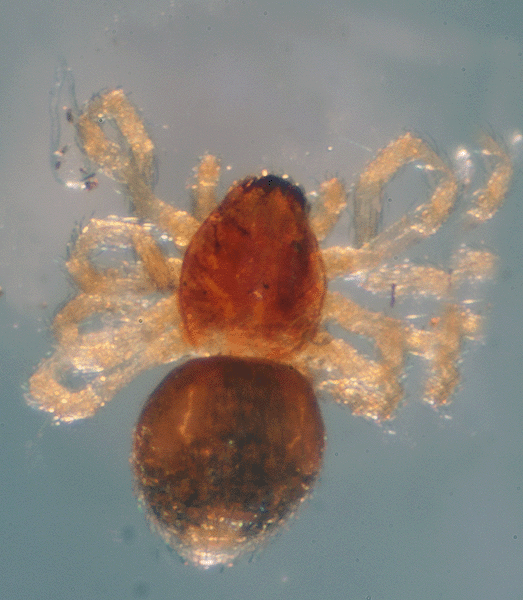
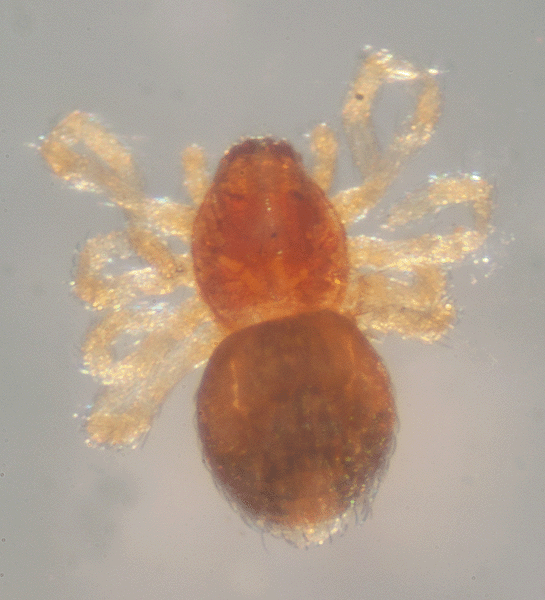
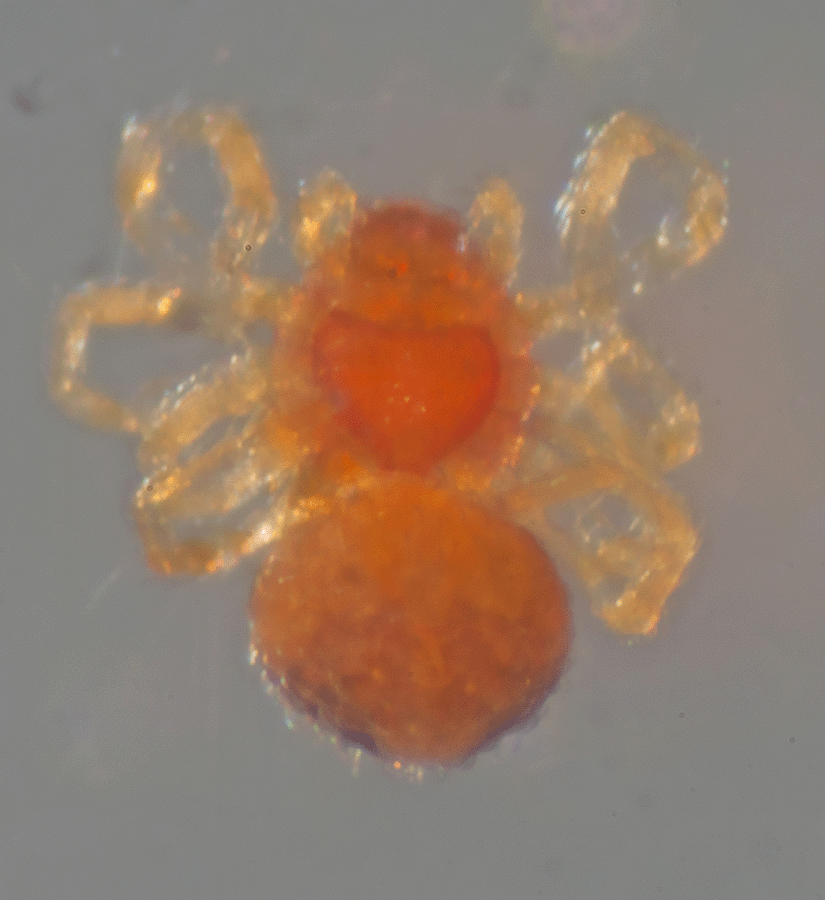
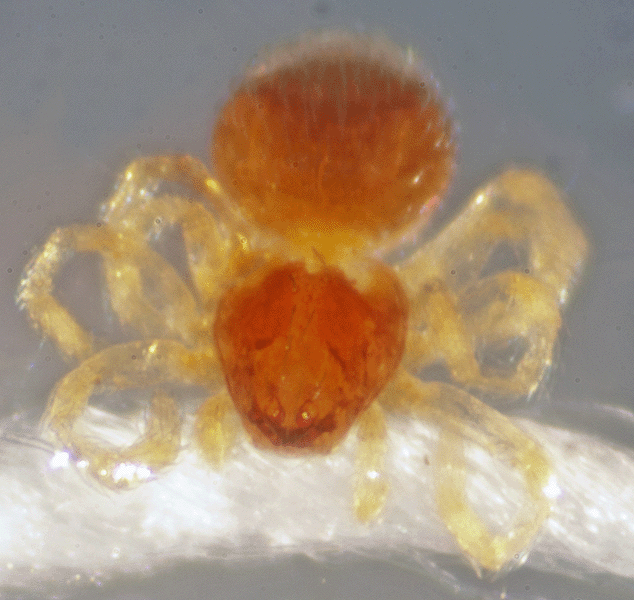
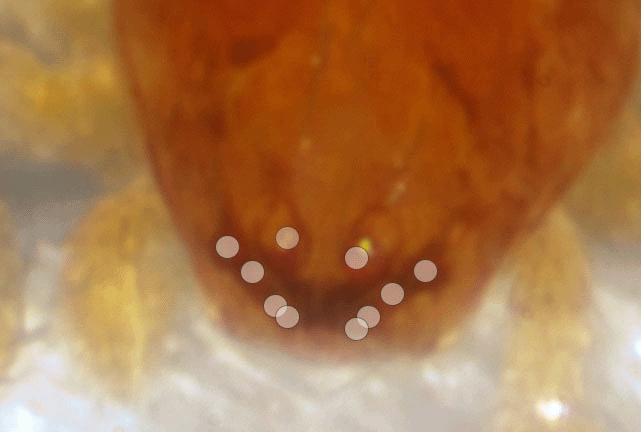
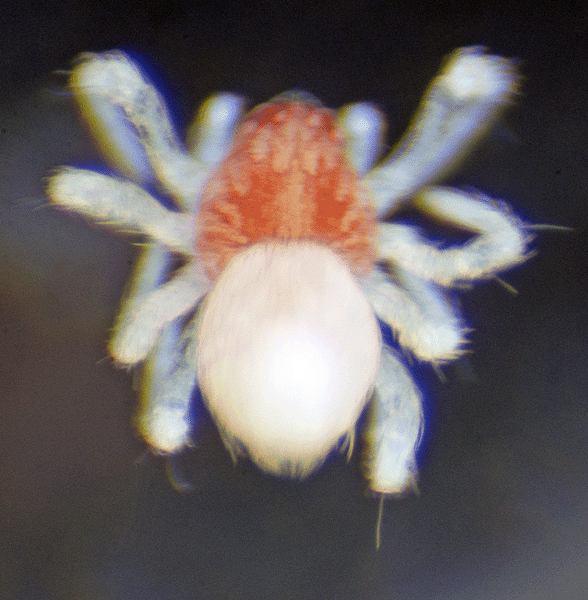
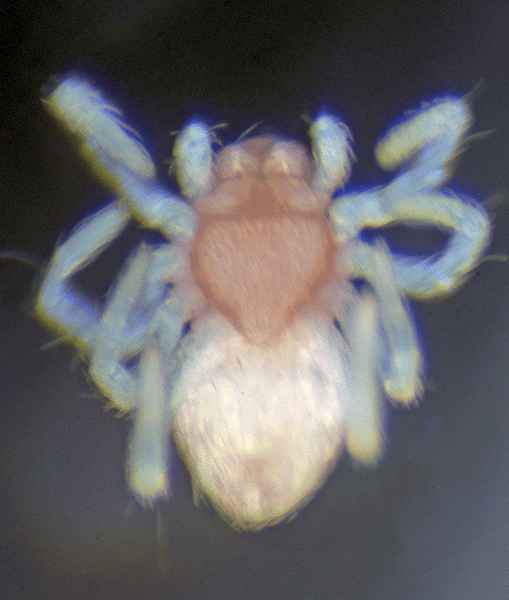
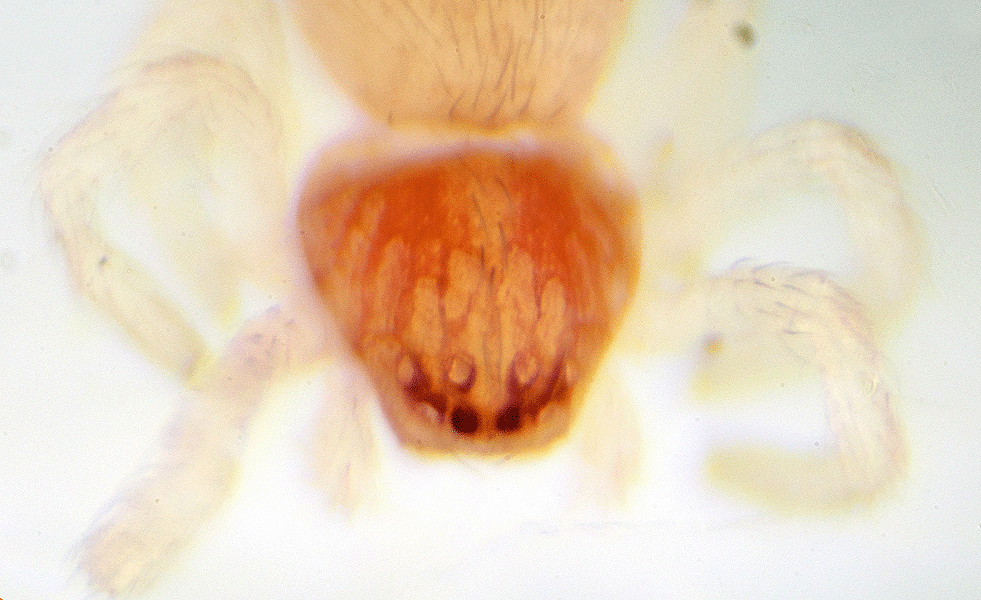
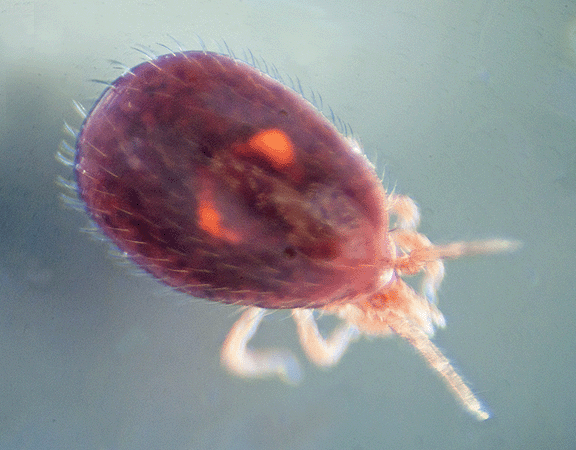 On January 17, 2019, this 1.5 mm long, mite was living in palmetto fibers found on the ground by one of the science volunteers, working near the center of Smith Preserve just north of Smith Preserve Way.
On January 17, 2019, this 1.5 mm long, mite was living in palmetto fibers found on the ground by one of the science volunteers, working near the center of Smith Preserve just north of Smith Preserve Way. 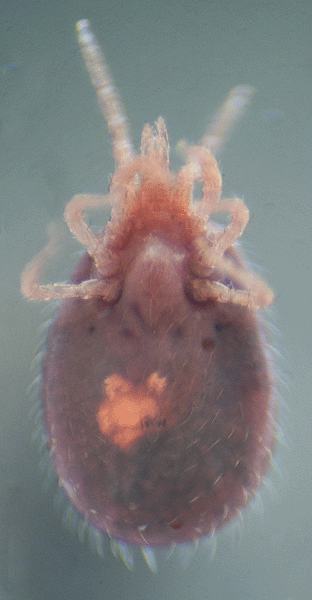 On January 29, 2019, the genus was identified by Ray Fisher, a Contributing Editor to <BugGuide.net>, as being either Dermanyssus or Ornithonyssus. Both genera are fowl mites, which are ectoparasites of birds.
On January 29, 2019, the genus was identified by Ray Fisher, a Contributing Editor to <BugGuide.net>, as being either Dermanyssus or Ornithonyssus. Both genera are fowl mites, which are ectoparasites of birds. 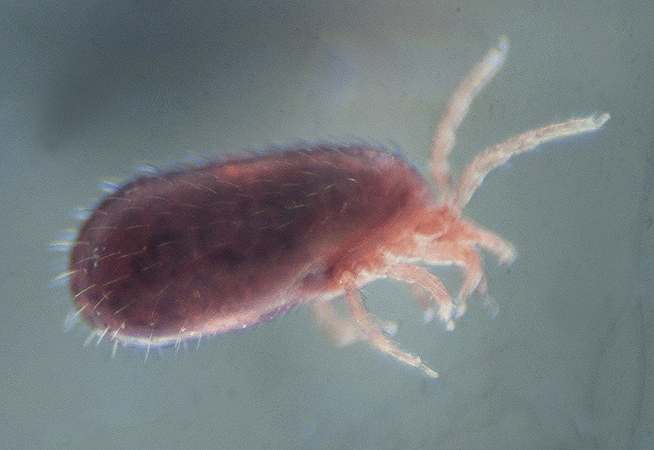
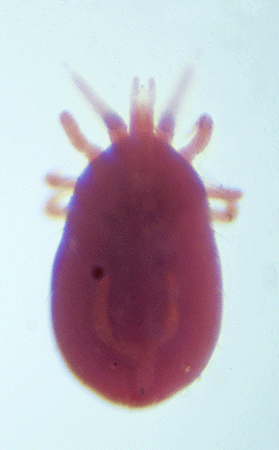
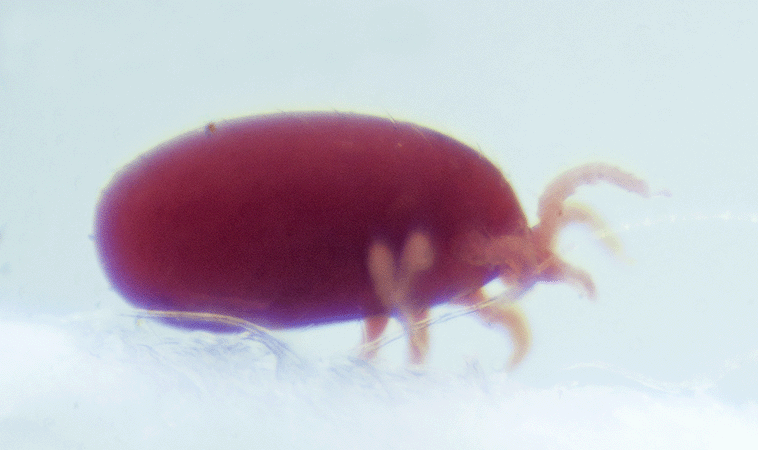
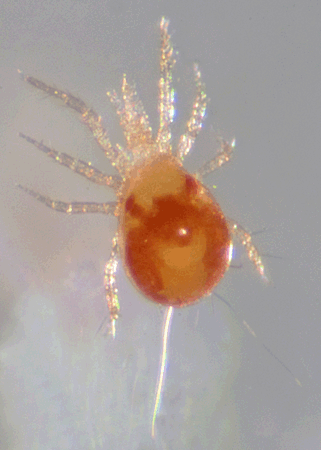 This very colorful .5 mm long mite was living in leaf litter, collected under a citrus tree on December 19, 2014 in a hammock in the northeast corner of the Smith Preserve.
This very colorful .5 mm long mite was living in leaf litter, collected under a citrus tree on December 19, 2014 in a hammock in the northeast corner of the Smith Preserve. 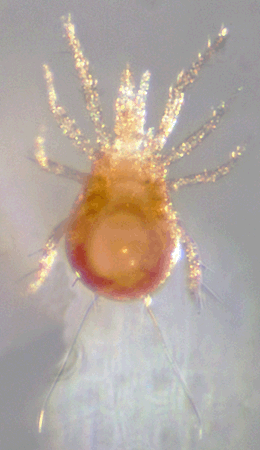 On January 31, 2015, the mite was identified from these photographs by Heather Proctor, a Contributor to <BugGuide.net>, sponsored by Iowa State University Department of Entomology. She stated it is "a predatory mite of Family Phytoseiidae (Mesostigmata), a group best known as biocontrol agents of spider mites. It's a bit odd that it was found on the ground, but perhaps it fell out of the citrus tree."
On January 31, 2015, the mite was identified from these photographs by Heather Proctor, a Contributor to <BugGuide.net>, sponsored by Iowa State University Department of Entomology. She stated it is "a predatory mite of Family Phytoseiidae (Mesostigmata), a group best known as biocontrol agents of spider mites. It's a bit odd that it was found on the ground, but perhaps it fell out of the citrus tree."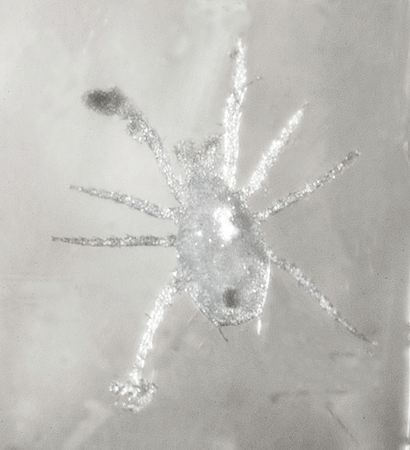 On February 11, 2015, this .5 mm mite was crawling on a leaf of
On February 11, 2015, this .5 mm mite was crawling on a leaf of 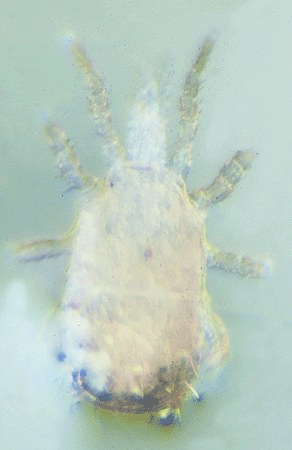
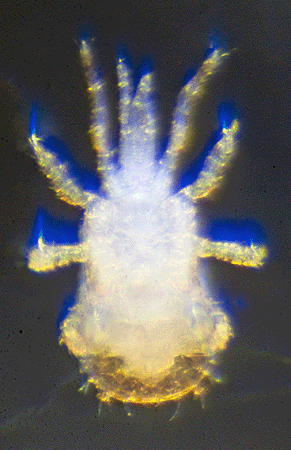
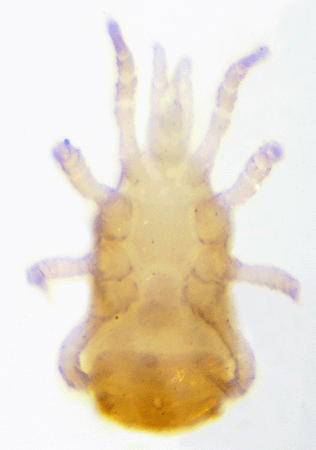
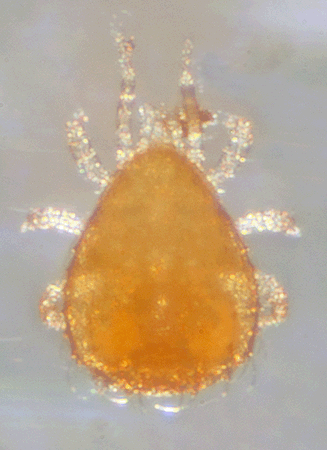
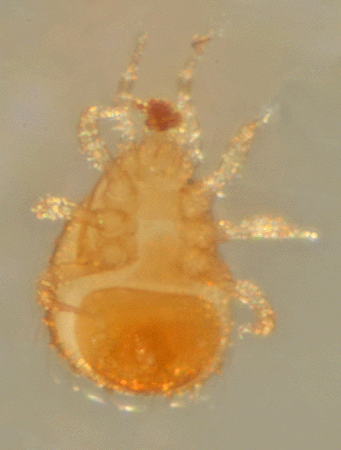 On December 29, 2014, this .5 mm long mite was living in pine needle litter beneath a
On December 29, 2014, this .5 mm long mite was living in pine needle litter beneath a 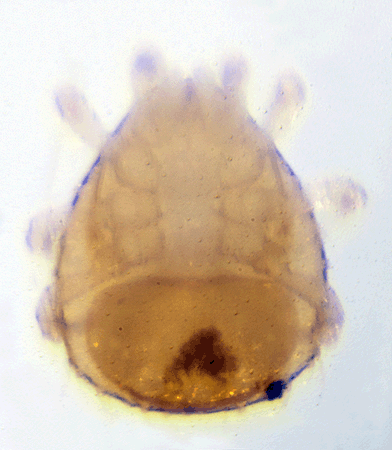
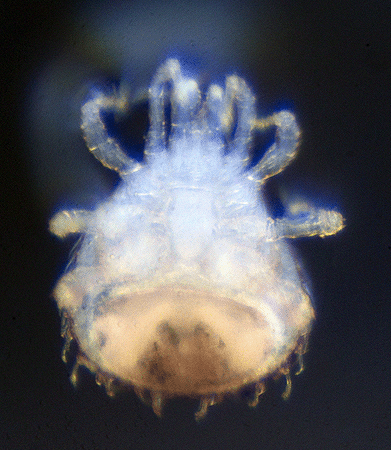 On November 15, 2016, this ~.5 mm mite was living in leaf litter beneath a severely trimmed
On November 15, 2016, this ~.5 mm mite was living in leaf litter beneath a severely trimmed 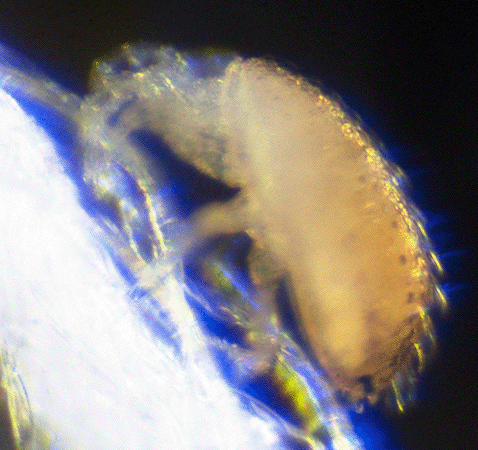 This individual is similar looking to the one above which belongs to the same family, but this one seems to have a wider posterior end (ie. the shape is slightly different).
This individual is similar looking to the one above which belongs to the same family, but this one seems to have a wider posterior end (ie. the shape is slightly different).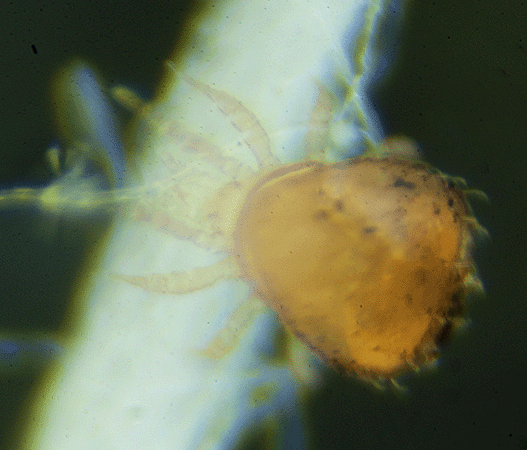

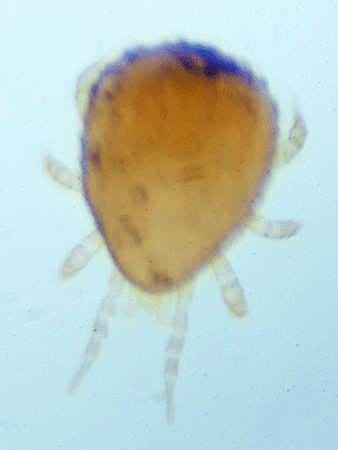
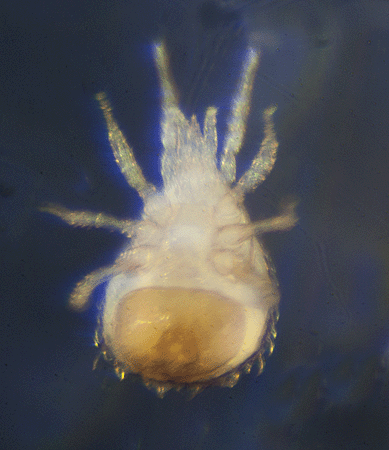
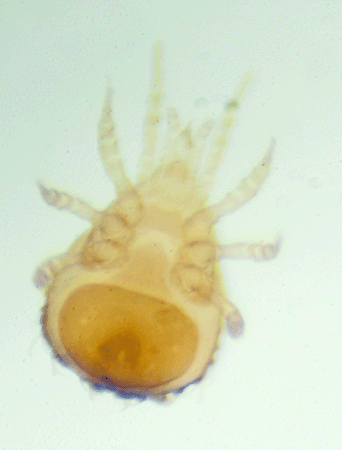
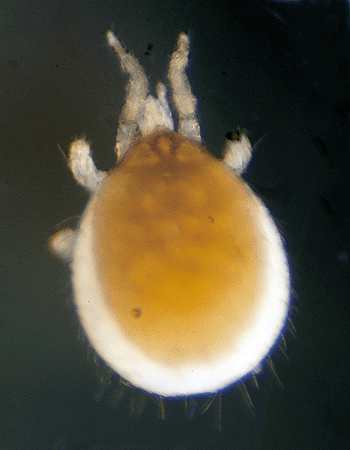
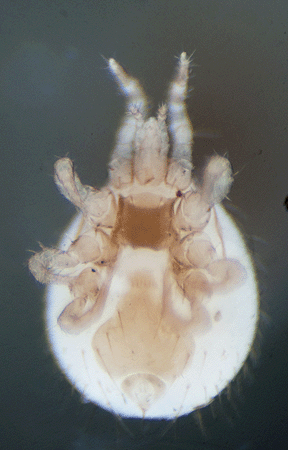
 These four images [(1) dorsal, (2) ventral, (3) lateral, and (4) dorsolateral] were sent for identification to <BugGuide.net>, sponsored by Iowa State University's Department of Entomology.
These four images [(1) dorsal, (2) ventral, (3) lateral, and (4) dorsolateral] were sent for identification to <BugGuide.net>, sponsored by Iowa State University's Department of Entomology. 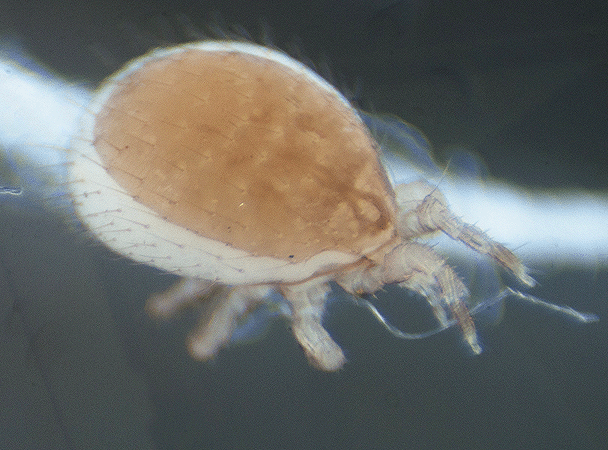 Mesostigmata is an order of mites belonging to the Super Order Parasitiformes. There are at least 11,000 species in this super order. The body of these mites is usually hardened with the 1st pair of legs having sensory organs.
Mesostigmata is an order of mites belonging to the Super Order Parasitiformes. There are at least 11,000 species in this super order. The body of these mites is usually hardened with the 1st pair of legs having sensory organs. 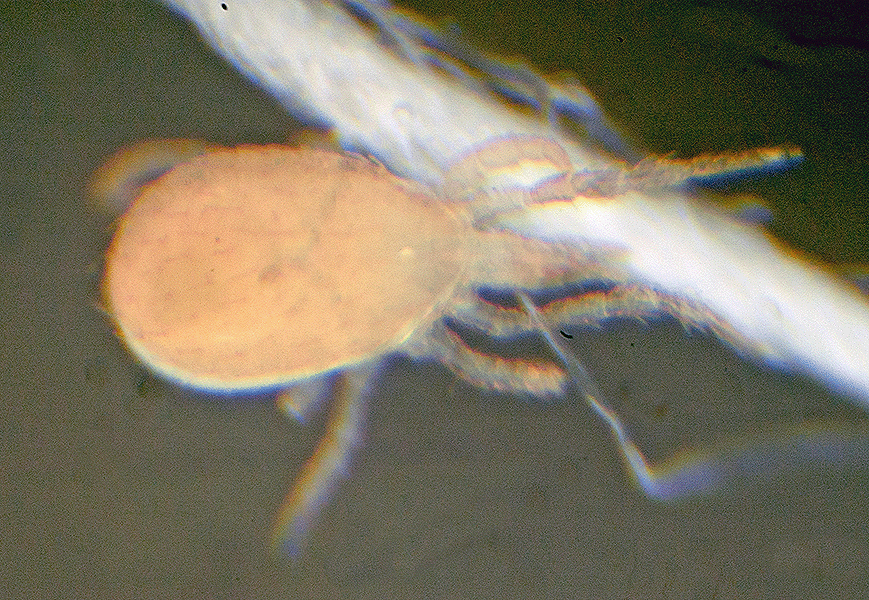
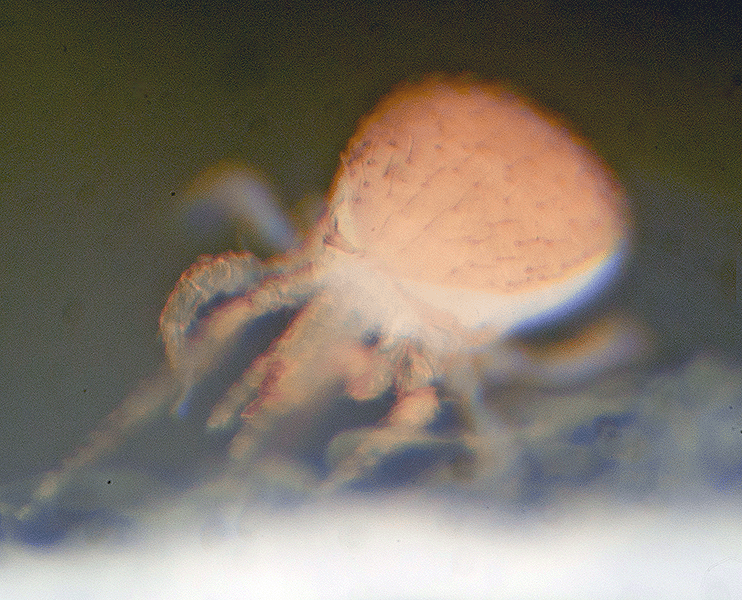
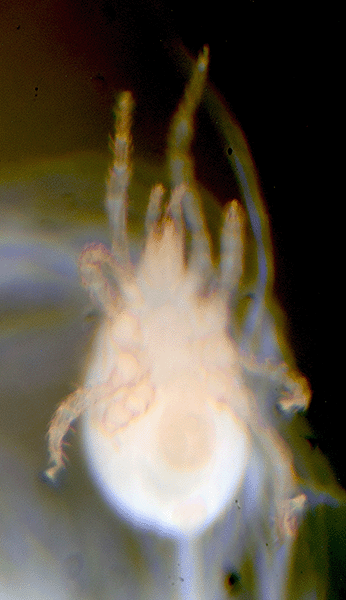 These images were created using photomicroscopy and sent for identification to <Bugguide.net>, sponsored by Iowa State University's Department of Entomology. To date the mite has not been identified.
These images were created using photomicroscopy and sent for identification to <Bugguide.net>, sponsored by Iowa State University's Department of Entomology. To date the mite has not been identified. 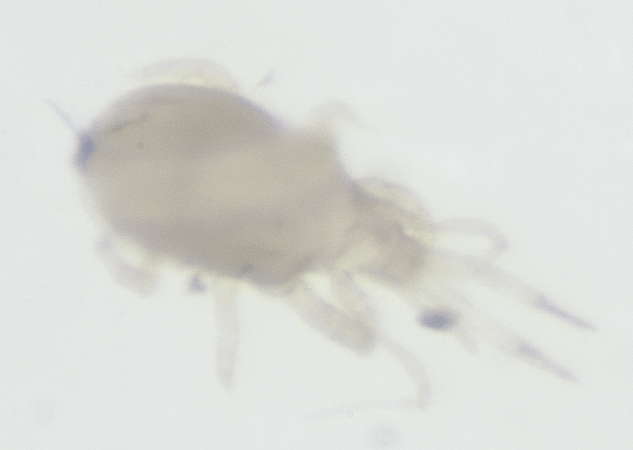 On December 9, 2015. this 1 mm long, pale, white mite was collected in pine needles in the southeastern corner of the Smith Preserve below a
On December 9, 2015. this 1 mm long, pale, white mite was collected in pine needles in the southeastern corner of the Smith Preserve below a 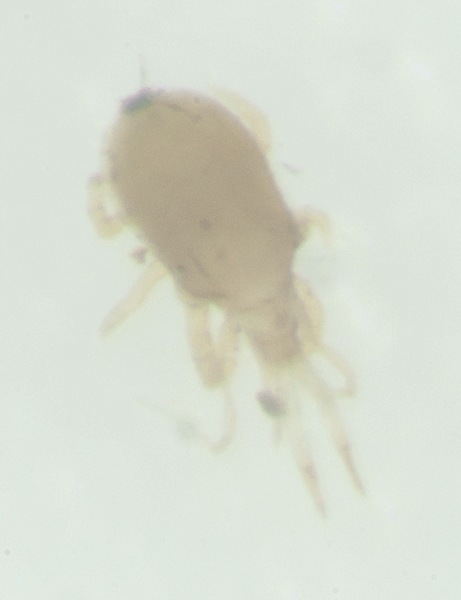 On January 2, 2016, its order was identified by Heather Proctor, a Contributor to <BugGuide.net>. She said that a more focused image of the venter will be necessary to identify the family. The venter is the lower or under side of a mite; opposed to the dorsum.
On January 2, 2016, its order was identified by Heather Proctor, a Contributor to <BugGuide.net>. She said that a more focused image of the venter will be necessary to identify the family. The venter is the lower or under side of a mite; opposed to the dorsum.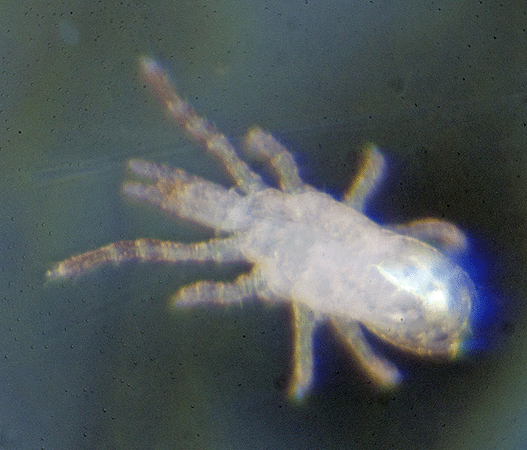
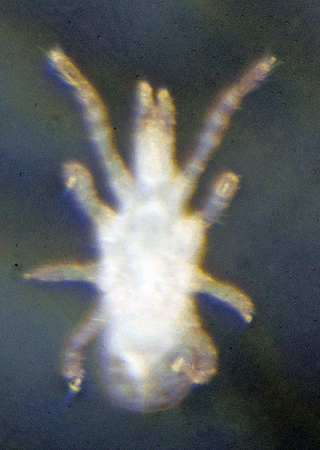 On March 22, 2016, this .4 mm long mite was living in leaf litter beneath a
On March 22, 2016, this .4 mm long mite was living in leaf litter beneath a 
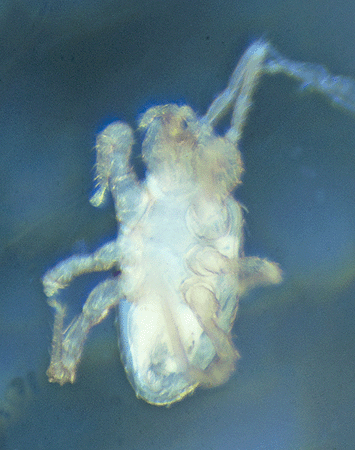
 These photographs (Image 1: Dorsal, Image 2: Ventral, Image 3 Lateral) were created using photomicroscopy and sent for identification to <BugGuide.net>, sponsored by Iowa State University's Department of Entomology.
These photographs (Image 1: Dorsal, Image 2: Ventral, Image 3 Lateral) were created using photomicroscopy and sent for identification to <BugGuide.net>, sponsored by Iowa State University's Department of Entomology. 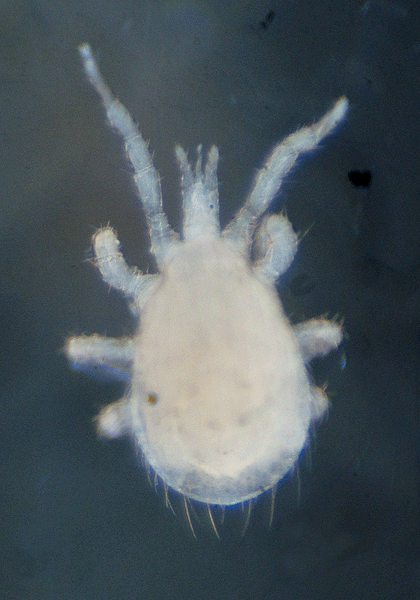
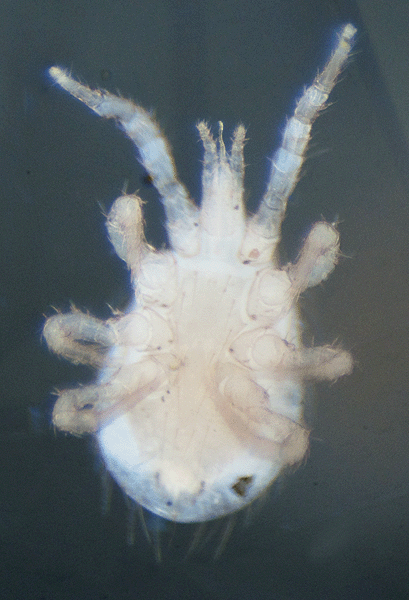
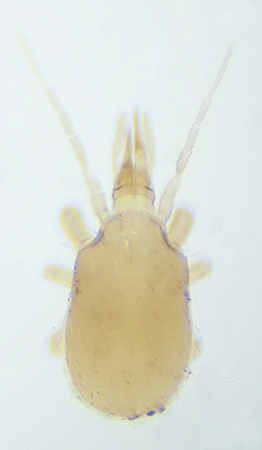
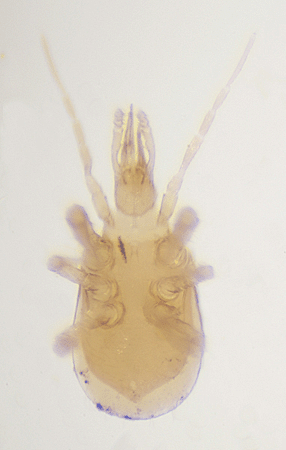
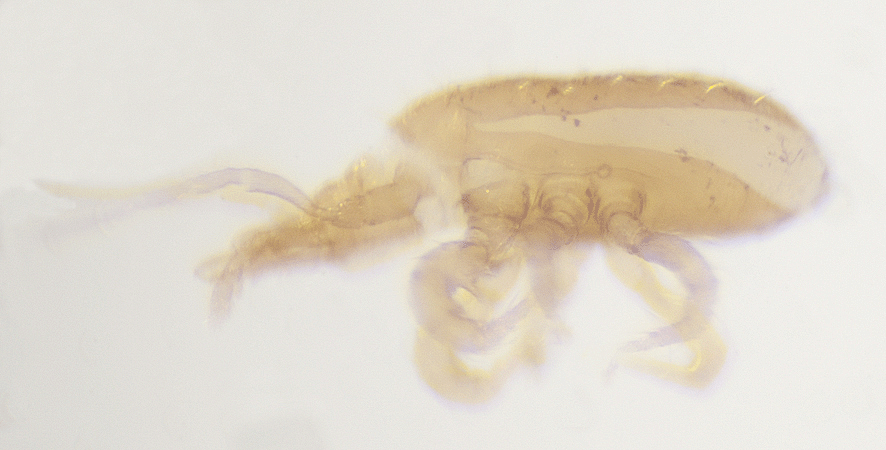 These photographs (Image 1: Dorsal; Image 2: Ventral; Image 3 Lateral) were created using photomicroscopy and sent for identification to <BugGuide.net>, sponsored by Iowa State University's Department of Entomology.
These photographs (Image 1: Dorsal; Image 2: Ventral; Image 3 Lateral) were created using photomicroscopy and sent for identification to <BugGuide.net>, sponsored by Iowa State University's Department of Entomology. 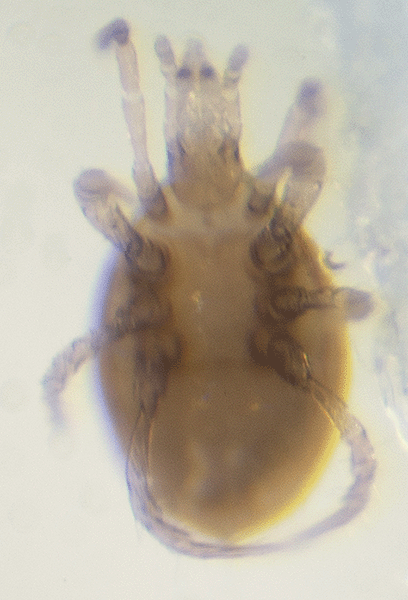
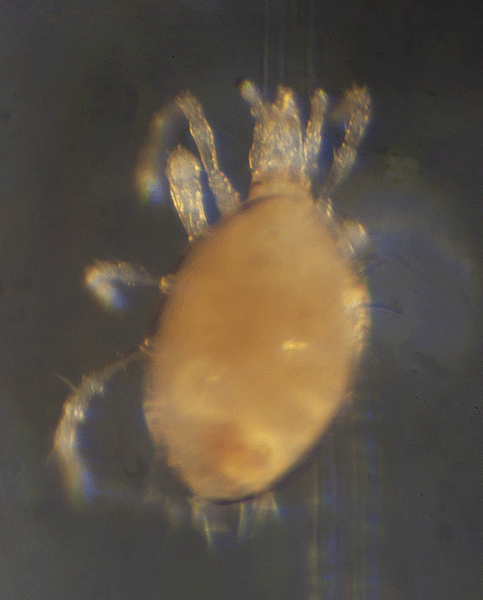
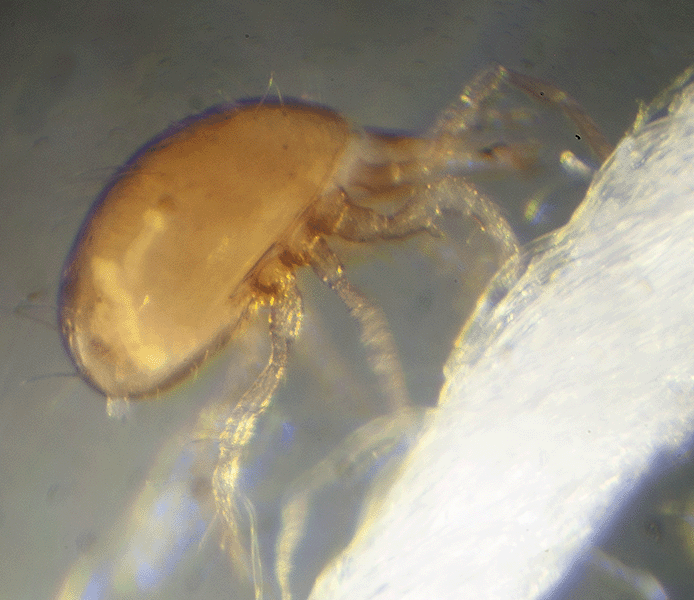
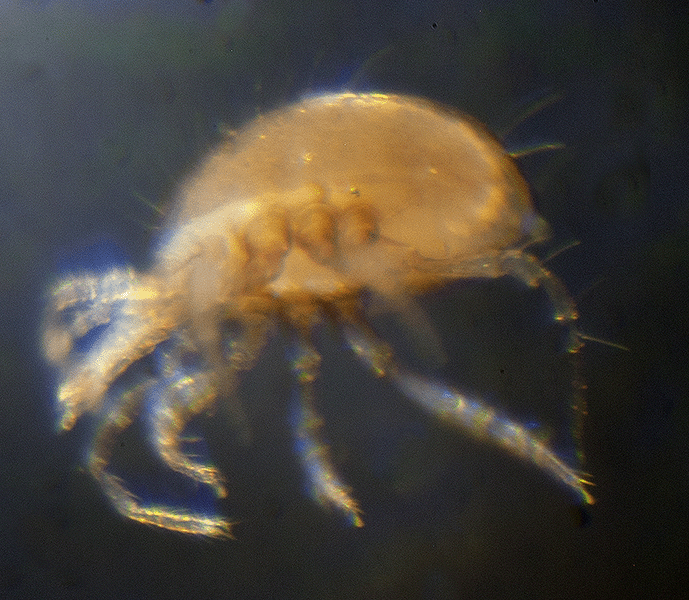
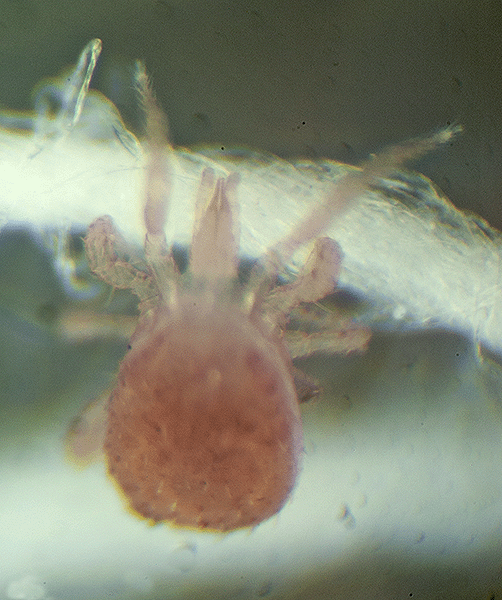
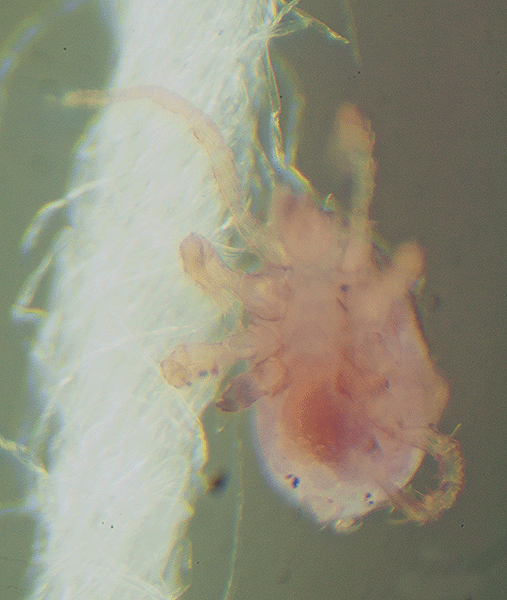
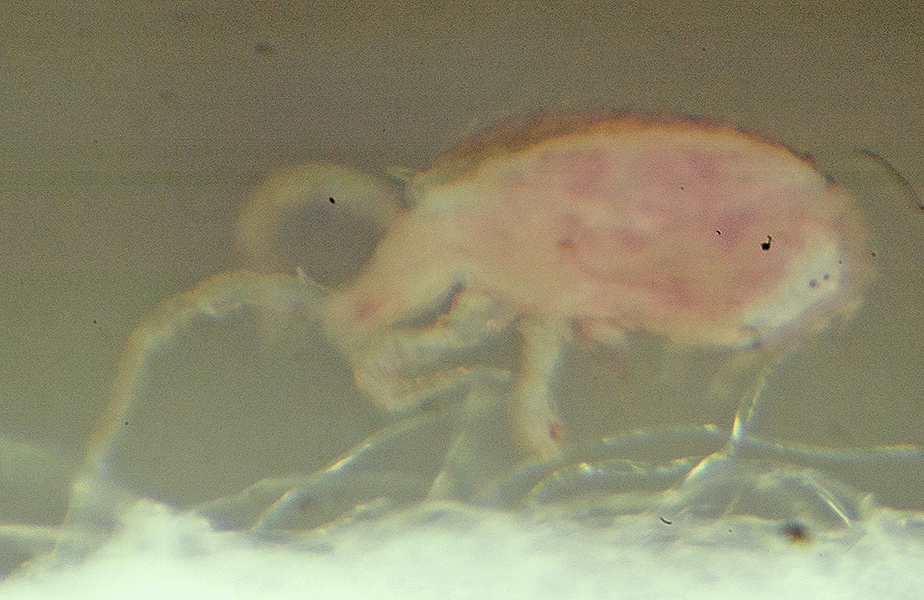
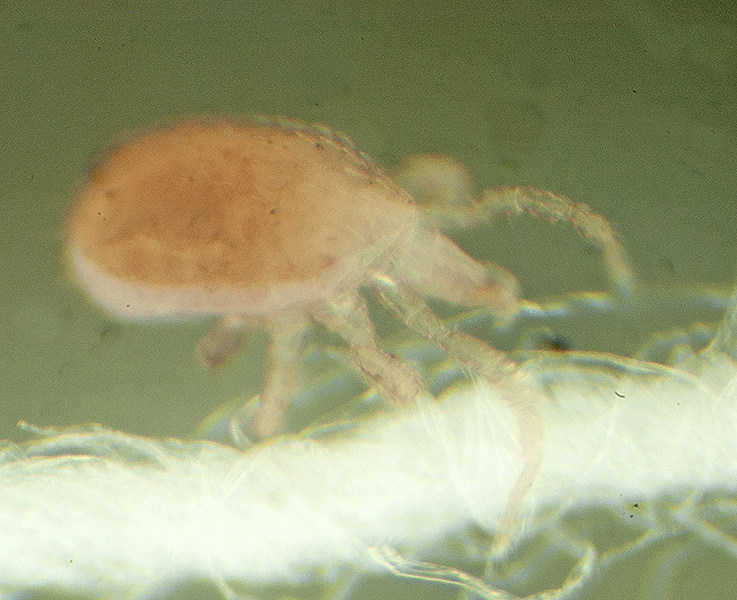
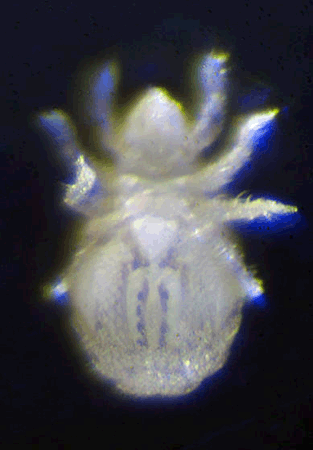
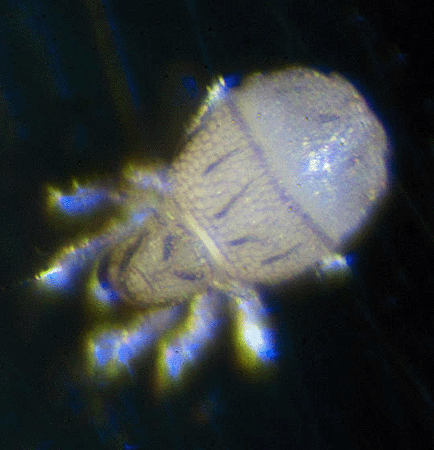
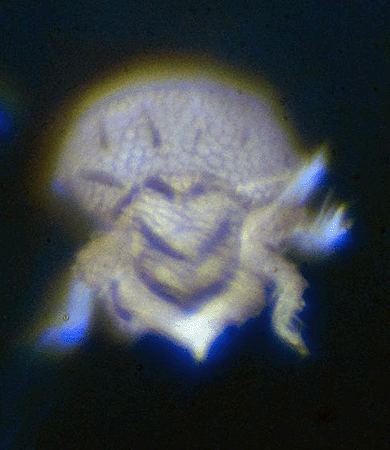 The mite was isolated from the leaf litter using a Berlese funnel and photographs were created using photomicroscopy. These four images were sent for identification to <BugGuide.Net>, sponsored by Iowa State University’s Department of Entomology. On April 18, 2017, the genus was identified by Dave Walter, Editor-in-Chief, International Journal of Acarology.
The mite was isolated from the leaf litter using a Berlese funnel and photographs were created using photomicroscopy. These four images were sent for identification to <BugGuide.Net>, sponsored by Iowa State University’s Department of Entomology. On April 18, 2017, the genus was identified by Dave Walter, Editor-in-Chief, International Journal of Acarology. 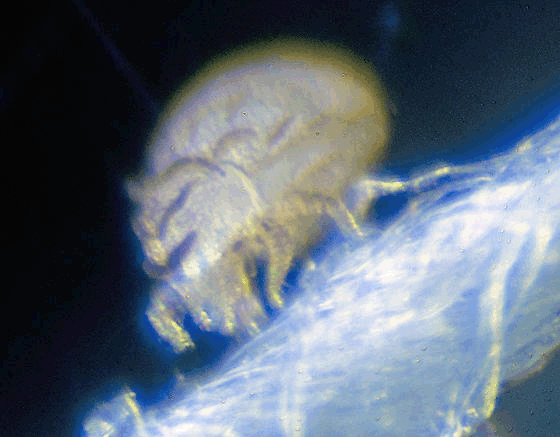 In Dr. Walter’s book, Mites: Ecology, Evolution & Behaviour: Life at a Microscale, he describes the genus as having modified mouthparts and unknown feeding habits.
In Dr. Walter’s book, Mites: Ecology, Evolution & Behaviour: Life at a Microscale, he describes the genus as having modified mouthparts and unknown feeding habits.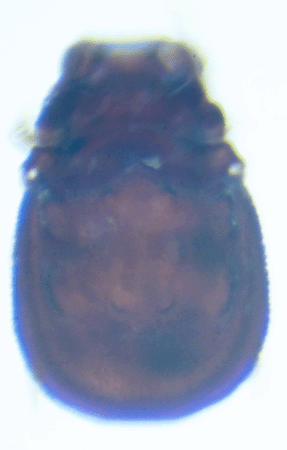
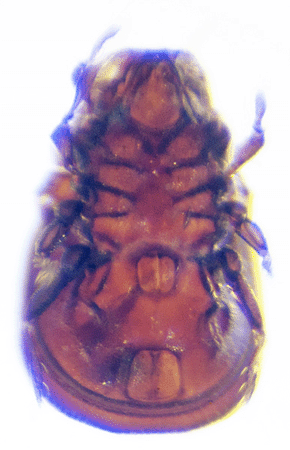
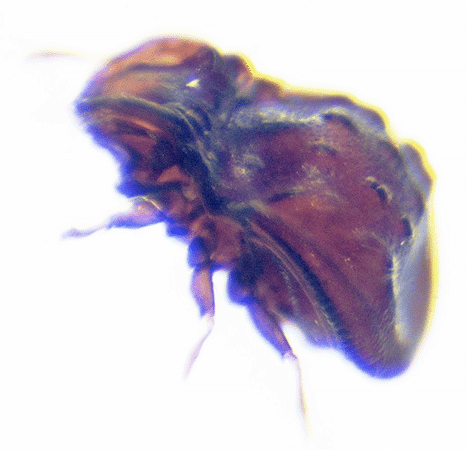 The mite was extracted from the litter, using a Berlese funnel. Photographs were created using photomicroscopy.
The mite was extracted from the litter, using a Berlese funnel. Photographs were created using photomicroscopy. 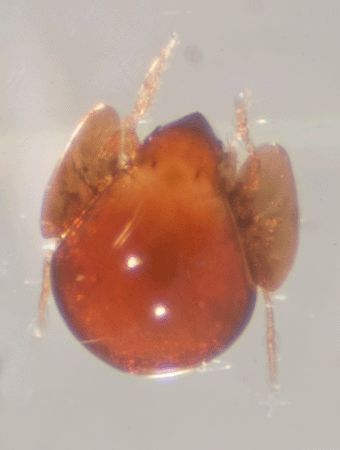 On December 29, 2014, this .5 mm mite was found living in pine litter collected under a
On December 29, 2014, this .5 mm mite was found living in pine litter collected under a 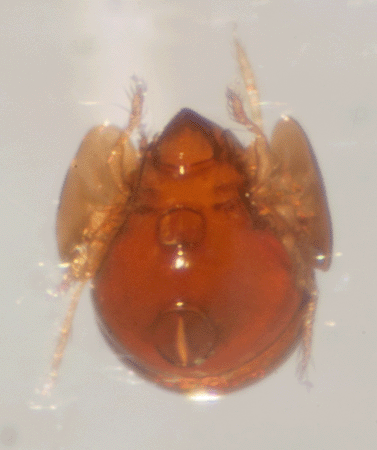 On March 27, 2015, the mite family was identified by Ray Fisher, Contributing Editor of <BugGuide.net), sponsored by Iowa State University Department of Entomology.
On March 27, 2015, the mite family was identified by Ray Fisher, Contributing Editor of <BugGuide.net), sponsored by Iowa State University Department of Entomology. 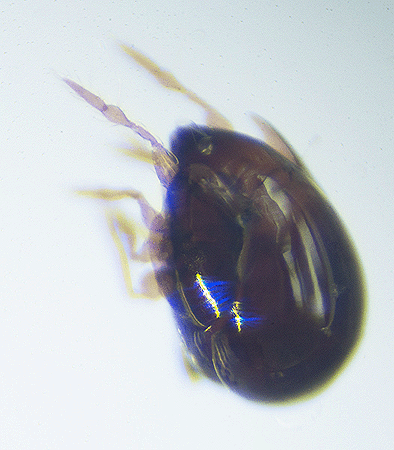
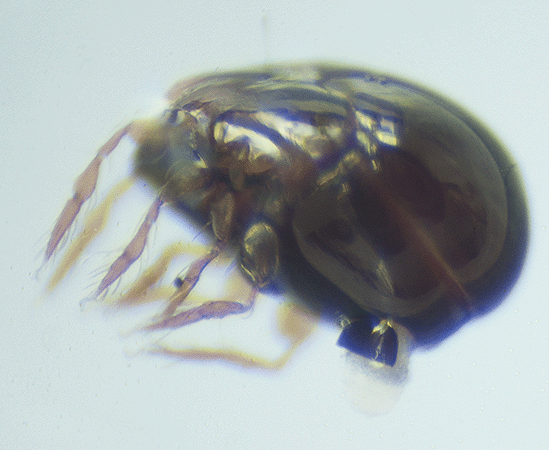
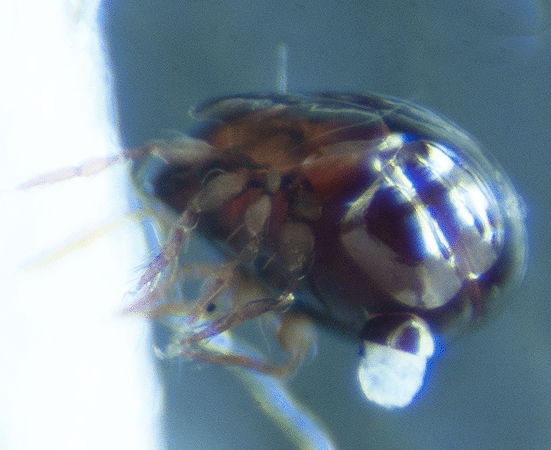 The webmaster thought the mite resembled the Galumnid mite shown earlier above. Images were created of this new mite by photomicroscopy and sent for identification confirmation to <BugGuide.net>, sponsored by Iowa State University's Department of Entomology.
The webmaster thought the mite resembled the Galumnid mite shown earlier above. Images were created of this new mite by photomicroscopy and sent for identification confirmation to <BugGuide.net>, sponsored by Iowa State University's Department of Entomology. 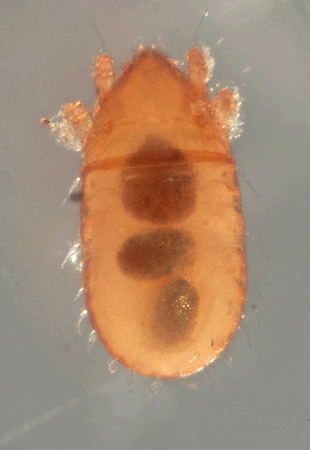 On December 29, 2014, this 1 mm mite was collected from pine litter beneath
On December 29, 2014, this 1 mm mite was collected from pine litter beneath 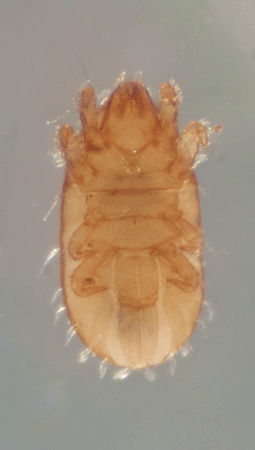
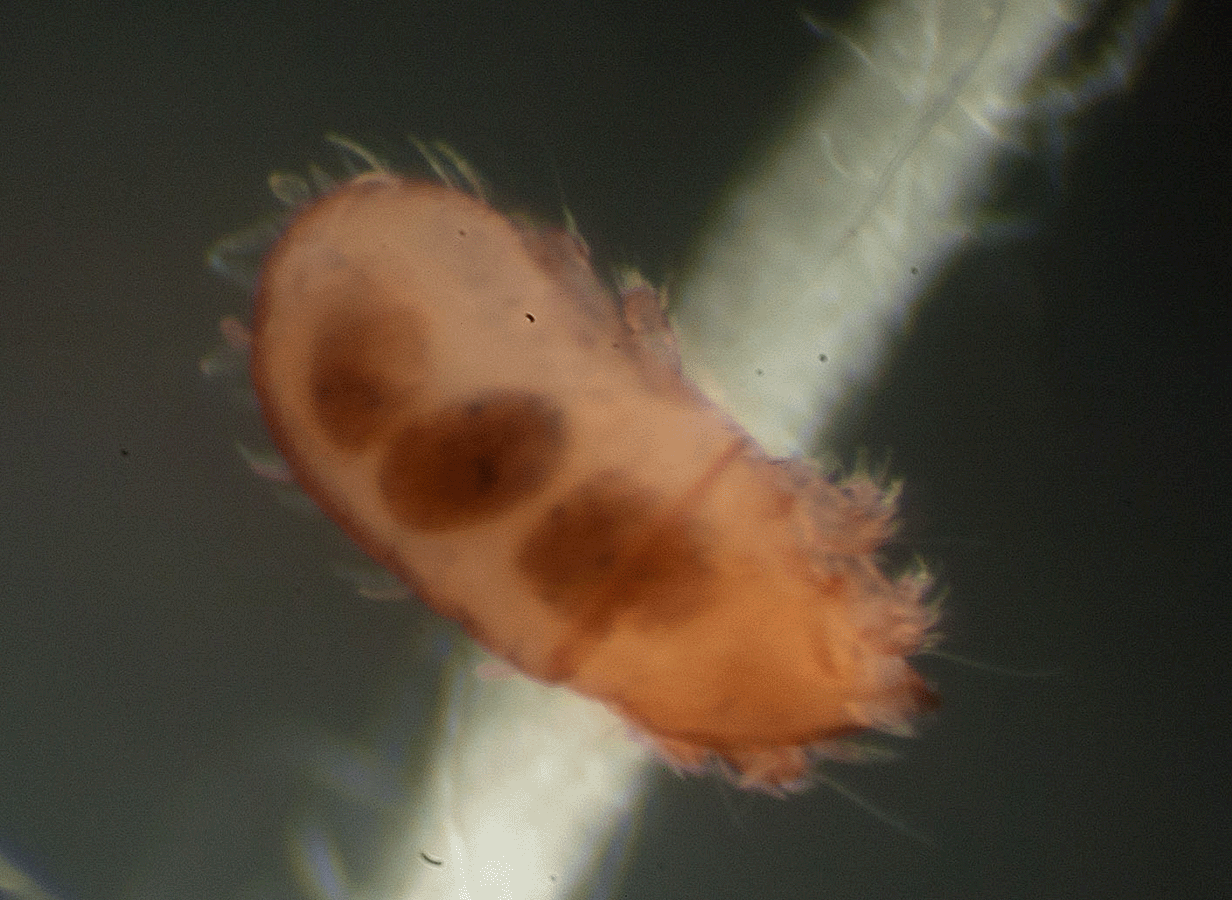
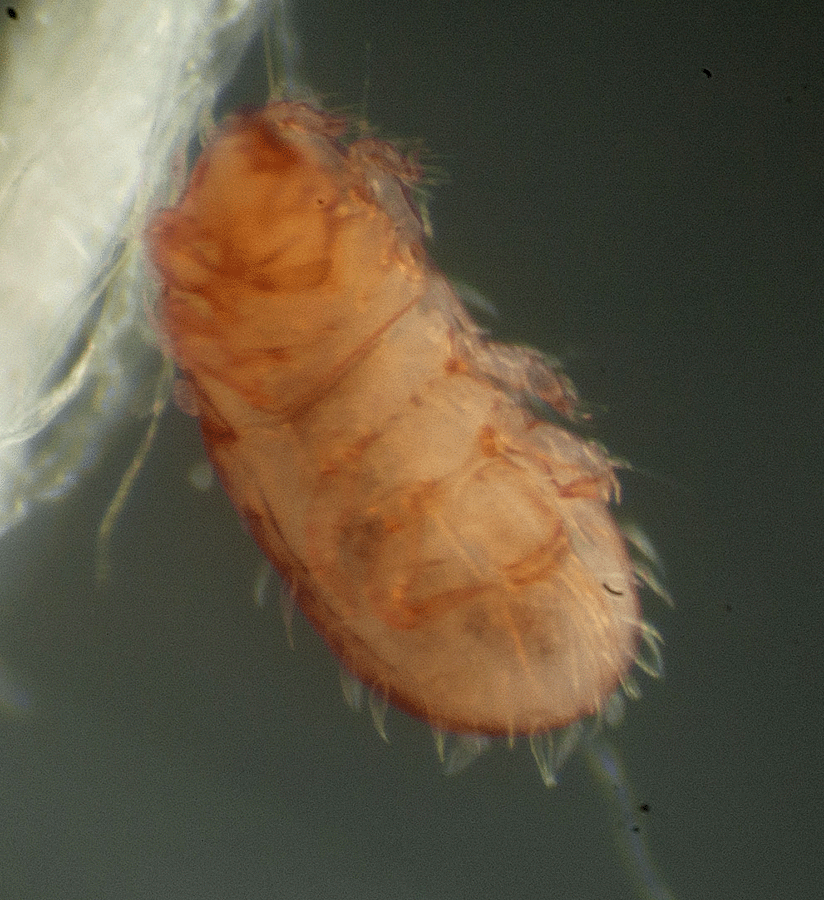
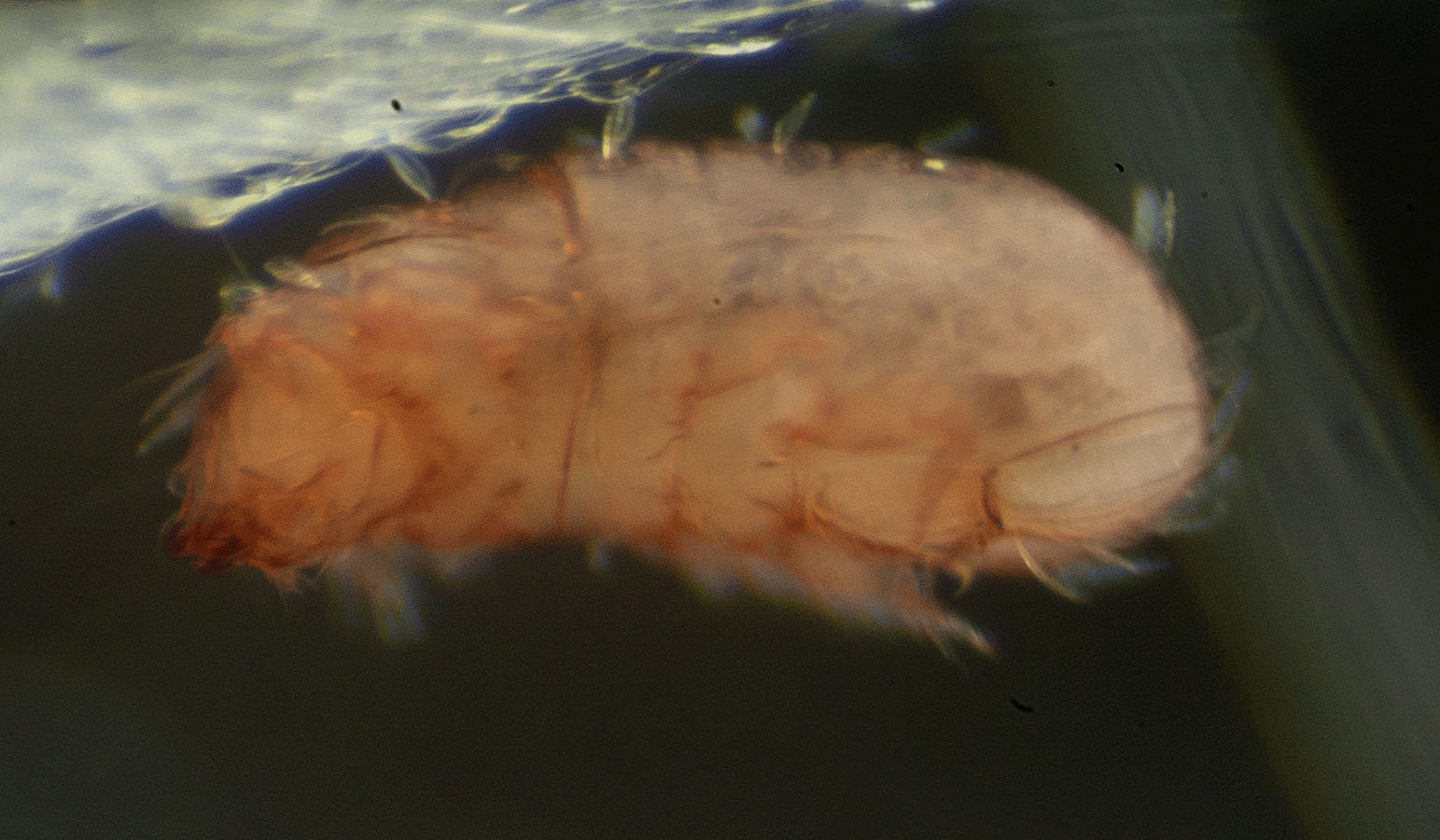
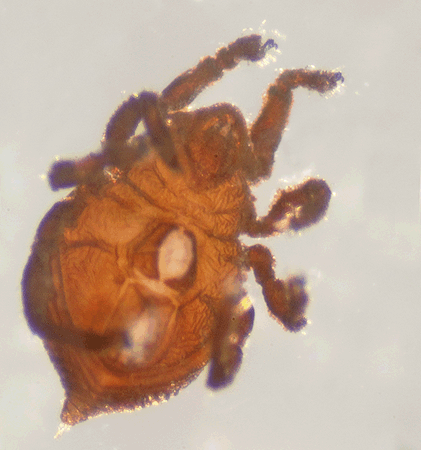
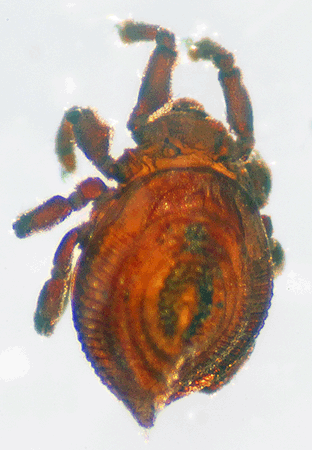
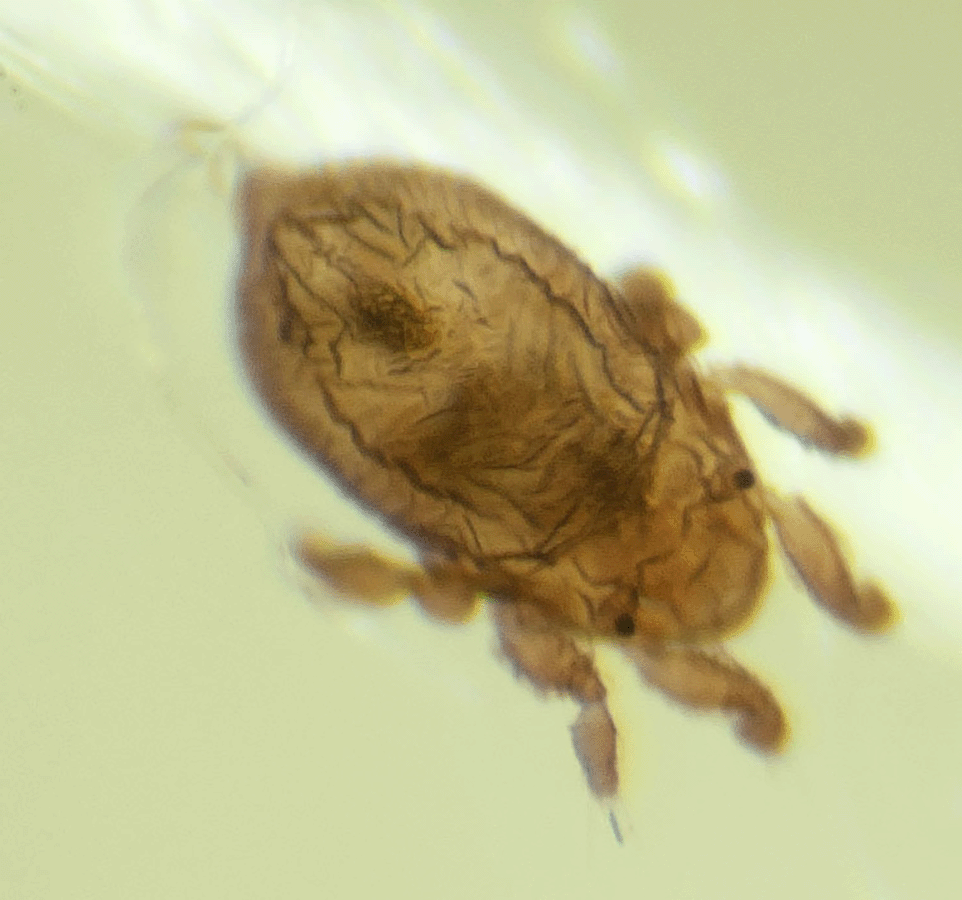
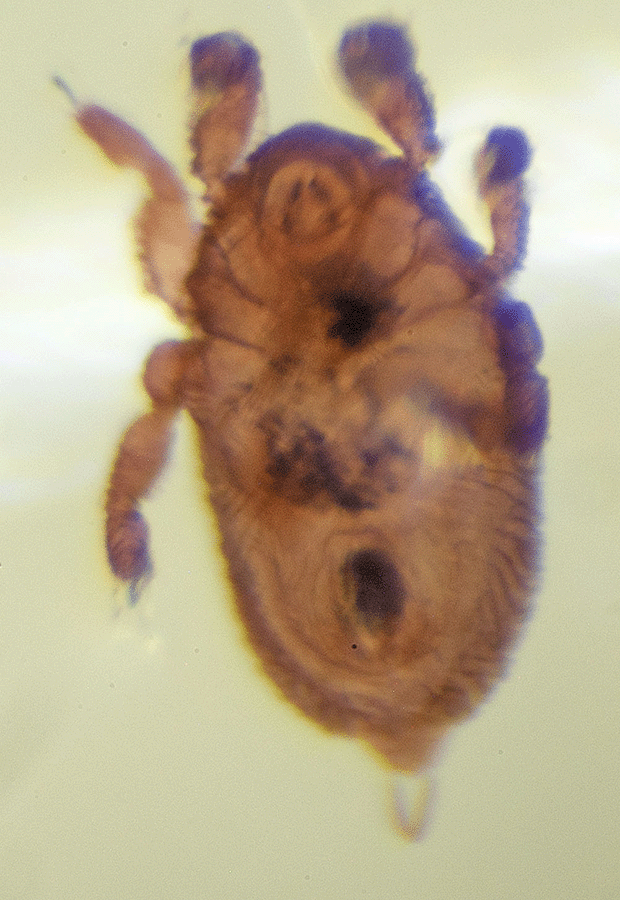
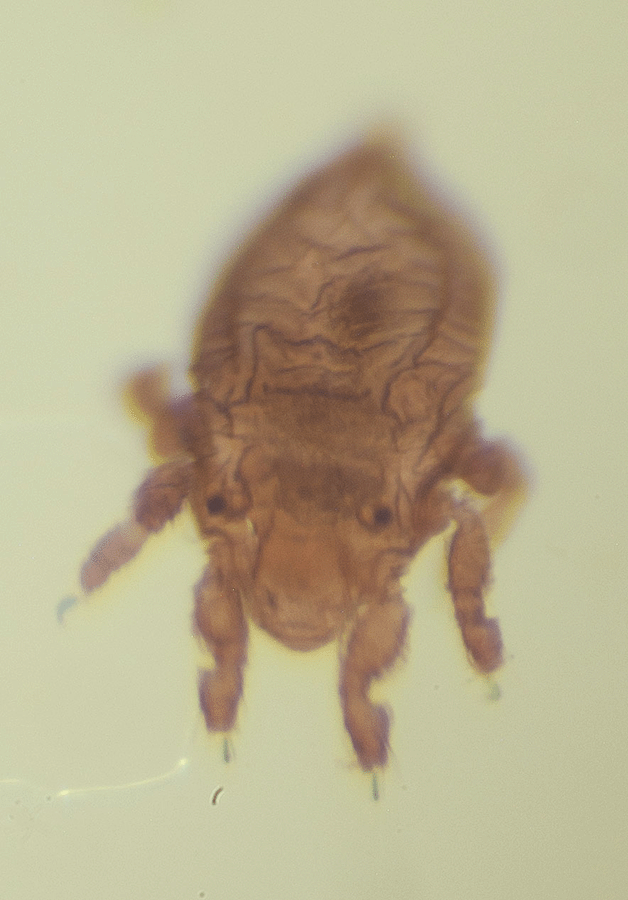
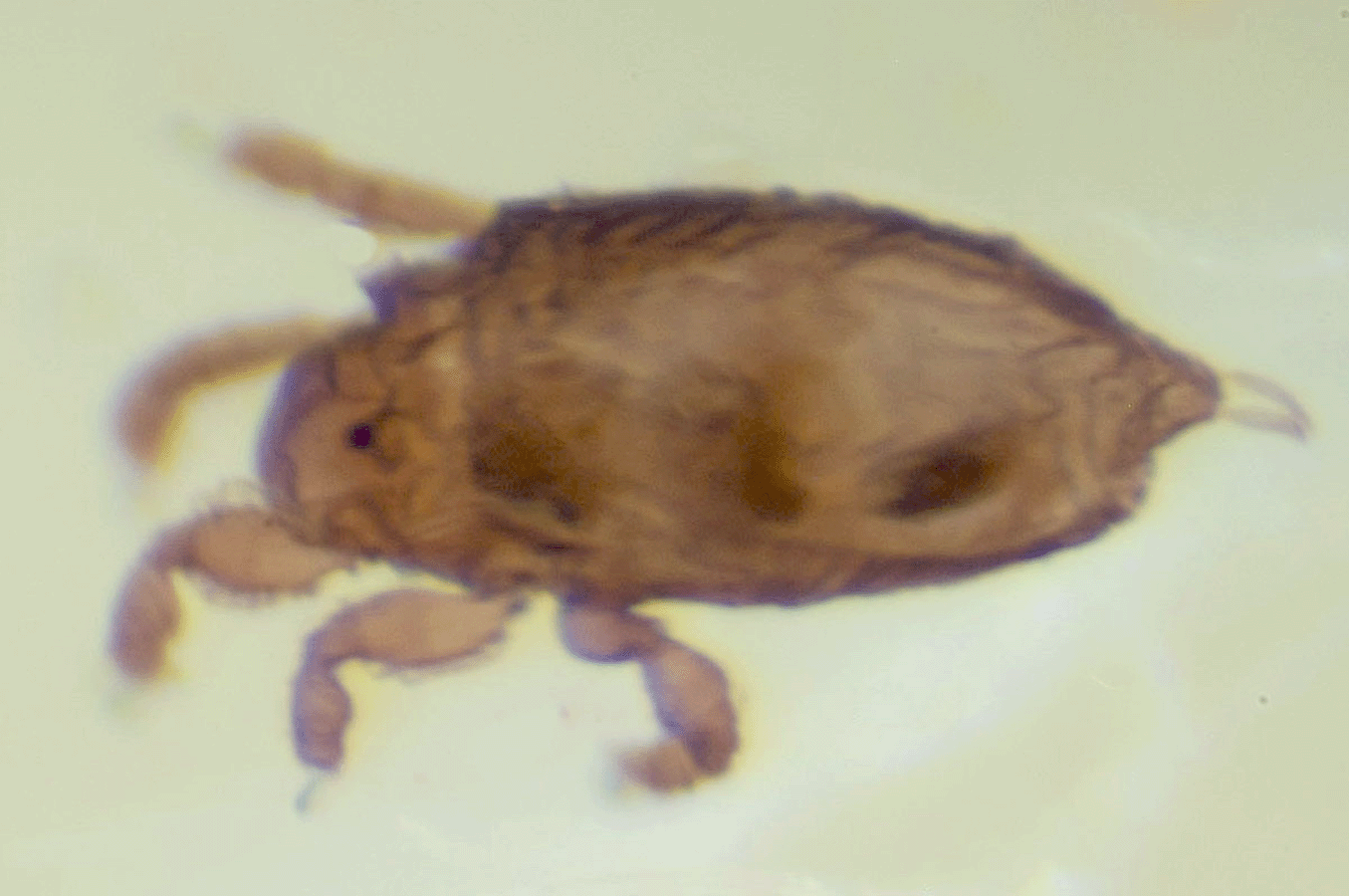
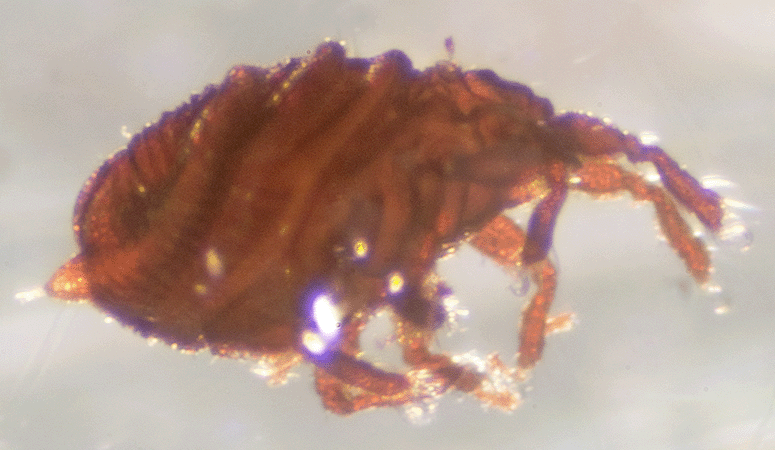 On December 29, 2014, this .75 mm mite was living in pine litter collected under a
On December 29, 2014, this .75 mm mite was living in pine litter collected under a 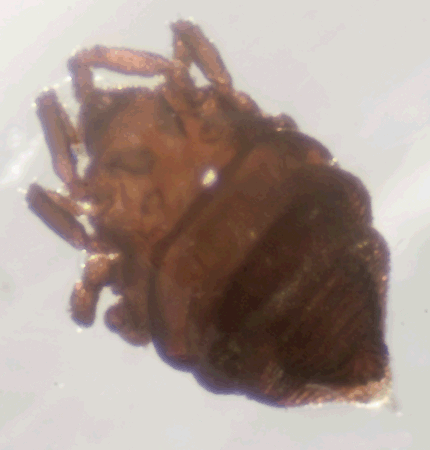
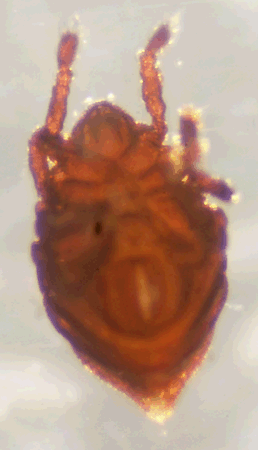
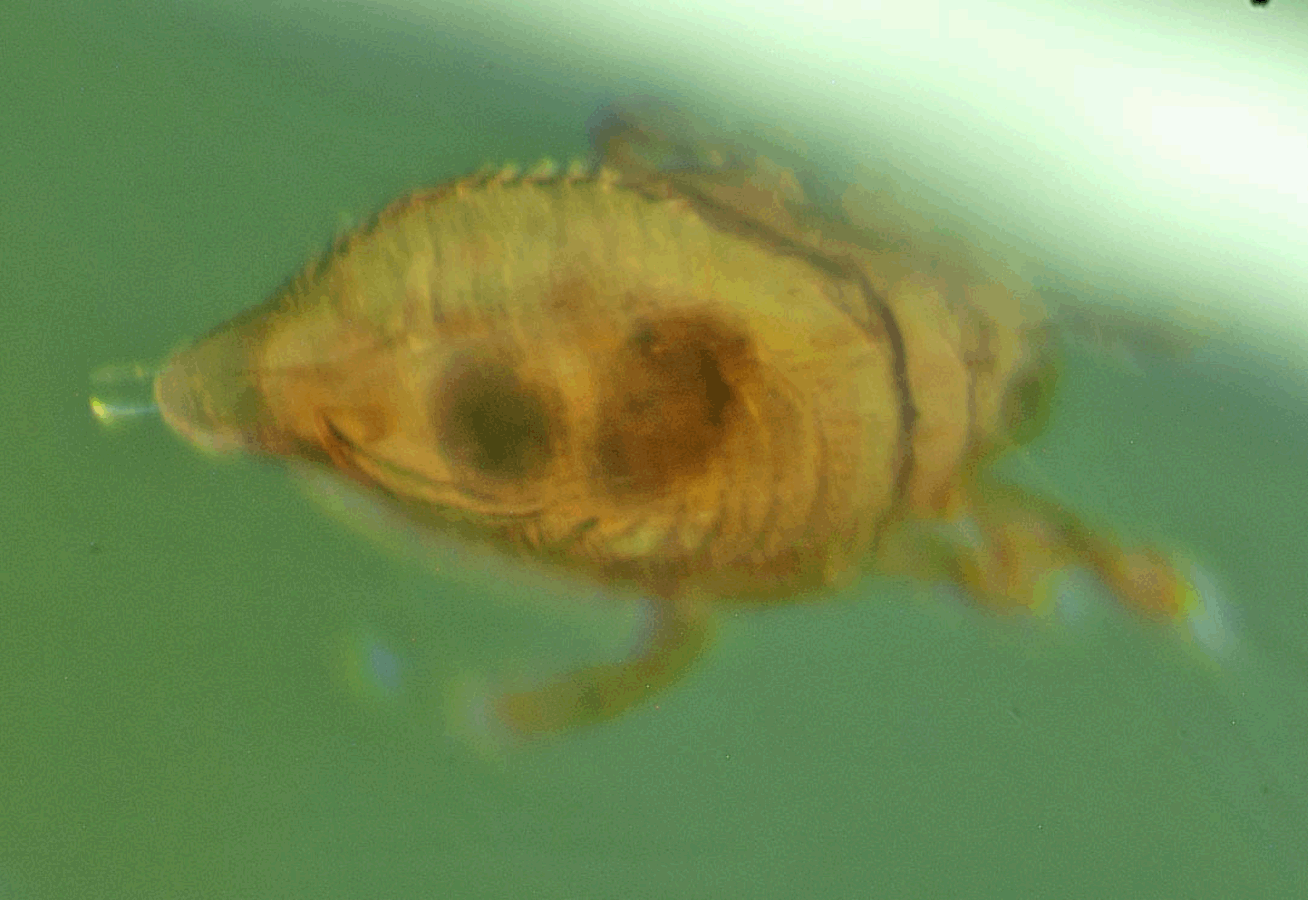
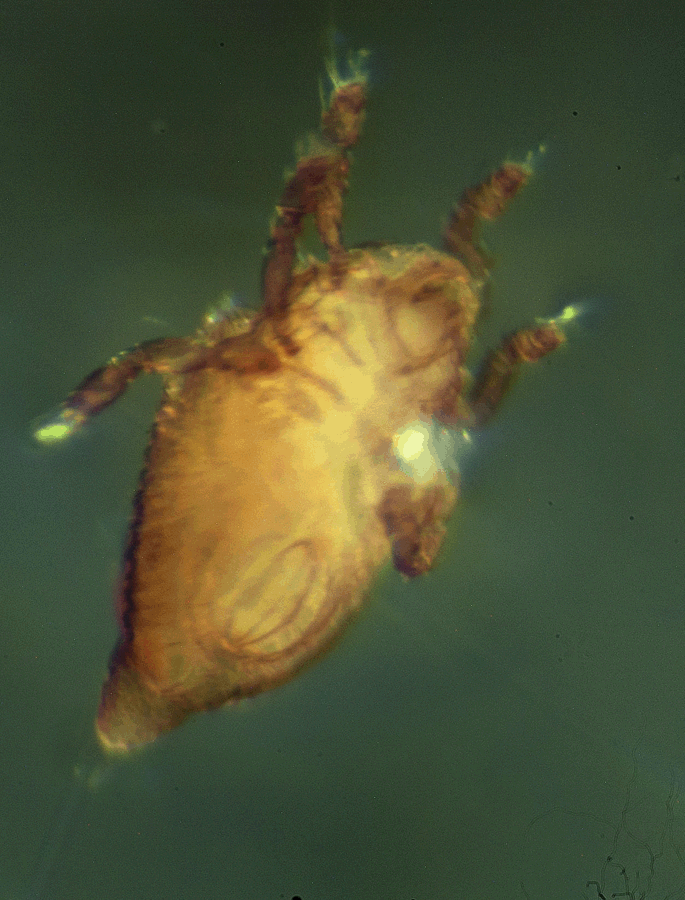
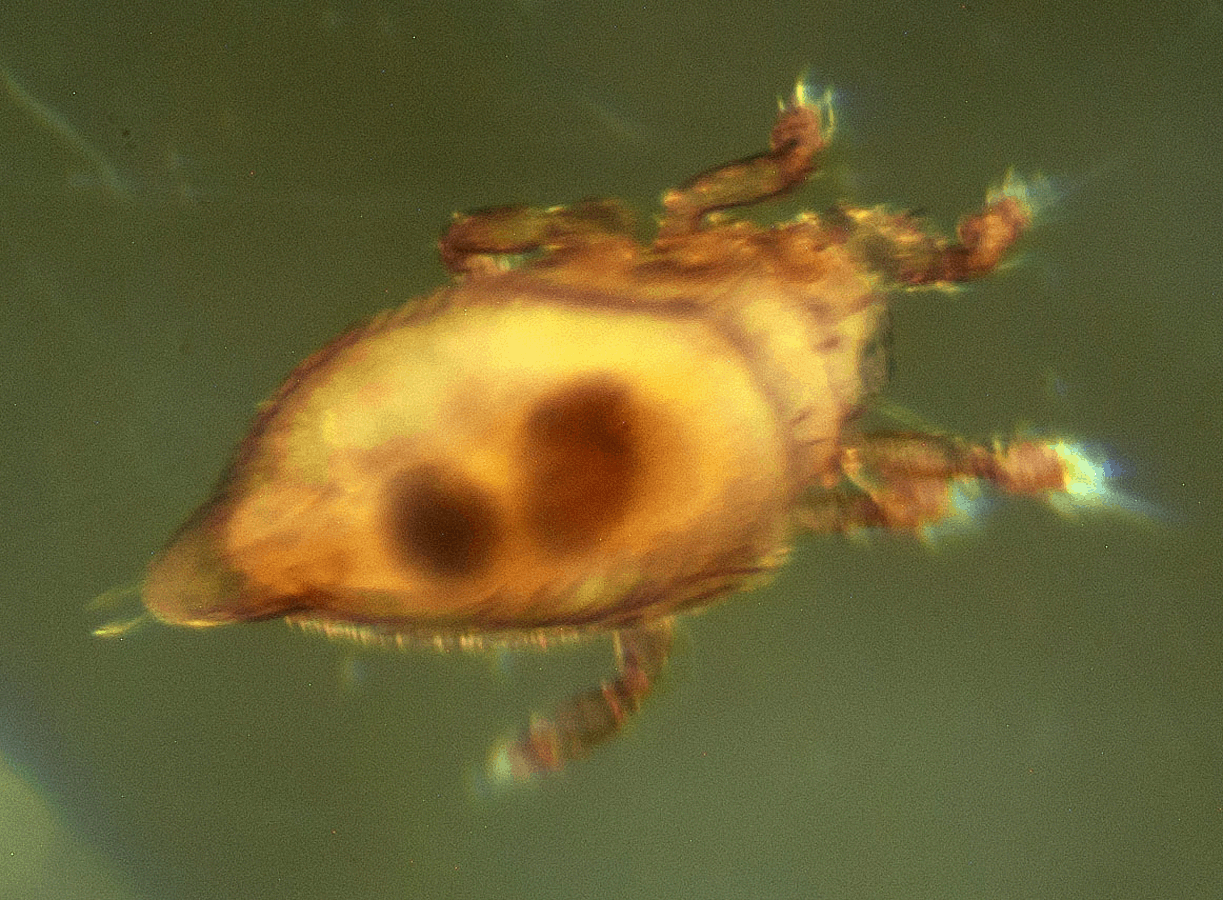
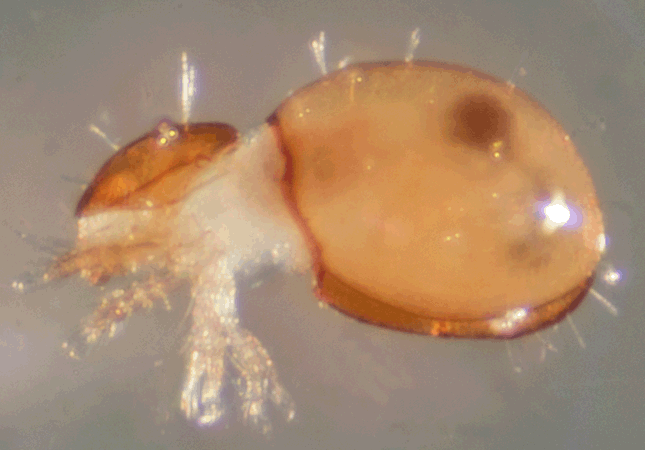 On December 29, 2014, this .5 mm mite was living in pine needles beneath a
On December 29, 2014, this .5 mm mite was living in pine needles beneath a 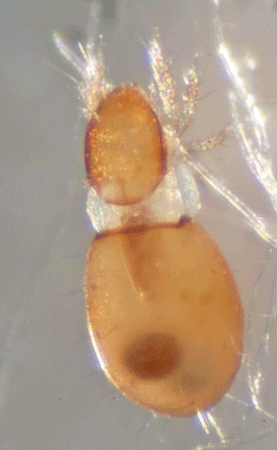
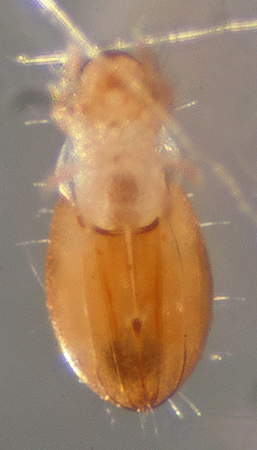 Image 1 and image 4 are lateral views of this ptychoid moss mite. Image 2 is a dorsal ventral view and image 3 is a ventral view.
Image 1 and image 4 are lateral views of this ptychoid moss mite. Image 2 is a dorsal ventral view and image 3 is a ventral view. 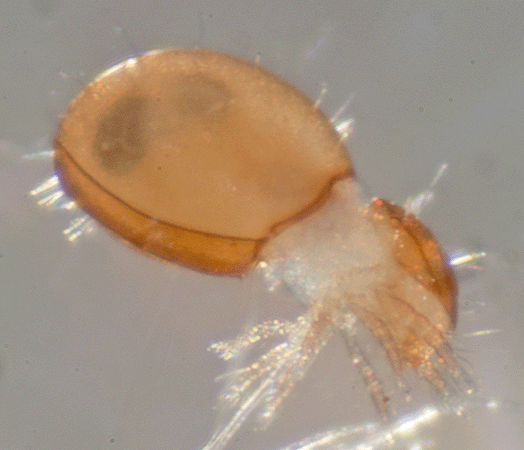 From this photograph, Dr. Proctor was able to identify the family as Euphthiracaridae. She said "The dark interlocking triangle in the middle of the genito-anal plates" was what she needed to see.
From this photograph, Dr. Proctor was able to identify the family as Euphthiracaridae. She said "The dark interlocking triangle in the middle of the genito-anal plates" was what she needed to see. 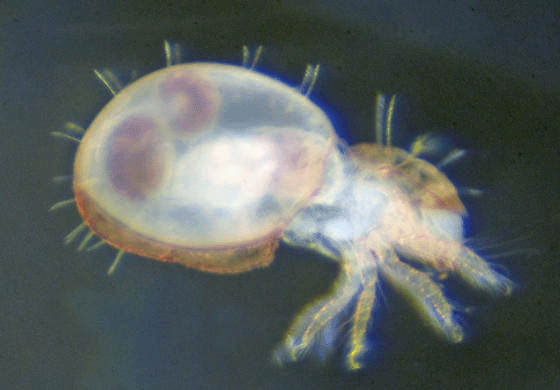
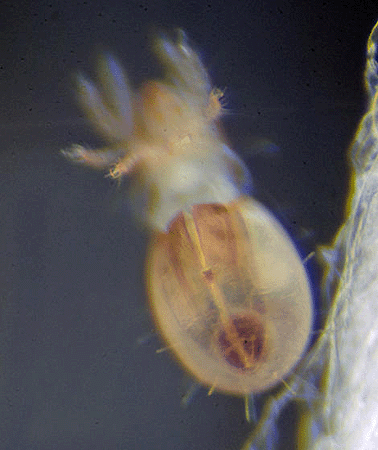
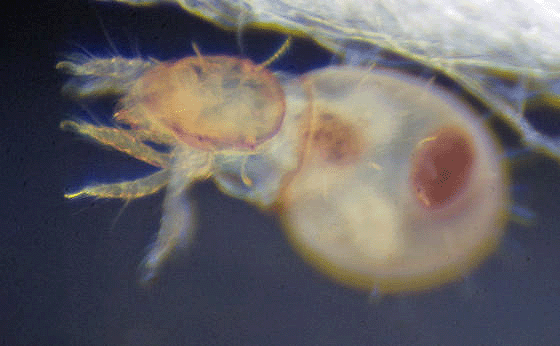
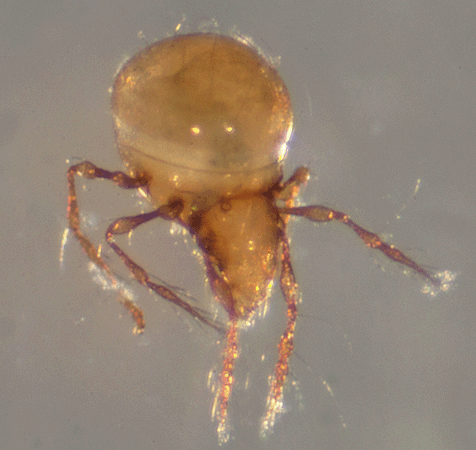
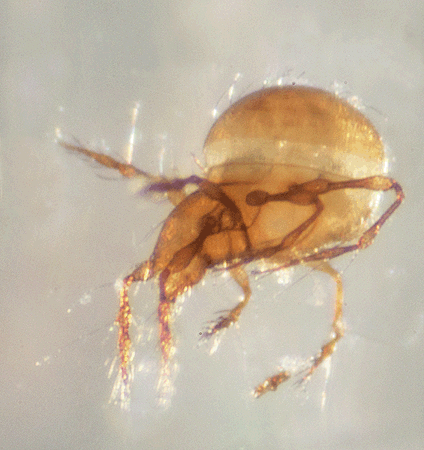 Members of the order range in size from 0.2 to 1.4 mm. These mites develop slowly, but they live a relatively long time, from several months to two years. Adults feed on living and dead plant material, fungus, lichens, and carrion. Some are predatory; none are parasitic. Some are hosts to tapeworms; all break down organic matter in soil.
Members of the order range in size from 0.2 to 1.4 mm. These mites develop slowly, but they live a relatively long time, from several months to two years. Adults feed on living and dead plant material, fungus, lichens, and carrion. Some are predatory; none are parasitic. Some are hosts to tapeworms; all break down organic matter in soil.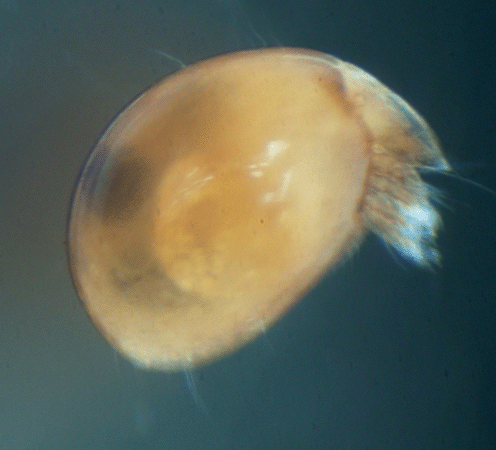 On March 4, 2015, this .8 mm mite was living in leaf litter collected beneath a
On March 4, 2015, this .8 mm mite was living in leaf litter collected beneath a 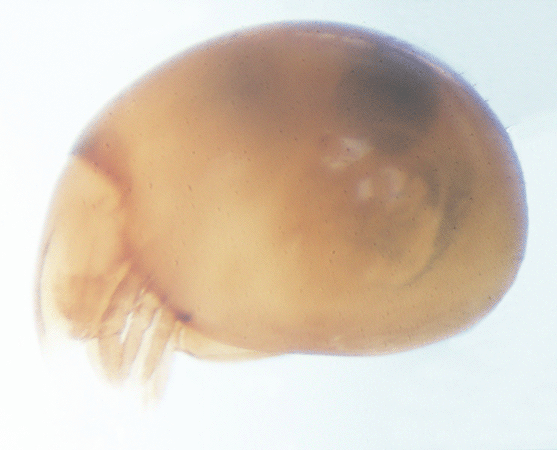 On February 7, 2018, the mite was confirmed as being in Order Oribatida by Ray Fisher, a Contributing Editor of <BugGuide.net>. Fisher also determined that it belonged to Suborder Mixonomata and Superfamily Euphthiracaroidea.
On February 7, 2018, the mite was confirmed as being in Order Oribatida by Ray Fisher, a Contributing Editor of <BugGuide.net>. Fisher also determined that it belonged to Suborder Mixonomata and Superfamily Euphthiracaroidea. 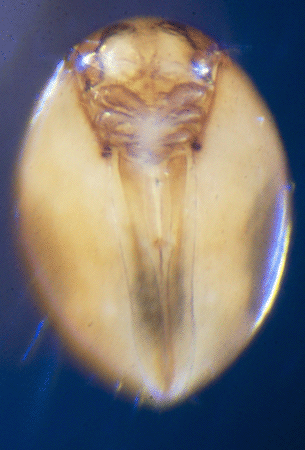
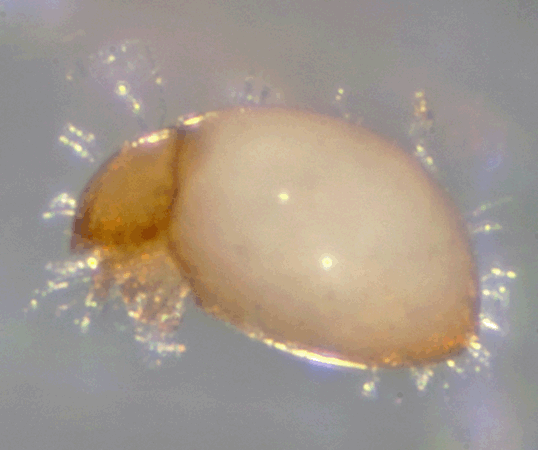 This .5 mm mite was collected on December 17, 2014 in leaf litter in the northeast hammock of the Smith Preserve. It was removed from the leaf litter using a Berlese funnel.
This .5 mm mite was collected on December 17, 2014 in leaf litter in the northeast hammock of the Smith Preserve. It was removed from the leaf litter using a Berlese funnel. 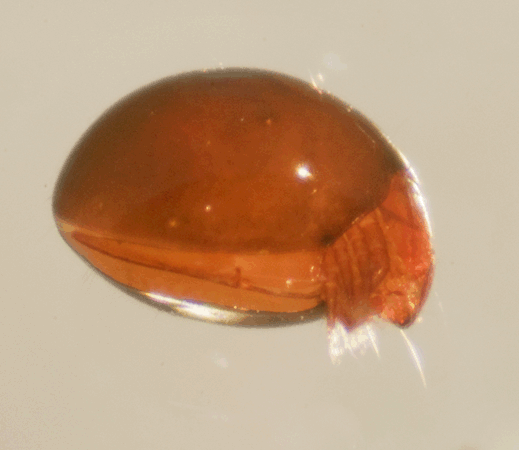 This 1 mm mite was collected on December 19, 2014 in leaf litter under a citrus tree in the northeast hammock of the Smith Preserve. It was removed from the litter using a Berlese funnel. This brown mite was living in litter only about 10 meters from the white, very similar looking, but smaller mite, shown above.
This 1 mm mite was collected on December 19, 2014 in leaf litter under a citrus tree in the northeast hammock of the Smith Preserve. It was removed from the litter using a Berlese funnel. This brown mite was living in litter only about 10 meters from the white, very similar looking, but smaller mite, shown above.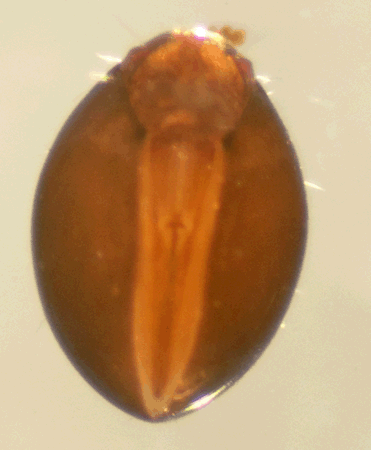 These photographs were created using photomicroscopy. The first image is a lateral view, the second is a ventral view.
These photographs were created using photomicroscopy. The first image is a lateral view, the second is a ventral view.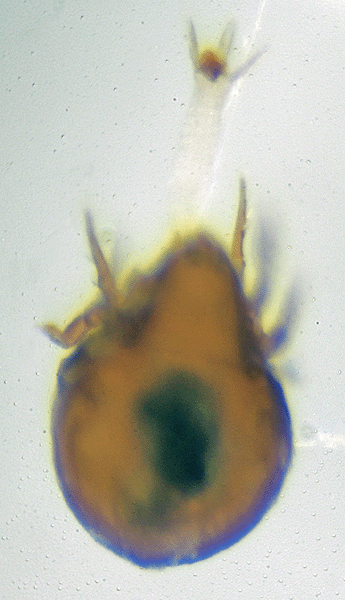 This Oribatid mite resembles the two mites above in its seed-like appearance. It may be the same species as one of those, but that has not been determined, and there are ~10,000 described species of orbatid mites. They live mainly in soil and they are important decomposers in forest ecosystems.
This Oribatid mite resembles the two mites above in its seed-like appearance. It may be the same species as one of those, but that has not been determined, and there are ~10,000 described species of orbatid mites. They live mainly in soil and they are important decomposers in forest ecosystems. 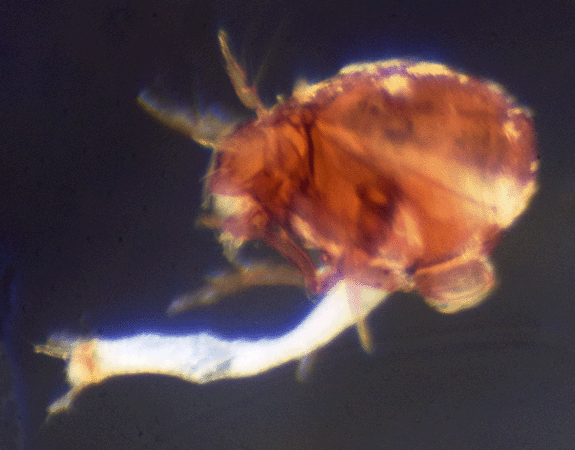
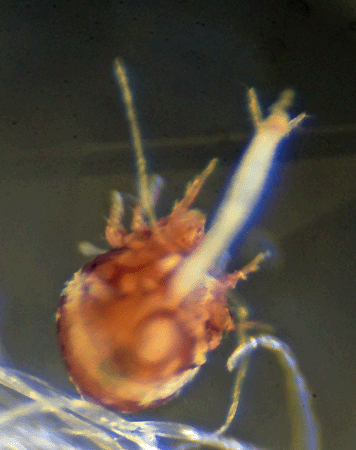
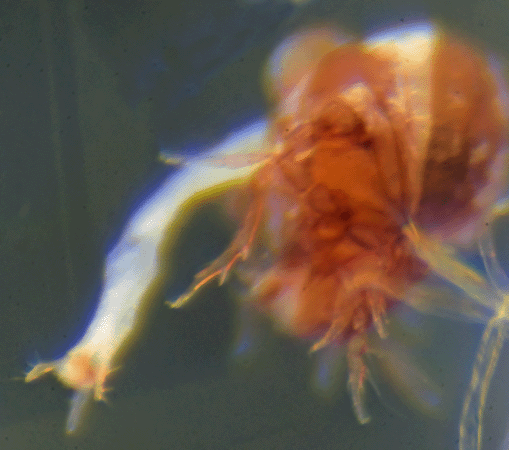
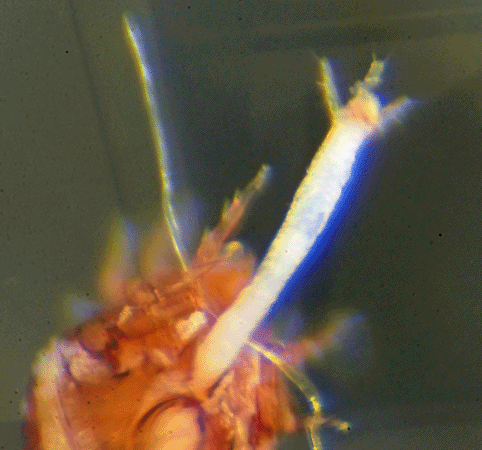
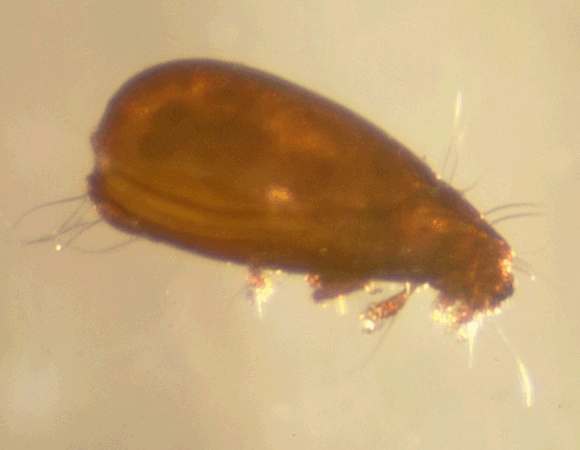 This .6 mm mite was collected on December 19, 2014 from a leaf litter sample collected under a citrus tree in the northeast hammock of the Smith Preserve. It was in the same litter sample as the mite shown above. It was extracted from the sample using a Berlese funnel. By using photomicroscopy, these photographs were produced.
This .6 mm mite was collected on December 19, 2014 from a leaf litter sample collected under a citrus tree in the northeast hammock of the Smith Preserve. It was in the same litter sample as the mite shown above. It was extracted from the sample using a Berlese funnel. By using photomicroscopy, these photographs were produced. 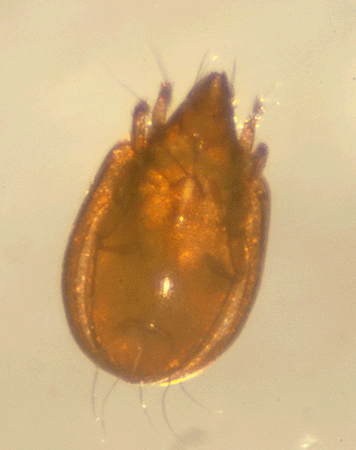 As stated earlier, adult Oribatids feed on living and dead plant material, fungus, lichens, and carrion. Some are predatory; none are parasitic. Some are hosts to tapeworms; all break down organic matter in soil.
As stated earlier, adult Oribatids feed on living and dead plant material, fungus, lichens, and carrion. Some are predatory; none are parasitic. Some are hosts to tapeworms; all break down organic matter in soil. 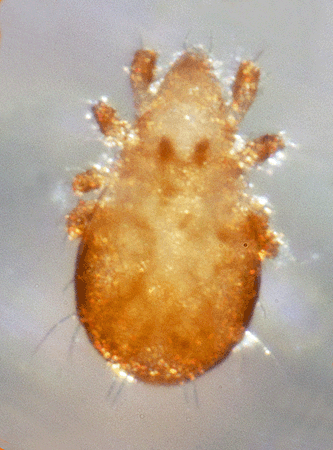
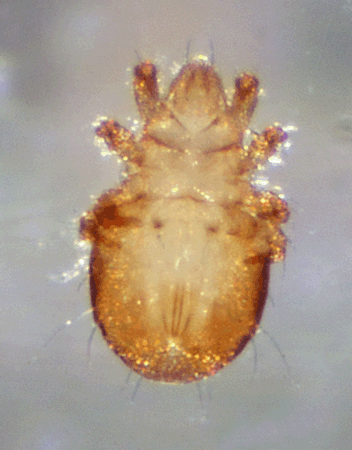
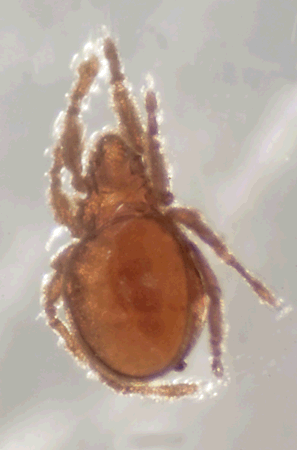 On December 29, 2014, this .5 mm long mite was living in pine needle litter beneath a
On December 29, 2014, this .5 mm long mite was living in pine needle litter beneath a 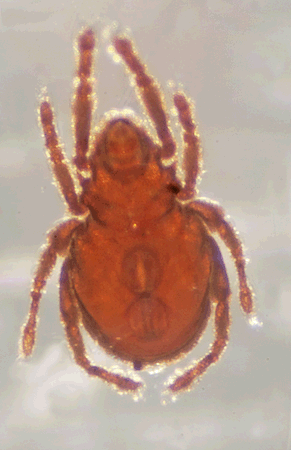 On March 12, 2015, the mite was identified from these photographs as an oribatid mite by Ray Fisher, Contributing Editor of <BugGuide.net>, sponsored by Iowa State University Department of Entomology.
On March 12, 2015, the mite was identified from these photographs as an oribatid mite by Ray Fisher, Contributing Editor of <BugGuide.net>, sponsored by Iowa State University Department of Entomology.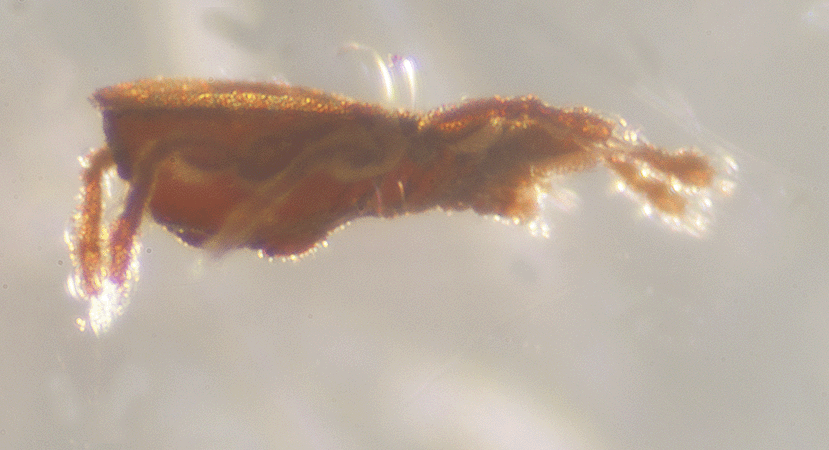
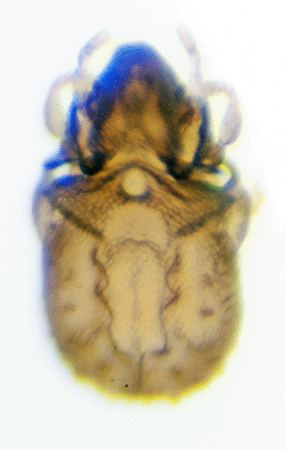

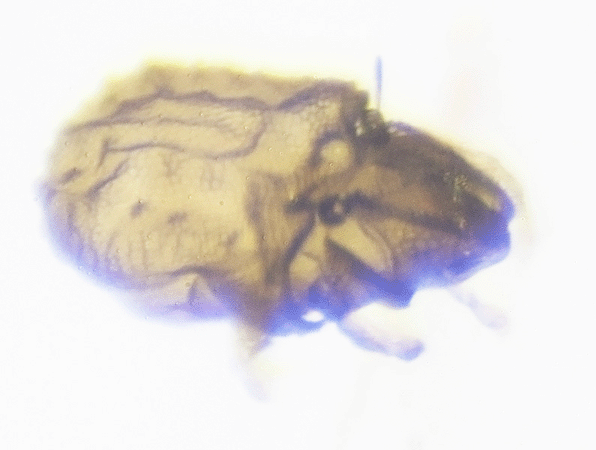 The mite was separated from the leaf litter with a Berlese funnel, and these photographs were created using photomicroscopy. Note the intricate pattern of the dorsal surface (1st image) as well as the posterior edge of the abdomen (2nd image).
The mite was separated from the leaf litter with a Berlese funnel, and these photographs were created using photomicroscopy. Note the intricate pattern of the dorsal surface (1st image) as well as the posterior edge of the abdomen (2nd image). 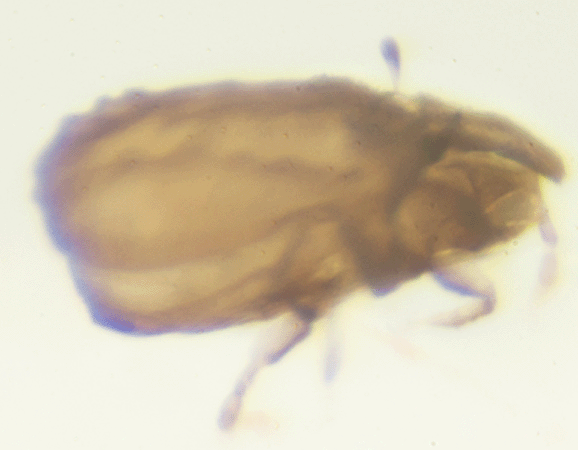 The third and fourth images show a piece of armor above and between the eyes. The armor appears to be a triangular, nose-like extension of the rostrum with horns on each side. The function of this structure is unknown, but it may be defensive.
The third and fourth images show a piece of armor above and between the eyes. The armor appears to be a triangular, nose-like extension of the rostrum with horns on each side. The function of this structure is unknown, but it may be defensive.

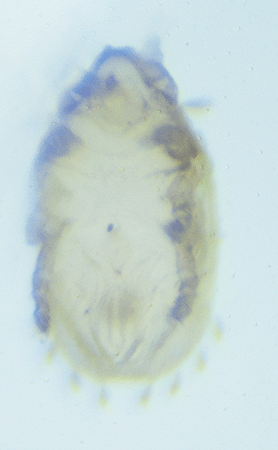 As shown in the first image above (a dorsal view), the mite has 8 oval, stalked structures attached to its posterior. These appear to be evenly spaced. As shown in the second image above (a frontal view), the head of the mite somewhat resembles the shape of a rat.
As shown in the first image above (a dorsal view), the mite has 8 oval, stalked structures attached to its posterior. These appear to be evenly spaced. As shown in the second image above (a frontal view), the head of the mite somewhat resembles the shape of a rat. 
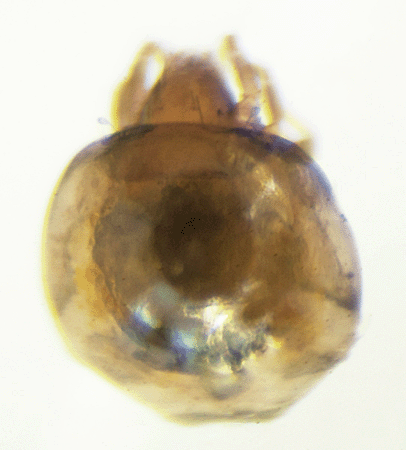
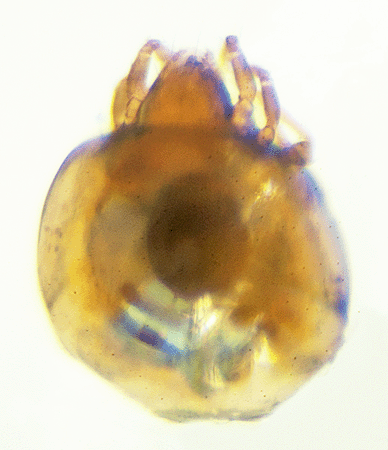
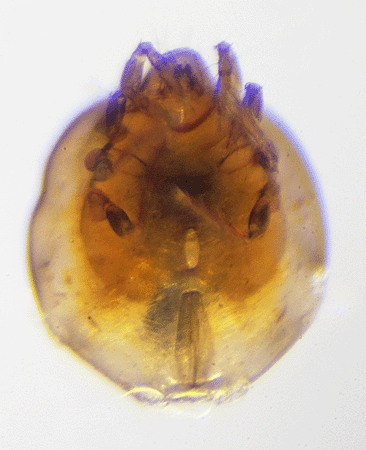

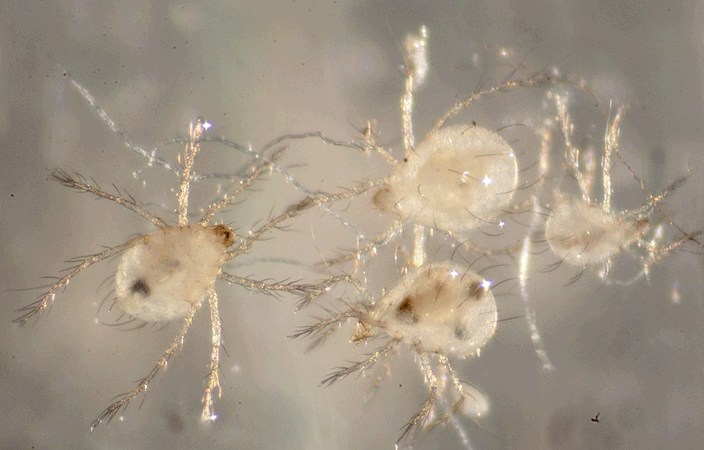 These ~.5 mm mites were collected on December 19, 2014 in leaf litter under a citrus tree in the northeast hammock of the Smith Preserve.
These ~.5 mm mites were collected on December 19, 2014 in leaf litter under a citrus tree in the northeast hammock of the Smith Preserve. 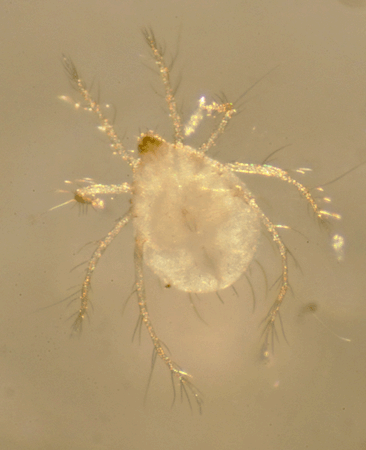
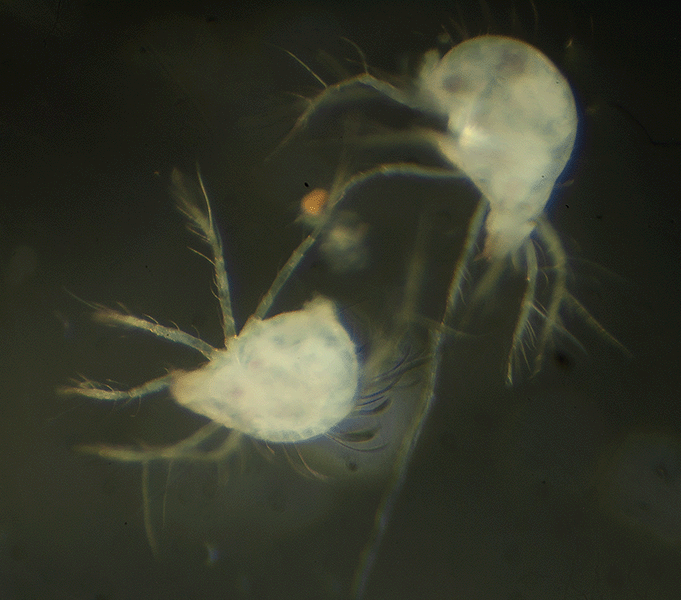
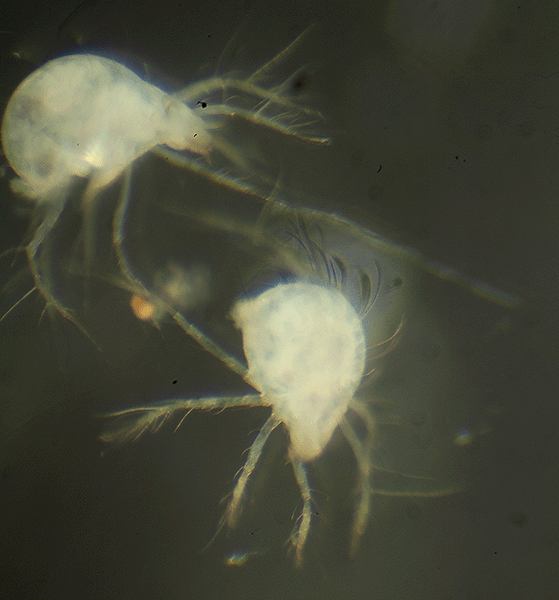
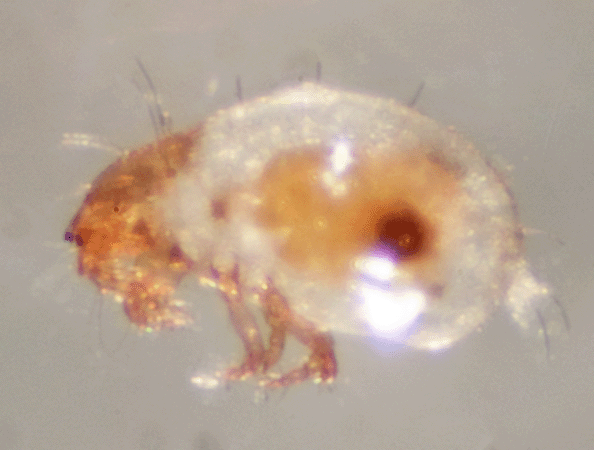
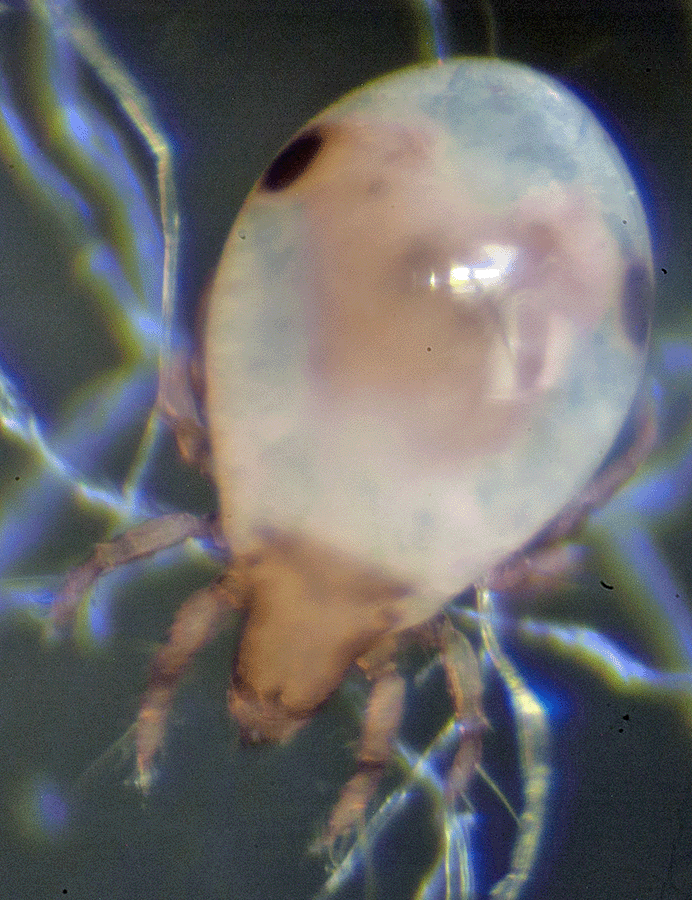
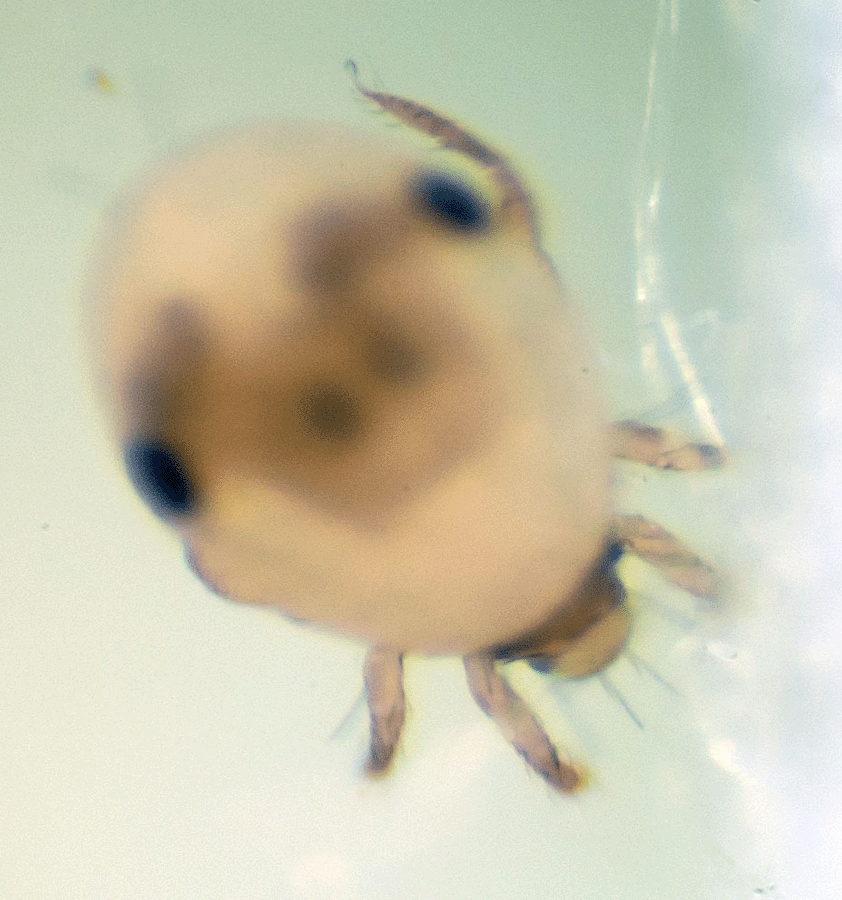
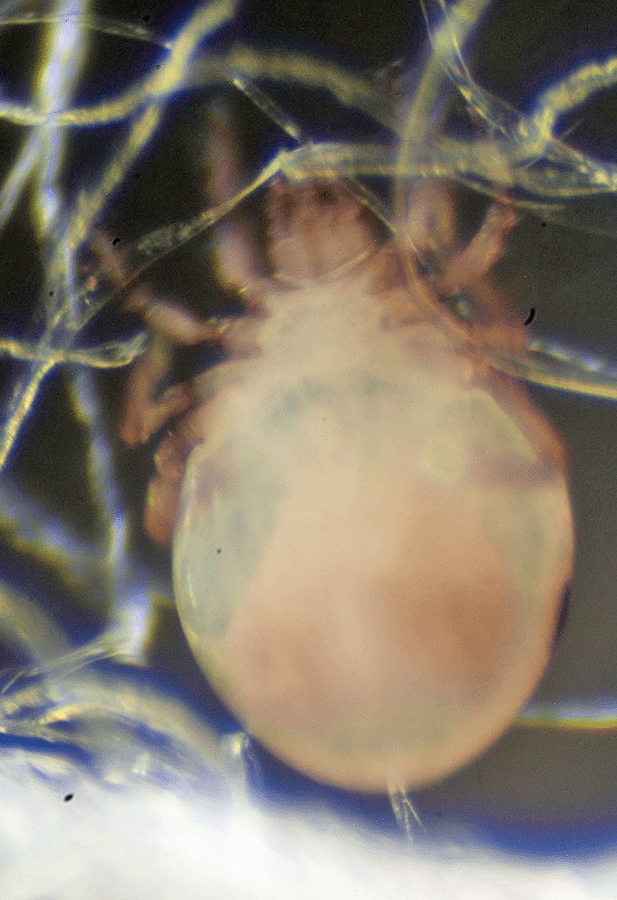
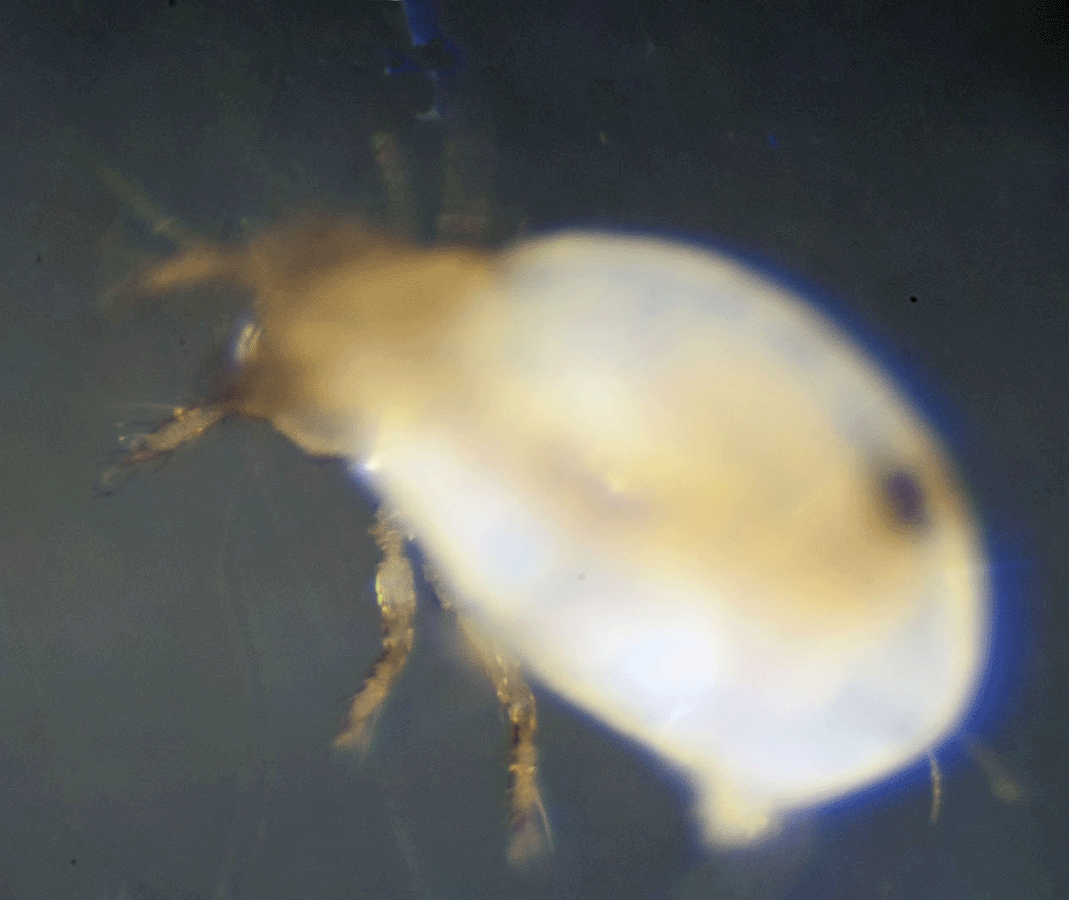
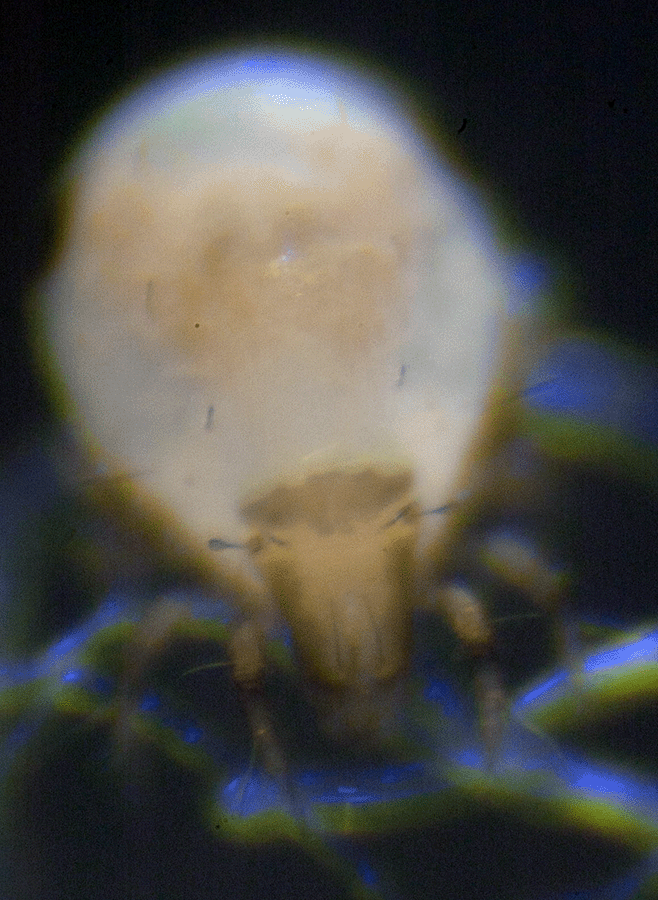
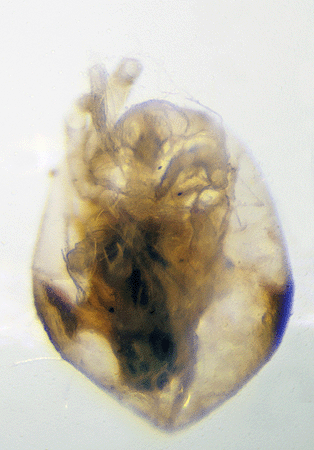
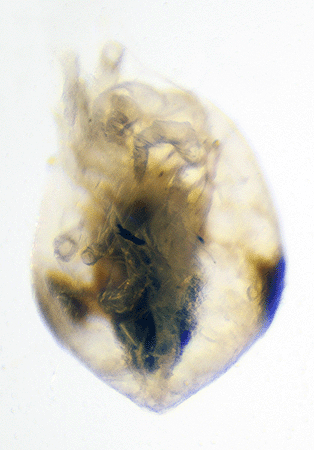
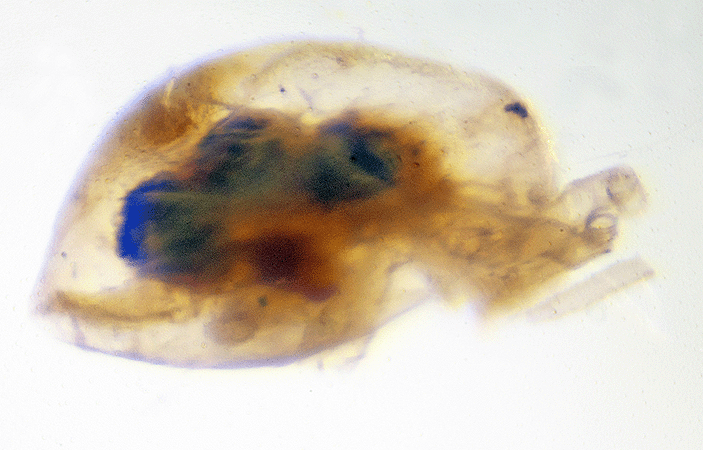
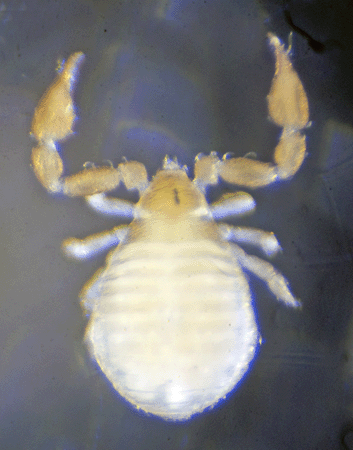
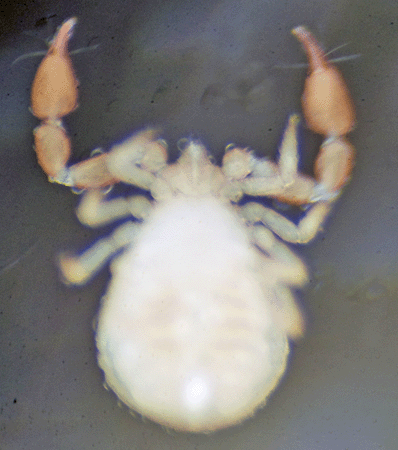
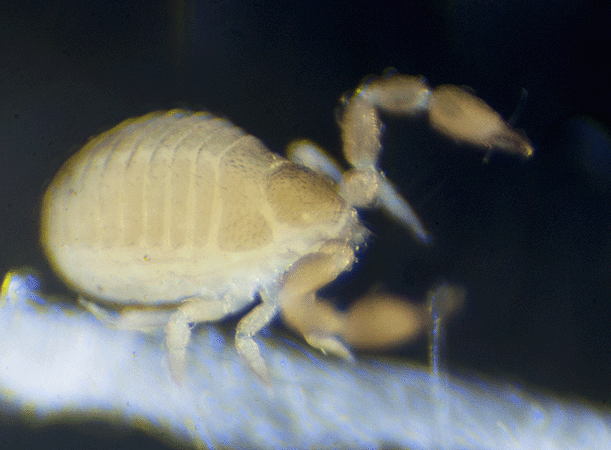 On January 3, 2017, this .9 mm long pseudoscorpion was collected in a sample of leaf litter under a
On January 3, 2017, this .9 mm long pseudoscorpion was collected in a sample of leaf litter under a 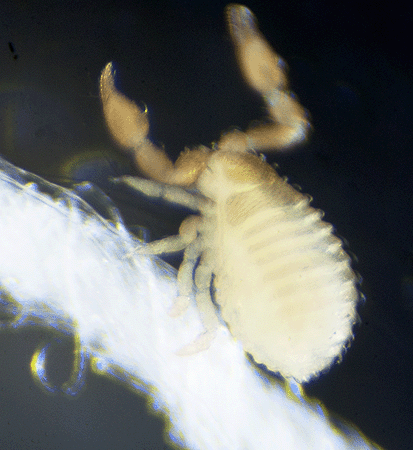 The size of these arachnids is usually less than 3 mm. They are flat, have pincer-like pedipalps, and lack a stinging “tail” like true scorpions.
The size of these arachnids is usually less than 3 mm. They are flat, have pincer-like pedipalps, and lack a stinging “tail” like true scorpions. 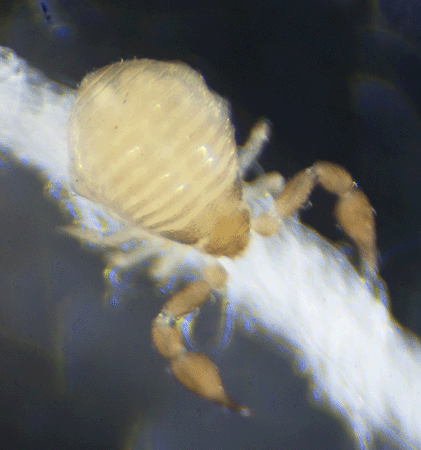
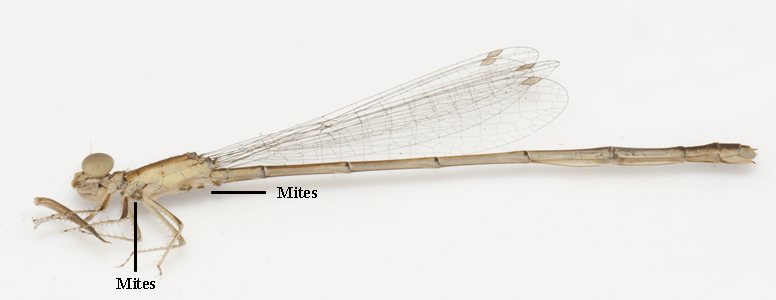
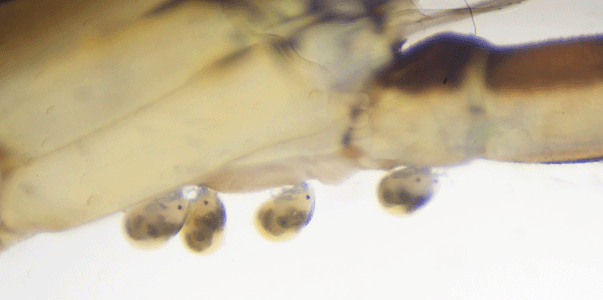
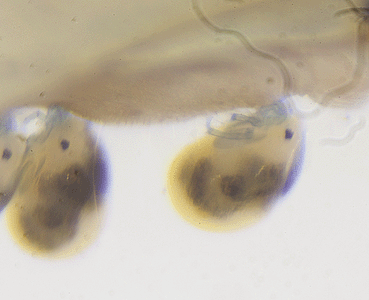
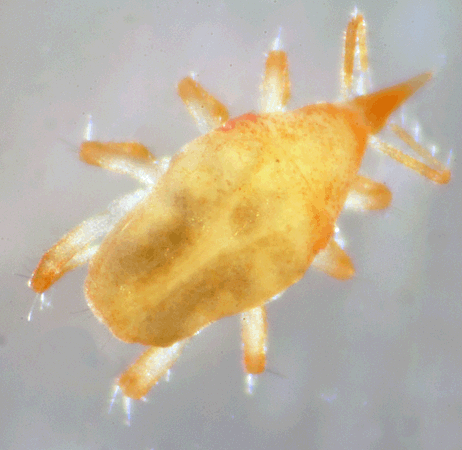
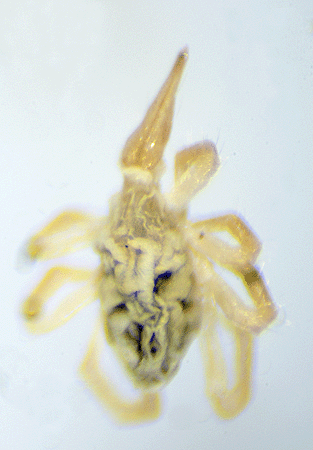
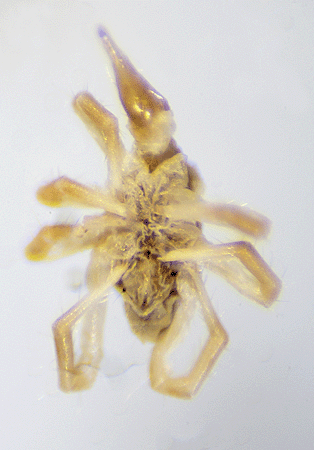
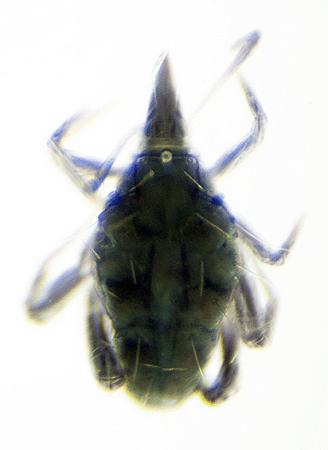
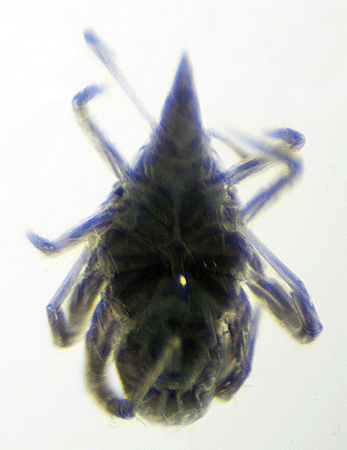

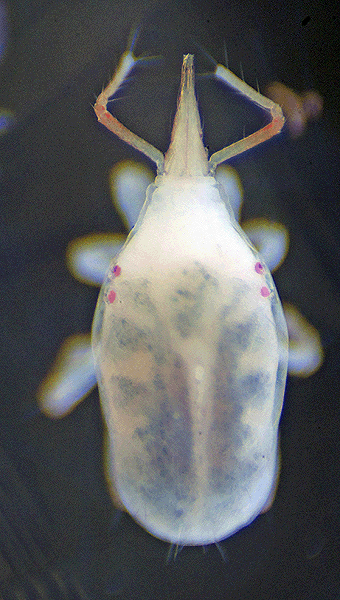
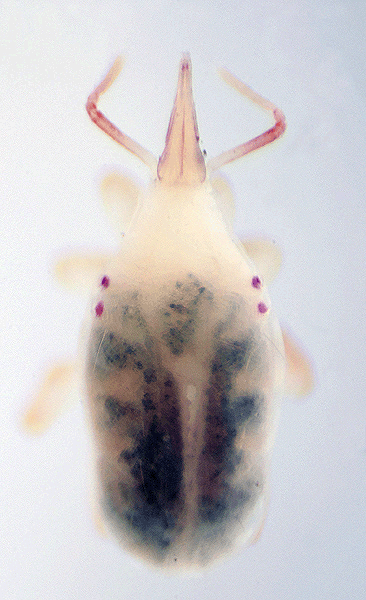
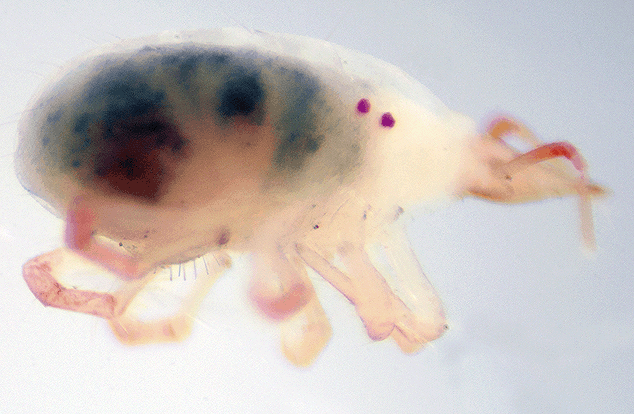
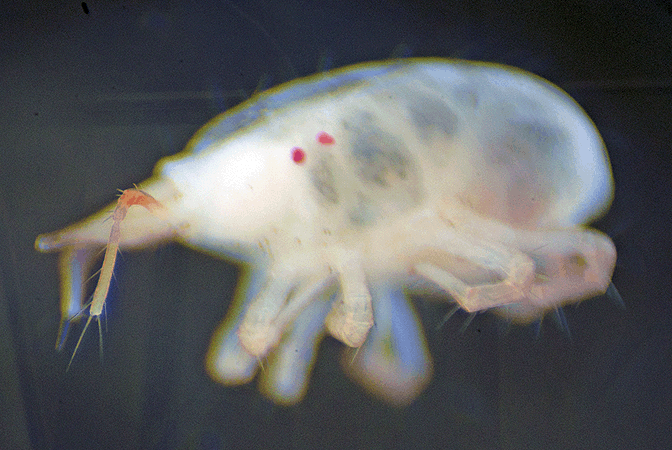
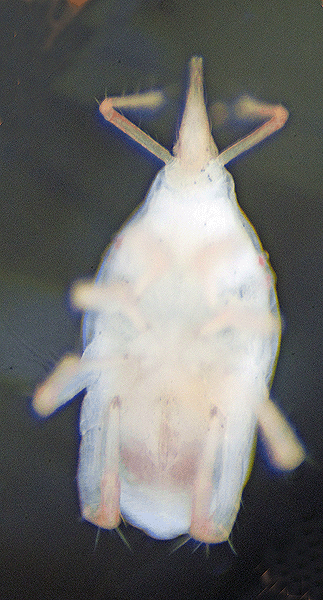
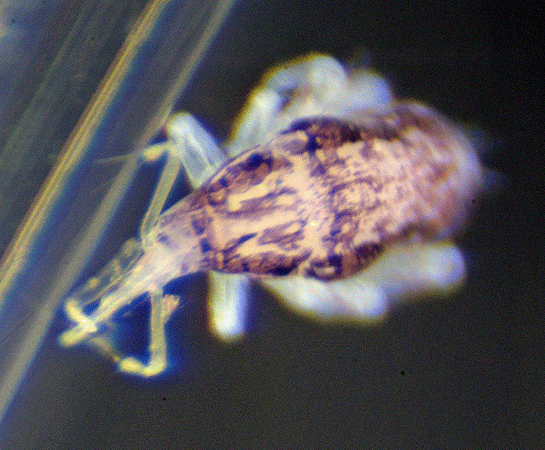
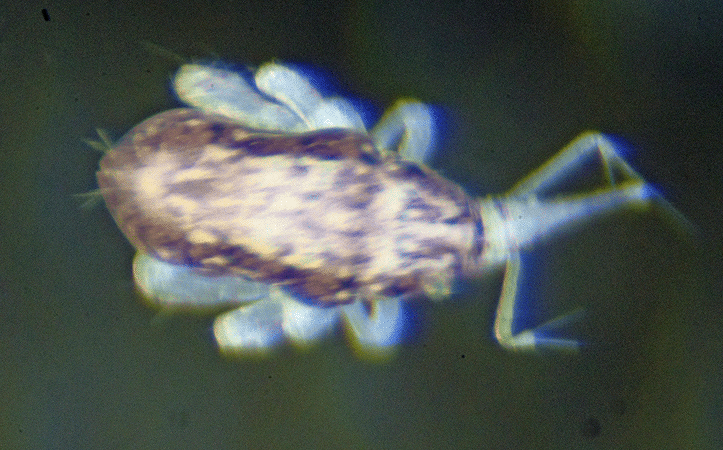
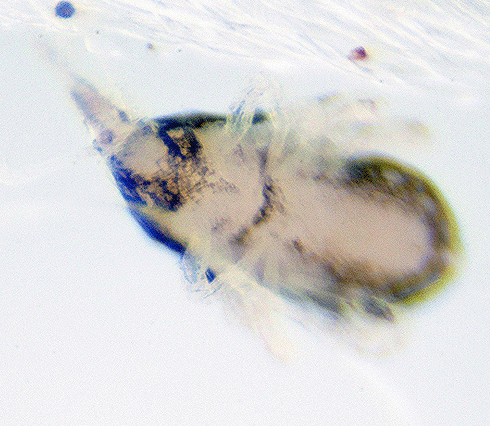
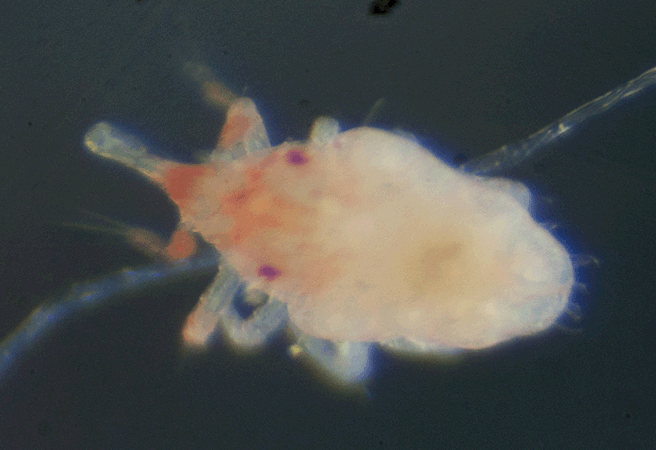
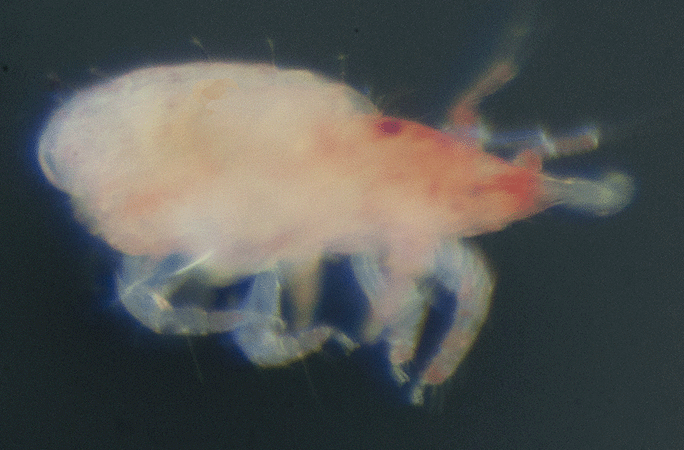
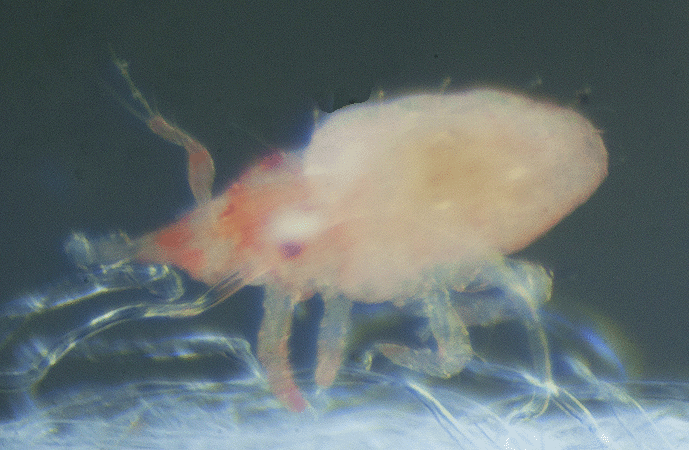
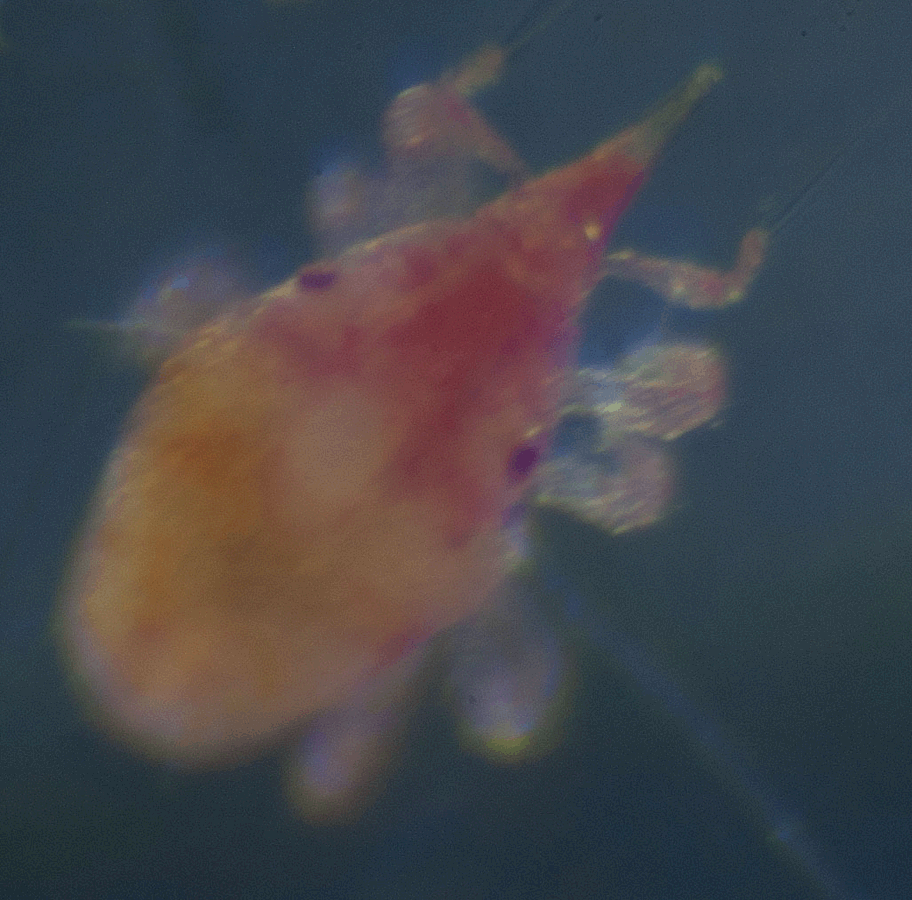
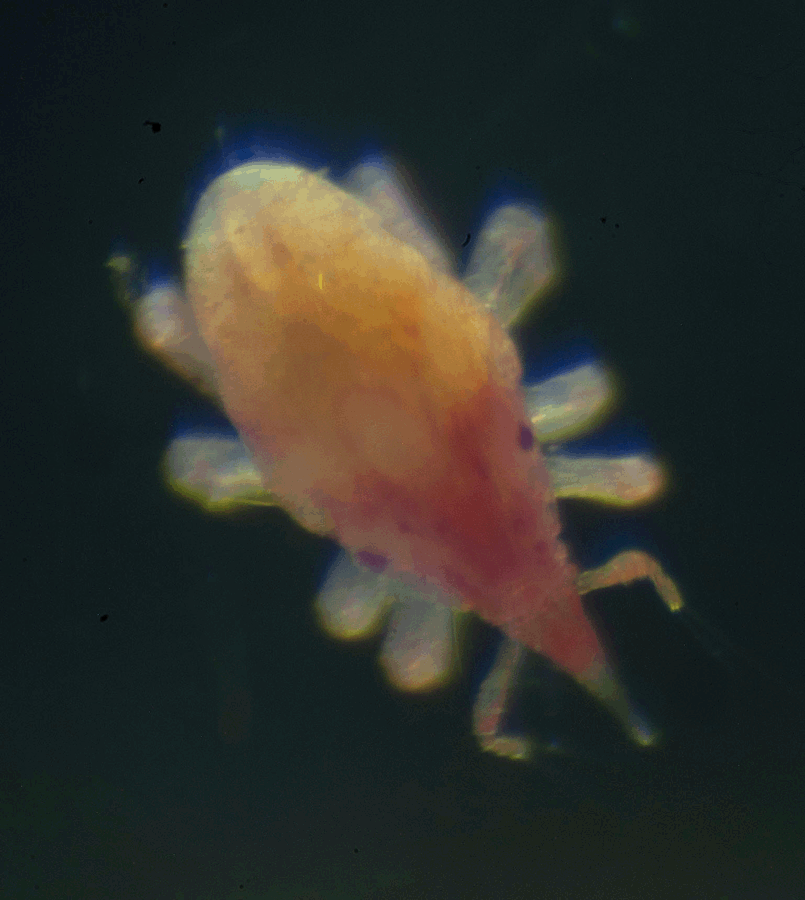
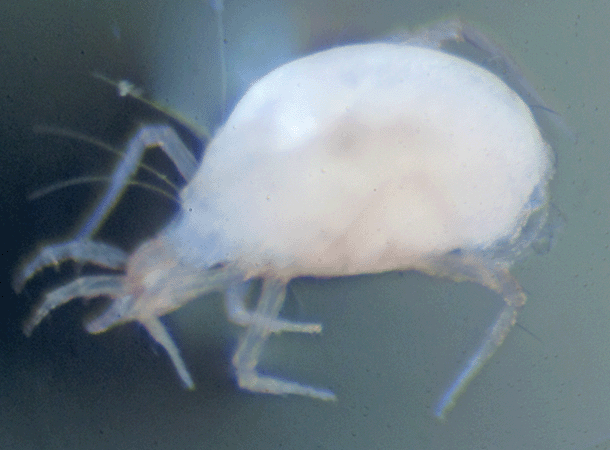
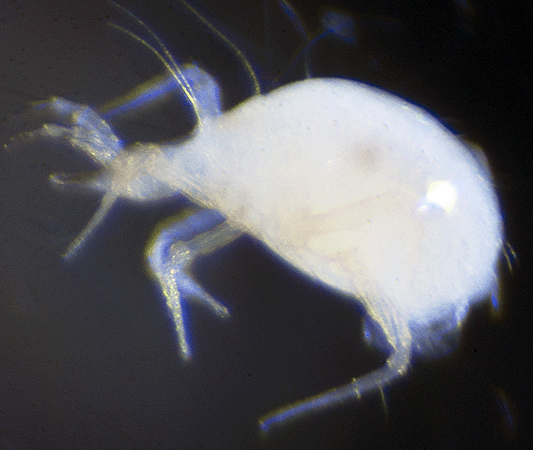
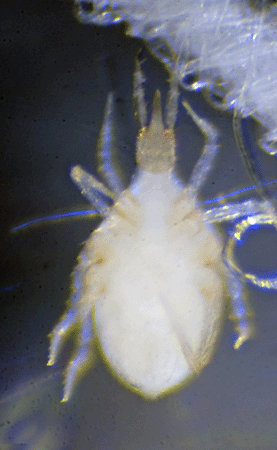
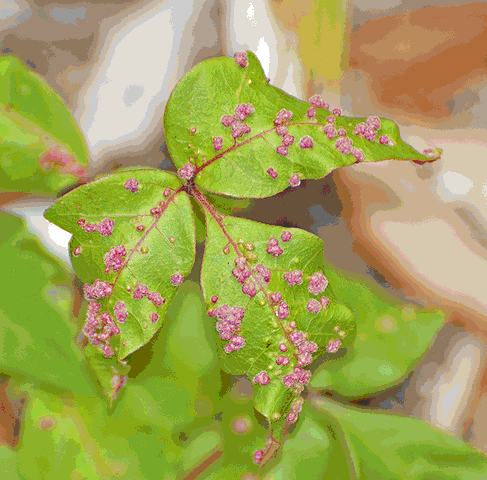
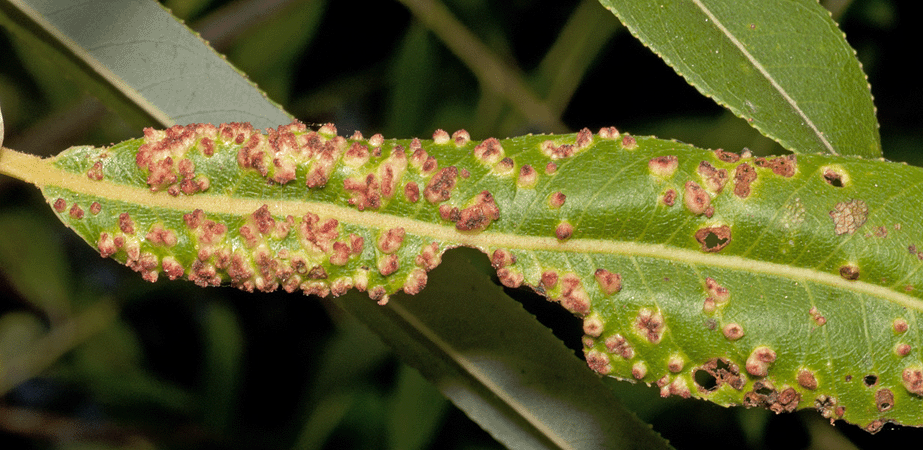
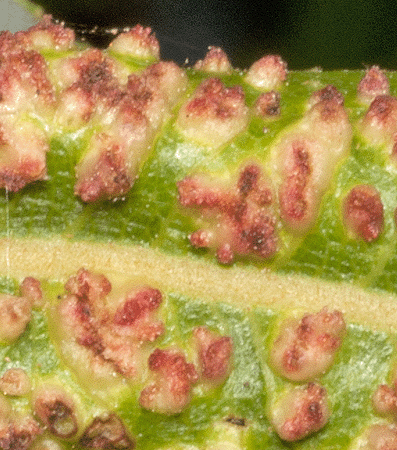
 In some areas of the Smith Preserve, galls are on leaves of
In some areas of the Smith Preserve, galls are on leaves of  Individual mites are tiny, microscopic, and yellow to pinkish white to purplish in color. The mites are worm-like with only two pairs of legs.
Individual mites are tiny, microscopic, and yellow to pinkish white to purplish in color. The mites are worm-like with only two pairs of legs. 
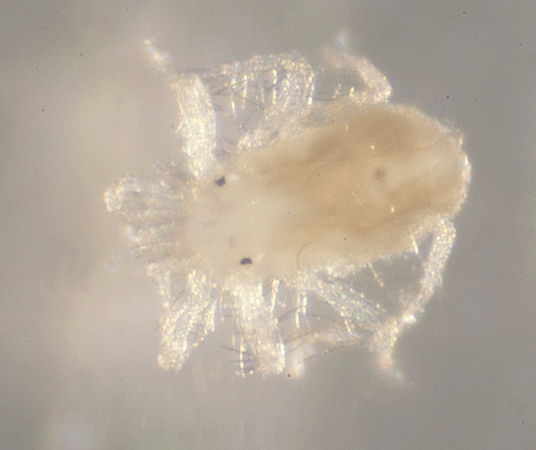
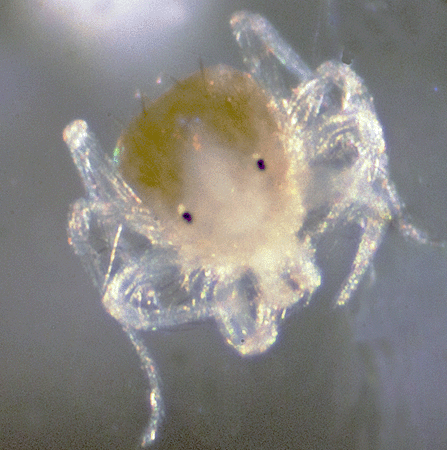
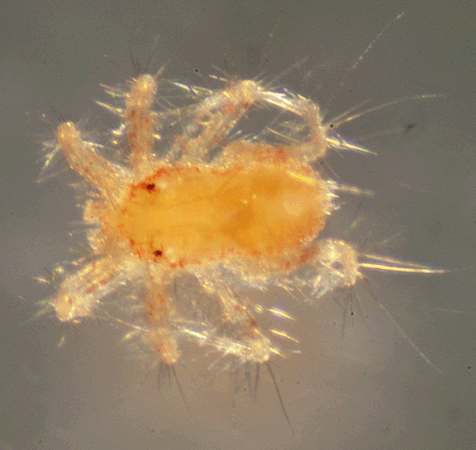 On December 17, 2014, the mite at right and below, .75 mm in length, was found in a sample of leaf litter about 10 feet from the first individual. It was identified from image 1 by Heather Proctor on January 3, 2015. Proctor stated, "definitely Anystidae with the bits of colour and good focus on leg setae, I'm confident that this is an anystid."
On December 17, 2014, the mite at right and below, .75 mm in length, was found in a sample of leaf litter about 10 feet from the first individual. It was identified from image 1 by Heather Proctor on January 3, 2015. Proctor stated, "definitely Anystidae with the bits of colour and good focus on leg setae, I'm confident that this is an anystid." 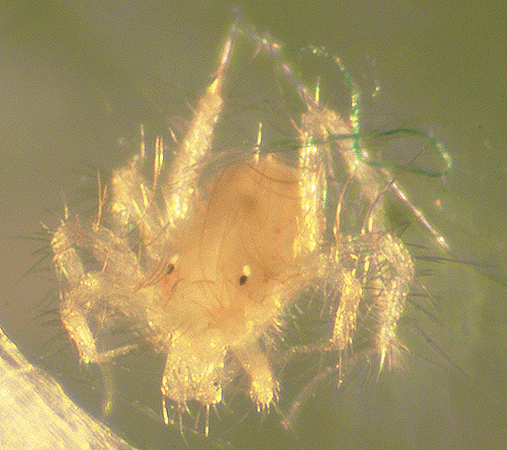
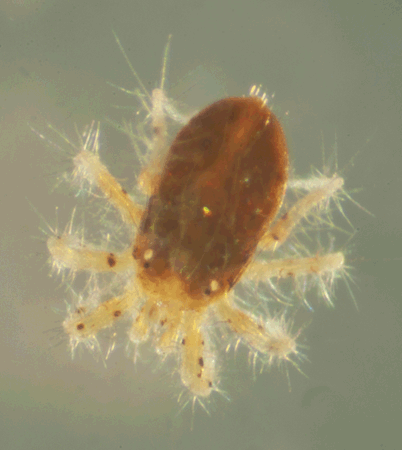
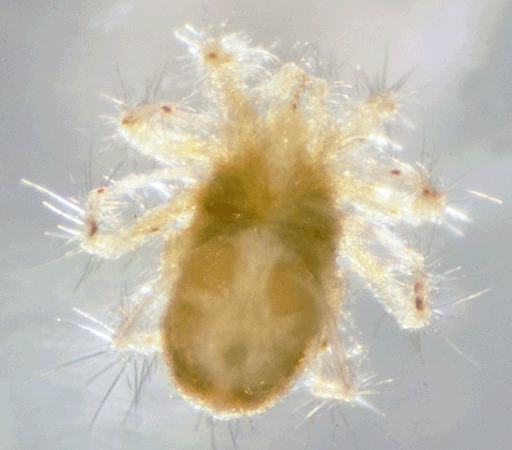
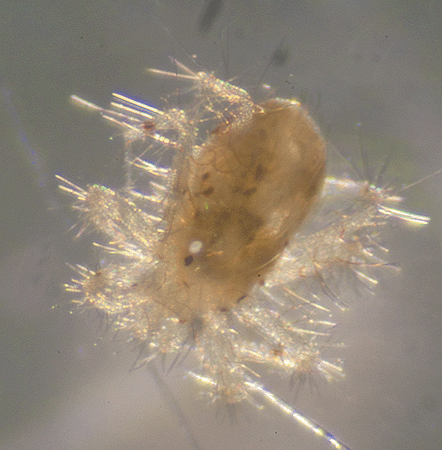
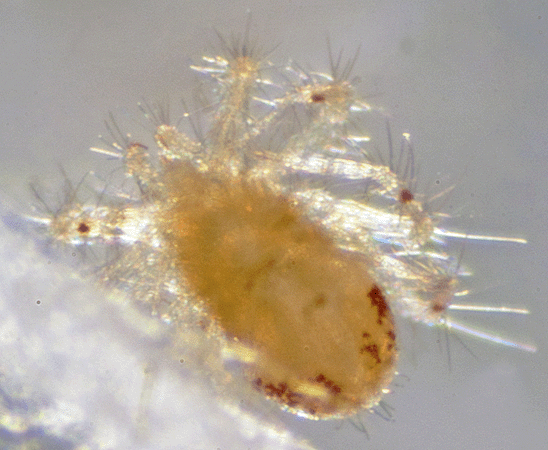
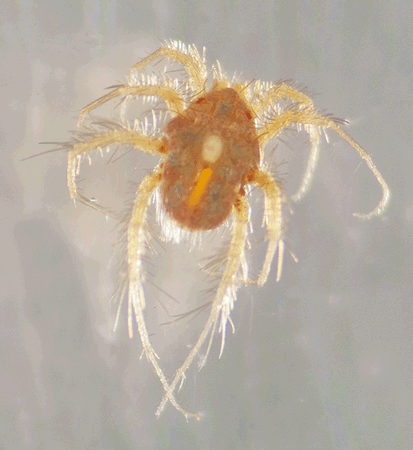 On April 2, 2015, this 1 mm long mite was caught in a pit trap placed in sand littered with
On April 2, 2015, this 1 mm long mite was caught in a pit trap placed in sand littered with 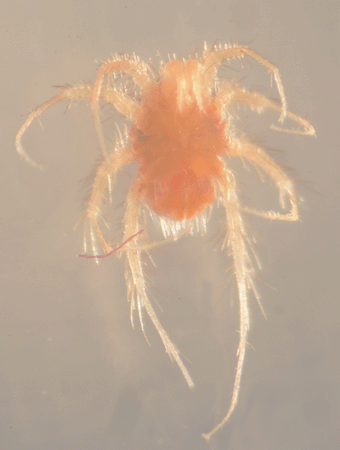 As shown in the second photograph, the ventral surface is a uniform orange color with lighter colored palps and legs.
As shown in the second photograph, the ventral surface is a uniform orange color with lighter colored palps and legs. 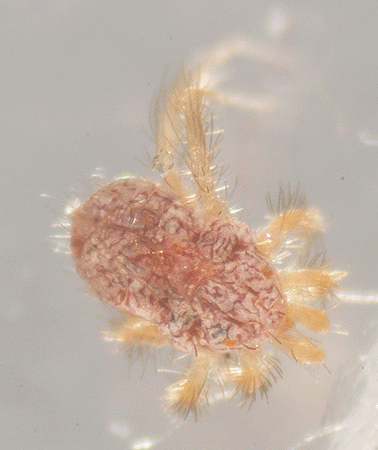 On April 2, 2015, this 1 mm long mite was captured in a pit trap placed in a sand/
On April 2, 2015, this 1 mm long mite was captured in a pit trap placed in a sand/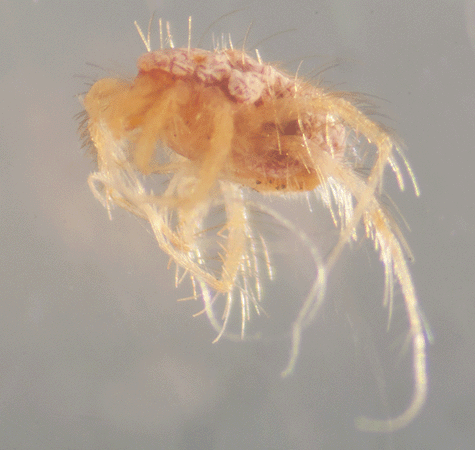 The lateral view at right shows the ventral side is orange. Note the very long hind legs.
The lateral view at right shows the ventral side is orange. Note the very long hind legs. 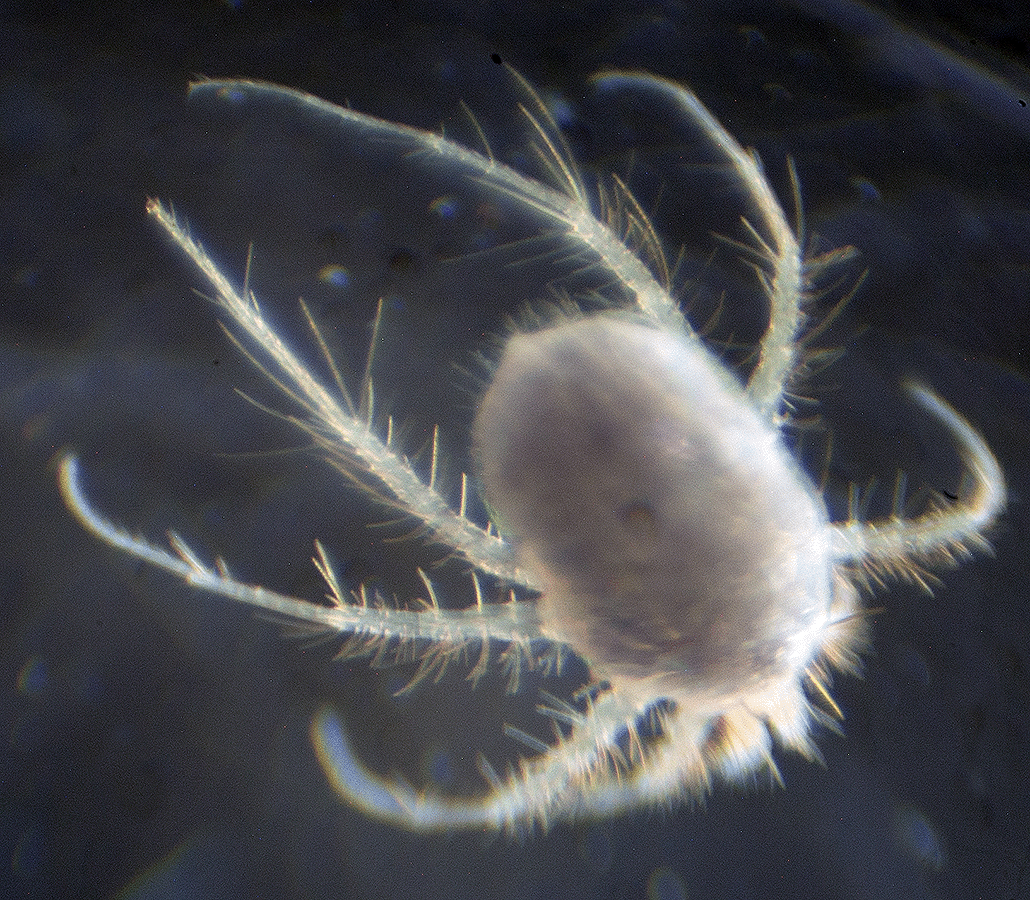
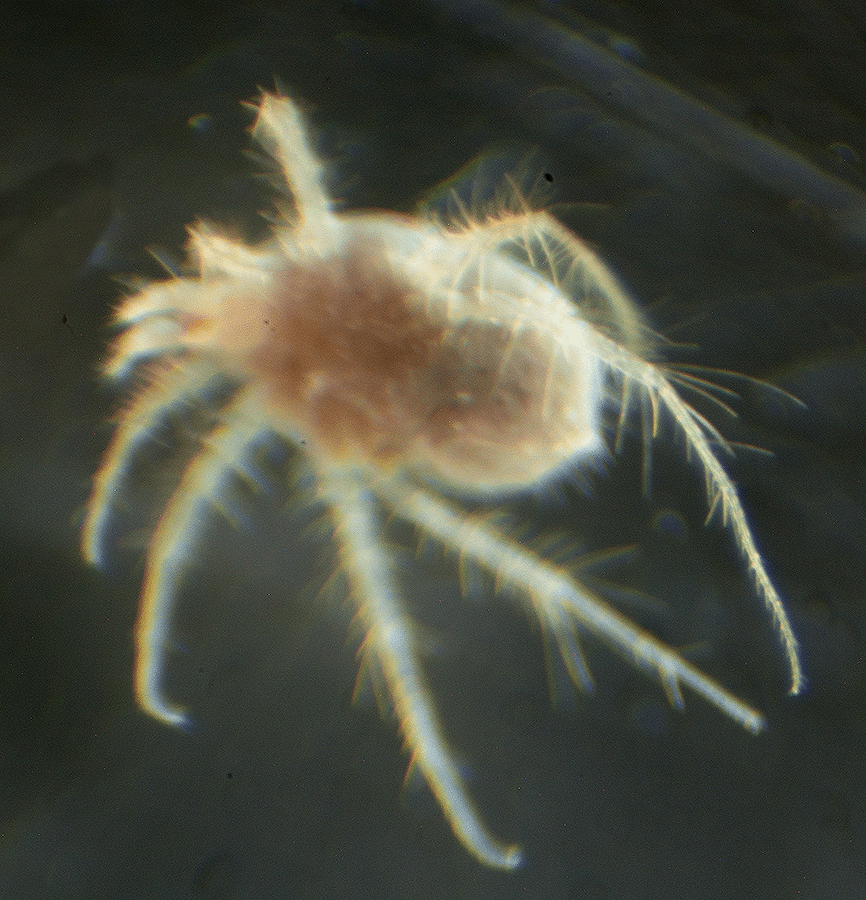
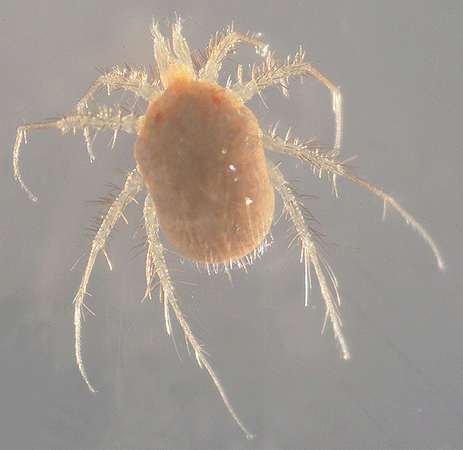
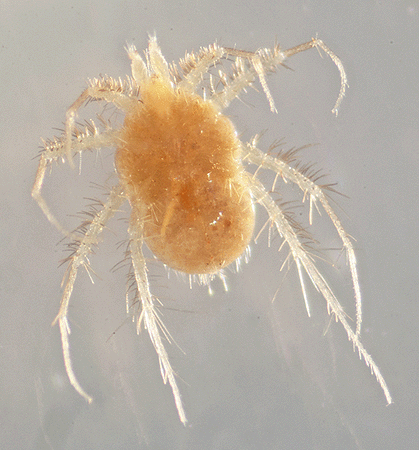
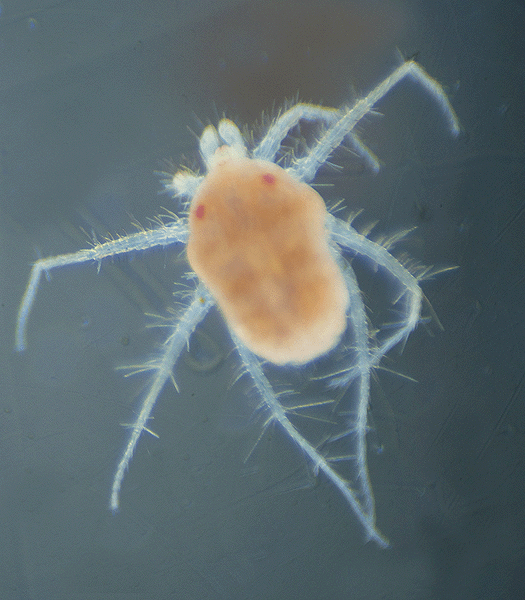
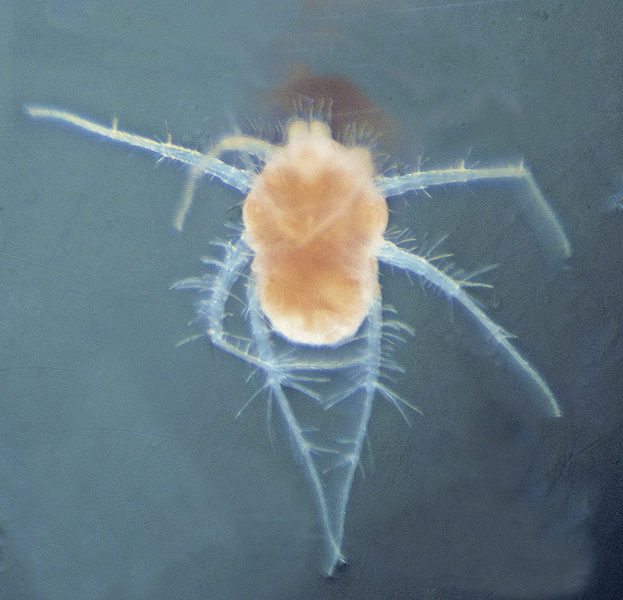
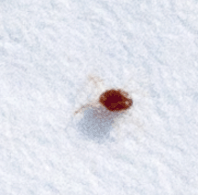
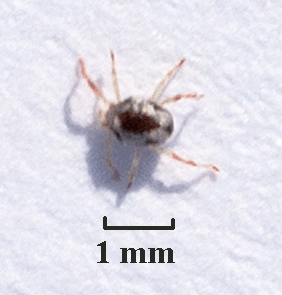
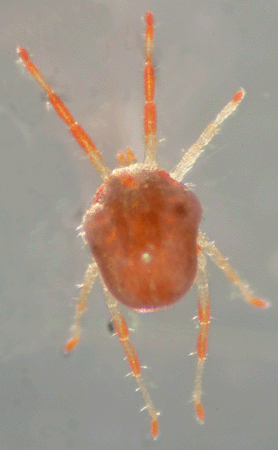
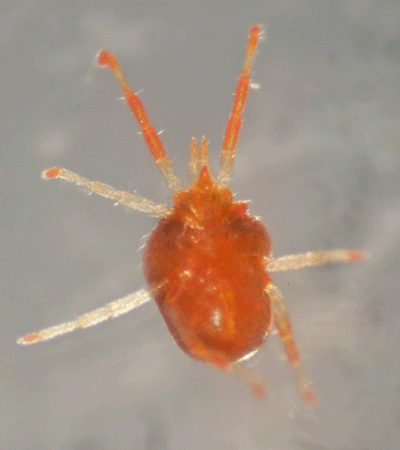
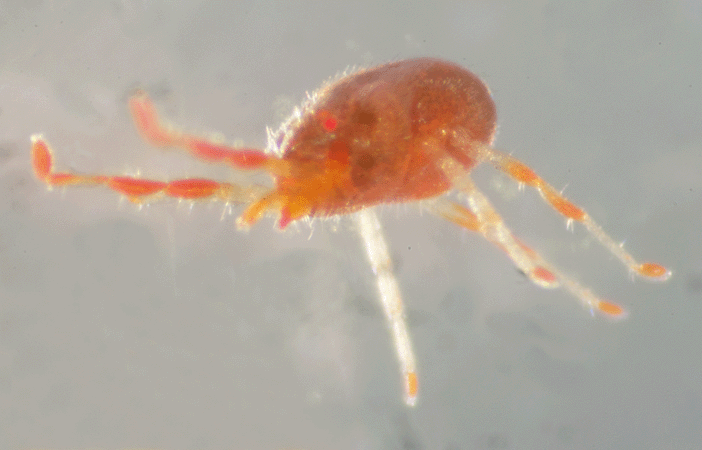 On March 18, 2015, this .8 mm long mite was on a flower of
On March 18, 2015, this .8 mm long mite was on a flower of 